Council Agenda
Ordinary
Council Meeting
7.00pm, 05 April, 2011
Civic Centre,
Dundebar Road, Wanneroo
Public Question & Statement Time
Council allows a minimum of
15 minutes for public questions and statements at each Council Meeting.
If there are not sufficient questions to fill the allocated time, the person
presiding will move on to the next item. If there are more questions than
can be dealt with in the 15 minutes allotted, the person presiding will
determine whether to extend question time.
Protocols
During the meeting, no
member of the public may interrupt the meeting’s proceedings or enter
into conversation. Each person seeking to ask questions during public
question time may address the Council for a maximum of 3 minutes each.
A register of person’s
wishing to ask a question/s at the Council Meeting is located at the main
reception desk outside of the Chamber on the night. However, members of
the public wishing to submit written questions are requested to lodge them with
the Chief Executive Officer at least 30 hours prior to the start of the meeting
i.e. noon on the previous day.
The person presiding will
control public question time and ensure that each person wishing to ask a
question is given a fair and equal opportunity to do so. A person wishing
to ask a question should state his or her name and address before asking the
question. If the question relates to an item on the agenda, the item
number should also be stated.
The
following general rules apply to question and statement time:
·
Questions should only relate to the business of the council and
should not be a statement or personal opinion.
·
Only questions relating to matters affecting Council will be
considered at an ordinary meeting, and at a special meeting only questions that
relate to the purpose of the meeting will be considered. Questions may be
taken on notice and responded to after the meeting.
·
Questions may not be directed at specific members of council or
employees.
·
Questions & statements are not to be framed in such a way as
to reflect adversely on a particular Elected Member or Officer.
·
The first priority will be given to persons who are asking
questions relating to items on the current meeting agenda.
·
The second priority will be given to public statements.
Only statements regarding items on the agenda under consideration will be
heard.
The
Mayor and Councillors will conduct an informal session on the same day as the
meeting of the Council at the Civic Centre, Wanneroo, commencing at 6.00pm
where members of the public may, by appointment, present deputations. If you
wish to present a deputation please submit your request for a deputation in
writing, at least three clear business days prior to the meeting addressed to
the Chief Executive Officer or fax through to Governance on 9405 5097. A
request for a deputation must be received by Governance by 12 noon on the
Friday before the Council Meeting.
·
A deputation is not to exceed 3 persons in number and only those
persons may address the meeting.
·
Members of a deputation are collectively to have a maximum of 10
minutes to address the meeting, unless an extension of time is granted by the
Council.
Please ensure that mobile
phones are switched off before entering the Council Chamber. Any queries
on this agenda, please contact Governance on 9405 5027 or 9405 5018.
Recording of Council Meetings Policy
Objective
·
To ensure that there is a process
in place to outline access to the recorded proceedings of Council.
·
To emphasise that the reason for
recording of Council Meetings is to ensure the accuracy of Council Minutes and
that any reproduction is for the sole purpose of Council business.
Statement
Recording of
Proceedings
(1) Proceedings for meetings
of the Council, Electors, Audit Committee and Public Question Time during
Council Briefing Sessions shall be recorded by the City on sound
recording equipment, except in the case of meetings of the Council where the
Council closes the meeting to the public.
(2) Notwithstanding subclause
(1), proceedings of a meeting of the Council which is closed to the public
shall be recorded where the Council resolves to do so.
(3) No member of the public is
to use any electronic, visual or vocal recording device or instrument to record
the proceedings of the Council or a committee without the written permission of
the Council.
Access to Recordings
(4) Members of the public may
purchase a copy of recorded proceedings or alternatively listen to recorded
proceedings with the supervision of a City Officer. Costs of providing recorded
proceedings to members of the public will be the cost of the CD plus staff time
to make the copy of the proceedings. The cost of supervised listening to
recorded proceedings will be the cost of the staff time. The cost of staff time
will be set in the City's schedule of fees and charges each year.
(5) Elected Members may
request a recording of the Council proceedings at no charge. However, no
transcript will be produced without the approval of the Chief Executive
Officer. All Elected Members are to be notified when recordings are
requested by individual Members.
Retention of Recordings
(6) Recordings pertaining to
the proceedings of Council Meetings shall be retained in accordance with the
State Records Act 2000 (General Disposal Authority for Local Government
Records). The current requirement for the retention of recorded proceedings is
thirty (30) years.
Disclosure of Policy
(7) This policy shall be
printed within the agenda of all Council, Special Council, Electors and Special
Electors meetings to advise the public that the proceedings of the meeting are
recorded.
Notice is given that the next Ordinary Council Meeting
will be held at the Civic Centre,
Dundebar Road, Wanneroo on Tuesday 5 April, 2011
commencing at 7.00pm.
D Simms
Chief Executive
Officer
31 March, 2011
CONTENTS
Item 1_____ Attendances_ 3
Item 2_____ Apologies and Leave of
Absence_ 4
Item 3_____ Public Question Time_ 4
Questions
Taken on Notice at Council Briefing 4
3.1 Mr
M Parker, Observatory Drive, Clarkson 4
3.2 Ms
K Bennett, Kingsway Road, Landsdale 4
3.3 Mr
C Tenni, Ocean Keys Boulevard, Clarkson 5
Item 4_____ Confirmation of Minutes_ 5
OC01-04/11 Minutes
of Ordinary Council Meeting held on 8 March 2011 5
Item 5_____ Announcements by the
Mayor without Discussion_ 5
Item 6_____ Questions from Elected
Members_ 5
Item 7_____ Petitions_ 6
New
Petitions Received 6
Update on
Petitions 6
Item 8_____ Reports_ 6
Planning and
Sustainability 7
Policies and
Studies 7
PS01-04/11 Policy
Finalisation - Local Planning Policy 2.6: Ancillary Accommodation 7
PS02-04/11 Policy
Finalisation - Local Planning Policy 2.3: Child Care Centres 14
PS03-04/11 Amendment
to Local Planning Policy 3.1: Local Housing Strategy Implementation 29
Development
Applications 53
PS04-04/11 Retrospective
Development Application - Change of Use from Single House to Place of Worship
and Educational Establishment including Incidental Restaurant (Cafe) and Shop
at 82 Ocean Keys Boulevard, Clarkson 53
PS05-04/11 Development
Application - Estate Signs Located Within City Controlled Land 68
PS06-04/11 Development
Application - Home Business - Category 3 - Leaflet Distribution - 94 Willespie
Drive, Pearsall 75
Other
Matters 84
PS07-04/11 Proposed
Closure of Pedestrian Access Way - Lot 57 (14P) Collison Place, Marangaroo 84
PS08-04/11 Sustainability
Investment Fund Policy 106
PS09-04/11 Final
East Wanneroo Structure Plan 111
City
Businesses 137
Regulatory
Services 137
CB01-04/11 Application
to Keep More Than Two Dogs 137
CB02-04/11 Service
Level Agreement Between the City of Wanneroo and FESA for the Provision of a
Community Emergency Services Manager (CESM) 142
CB03-04/11 Fluoridation
of the Yanchep Drinking Water Supply - Public Consultation 167
City
Business 170
CB04-04/11 Appointment
of Delegate to the Mindarie Regional Council 170
CB05-04/11 Tender
No. 01044 - The Supply and Delivery of 3.45mm Baling Wire for the Wangara
Recycling Centre for the Period of One (1) Year with an Option for a Further
One (1) Year. 172
Other
Matters 176
CB06-04/11 Update
on the exit of the City of Stirling from the Mindarie Regional Council 176
Infrastructure 207
Infrastructure
Projects 207
IN01-04/11 Queenscliffe
Park Beach Access Concept Plan, Quinns Rocks 207
IN02-04/11 Pedestrian
Pathway - Compass Circle to Foreshore Vista, Yanchep 213
IN03-04/11 Yanchep
Active Open Space - Interim Agreement to Address Costs Associated with the
Earthworks 220
Tenders 225
IN04-04/11 Tender
No 01104 - The Provision of Linemarking, Signs, and Spotting Services 225
IN05-04/11 Tender
No 01108 - the Provision of General Weed Control Services for a Period of Two
Years 231
Traffic
Management 237
IN06-04/11 Carramar
Special Rural Zone (Tranquil Drive) - Review of Traffic Issues 237
IN07-04/11 Review
of the Use of Rubber Speed Humps 252
Community
Development 255
Capacity
Building 255
CD01-04/11 Reconciliation
Action Plan Working Group: Amendment to Terms of Reference 255
Program
Services 261
CD02-04/11 Concept
Plan for the Development of Keith Griffith Park 261
CD03-04/11 Kingsway
Masterplan Review 267
Other
Matters 342
CD04-04/11 Review
of the Community Consultation Policy 342
Corporate
Strategy & Performance 350
Finance 350
CS01-04/11 Financial
Activity Statement for the Period Ended 28 February 2011 350
CS02-04/11 Budget
Workshop 1 - Capital Budget 2011/12 364
Governance
and Executive Services 375
CS03-04/11 Donations
to be Considered by Council - April 2011 375
CS04-04/11 Review
of Certificate of Recognition - Elected Members Policy 379
CS05-04/11 Amendment
to Australia Day Award Policy 385
CS06-04/11 Overview
of Proposed Structure of Internal Standards Panel 390
CS07-04/11 Council Members’
Fees, Allowances, Reimbursements and Benefits Policy Amendment 394
CS08-04/11 Motion
for the 2011 National General Assembly of Local Government 411
Chief
Executive Office 413
Office of
the CEO Reports 413
CE01-04/11 Delegation
of Authority for Appointment of Acting Chief Executive Officer 413
CE02-04/11 Donation
Requests Considered Under Delegated Authority of the Chief Executive Officer 416
CE03-04/11 Strategic
Internal Audit Plan 2011/12 to 2013/14 418
Item 9_____ Motions on Notice_ 428
MN01-04/11 Cr Grierson -
Request for Citizenship Ceremonies 428
Item
10____ Urgent Business_ 430
Item
11____ Confidential_ 430
CR01-04/11 Reconsideration
of the draft East Wanneroo Cell 9 - East Landsdale Local Structure Plan No. 57
- Lot 165 (474) Kingsway, Landsdale 430
CR02-04/11 Purchase
Road Reserve Land from Lot 13 (287L) Gnangara Road, Wangara 430
CR03-04/11 Acquisition
of Land - Portions of Lot 105 (500) and Lot 21 (450) Flynn Drive Neerabup 430
Item
12____ Date of Next Meeting_ 431
Item
13____ Closure_ 431
Item 1 Attendances
Item 2 Apologies
and Leave of Absence
Item 3 Public
Question Time
Questions Taken on Notice at Council
Briefing
Item PS04-04/11 – Retrospective Development
Application – Change of Use from Single House to Place of Worship and
Educational Establishment including Incidental Restaurant (Café) and
Shop at 82 Ocean Keys Boulevard, Clarkson
What options and support does the City intend to offer marginalised
young people who are not able to access education in the normal manner and who
are looking for a community to respond to their needs?
Response by Cr Roberts
Taken on notice.
Further Response by Director
Planning and Sustainability
The Council’s consideration of this application is
based on the appropriateness or otherwise of the proposal based on town
planning principles and land use matters.
Other locations and premises where the use is permissible
should be considered by the applicant.
Item CR01-04/11 – Reconsideration of the Draft
East Wanneroo Cell 9 – East Landsdale Local Structure Plan No. 57 –
Lot 165 (474) Kingsway, Landsdale
1. Is
it fair that the current East Landsdale Draft Local Structure Plan allocates
all of Lot 165 Kingsway Road, including our home of 35 years and all the
associated improvements, which are worth well over $2 million, as Public Open
Space on the Structure Plan?
2. Will
the City of Wanneroo be responsible for compensation for all of the land and
improvements on Lot 165, even though the proposed structure plan, which is, we
believe, a fair compromise, will significantly save an amount of compensation
payable for both the land and improvements and doesn’t disadvantage other
landowners?
3. While
this is a complex issue, is there any need for more than half of Lot 165 as
Public Open Space when the nearby primary school has ample outdoor playing
areas which, when combined with the adjoining Public Open Space area on the
proposed structure plan, will provide sufficient land area for a full sized
football oval if needed?
Response by Cr Roberts
Taken on notice.
Further Response by Director Planning and Sustainability
1.
The structure planning for East Landsdale has been undertaken
over a period of years and has been the subject of public consultation on at
least two occasions. The structure planning process makes provision for
land required for Public Open Space (POS) or other public purposes to be
purchased by the City through District Planning Scheme No. 2.
2.
Through the provisions of District Planning Scheme No. 2,
the City will compensate any landowner affected by a requirement such as the
need to provide POS in the area.
3.
A reduction in the size of the POS will prevent the
establishment of a appropriately orientated senior oval and associated
facilities. Further, there is no obligation for the proposed primary
school site to contribute to the provision of a senior playing field in the
locality.
Item PS04-04/11 – Retrospective Development
Application – Change of Use from Single House to Place of Worship and
Educational Establishment including Incidental Restaurant (Café) and
Shop at 82 Ocean Keys Boulevard, Clarkson
1. Has
the applicant considered the vacant commercial premises around the corner from
us, which are approved usage for the application?
2. Has
the applicant considered the growth of the number of people attending the
church and school?
Response by Cr Roberts
Taken on notice.
Further Response by Director Planning and Sustainability
The City notes the questions and suggests that they should
be directed to the applicant.
Item 4 Confirmation
of Minutes
That the minutes of Ordinary Council Meeting held on 8 March
2011 be confirmed.
Item 5 Announcements
by the Mayor without Discussion
Item 6 Questions
from Elected Members
Item
7 Petitions
New Petitions Received
Update on Petitions
Nil
Item 8 Reports
Declarations of
Interest by Elected Members, including the nature and extent of the interest.
Declaration of Interest forms to be completed and handed to the Chief Executive
Officer.
Planning and Sustainability
Policies and Studies
PS01-04/11 Policy
Finalisation - Local Planning Policy 2.6: Ancillary Accommodation
File Ref: 4083
– 11/23992
Responsible
Officer: Director, Planning and Sustainability
Disclosure
of Interest: Nil
Attachments: 2
Issue
To consider the final adoption
of Local Planning Policy 2.6: Ancillary Accommodation (LPP 2.6) following
public advertising of the policy.
Background
The current planning policy,
titled ‘Ancillary Accommodation in the General Rural, Rural Resource,
Special Rural and Special Residential Zones Local Planning Policy’
(hereafter referred to as the ‘current policy’) was originally
adopted in December 2005 (refer to Attachment 1). This policy was due
for review in December 2007.
As part of the review of the
current policy, Administration has developed a new policy (Draft LPP 2.6; refer
to Attachment 2) to be incorporated into the Administration’s
Local Planning Policy Framework. LPP 2.6 has been developed with the intent to
improve current standards for the assessment of planning applications for
ancillary accommodation. LPP 2.6 was formulated to incorporate agreed standards
in addition to – but not in conflict with – those stipulated in
District Planning Scheme No. 2 (DPS 2) and the Residential Design Codes.
Council has previously
considered Draft LPP 2.6 at its meeting on 14 December 2010 and at that time,
Council resolved to advertise the policy for public comment.
Consultation
The
draft Policy was advertised for public comment for a period of 42 days from 18
January 2011 to 1 March 2011 by way of:
• Advertisements
placed in local newspapers for two consecutive weeks on 18 January 2011 and 25
January 2011; and
• Display
at the City’s Civic Centre, City’s libraries and on the
City’s website.
Administration
did not receive any submissions during the 42-day advertising period.
Comment
Administration recommends that Council adopts the Draft LPP
2.6, as presented to Council at its meeting of 14 December 2010, and as shown
in Attachment 2.
Statutory
Compliance
In accordance with Section
8.11.3.1 (c) of DPS 2, Council is required to review the draft policy in light
of any submissions made and must then resolve either to finally adopt the draft
policy with or without modification, or not to proceed with the policy.
In accordance with Clauses
8.11.3.1 (d) and 8.11.3.1 (e) of DPS 2, should Council resolve to finally adopt
the revised draft policy, notification of the final adoption must be published
once in a newspaper circulating in the District and a copy of the policy
forwarded to the Western Australian Planning Commission.
Strategic
Implications
The proposal accords with the following Outcome Objective of
the City’s Strategic Plan 2006 – 2021:
“4 Governance
4.6 Provide
and maintain a high standard of governance and accountability”
Policy
Implications
Draft LPP 2.6 will supersede the
current Local Planning Policy “Ancillary Accommodation in the General
Rural, Rural Resource, Special Rural and Special Residential zones”,
and establish agreed standards for the City to assess and determine
applications for planning approval for Ancillary Accommodation within the City
of Wanneroo.
Financial
Implications
The cost of advertising the
final adoption of LPP 2.6 can be met from existing operational budgets.
Voting
Requirements
Simple Majority
Recommendation
That
Council:-
1. NOTES
that no submissions were received in respect to draft Local Planning Policy
2.6: Ancillary Accommodation;
2. Pursuant
to Clause 8.11.3.1 (c) of District Planning Scheme No. 2 ADOPTS the draft
Local Planning Policy 2.6: Ancillary Accommodation included in Attachment
2; and
3. Pursuant
to Clauses 8.11.3.1 (d) and 8.11.3.1 (e) of District Planning Scheme No. 2
PUBLISHES notice of its adoption of the Policy in the Wanneroo Times and North
Coast Times newspapers, and FORWARDS a copy of the adopted policy to
the Western Australian Planning Commission for its information.
CITY OF WANNEROO Agenda
OF Ordinary Council Meeting 05 April, 2011 9


CITY OF WANNEROO Agenda OF Ordinary Council Meeting 05
April, 2011 11



PS02-04/11 Policy
Finalisation - Local Planning Policy 2.3: Child Care Centres
File Ref: 4082
– 11/24641
Responsible
Officer: Director, Planning and Sustainability
Disclosure
of Interest: Nil
Attachments: 2
Issue
To consider the final adoption of Local Planning Policy 2.3:
Child Care Centres (LPP 2.3), following public advertising of the policy.
Background
The current planning policy, titled ‘Child Care
Centres’ (hereafter referred to as the ‘current policy’) was
originally adopted in July 1999 (refer Attachment 1). This policy
was due for review in February 2009.
The current policy has been reviewed and retitled Local
Planning Policy 2.3: Child Care Centres (LPP 2.3) (refer Attachment 2).
The review was undertaken as part of the regular review of policies to ensure they
are current and still relevant. To this end, the review seeks to ensure
that LPP 2.3 is consistent with the Western Australian Planning
Commission’s (WAPC’s) Child Care Centre Guidelines released in
August 2009 (Planning Bulletin 72/2009) and reflects the introduction of the
Child Care Services Act 2007 and associated regulations and can be clearly and
consistently interpreted and implemented by applicants, Administration and
Council.
Council previously considered Draft LPP 2.3 at its meeting
on 14 December 2010, and at that time, Council resolved to advertise the policy
for public comment.
Consultation
The draft policy was advertised for public comment for a
period of 42 days from 18 January 2011 to 1 March 2011 by way of:
· Advertisements
placed in local newspapers for two consecutive weeks on 18 January 2011 and 25
January 2011; and
· Display at the
City’s Civic Centre, City’s Libraries and on the City’s
website.
Administration did not receive any submissions during the 42-day
advertising period.
Comment
Administration recommends that Council adopts the Draft LPP
2.3, as presented to Council at its meeting of 14 December 2010, and as shown
in Attachment 2.
Statutory
Compliance
In accordance with Section 8.11.3.1 (c) of District Planning
Scheme No. 2 (DPS 2), Council is required to review the draft policy in light
of any submissions made and must then resolve either to finally adopt the draft
policy with or without modification, or not to proceed with the policy.
In accordance with Clause 8.11.3.1 (d) and 8.11.3.1 (e) of
DPS 2, should Council resolve to finally adopt the revised draft policy,
notification of the final adoption must be published once in a newspaper
circulating in the District and a copy of the policy forwarded to the Western
Australian Planning Commission.
Strategic
Implications
The proposal accords with the following Outcome Objective of
the City’s Strategic Plan 2006 – 2021:
“4 Governance
4.6 Provide
and maintain a high standard of governance and accountability”
Policy
Implications
Draft LPP 2.3 will supersede the current Child Care Centres
policy and establish agreed standards for the City to assess and determine
applications for planning approval for Child Care Centres within the City of
Wanneroo.
Financial
Implications
The cost of advertising the final adoption of LPP 2.3 can be
met from existing operational budgets.
Voting
Requirements
Simple Majority
Recommendation
That Council:-
1. NOTES
that no submissions were received following advertising of draft Local Planning
Policy 2.3: Child Care Centres;
2. Pursuant to Clause
8.11.3.1 (c) of District Planning Scheme No. 2 ADOPTS the draft
Local Planning Policy 2.3: Child Care Centres included in Attachment 2; and
3. Pursuant to
Clauses 8.11.3.1 (d) and 8.11.3.1 (e) of District Planning Scheme No. 2
PUBLISHES notice of its adoption of the Policy in the Wanneroo Times and North
Coast Times newspapers, and FORWARDS a copy of the adopted policy to
the Western Australian Planning Commission for its information.
CITY OF WANNEROO Agenda
OF Ordinary Council Meeting 05 April, 2011 16






CITY OF WANNEROO Agenda OF Ordinary Council Meeting 05
April, 2011 22
PART 1
Policy Operation
Policy development
This policy has been prepared under the provisions of clause
8.11 of the City of Wanneroo District Planning Scheme No. 2 (DPS 2).
Application and purpose
This policy establishes agreed standards for the assessment
and determination of Child Care Centre development applications and has been
applied to supplement the provisions of Part 4 of DPS 2.
Objective
To provide guidance for the design, location and development
of Child Care Centres to maximise user convenience and maintain a high level of
amenity in residential areas.
Definitions
‘Child care centre’ has the same meaning given
to it under DPS 2 and, for the purpose of ensuring consistency with the Western
Australian Planning Commission’s Child Care Centre Guidelines, includes
premises used for the daily or occasional care of children in accordance with
the regulations for child care under the Child Care Services Act 2007.
Related Legislation and Policies
DPS 2, Residential Design Codes and Child Care Services Act
2007.
Responsibility for Implementation
Manager Planning Implementation
Part 2
General Policy Provisions
1. Location
1.1 Road Hierarchy
Child Care Centres are reasonably
high traffic generators and therefore should not be located on Primary or
District Distributors (or close to the intersections of such roads) where the
primary function is to cater for through traffic. Similarly, Child Care
Centres should not be located in or adjacent to Access Roads in residential
areas where amenity, safety and aesthetics must take priority.
Accordingly, these Centres should be located on Local Distributor roads in such
a fashion that they will not conflict with traffic control devices and will not
encourage the use of nearby Access Roads for turning movements.
1.2. Neighbouring Uses
Wherever possible it is preferred
to locate Child Care Centres adjacent to non-residential uses such as Shopping
Centres, Medical Centres/Consulting Rooms, Schools, Parks and Community Purpose
Buildings to maximise convenience and minimise the impact such Centres will
have on the amenity of residential areas.
2. Setbacks
Setbacks shall
be in accordance with Clause 4.7 of DPS 2. In residential areas the
following variations may be considered:
2.1 Front Setback
If the building
is located between two adjoining residences, the building may be setback from
the primary street boundary at least as far as the lesser of the two adjoining
residences. If the surrounding sites are vacant, variations to the front
setback requirements of DPS 2 will not be considered.
2.2 Side and Rear Setbacks
Side and rear
setbacks may be reduced (with the exception of setbacks to activity or play
areas) in accordance with Table 1, Tables 2(a) and 2(b) and Part 6.3 Boundary
set-back requirements of the Residential Design Codes, where it can be
adequately substantiated that the variation will not adversely impact on the
amenity of adjacent landowners. Care should be taken to ensure outdoor play
areas are not located adjacent to private open space or living areas, where
practicable.
3. Parking
3.1 Location
All parking areas should be
located in front of buildings or at least be easily visible from the entry to
the site so that patrons are encouraged to use the on-site parking and not the
road verges. Disabled bays shall be located as close as possible to the
entry of the Child Care Centre.
3.2 Design
Parking areas should preferably
be designed to allow traffic to flow through using entry and exit crossovers so
that traffic conflicts and congestion do not unnecessarily restrict the use of
the parking area. For the purposes of determining parking requirements,
design incorporating through flow are referred to as Type 1 and those accessed
only by a two-way crossover as a Type 2 (refer to Figure 1).
3.3 Number of parking
bays required
All Child Care Centres must
provide a minimum of one parking bay for each staff member and at least five
parking bays for up to 25 children. For Centres with more than 25
children the required parking bays are determined by reference to Figure
1. The actual parking requirement for Centres in this category varies
with the configuration of the parking area and the number of children.
4. Landscaping
4.1 Onsite
In residential areas, the primary
street frontage and corner truncation, where applicable, shall be suitably
landscaped and reticulated to a depth of three (3) metres to assist in
preserving the character of residential areas. Where car parking areas
are located adjacent to secondary streets, the car park shall be setback a
minimum of three (3) metres to allow for landscaping. Child Care Centres
located in all other areas shall be landscaped in accordance with DPS2.
4.2 Verge
The verge area in front of all
Child Care Centres is required to be suitably landscaped, reticulated and
maintained to discourage patrons from parking on the verge instead of using the
parking areas provided. Under no circumstances is the verge to be paved
or sealed as this would encourage its use for parking and detract from the
amenity of the area.
4.3 Landscaping Plan
A minimum of 8% of the area of
the development site shall be set aside as landscaping. Detailed
landscaping and reticulation plans for the subject site and adjacent road
verges, shall be lodged for approval by the City. A landscaping plan is
to be submitted for approval by the City prior to the issue of a building
licence. The use of endemic trees and shrubs are encouraged. The
City will not accept landscaping that includes or would result in the creation
of potentially hazardous heights, landscape fittings and potentially toxic
plant species.
5. Soil Contamination
Any party considering development
of a child care centre must obtain and consider any information the Department
of Environment and Conservation (DEC) has about the contamination status of a
given site. This documentation is to be submitted to the City with the
development application.
6. Pedestrian
Linkages
Pedestrian access within the
site, from the parking area to the entry of the building shall be provided and
shall link into existing neighbourhood pedestrian networks where available.
7. Traffic
Impact Studies
Where Child Care Centres are
proposed within Residential Areas or where the City considers that the Centre
traffic may adversely impact on the surrounding area, a Traffic Impact Study
will be required.
A traffic impact study should be
prepared by a suitably qualified Traffic Consultant and address the following:-
· Site description
including naming of roads and nearest intersections;
· Adjoining land
uses;
· Existing traffic
conditions or Structure Plan indications;
· Traffic flows,
daily and peak hour flows, number of heavy vehicles;
· Speed as measured
at the 85th percentile;
· Trip generation;
· Queuing at
intersections and entry/egress to parking facilities;
· Road safety for
all road users, including pedestrian and cyclists;
· Crash history;
· Parking provisions
and requirements, pick-up and drop-off facilities;
· Public transport
routes;
· Dual use path
locations surrounding the site, internal pedestrian pathways, suitable crossing
locations for pedestrians and provision of pram ramps;
· Other matters
considered necessary in a particular case.
8. Fencing
If a Child Care Centre is
proposed within a Residential Area, fencing within the front setback area shall
be in accordance with Part 6.2, Streetscape requirements of the Residential
Design Codes and fencing to secondary streets shall be in accordance with the
City’s Private Property Local Law. It is preferable that fencing
along the secondary street be located behind any required landscaping strip,
unless the fence is permeable from natural ground level.
9. Amenity
9.1 Residential
Areas
Child Care Centres located within
residential areas shall maintain a residential appearance so as to harmonise
with the character of the area.
9.2 Windows
to Activity Rooms
Windows to activity rooms shall
be orientated away from adjoining residential properties to minimise any noise
impacts to adjoining properties.
9.3 Acoustic
Report
Child Care Centres may
potentially generate a level of noise perceived as nuisance to adjacent
landowners, as such Child Care Centres will be subject to the assessment of an
acoustic report. The report should demonstrate either compliance with the
Environmental Protection (Noise) Regulations 1997 or design/specification
measures that will need to be incorporated to reach compliance.
10. Consultation
Applications for the development
of a child care centre located in an existing residential area will be subject
to public consultation in accordance with Clause 6.7 of DPS 2, with a minimum
requirement for adjoining neighbours to be consulted and a sign displayed on
site. Consultation may not be considered necessary where the location of
the child care centre has been predetermined in an agreed structure plan
completed prior to any residential development in the vicinity.
11. Required Supporting
Information
A list of the required documentation
to be submitted with all child care centre development applications is provided
in Schedule 1.
Schedule 1
Required supporting information
All applications for Child Care Centres shall consist of the
following:-
· A written
statement that outlines the number of children proposed, age group breakdown,
days and hours of operation, required staff numbers and any other supporting
information;
· A location plan
depicting surrounding lots and road layout;
· A site contour
survey plan prepared by a licensed practicing land surveyor, including location
of buildings on adjacent sites;
· A site plan (to a
minimum scale of 1:100 or 1:200) depicting the location of all proposed built
structures, car parking, landscaping, bin store location, pedestrian and
vehicle access ways, crossover location/s, verge area, adjacent roads and any
associated road infrastructure (eg. light poles, drainage pits, traffic islands
etc). Setbacks to buildings are required to be clearly depicted on the plan;
· Floor plans to a
minimum scale of 1:100;
· Elevations to all
sides of the building to a minimum scale of 1:100;
· Documentation that
consultation with the DEC has been undertaken by the applicant/owner in
relation to the contamination status of a given site.
· Traffic Impact
Statement if located within a residential area or where the City considers that
the Centre traffic may adversely impact on the surrounding area;
· An acoustic
report;
· A signage
strategy; and
· Other matters
considered necessary by the City in a particular case.
Figure 1
Parking for Child Care Centres
PARKING LAYOUT

|
Type 1 Parking
|
|
Type 2 Parking
|
|
Children
|
Bays
Required
|
|
Children
|
Bays
Required
|
|
<40
|
5
|
|
<25
|
5
|
|
41-48
|
6
|
|
26-30
|
6
|
|
49-56
|
7
|
|
31-56
|
7
|
|
57-64
|
8
|
|
57-64
|
8
|
|
65-72
|
9
|
|
65-72
|
9
|
|
>72
|
9
bays plus 1 per 7 children accommodated in excess of
72
|
|
>72
|
9
bays plus 1 per 7 children accommodated in excess of
72
|
Notes: Above bays are for
numbers of children only. One additional bay is required for each staff
member.
PS03-04/11 Amendment
to Local Planning Policy 3.1: Local Housing Strategy Implementation
File Ref: 3516
– 11/25021
Responsible
Officer: Director, Planning and Sustainability
Disclosure
of Interest: Nil
Attachments: 6
Issue
To consider submissions received in response to advertising
of a proposed amendment to Local Planning Policy (LPP) 3.1: Local Housing
Strategy (LHS) Implementation.
Background
At its meeting of 6 April 2010 (item PS01-04/10), Council
required that an amendment to LPP 3.1 be prepared to:
1. Facilitate
higher residential densities in other appropriate locations, not solely in
proximity to commercial/activity centres; and
2. Include
provisions that set out the manner in which Council will deal with requests for
higher residential density codings in areas not covered by the policy.
A report addressing the above matters was considered at
Council’s meeting of 14 December 2010 (item PS03-12/10), resulting in
Council adopting a draft amendment to LPP 3.1 and requiring that it be
advertised for public comment.
Detail
The amendment to LPP 3.1 proposes to:
· Expand
the Housing Precincts in Wanneroo, Girrawheen and Koondoola to include
additional areas identified for an increase in residential density based on the
application of proposed additional criteria;
· Combine
the Girrawheen and Koondoola Housing Precincts;
· Include
provisions that set out the manner in which Council will deal with requests for
higher density codings in areas that do not fall within the Housing Precincts
identified by the Policy;
· Raise
the Quinns Rocks Housing Precinct from priority 7 to priority 3 for
implementation.
Consultation
The amendment was advertised for a period of 42 days,
concluding on 1 March 2011. It was advertised by means of notices in
local newspapers, displays at City venues, information on the City’s
website, and letters sent to all affected landowners.
Comment
Nineteen submissions have been received. These have been
summarised in a table in Attachment 1. This includes
Administration’s response to each comment made, and a recommendation
regarding whether a change should be made to the Policy, or not.
Following is an overview of some of the main comments made
in the submissions:
1. Ten
of the submissions support the proposed amendment. This is not to say
that the other nine submissions do not support it: the infrastructure agencies
generally advise that they have no objection to it, and a number of submissions
seek some changes to the amendment. Only one of the submissions from
landowners could be viewed as opposing the proposed inclusion of their property
in a Housing Precinct.
2. The
submission which opposed the amendment expressed concerns about possible reductions
in land values (while also acknowledging possible increases in values).
The purpose of the Policy is primarily to promote density increases in
appropriate areas, enhancing the diversity of housing available. Impacts
on property values, while naturally of much interest to affected landowners, is
not a Policy outcome being sought.
3. Two
submissions relate to density changes in Quinns Rocks. While the
amendment included this Housing Precinct in terms of raising it in order of
priority, it did not deal with it in terms of any new density proposals.
This is to be subject to further study and report to Council in due course.
4. The
submission by Main Roads WA (MRWA) raises a concern regarding proposed new
Criterion 2, which proposes R40 coding within 250m of main bus routes.
MRWA advises that this should exclude main bus routes which are also high speed
through traffic routes, in particular Wanneroo Road, Marmion Avenue and
Alexander Drive. These roads are also designated primary freight routes,
which the Western Australian Planning Commission (WAPC) document Directions
2031 and Beyond states should not be treated as ‘urban corridors’
(i.e. appropriate locations for higher density residential). This is due
to traffic efficiency and safety concerns. These are considered valid
concerns and Criterion 2 is therefore recommended to be accordingly modified.
In
applying this recommended change to Criterion 2 to the Wanneroo Housing
Precinct, it may be noted that the pocket of land generally to the south of the
Wanneroo Showgrounds reserve which previously met both Criteria 2 and 3, and
was therefore recommended for inclusion in this Housing Precinct under this
amendment (see Attachment 2), now only meets Criterion 3. It is
recommended, however, that this pocket of land still be included in this
Precinct, on the basis of it being a logical ‘rounding off’ of the
Precinct based on proximity to the Wanneroo Town Centre (it is just over 800m
from the centre of the Town Centre, a similar distance to the southern part of
the Precinct on the east side of Wanneroo Road).
Application
of this recommended change to Criterion 2 to the Girrawheen-Koondoola Housing
Precinct has no impact on the changes proposed to that Precinct as the areas
proposed for addition to that Precinct are all further than 250m from Wanneroo
Road (see Attachment 3).
It
should also be noted that this recommended change to Criterion 2 has no impact
on the areas already included in these Precincts. These areas are
included on the basis of proximity to Activity Centres, and the concerns raised
by MRWA should be able to be managed within Activity Centres e.g. through
traffic calming and provision for safe pedestrian crossing.
5. The
submission by RPS Consultants on behalf of A. Ayling seeks extension of the
Wanneroo Housing Precinct to include a pocket of land north of Neville Drive,
which is the northern boundary of the current Precinct. Having regard for
the significant extent of the northern ‘rounding off’ which
previously occurred here, as well as the recommended change to Criterion 2, it
is recommended that this further extension not be supported.
Recommended
Modifications to Amendment to Policy
Arising from assessment of the submissions, a number of
modifications to the amendment to LPP 3.1 are recommended, as set out in Attachment
1.
Should these modifications be adopted by Council, the final
version of LPP 3.1 will be as shown in Attachment 4 (where the changes
shown as ‘track changes’ are those which are the recommended
modifications to the amendment).
The plans showing the amended Housing Precinct boundaries
will be the same as those which were advertised (see Attachments 2 and 3).
Process following Amendment of Policy
It is important to note that LPP 3.1 itself does not change
the R Coding of land, and that an amendment to District Planning Scheme No. 2
(DPS 2) is required to do this.
Following final adoption of this amendment, it is proposed
to present a report to Council in the near future to seek Council endorsement
of initiation of an amendment to DPS 2 to effect recodings of the Wanneroo and
Girrawheen-Koondoola Housing Precincts consistent with LPP 3.1.
Statutory
Compliance
Clause 8.11.3 of DPS 2 sets out the procedure for amendment
of a Local Planning Policy. The step in that procedure where this
proposed amendment is currently at requires that Council review the draft
Amendment in the light of the submissions made and shall then resolve either to
formally adopt the draft amendment with or without modification, or not to proceed
with the draft amendment.
Strategic
Implications
The proposal accords with the following Outcome Objective of
the City’s Strategic Plan 2006 – 2021:
“1 Environment
1.4 Improve
the quality of the built environment”
1.4.1 Identify
and prioritise opportunities to revitalise existing neighbourhoods to meed the
changing needs of the community;
1.4.2 Encourage
the development of more diverse residential and commercial centres;
1.4.3 Promote
urban design that creates alternative, distinctive and sustainable
neighbourhoods.”
Policy
Implications
The proposal will involve an amendment to LPP 3.1.
Financial
Implications
Nil
Voting
Requirements
Simple Majority
Recommendation
That Council:-
1. ENDORSES
the responses to issues raised in submissions on the draft amendment to Local
Planning Policy (LPP) 3.1: Local Housing Strategy Implementation, and the
recommended modifications to the draft amendment, as contained in Attachment 1
to this report.
2. Pursuant
to Clause 8.11.3 of District Planning Scheme No. 2, FINALLY ADOPTS the draft
amendment to LPP 3.1, with the Housing Precinct boundaries being amended as
shown on Attachments 2 and 3, and the Policy text being amended as shown on
Attachment 4.
3. NOTIFIES
those people who made submissions on the draft amendment of this decision.
CITY OF WANNEROO Agenda
OF Ordinary Council Meeting 05 April, 2011 33
|
Local
Planning Policy 3.1 – Local Housing Strategy Implementation
Amendment Summary of Submissions
|
|
Submitter
|
comment
|
Response
|
Recommended
Modification
|
|
1. Joe & Allison Fiala, Gratwick
Way, Koondoola.
|
Support amendment to Local Planning
Policy 3.1: Local Housing Strategy Implementation.
|
Noted.
|
No change.
|
|
2. Adrian & Richa Fuller, Allinson
Drive, Girrawheen.
|
Support amendment to Local Planning Policy 3.1: Local
Housing Strategy Implementation.
|
Noted.
|
No change.
|
|
3. Geoff & Judith Williams, Buntine Way, Manola Way
and Meakers Way, Girrawheen.
|
Support amendment to Local Planning Policy 3.1: Local
Housing Strategy Implementation.
|
Noted.
|
No change.
|
|
4. Vivien Wickens, Tendering Way, Girrawheen.
|
Support amendment to Local Planning Policy 3.1: Local
Housing Strategy Implementation.
|
Noted.
|
No change.
|
|
5. R. & T. J. Sanderson, Hadleigh Way, Girrawheen.
|
Support amendment to Local Planning Policy 3.1: Local
Housing Strategy Implementation.
|
Noted.
|
No change.
|
|
6. Brett Hodge, Casserley Avenue, Girrawheen.
|
Support amendment to Local Planning Policy 3.1: Local
Housing Strategy Implementation.
|
Noted.
|
No change.
|
|
7. Diana Hewitt, Hurlston Way, Koondoola.
|
Support amendment to Local Planning Policy 3.1: Local
Housing Strategy Implementation.
|
Noted.
|
No change.
|
|
8. John & Heather Chester, Ilbury Street, Quinns
Rocks.
|
Support amendment to Local Planning Policy 3.1: Local
Housing Strategy Implementation.
|
Noted.
|
No change.
|
|
9. Risto & Silvana Naumovski, Hadleigh Way,
Girrawheen.
|
Request that 5 Hadleigh Way, Girrawheen be included within
the Girrawheen-Koondoola Housing Precinct.
|
This property is already included in the amended area as
R40.
|
No Change.
|
|
10. Wei Wang, Henniker Way, Koondoola.
|
Request that 12 Henniker Way, Koondoola be up-coded to R60
rather than R40.
|
The Policy provides that R60 be proposed within 400m of
activity centres. This property is approximately one kilometre from the
nearest activity centre (Koondoola Neighbourhood Centre).
|
No change.
|
|
11. Shirley Courtney, Henniker Way, Koondoola.
|
11.1 Questions why the policy bother to have spatial
criteria for determining the location of higher density areas, when it also
includes provision for areas to be coded R40 which do not comply with that
spatial criteria. (The submitters property does not meet the spatial
criteria, No. 1-3, of the Policy but is proposed to be included in the R40
area).
11.2 Possibility of increased density of state housing
delaying a rise in property values in Koondoola.
11.3 Increase in rental value resulting in an increase in
property value from Valuer General’s Department (Property
Valuations/Landgate) which would allow the City to increase annual rates.
11.4 “Not sure I can agree to the rezoning with the
only positive ‘thought’ that rezoning ‘may’ increase
property values”.
|
The logical rounding off exercise which has resulted in
the inclusion of the submitter’s property in the proposed R40 area is
considered reasonable, especially considering the proximity of that area to a
public primary school with associated playing fields.
Any future increase in state housing will be led by the
Department of Housing and, as such, was not a focal point of study for this
amendment. Also, it was not the primary purpose of this policy amendment to
attempt to increase land prices in the related localities. The sole purpose
of this amendment is to facilitate an increase in high quality, diverse
housing by way of density increases in appropriate locations. Any increase in
property values will be a side-effect to the primary outcome discussed above.
The effect of property value increases on rates is
difficult to predict as it also depends on property value changes which may
occur over the whole district.
This possible increase in property values is simply a
secondary outcome to the main purpose of the Policy Amendment. The Policy is
specifically aimed at guiding future housing development in new residential
areas, protecting existing residential areas from inappropriate development
and ensuring adequate housing diversity is available to meet the changing
social and economic needs of the community.
|
No change.
|
|
12. Consultant RPS on behalf of Mr Andy Ayling, Thompson
Drive, Wanneroo.
|
Seeks that the boundary of the Wanneroo Housing Precinct
be extended to the north-west to include the area bounded by Wanneroo Road,
Neville Drive and the Scenic Drive road reserve land (see Attachment 5)
for the following reasons:
1. Close
proximity to public transport, with a main bus route (Route No. 468) running
along Wanneroo Road.
2. Close
proximity to areas of high amenity, including the public open space system
associated with the Scenic Drive public accessway and Lake Joondalup Reserve.
3. Close
proximity to community centres, including the existing ABC Child Care Centre
on Wanneroo Road and the Kindergarten on Neville Drive.
4. Direct
access to a major arterial route, being Wanneroo Road, which is capable of
providing sufficient vehicular access to local and regional services and
facilities.
5. Re-development
of the land cell would represent an improvement in the physical quality of
the built environment (consistent with the City of Wanneroo Strategic Plan
2006-2021).
6. Re-development
would promote a range of lot sizes to cater for different lifestyles
(consistent with City of Wanneroo Smart Growth Strategy).
7. The
improved built form would assist in the gentrification of this part of
Wanneroo, creating a ‘pride of place’ amongst the community.
It is acknowledged that a portion of the land cell does
fall outside the generic 800m radius of the Wanneroo Town Centre.
However, as outlined in the draft amendment to LPP 3.1, areas that fall
outside of a criterion distance can still be included in an R40 coded area,
where they form:
a) Gateway to the identified
centre; and/or
b) A
logical land cell (defined by clear physical boundaries) in conjunction with
other lots identified for R40.
The land cell that is proposed to be included in the
Wanneroo Housing Precinct is clearly defined by Wanneroo Road to the east,
Neville Drive to the south, Scenic Drive Public Accessway to the west and to
the north.
The R40 areas shown on the Cell Structure Plans (Cell 1
and Cell 2) were justified based on their proximity to Wanneroo Road, being a
main public transport route and major arterial. Given this context and
similar distance to the Wanneroo Town Centre of these existing R40 coded
areas, it is considered that inclusion of the land cell identified on the
attached plan would represent a logical “rounding-off” of R40
coded land in this precinct.
Additionally, with appropriate pavement and landscape
treatments, this area could also form a “gateway” for the
Wanneroo Town Centre, when approaching from the north along Wanneroo Road.
|
1. Should
the recommendation made in this report regarding main bus routes excluding
high speed through traffic routes and designated primary freight routes be
accepted, then Wanneroo Road will not be regarded as a main bus route, and
the issues raised about traffic efficiency and safety on these routes will be
applicable here.
2. Agreed
that the open space areas to the west of the subject area are considered of
high amenity.
3. While
the existing nearby child care centre and kindergarten are important local
community facilities, they do not justify this proposal.
4. Wanneroo
Road is a readily accessible major arterial route and therefore meets this
aspect of Criterion 4 of the Policy.
5-7. These
reasons, while valid, could apply to many areas of the district.
The reasons relating to ‘rounding-off’ of the
Precinct need to be considered having regard for the fact that the City has
already applied a substantial ‘rounding-off’ extension in this
northern part of this Precinct. (See Attachment 6 which shows
the extent that the 800m boundary has already been extended).
Having regard for the above assessment of the submission,
and particularly the traffic efficiency and safety issues associated with
Wanneroo Road, it is concluded that the only areas situated on major arterial
routes (which are high speed through traffic routes or primary freight
routes) which should be considered appropriate for higher density residential
are those areas which form part of activity centres located on those
routes. Within such centres, management measures should be able to be
implemented to address the concerns raised by MRWA in respect to those routes
e.g. traffic calming and safe provision for pedestrian crossing.
On this basis, it is recommended that this submission not
be supported.
|
No change.
|
|
13. Joe Palumbo, Ocean Drive, Quinns Rocks.
|
Concern regarding proposal for R60 along Ocean Drive
Quinns Rocks. Street cannot accommodate increase in traffic and parking.
Widening street would be costly. Concern about impacts on beach.
|
Quinns Rocks Housing Precinct is
outside the scope of this amendment in respect to changes to precinct
boundaries. This amendment is only proposing changes to R Code areas identified
in the Wanneroo and Girrawheen-Koondoola Housing Precincts. The other
precincts (including Quinns Rocks) shall be assessed in relation to the
application of the proposed new criteria at some time in the future.
|
No change.
|
|
14. Shane & Donna Budd-Doyle, Gordon Avenue, Quinns
Rocks.
|
Realignment of the R60 boundary to include Gordon Road,
Quinns Rocks within R60 area instead of R40 based on the fact that it is well
serviced by public transport buses. This would also include 27 extra lots in
the R60 area.
|
Quinns Rocks Housing Precinct is
outside the scope of this amendment in respect to changes to precinct
boundaries. This amendment is only proposing changes to R Code areas
identified in the Wanneroo and Girrawheen-Koondoola Housing Precincts. The
other precincts (including Quinns Rocks) shall be assessed in relation to the
application of the proposed new criteria at some time in the future.
|
No change.
|
|
15. Department of Housing
|
Support amendment to Local Planning Policy 3.1: Local
Housing Strategy Implementation.
|
Noted.
|
No change.
|
|
16. Telstra
|
Telstra or NBN Co has no objection to the proposed
amendment and will endeavour to provide all applicants with a service at the
time of application.
|
Noted.
|
No change.
|
|
17. Western Power
|
No major impact on capacity of substations that service
the Housing Precinct areas. However, Western Power not bound to service the
potential new developments on the basis of the advice on this proposed
amendment.
|
Noted.
|
No change.
|
|
18. Water Corporation
|
No objection to the proposed amendment, however the
following further comments also provided:
Unable to undertake accurate headworks infrastructure
planning at this time due to the dispersed nature and lack of certainty on
the timing of each Housing Precinct.
Generally the increase to R40 may not create the need for
upgrades. However, the increases in density will be factored into the next
review of the hydraulic planning for the respected area.
Suggests the City of Wanneroo implement a developer
contribution scheme to assist in funding upgrades that could be required in
the future.
|
Noted. The City of Wanneroo is currently collaborating
with the Water Corporation with a view to assessing infrastructure capacity
and identifying upgrades which may be required.
The current Policy provides for development contributions
to be addressed in considering funding of infrastructure upgrades.
|
No change.
|
|
19. Main Roads
|
19.1 Table 1, item 2 (b) – policy application should
restrict R40 development to main East – West bus routes. Main Roads has
concerns with the respect to transport efficiency and pedestrian safety on
major North-South arterial routes.
19.2 Table 1 – item 4 criterion detail should
allow “easy access/close proximity to major arterial road routes,
excluding Marmion Avenue, Wanneroo Road and Alexander Drive”. Main
Roads has concerns with respect to transport efficiency and pedestrian safety
on these major arterial roads.
19.3 Table 1 – Item 4 policy application should
set minimum R-Codes.
19.4 Item 3 – First paragraph should be changed to
read “planning issues will also need to be addressed” (instead of
‘may’ need to be addressed).
19.5 Item 3 i) – Should indicate that Assessment
of existing road infrastructure provision and identification of future
infrastructure upgrades on local and regional roads (including parking) shall
be consistent with the WAPC policy – “Transport Assessment
Guidelines for Developments”.
19.6 Item 9.2 b) should indicate that an Assessment of
existing road infrastructure provision and identification of future
infrastructure upgrades on local and regional roads (including parking) shall
be consistent with the WAPC policy – “Transport Assessment
Guidelines for Developments”
|
From the MRWA advice provided on criterion 4, it is
apparent that the particular north-south routes which are of most concern to
MRWA are Marmion Avenue, Wanneroo Road and Alexander Drive. In considering
the issues raised by MRWA in the context of the new spatial framework
provided by Directions 2031 and Beyond (‘Directions’), it appears
that Directions would support what MRWA is proposing: while Directions
proposes ‘urban corridors’ which are intended to include higher
density residential along high frequency public routes, it recognises that
some of these routes are also ‘high speed through traffic
routes’, and proposes that these ones should not be treated as urban
corridors. Directions also sees that primary freight routes are unsuitable as
urban corridors. (The above three arterial major roads are all
designated as primary freight routes). The issues raised by MRWA, and
as supported by Directions, are considered valid, and it is therefore
recommended that the first part of point b) of criterion 2 be amended
accordingly.
The intent of Criterion 4 in respect to access and
proximity to major arterial routes is not that proposed higher density areas
actually be on such routes (which appears to be MRWA’s concern), but
rather that the traffic generated by such areas is able to have reasonably
convenient access to these routes, and not lead to extensive traffic problems
within residential areas. It is apparent that MRWA has misunderstood the
above intent, and the change requested by MRWA is not required.
This is contrary to the intent of this criterion, outlined
above.
Table 2 of the policy indicates which planning
requirements apply to each Precinct.
Item 3 i) deals with all types of infrastructure
so it is therefore not appropriate to single out just one type of
infrastructure for such further information.
Such clarification is appropriate.
|
Change point b) of criterion 2 to provide that ‘main
bus routes’ do not include high speed through traffic routes or
designated primary freight routes.
No change.
No change.
No change.
No change.
Change 9.2 b) to include wording proposed by Main
Roads.
|
CITY OF WANNEROO Agenda OF Ordinary Council Meeting 05
April, 2011 41

CITY OF WANNEROO Agenda OF Ordinary Council Meeting 05
April, 2011 42

CITY OF WANNEROO Agenda OF Ordinary Council Meeting 05
April, 2011 43
|
Owner
Implementation
Reviewed
|
Planning and Sustainability
2010
Biannual
|
|
Next Review
|
Scheduled review 2012
|
Policy Operation
Policy
Development
This policy has
been prepared under the provisions of Section 8.11 of the City of Wanneroo
District Planning Scheme No. 2.
Application
and purpose
This policy
provides a framework for implementing the City of Wanneroo Local Housing
Strategy, 2005 (LHS) recommendations for land identified for increased
residential density within the City of Wanneroo.
The LHS places
emphasis on increasing residential density and housing choice in existing and
planned residential areas that have easy access and close proximity to retail
and employment centres, public transport services, areas of high amenity, major
arterial routes, educational institutions and community facilities.
There are
six Housing Precincts divided across the suburbs of Wanneroo, Koondoola,
Girrawheen, Yanchep, Two Rocks and Quinns Rocks
This Policy
Framework outlines the approach to be taken in implementing recommended density
increases.
General Policy Provisions
1. Determination
of Local Housing Strategy Precinct Boundaries and Proposed Densities
The
extent of each Housing Precinct and the proposed residential densities within
each Precinct is detailed on the Local Housing Strategy Implementation Plans
attached as Appendix 1.
The
Housing Precinct boundaries and the densities proposed within each Precinct
have been based on application of criteria included in the LHS. Details
of the criteria and the way in which they have been applied is provided in the
following table.
TABLE
1: CRITERIA FOR DESIGNATION OF HOUSING PRECINCT BOUNDARIES AND PROPOSED
RESIDENTIAL DENSITIES
|
No.
|
Criterion Detail
|
Policy Application
|
|
1.
|
Easy access/close
proximity to retail and employment centres.
|
This criterion has been
applied spatially as follows:
a) R60 within 400m of neighbourhood
and town centres;
b) R40 between 400m and 800m of
neighbourhood and town centres.
|
|
2.
|
Easy access/close
proximity to public transport with priority towards rail nodes and bus
interchanges.
|
This criterion has been
applied spatially:
a) R60 within 200m of the train stations
and R40 between 200m and 800m of train stations;
b) R40 within 250m of main bus routes which are
not high speed through traffic routes or designated primary freight routes.
(‘Main’ bus routes having a peak and non-peak frequency typical
of most bus routes in Perth, as distinct from those which provide a clearly
less frequent service).
|
|
3.
|
Easy access/close
proximity to areas of high amenity including public open space (POS) and
recreational facilities.
|
This criterion has been
applied spatially, and related to Council’s POS policy as follows:
a) R40 within 250m of Neighbourhood
POS that include at least one of the following:
· Active playing
field with sufficient ‘around the ground’ space to permit
simultaneous use.
· A community
centre or other community facility that supports community activity.
· Landscaped
passive recreation areas with informal recreation infrastructure:
· - BBQ’s
/ Shade structures;
· -
playgrounds;
· - exercise
equipment;
· -
multipurpose courts.
b) R40 within 250m of District POS
applied on a case-by-case basis, depending on the intensity of uses that may
not always be compatible with higher densities;
c) Regional Open Space considered
similarly to b), and also noting that it may be for conservation and
therefore of limited use for active and passive recreation purposes.
|
|
4.
|
Easy access/close
proximity to major arterial routes, educational institutions (including
primary, secondary and tertiary institutions), community facilities
(including libraries and medical centres).
|
This criterion has not
been applied spatially, but rather the area concerned has been assessed in
general terms regarding adequacy of the arterial routes, educational
institutions and community facilities serving the area to cope with increased
population and traffic arising from increased densities.
|
Lots that fall outside of a
criterion distance (where applicable) but form part of a:
· Gateway to the identified centre, and/or
· A logical land cell (defined by clear physical boundaries) in
conjunction with other lots identified for R40,
have
been identified for an increase in residential density to R40.
`The
Housing Precinct of Quinns Rocks is not based around an identified centre,
rather the Housing Precinct constitutes the original Quinns Rocks township area
and largely reflects an update to the work undertaken as part of the “Old
Quinns Rocks Residential Planning Study, 2003”.
2. Site
Responsive Design Requirements
Neighbourhood and lot design should have regard to the
following documents:
i) “Residential Design Codes of Western Australia (April
2008)”;
ii) Element
3 (Lot Layout) of “Liveable Neighbourhoods”; and
iii) Design
of battle-axe lots in accordance with the requirements specified in the
WAPC’s “Policy No. DC 2.2 Residential Subdivision”.
The documents are available from the Western
Australian Planning Commission’s website: www.planning.wa.gov.au.
3. Need
for Scheme Amendments and Other Planning Requirements
The
recommended density increases will require amendments to the City of Wanneroo
District Planning Scheme No. 2 (DPS 2). In addition, other planning issues may
also need to be addressed prior to or in support of amendment proposals,
including:
i) Assessment
of the existing infrastructure provision and identification of infrastructure
upgrades needed to facilitate redevelopment at a higher density;
ii) Establishment
of a development contribution arrangement for funding of infrastructure
upgrades; and
iii) Introduce
provisions for the application of Design Guidelines to address the specific
aspects and context of each Housing Precinct to facilitate appropriate future
residential development and subdivision. Design Guidelines could take the form
of a Detailed Area Plan, Local Area Planning Policy or Special Control Area and
would contain development control guidance on built form, R-Code variations and
lot type and configuration.
4. Subdivision
and Development at Existing Density
Until
such time as an amendment for a Housing Precinct is gazetted, proposals for
subdivision or development will only be supported where compliant with the
current residential density code and meeting all other requirements of DPS 2
and relevant policies.
5. Prioritisation
of Scheme Amendments by the City
Due to resource constraints, the City is unable to
simultaneously prepare and progress amendments to DPS 2 and address other
planning requirements for all identified Housing Precincts.
The City will therefore, in so much as resources
allow, undertake the tasks required for each Housing Precinct on a sequential
basis, in the order of priority allocated in the Implementation Table.
The allocated priority does not prevent landowners or
developers from submitting recoding proposals and addressing the relevant
planning requirements for the entire Housing Precinct ahead of the City doing
so.
The highest priority for implementing the increases in
density for each Housing Precinct has been determined by the City based on the
following factors:
i) The
highest order centre that the Housing Precinct surrounds;
ii) The
need for redevelopment of the existing housing stock considering age and condition;
and
iii) The
highest potential development yield based on the level of input.
6. LHS
Implementation Table
The Implementation Table (Table No. 2 below) outlines:
i)
Housing Precincts identified for increased
residential density;
ii) Proposed densities;
iii)
The planning requirements to
be addressed in each Housing Precinct; and
iv)
The priority allocated by the
City for addressing planning requirements and preparing and progressing
amendments to DPS 2 for each precinct.
|
TABLE 2
LOCAL HOUSING STRATEGY
IMPLEMENTATION TABLE
|
|

|
|
Housing Precinct
|
Proposed Density
|
Planning Requirements*
|
Priority for implementation
|
|
|
(Refer to plans
in Appendix 1)
|
Recode Higher Density
|
Cost contributions/
Infrastructure Upgrades
|
Design Guidelines
|
|
WANNEROO
|
R40, R60
|
ü
|
ü
|
ü
|
1
|
|
GIRRAWHEEN
KOONDOOLA
|
R40, R60
|
ü
|
ü
|
ü
|
2
|
|
QUINNS ROCKS
|
R40, R60
|
ü
|
ü
|
ü
|
3
|
|
YANCHEP
|
R40, R60
|
ü
|
ü
|
ü
|
4
|
|
TWO ROCKS A
|
R40, R60
|
ü
|
ü
|
ü
|
5
|
|
TWO ROCKS B
|
R40, R60
|
ü
|
ü
|
ü
|
6
|
*As a minimum, a Scheme Amendment report will
need to i) evaluate the capacity of existing infrastructure and services, ii)
address when infrastructure and services will need to be upgraded and iii) how
upgrades will be delivered through cost contributions.
7. Preparation
of Scheme Amendments by Landowners
A landowner or group of landowners may request that Council initiate an
amendment to DPS 2 to change the density of land within a Housing Precinct,
ahead of the City undertaking this work. The Council may consider such a
request where it is made in writing and accompanied by the following:
i) Formal
Scheme Amendment documentation prepared by a planning consultant in accordance
with the implementation framework, for recoding of the entire Housing Precinct,
to the City’s satisfaction; and
ii)
Payment of the required
amendment proposal fee.
Scheme Amendment proposals will not be submitted to
Council for consideration unless these criteria are met.
8. Council
Determination (Landowner Initiated Amendments)
Council
will consider supporting landowner-initiated amendments for land within a
Housing Precinct where:
i)
The land is
proposed to be increased in density in accordance with the Housing Precinct on
the relevant plan in Appendix 1 to this Policy Framework;
ii)
All relevant planning
requirements identified in the Implementation Table have been adequately addressed
to the satisfaction of the City; and
iii) The
existing infrastructure has been assessed and is found to be capable of
supporting the ultimate development, or there is a satisfactory approach to
sharing the cost of infrastructure upgrades needed to facilitate redevelopment
at a higher density as recommended in the Implementation Table.
9. Consideration
of Proposals which are Outside of the Housing Precincts
9.1 Where applications are made to
Council seeking increase in R Coding of land which is outside of the Housing
Precincts designated under this Policy, Council shall require that:
a) Where
the land concerned is not the subject of a Structure Plan approved under DPS 2,
the application for amendment of DPS 2 must be accompanied by an application seeking
amendment of this Policy to include the subject land within a new Housing
Precinct. The application must demonstrate how the proposed new Precinct
meets the criteria upon which the existing Precincts are based, as well as how
it more generally supports the objectives and recommendations of the Local
Housing Strategy and the Smart Growth Strategy.
b) Where
the land concerned is the subject of a Structure Plan approved under DPS 2, the
application for amendment of that Structure Plan must include an assessment of
how the proposal:
(i)
is appropriate within the broader
planning framework provided by the Structure Plan;
(ii) satisfies the criteria of this Policy relating to
Housing Precinct designation and densities;
(iii) more generally supports the objectives and recommendations
of the Local iii) housing Strategy and the Smart
Growth Strategy.
9.2 Applications
shall also include:
a) Written
confirmation from each relevant servicing agency that the development proposed
for the applicant’s land is capable of being provided with the range of
public services necessary to service that development. In the case of
public utilities (e.g. sewer, water, power, gas and drainage), this capability
may also be demonstrated through certification in the form of a report from a
qualified civil or construction engineer.
b) Assessment
of the impact of the development proposed on the applicant’s
land on local traffic and parking. An assessment of existing road infrastructure
provision and identification of future infrastructure upgrades on local and
regional roads (including parking) shall be consistent with the WAPC policy
– ‘Transport Assessment Guidelines
for Developments’.
c) Design
guidelines for the proposed development site, including an assessment of
impacts on adjacent properties and the streetscape. Where considered necessary
to enable Council and/or any nearby residents or landowners to properly
consider the nature of the proposed development, adequately detailed plans of
the proposed development, including elevations, may also be required to be
included in the application.
CITY OF WANNEROO Agenda OF Ordinary Council Meeting 05
April, 2011 50

CITY OF WANNEROO Agenda OF Ordinary Council Meeting 05
April, 2011 51

Development Applications
PS04-04/11 Retrospective
Development Application - Change of Use from Single House to Place of Worship
and Educational Establishment including Incidental Restaurant (Cafe) and Shop
at 82 Ocean Keys Boulevard, Clarkson
File Ref: DEV10/187
– 11/24682
Responsible
Officer: Director, Planning and Sustainability
Disclosure
of Interest: Nil
Attachments: 4
Issue
To consider an application for retrospective approval to commence
development relating to a change of use from ‘Single House’ to
‘Place of Worship and Education Establishment including incidental
restaurant (café) and shop’ at Lot 673 (82) Ocean Keys Boulevard,
Clarkson.
|
Applicant
|
Rafael Gharibian
|
|
Owner
|
Rafael Gharibian
|
|
Location
|
Lot 673 (82) Ocean Keys Boulevard, Clarkson
|
|
Site Area
|
562m2
|
|
DPS 2 Zoning
|
Residential
|
Background
The subject site is located on Ocean Keys Boulevard,
Clarkson, approximately 300m north of Neerabup Road and 600m east of Marmion
Avenue (as shown in Attachments 1 and 2). The site is zoned
‘Residential’ under District Planning Scheme No. 2 (DPS 2) and
Agreed Structure Plan No. 29 (ASP29). A Building Licence (BA2003/3128)
was granted for a two storey single house on the site on 15 October 2003.
On 25 August 2010 an application was lodged to change the
approved use of the property from ‘Single House’ to ‘Church
and Community Education’. During the assessment process and
subsequent meetings with the applicant, greater detail in relation to the
application was obtained and the assessment of the use proposed was clarified
and extended to comprise “Place of Worship and Education Establishment
including incidental restaurant (Cafe) and shop”. It was also
ascertained that the application was in fact retrospective in that the use of
the premises for the applied purpose had been occurring for a period of two
years.
The applicant was advised that whilst a Place of Worship
could be considered by the City in a residential zone (subject to public consultation),
the other proposed use – Education Establishment was an ‘X’
(prohibited) use under DPS 2. The applicant believes that the proposal
provides an important service to the community and requested that the matter be
presented to Council for determination. The applicant has also advised
that through its agency ‘OK Youth Services’, it has entered into a
contract to purchase the former Kingsway School in Merriwa and move its
operation there in 2014 when Quinns Baptist College is able to build a new campus
at Alkimos and relocate.
Detail
The change of use proposal incorporates worship areas,
teaching rooms, book/gift sales and a cafe (refer to floor plan in Attachment
3). Details of the proposed operation, as provided by the
applicant, are set out below;
· The
site is a Lutheran Church of Australia community initiative which incorporates
education (Sunday school etc), counselling and community support for
individuals, families and small groups.
· A
key community service offered on site is the Catalyst School program, an
alternative education program that engages young people who otherwise have
fallen out of education and into antisocial behaviour. The program is
recognised by the Association of Independent Schools in Western Australia.
· The
applicant has indicated that the students in attendance (young women) are
‘at risk’ students.
· The
proposed operating times for all uses (including the restaurant and shop) are
9am to 3pm weekdays, 10am to 12pm on Saturday and 9am to 1pm on Sunday.
Occasional evening events are to be conducted from 7pm to 9pm on weekdays.
· The
site will cater for between 20 & 25 patrons/students and between 2 and 7
staff members.
· The
original single house incorporates two on site car parking bays with the
additional parking requirements to be located on street in the surrounding
area.
The application is for a change of use only. No
modifications are proposed to the existing structure or external appearance of
the building.
Consultation
In accordance with Clause 6.7.1 of DPS 2, the proposal was
advertised for public comment, commencing on 23 September 2010 and closing on
18 October 2010. Advertising was conducted in the form of letters sent to
adjoining owners, a sign placed on site and an information sheet detailing the proposal
placed on the City’s website.
At the conclusion of the advertising period, nine
submissions were received relating to the application with eight objections and
one request for further information. A summary of the submissions received and
Administration’s comment is provided within Attachment 4. The
main issues raised by those who objected were:
· The
property was being utilised as a school and church, with these uses considered
unsuitable within a residential area; and
· The
site does not provide sufficient car parking for the expected number of
students/parishioners.
These issues are discussed in greater detail below.
Comment
Proposed Land Uses
The definition of a Place of Worship under DPS 2 is as
detailed below:
Place of
Worship: means buildings used primarily for the
religious activities of a church, but does not include an institution for
primary, secondary or higher education, or a residential training institution.
This definition specifically precludes the provision of the
Catalyst School program from occurring on the site under the use category of
‘place of worship’. The provision of the program would
comprise the site being used as an ‘educational establishment’, a
use that is not permitted in a residential zone.
The proposal also includes the sale of tea, coffee and
refreshments to parishioners and students as well as the sale of books and
gifts not available elsewhere in the community. The proposed additional uses
technically comprise a restaurant and shop as defined under DPS 2, however,
both uses could be considered as incidental uses to either the place of worship
or the education establishment.
Under DPS 2 Table 1 (Zoning Table) the use classes are given
the following permissibility’s within a residential zone;
|
Use Class
|
Permissibility
|
|
Place of Worship
|
A
|
The use is not permitted unless the Council has
exercised its discretion and has granted planning approval after giving
special notice in accordance with Clause 6.7.
|
|
Educational
Establishment
|
X
|
The Council shall refuse
to approve any application for Planning Approval which involves an
“X” use, except as otherwise specifically provided by the Scheme.
|
Car parking
The car parking requirements in Table 2 of DPS 2 for a place
of worship stipulate that one car parking bay is to be provided for every four
people accommodated. Based on the maximum capacity as proposed, the following
table outlines the required number of parking bays per session.
|
Time of
Day/Session
|
Attendees
|
Staff
|
Total
|
Parking bays
required
|
|
Monday –
Saturday
9am – 3pm
|
20
|
7
|
27
|
7*
|
|
Monday –
Friday
7pm – 9pm
|
25
|
2
|
27
|
7*
|
|
Sunday
9am – 3pm
|
25
|
7
|
32
|
8
|
* A partial bay cannot be
provided therefore the number is rounded up.
As there are only two on-site parking bays available, there
would be a five car parking bay shortfall on Monday to Saturday, with a six
parking bay shortfall on Sunday.
The applicant has indicated that at peak times up to 10
vehicles will be required for staff and patrons and proposes that the majority
of parking would occur within the on street car parking bays located on Ocean
Keys Boulevard or at the Clarkson Youth Centre car park located approximately
150m away.
The bays proposed to be utilised are located within the
Mixed Use zone of the adjacent ASP 2. Whilst the mixed use areas are
currently vacant, development applications have been lodged with the
City. ASP 2 provides concessions to DPS 2 parking requirements for mixed
use development on the basis of the provision of on-street car parking.
The use of these bays for uses within the residential zone
will compromise the parking requirements provided under the ASP for the mixed
use zone to the west of Lower Keys Drive.
In addition, the use proposed involves the attendance of
children, teenagers and adults. Off-site parking would result in
parishioners and students being required to cross local roads to attend
services and programs.
The parking variation is not supported by Administration.
Conclusion
The Council in considering an application for planning
approval shall have due regard to matters set out in Clause 6.8 of DPS 2 that
are in the opinion of the Council relevant to the use or development the
subject of the application. The relevant considerations in relation to
this application are considered to be the following:
· the
compatibility of a use or development within its setting;
· the
relationship of the proposal to development on adjoining land or on other land
in the locality including but not limited to, the likely effect of the height,
bulk, scale, orientation and appearance of the proposal.
· the
preservation of the amenity of the locality;
· any
social issues that have an effect on the amenity of the locality; and
· Any
relevant submissions received on the application including any relevant
submission received by the applicant.
Whilst the proposal does not include any external
modifications, the scale of the operation proposed would negatively impact on
adjoining residential land owners. The building was not purpose-designed
for a use that would result in the accommodation of up to 32 patrons and staff,
seven days a week (with occasional evening events).
Administration do not support the car parking concessions
requested as they would compromise the provision of parking that has made been
available under ASP 2 for the mixed use zones as designated and could
contribute to safety issues for parishioners and students attempting to cross
local roads.
Administration recognises that the Catalyst School program
provides a vital alternative education program for disengaged young people in
the northern corridor. Of concern, however, is that this particular
program will be in close proximity to residential homes. As described by
the applicant, the young people who attend are “at risk” and many
display very challenging behaviours. The applicant also acknowledges that
students would need to be monitored and controlled at all times. Student
management would be difficult to achieve when parking is not available on site.
It is evident from the submissions received that there is a
common concern and perception among many residents that this proposal will
adversely impact on their amenity and lifestyle.
Administration believes that approval of the proposal would
adversely impact the amenity of the neighbourhood and the surrounding
landowners and is not compatible with the surrounding residential uses.
The applicant has requested that Council determine this
application. Whilst the ‘Place of Worship’ aspect of the
proposal can be approved by Council, by exercising its discretion, the
shortfall in required parking bays on site is not supported and therefore it is
not recommended that approval is granted. With respect to the
“Educational Establishment” component, this is a prohibited use
within the Residential zone and approval cannot be granted by Council.
Should Council believe that the proposal could be supported, an amendment to
ASP 29 to allow the use class ‘Educational Establishment’ within a
Residential zone would be required.
Administration’s recommendation is that the proposal
should not be approved within a residential zone and the uses proposed would be
better accommodated in a mixed use, commercial or business zone where adequate
parking can be provided.
Statutory
Compliance
This application has been assessed in accordance with the
City of Wanneroo’s District Planning Scheme No. 2.
Strategic
Implications
The proposal accords with the following Outcome Objective of
the City’s Strategic Plan 2006 – 2021:
“1 Environment
1.4 Improve
the quality of the built environment”
Policy
Implications
Nil
Financial
Implications
Nil
Voting
Requirements
Simple Majority
Recommendation
That Council:-
1. REFUSES
the application submitted by Rafael Gharibian in accordance with the
provisions of District Planning Scheme No. 2, for a Change of Use from
‘Single House’ to ‘Place of Worship and Education
Establishment including incidental Restaurant (café) and shop’ at
Lot 673 (82) Ocean Keys Boulevard, Clarkson for the following reasons:
a) The
proposal incorporates an Educational Establishment which is an X use under
Table 1 (clause 3.2.1) of the City of Wanneroo’s District Planning Scheme
No. 2;
b) The
proposal does not satisfy the car parking requirements as stipulated in clause
4.14 (Table 2) of the City of Wanneroo’s District Planning Scheme No. 2;
c) The
proposal is contrary to the interests of orderly and proper planning and would
establish an undesirable precedent for similar developments in the Residential
zone; and
2. NOTES the Summary
of Submissions contained in Attachment 4, ENDORSES the comments
made in Administration’s report in response to those submissions and
ADVISES the submittors of its decision.
CITY OF WANNEROO Agenda
OF Ordinary Council Meeting 05 April, 2011 59

CITY OF WANNEROO Agenda OF Ordinary Council Meeting 05
April, 2011 60

CITY OF WANNEROO Agenda OF Ordinary Council Meeting 05
April, 2011 61


CITY OF WANNEROO Agenda OF Ordinary Council Meeting 05
April, 2011 63
SCHEDULE OF SUBMISSIONS FOLLOWING
ADVERTISING
(Closed 18
October 2010)
|
No.
|
Details
|
Summary of Submission
|
Comment
|
Recommendation
|
|
1.1
|
C Tenni & R Davis
84 (lot 674) Ocean Keys
Boulevard, Clarkson
|
We formally oppose the change of use, as the proposal
will negatively affect the surrounding landowners.
|
Agreed. The impact of the proposal on adjoining
landowners is discussed further in the body of the report.
|
That the application not be supported.
|
|
1.2
|
The proposal only has two bays on site therefore does
not comply with the required seven parking bays as per the City of Wanneroo
District Planning Scheme No 2 (DSP2).
|
Agreed. Assessment of the proposal under the
requirements of DPS 2 indicates that there is a car parking shortfall of up
to 6 car bays. The parking requirements are discussed in detail in the
body of the report.
|
That the application not be supported.
|
|
1.3
|
The proposed numbers of patron (27) is likely to grow
over time requiring more car parking spaces.
|
The applicant has indicated that proposed number of
patrons is not to exceed 27.
|
A condition be applied to any approval granted to
limit the number of patrons to 27.
|
|
1.4
|
The adjacent properties were used for car parking
prior to the construction of a residential dwelling.
|
Noted. As the area is developed, the ability for
this to occur will be diminished.
|
|
|
1.5
|
The current driveway is being used as a ‘drop
off’ and ‘pick up’ point.
|
Noted. The matter is dealt with under clause 59 (2) of
Parking Facilities Local Law (2003) that states that obstruction of a path or
driveway can occur for a maximum of two minutes.
|
|
|
1.6
|
The patrons are currently using the on street car
parking bays. Once the mixed-use area has been developed these bays will not
be as readily available as they are at present.
|
Agreed. The on street car parking bays were proposed
for the mixed use area under Agreed Structure Plan 2. This is discussed
further in the comment section of the report.
|
|
|
1.7
|
The dwelling is currently being used as a ‘drop
in centre’ with students portraying antisocial behaviour.
|
Noted. This matter is discussed in the body of the
report.
|
That the application not be supported.
|
|
1.8
|
The proposal does not indicate the extent of operating
hours involved with the proposal.
|
The applicant has indicated that the proposed
operating times for all uses (including the restaurant and shop) are 9am to
3pm weekdays, 10am to 12pm on Saturday and 9am to 1pm on Sunday.
Occasional evening events are to be conducted from 7pm to 9pm on weekdays.
|
|
|
1.9
|
The proposal does not indicate the extent of signage
involved with the proposal.
|
All signage will be required to be compliant with the
City’s Signs Local Planning Policy.
|
|
|
1.10
|
The proposal would have a negative impact on the value
of the adjoining properties.
|
Noted. The impact on the value of adjoining
properties is not consideration taken into account when determining
applications for planning approval.
|
|
|
1.11
|
The proposal would have potential noise impacts based
on activities being undertaken outside.
|
Noted. Any non-residential proposal within a
residential zone would be required to meet the Environmental Protection
(Noise) Regulations 1997 and an acoustic report would be required to be
prepared to the satisfaction of the City.
|
|
|
1.12
|
The proposal would be used for the purposes of an
educational establishment which is not permitted under the DSP2 and has been
operating as such for up to 2 years.
|
Noted. This matter is discussed in the body of
the report.
|
That the application not be supported.
|
|
2.1
|
M & R Powell
(No address given)
|
I object to the proposal as there would be
insufficient car parking facilities.
|
Noted. Refer to response in 1.2
|
|
|
2.2
|
Cars parked on the footpath have hindered the use of
the footpath.
|
Noted. Refer to response in 1.5.
|
|
|
2.3
|
The reduction of speed of cars looking for parking
could potentially have safety impacts on a fairly busy intersection.
|
This issue could be arise if the parking provided on
site is insufficient. The parking requirements under DPS 2 are
discussed in the body of the report.
|
|
|
3.1
|
Gadhoke Rjajiv
(No address given)
|
Can we please know the religion relating to the change
of use?
|
The proposed place of worship is for the Lutheran
Church of Australia.
|
|
|
4.1
|
M Jones
86 (Lot 675) Ocean Keys
Boulevard, Clarkson
|
I object to the proposal due to insufficient car
parking facilities will result in attendees parking on my front lawn.
|
Noted. This issue is dealt with under clause 58 (2) of
Parking Facilities Local Law (2003) that states that parking cannot occur
without permission of the landowner.
|
That the application not be supported.
|
|
5.1
|
P & R Wright
10 (Lot 661) San Remo Bend, Clarkson
|
We object to the proposal as the building is within a
house in an established residential area.
|
This matter is discussed in the body of the report.
|
|
|
5.2
|
The proposed sign on site had fallen over and was not
re-erected to inform the general public of the proposal.
|
Advertising of the proposal accorded with the
requirements of Council’s DPS 2 including letters to surrounding land
owners and an advertisement in the newspaper. The sign was re-erected
and consultation of the proposal is considered adequate.
|
|
|
5.3
|
There is a gazetted commercial area adjacent to the
proposed lot.
|
Noted. This matter is discussed in the body of the
report.
|
|
|
5.4
|
There is inadequate vehicle parking for the patrons.
|
Agreed. Refer to response in 1.2.
|
That the application not be supported.
|
|
5.5
|
The building is located on a busy round-a-bout which
is not conducive to children attending the facility.
|
Noted. Whilst the roundabout provides adequate
pedestrian access for pedestrians to cross the road, Administration would
prefer that all parking in relation to the use is provided on-site.
This matter is discussed in the body of the report.
|
|
|
6.1
|
A Toulalan
25 (lot 542) Lower Keys Drive, Clarkson
|
I would like to propose that the council refuses the
application on the basis of lack of car parking availability.
|
Noted.
|
That the application not be supported.
|
|
6.2
|
The site only has the ability to park four cars with
limited on street car parking available in the surrounding area. This car
parking will be used up by the development of any mixed use developments
along Ocean Keys Boulevard.
|
Noted. Refer to response in 1.2.
|
That the application not be supported.
|
|
7.1
|
A Wright
9 (lot 535) Fleming Parkway, Clarkson
|
We object to the proposal as the location is not
suitable due to its proximity to busy intersection.
|
Noted. The suitability of the site for the
proposed use is discussed in further detail in the body of the report.
|
|
|
7.2
|
There is insufficient car parking spaces available on
site.
|
Refer to response in 1.2.
|
That the application not be supported.
|
|
7.3
|
The proposed café/bookshop would not be
suitable within a residential zone.
|
Agreed. This matter is discussed in the body of
the report.
|
|
|
8.1
|
M & R Carter
99 (lot 672) Ocean
Keys Boulevard, Clarkson
|
We object to the proposed change of use as there is
limited car parking being located on site.
|
Agreed. Refer to response in 1.2.
|
That the application not be supported.
|
|
9.1
|
C & T Christopoulos
75/77 (lot 539) Ocean
Keys Boulevard, Clarkson
|
We do not object however have concerns regarding car
parking.
|
Refer to response in 1.2.
|
That the application not be supported.
|
|
9.2
|
Currently the leaders park in the on street car parks
on Ocean Keys Boulevard that will, in the near future, be utilised by
customers of the Mixed-use development.
|
Noted. This matter is discussed further in the
body of the report.
|
|
PS05-04/11 Development
Application - Estate Signs Located Within City Controlled Land
File Ref: DEV11/222
– 11/26723
Responsible
Officer: Director, Planning and Sustainability
Disclosure
of Interest: Nil
Attachments: 4
Issue
To consider authorising the Chief Executive Officer (CEO) to
sign two development applications for Satterley Property Group to construct
three estate advertising signs and a limestone entry statement wall on City
managed reserves along Marmion Avenue, Butler.
|
Applicant
|
Satterley Property Group
|
|
Owner
|
Crown Land - City of Wanneroo Management
|
|
Location
|
16 Chipping Crescent, Butler
10 Wiltshire Entrance, Butler
|
|
Site Area
|
6968m2 & 10260m2
|
|
DPS 2 Zoning
|
Urban Development
|
Background
In March 2010, the City commenced compliance investigations
and action against Satterley Property Group (‘Satterley’) regarding
a number of substantial pylon signs that had been erected without approval
within the Marmion Avenue road reserve in Butler and Jindalee. Following
discussions with Satterley, five development applications for 11 signs have now
been lodged with the City.
These applications propose the relocation of the 11 estate
signs from within the Marmion Avenue road reserve onto nearby private property
and/or City owned land along Marmion Avenue. The proposed signage is to
be positioned at intervals over a distance of 3.6km north from the intersection
of Marmion Avenue and Lukin Drive. These development applications were
initially lodged with the City on 10 December 2010, however, insufficient
information was provided at that time to progress the applications. Further
information was requested by the City and was later provided on 23 February
2011.
Of the 11 signs proposed by Satterley, three are proposed to
be relocated onto City managed land as detailed below:
a) Reserve
for Drainage – Lot 14989 (16) Chipping Crescent, Butler – proposal
for the relocation of two estate signs and one entry statement; and
b) Reserve
for Recreation (Honeymyrtle Park) – Lot 14988 (10) Wiltshire Entrance,
Butler – proposal for the erection of one estate sign.
These City-managed reserves are located north of the
intersection of Marmion Avenue and Lukin Drive (refer Attachment 1). The
reserves are zoned Urban under the Metropolitan Region Scheme (MRS), Urban
Development under the City of Wanneroo’s District Planning Scheme No. 2
(DPS 2) and Residential under Agreed Structure Plan 27.
Detail
The applicant proposes to construct two estate signs and one
entry statement within 16 Chipping Crescent, Butler (refer Attachment 2)
and one estate sign within 10 Wiltshire Entrance, Butler (refer Attachment 3).
The proposed signs and entry statement promote the Satterley Estate within
areas of Butler, Ridgewood and Jindalee.
The proposed estate signs are each 7.02m high in total, with
a 5.02m high sign mounted on two, 2.0 metre support poles. The proposed signs
are each 3.3m wide (refer Attachment 4).
Consultation
Any public consultation on the proposed development will be
undertaken in accordance with DPS 2, if required, prior to determination of
these development applications.
Comment
The City has management responsibility for the subject
reserves and is therefore effectively the ‘owner’ of the land for
the purpose of allowing development applications to be made for that land. In
this regard, it is important to note that the Chief Executive Officer’s
authorisation of the stated development applications in no way implies or
guarantees a favourable determination of those applications. Rather, it merely
allows the applications to be submitted for the City’s assessment and
determination.
Given that one of the reserves is designated for the
purposes of drainage and the other for recreation, the City has sought
confirmation from Landgate (the State Government Land Agency) as to whether the
City’s authority to sign a development as the effective
‘owner’ of the land (on behalf of the Crown) is dependant on the
nature of development being proposed. For example, whether such authority only
permits the City to sign an application for a type of development that is consistent
with the purpose of the reserve in question (in this case drainage and
recreation)? The answer to this question will be relevant to all reserves for
which the City has management responsibility.
In light of the above land management consideration, it is
recommended that Council authorise the CEO to sign the development applications
for signage and an estate entry wall, subject to Landgate confirming it is
within the bounds of the City’s authority to do so, as manager of the
land in question.
Statutory
Compliance
Once signed by the CEO (subject to Council’s
authorisation) the development applications for construction of signage and an
entry statement wall on the aforementioned City-managed reserves, will be
referred to Council for determination, together with the development
applications for relocation of the eight remaining Satterley signs into private
property, due to the compliance history surrounding this matter. At that time,
all of the development applications will be assessed and determined in
accordance with DPS 2 and the City’s Signs Local Planning Policy.
Strategic
Implications
The proposal accords with the following Outcome Objective of
the City’s Strategic Plan 2006 – 2021:
“1 Environment
1.4 Improve
the quality of the built environment”
Policy
Implications
Nil
Financial
Implications
Nil
Voting
Requirements
Simple Majority
Recommendation
That Council AUTHORISES the Chief Executive Officer to
sign the development applications submitted by Satterley Property Group
Pty Ltd for three estate advertising signs and a limestone entry statement wall
to be erected on Lot 14988 (10) Wiltshire Entrance, Butler and Lot 14989
(16) Chipping Crescent, Butler, as depicted in Attachments 1 – 3
(inclusive), subject to:
1. Confirmation
being received in writing from Landgate that it is within the City’s
authority to do so, as manager of the land in question; and
2. Satterley
Property Group Pty Ltd being informed of and providing their acceptance in
writing of the fact that the City’s signing of the subject development applications
in no way constitutes, implies or guarantees a favourable determination of
those applications by Council in future and shall not fetter Council’s
determination of those applications.
CITY OF WANNEROO Agenda
OF Ordinary Council Meeting 05 April, 2011 71


CITY OF WANNEROO Agenda OF Ordinary Council Meeting 05
April, 2011 72


CITY OF WANNEROO Agenda OF Ordinary Council Meeting 05
April, 2011 73


CITY OF WANNEROO Agenda OF Ordinary Council Meeting 05
April, 2011 74


PS06-04/11 Development
Application - Home Business - Category 3 - Leaflet Distribution - 94 Willespie
Drive, Pearsall
File Ref: DEV10/187
– 11/25108
Responsible
Officer: Director, Planning and Sustainability
Disclosure
of Interest: Nil
Attachments: 4
Issue
To reconsider an application for a home business from a
Single House for leaflet distribution at Lot 77 (94) Willespie Drive, Pearsall.
|
Applicant
|
Janette Rafferty
|
|
Owner
|
Janette Rafferty
|
|
Location
|
Lot 77 (94) Willespie Drive, Pearsall
|
|
Site Area
|
720m2
|
|
DPS 2 Zoning
|
Residential
|
Background
The subject property is located on Willespie Drive, Pearsall
and is situated approximately 500m east of Wanneroo Road and 500m north of
Ocean Reef Road (refer Attachments 1 and 2). Lot 77 is
zoned Residential under the City’s District Planning Scheme No. 2 (DPS 2)
and Agreed Structure Plan No. 6 and is 720m2 in area. There is
an existing single house located on the subject lot which is situated amongst
other established residential dwellings.
In May 2010 the City received correspondence from the owners
of a nearby property who alleged that Lot 77 was being used as a distribution
centre for ‘Junk Mail’. The City wrote to the owner of the premises
in June 2010, advising that the use of the site as a distribution centre was
not an authorised use. Subsequent letters were forwarded and telephone
conversations were held during the following weeks to confirm the nature of the
use. Ultimately this resulted in an application for a ‘Home Business
Category 3’ being submitted to the City on 23 June 2010. The City also
advised the applicant that the unauthorised activities on the site were to
cease by no later than 8 July 2010. The applicant contacted the City
requesting an extension to the date of cessation to 9 August 2010. The
applicant then, however, confirmed that as of 4 August 2010, the business would
cease operation.
A report was presented to Council at its meeting of 19
October 2010, where Council resolved that the item be referred back to
Administration to investigate possible modifications to the business with the
applicant that would reduce the impact of the neighbouring properties.
A meeting was subsequently held with Administration and the
owners of the property on 11 November 2010. At that meeting, the
owners suggested possible alternatives to the delivery process, but indicated
that it would not be possible to completely revise the process to remove either
the delivery trucks or the pick-up vehicles.
In accordance with the Council resolution, this application
is presented to Council for further consideration and determination.
Detail
The original application proposed to use the existing
dwelling to conduct a home business for the purposes of a leaflet distribution
business. Details of the proposed operation, as provided by the applicant, are
set out below.
·
Pallets are delivered by truck twice a week from ‘PMP
Distributors’, unloading between 1 – 3 pallets of material;
· The
pallets are split and stored in the garage of the property. A floor plan
of the existing dwelling, including the location of the garage, is included as Attachment
3;
· The
material is collected by individual distributors in private vehicles. There are
20-30 vehicles involved in this collection, spread across two days per
week. Each vehicle will stay for approximately five minutes to
load/unload material; and
· The
business employees up to 30 people on a part time basis.
Subsequent to the meeting held with the owner on 11 November
2010 a list of the following amendments were submitted to council on 15
February 2011 as possible alternatives to the process as submitted with the
original development application:
· Limit
the size of the vehicle delivering the pamphlets to a van rather than large
truck;
· The
deliveries would occur no more than twice a week;
· Pickups
by pamphlet distributors would be limited to between 9.00am and 6.00pm;
· The
number of cars would be limited to between 3 – 5 cars twice a week
(maximum of between 6 and 10 cars per week); and
· Due
to the change in the vehicle used for the delivery of material, there would no
longer be the requirement for pallets and therefore no requirement to store
these on site.
Subsequent to this list being submitted to Council the
applicant has informed Administration that the proposal would only be run from
her property on occasions when situations dictate. The majority of the delivery
and pick up of pamphlets, as well as storage, waiting for pick up, will be from
an industrial unit in Wangara.
The applicant is also a key holder for various City of
Wanneroo facilities, which involves people wishing to use these facilities
collecting the keys from her residence. According to the applicant there
are, on average, three visits per day for this purpose, but can range up to 10
visits.
Consultation
In accordance with clause 3.3(b) of DPS 2, the proposal was
advertised for public comment, which commenced on 12 August 2010 and closed on
4 September 2010. Advertising was conducted in the form of letters sent
to adjoining owners, a sign was placed on site and an information sheet
detailing the proposal was placed on the City’s website.
At the conclusion of the advertising period, three
submissions were received relating to the application; all of which opposed the
proposal. A summary of submissions received is provided within Attachment
4 and discussed in the Comment section of this report (below). The main
issues raised by those who objected were:
· The
business generates significant traffic in the area;
· The
business has significant impact on the safety of pedestrians in the area;
· The
noises from the trucks associated with deliveries will impact the surrounding
residents; and
· The
high volume of vehicles parking will impact the adjoining properties.
Included with the application lodged with the City was the
support of the three adjoining landowners. The owners of two of these adjoining
landowners (92 and 77 Willespie Drive) indicated that this support was only on
a temporary basis until the business could be moved to an industrial area and
have since advised that as the application is not for a temporary nature that
they object to the proposal.
The amended proposal was not readvertised as it was considered
that the changes proposed to the original application would not increase the
impact on adjoining residents.
Comment
In assessing the application, the following matters were
considered:
Definition of Home Business - Category 3
The application has been lodged as a Home Business -
Category 3. Applications that involve the assessment of a home business
are considered against the interpretations under part 2 of Schedule 1 of DPS 2.
The definition for ‘Home Business – Category 3’ states:
“means a business, service, trade or similar
activity carried on in a dwelling or on land around a dwelling by a resident of
the dwelling which:
(a) does
not entail the retail sale, outdoor display or hire of goods of any nature;
(b) does
not cause injury to or prejudicially affect the amenity of the neighbourhood;
(c) does
not detract from the residential appearance of the dwelling house or domestic
outbuilding;
(d) entails
employment of a maximum of 2 persons not members of the occupier’s household.
Council may approve a greater number of employees, not exceeding 4 persons,
subject to community consultation;
(e) occupies
an area not exceeding 50 square metres. Council may approve; subject to
community consultation; an area of up to 100 square metres, or one third of the
floor area of the dwelling whichever is the lesser;
(f) displays
a sign describing the nature of the approved home occupation. The sign must not
exceed 0.2 square metres, and a maximum 2 metres high;
(g) will
not result in traffic difficulties as a result of the inadequacy of on-site and
offsite parking;
(h) will
not result in a substantial increase in the amount of vehicular traffic in the vicinity;
(i) does
not involve the servicing or repair for gain of motor vehicles; and
(j) does
not entail the presence, parking and garaging of a vehicle of more than 3.5
tonnes tare weight.”
The revised application is considered to meet the above
definition.
Conclusion
In light of the submissions received and the original
assessment, Administration recommended that the application as lodged be
refused. However as the proposal has been amended, it constitutes a home
business of a much smaller scale and therefore meets the definition of home
business category 3 under DPS 2 in a residential area. Administration
believes that the proposal, if approved, would not have an adverse impact on
the surrounding residential community.
Statutory
Compliance
This application has been assessed in accordance with the
City of Wanneroo’s District Planning Scheme No. 2.
Strategic
Implications
The proposal accords with the following Outcome Objective of
the City’s Strategic Plan 2006 – 2021:
“1 Environment
1.4 Improve
the quality of the built environment”
However, Strategy 3.2 of the
Strategic Plan is also relevant to this proposal and states – “Support
business and initiatives”.
Policy
Implications
Nil
Financial
Implications
Nil
Voting
Requirements
Simple Majority
Recommendation
That Council APPROVES
the application submitted by Janette Rafferty in accordance with the
provisions of District Planning Scheme No. 2, for a Home Business - Category 3
(Leaflet Distribution) at Lot 77 (94) Willespie Drive, Pearsall; subject
to the following conditions:
1. Permission
is granted to the owners of the property, Janette Rafferty, to conduct a home
business – category 3 at the above address and only whilst the owners
permanently reside at the premises.
2. The
home business – category 3 shall operate within the District Planning
Scheme No. 2 definition that states:-
Home Business category 3:
means a business, service, trade or similar activity carried on in a dwelling
or on land around a dwelling by a resident of the dwelling which:
a) Does
not entail the retail sale, outdoor display or hire of goods of any nature;
b) Does
not cause injury to or prejudicially affect the amenity of the neighbourhood;
c) Does
not detract from the residential appearance of the dwelling house or domestic
outbuilding;
d) Entails
employment of a maximum of 2 persons not members of the occupier’s
household. Council may approve a greater number of employees, not
exceeding 4 persons, subject to community consultation;
e) Occupies
an area not exceeding 50 square metres. Council may approve; subject to
community consultation, an area of up to 100 square metres, or one third of the
floor area of the dwelling whichever is the lesser;
f) Displays
a sign describing the nature of the approved home occupation. The sign
must not exceed 0.2 square metres, and a maximum 2 metres high;
g) Will
not result in traffic difficulties as a result of the inadequacy of on-site and
off-site parking;
h) Will
not result in a substantial increase in the amount of vehicular traffic in the
vicinity;
i) Does
not involve the servicing or repair for gain of motor vehicles; and does not
entail the presence, parking and garaging of a vehicle of more than 3.5 tonnes
tare weight.
3. Clients
shall visit by prior appointment only and be limited to a maximum of 10 per
week.
4. Appointments
to be managed in a way that no more than one client vehicle is at the premises
at any one time and parking for clients vehicles is to be provided on site.
5. This
approval is valid for a period of 12 months only from the date of this approval
and an application for renewal of approval shall be submitted at least 4 weeks
prior to the expiry of this approval. If application for renewal is not
made then the home business shall immediately cease operation at the end of the
12 months. An annual renewal fee will apply.
6. All
equipment associated with the home occupation shall be stored such that it is
screened from the street frontage and adjoining properties.
7. The
hours of operation are to be between the hours of 9.00am and 6.00pm on weekdays
and shall not operate on weekends and public holidays.
CITY OF WANNEROO Agenda
OF Ordinary Council Meeting 05 April, 2011 80


CITY OF WANNEROO Agenda OF Ordinary Council Meeting 05
April, 2011 81


CITY OF WANNEROO Agenda OF Ordinary Council Meeting 05
April, 2011 82


CITY OF WANNEROO Agenda OF Ordinary Council Meeting 05
April, 2011 83

Other Matters
PS07-04/11 Proposed
Closure of Pedestrian Access Way - Lot 57 (14P) Collison Place, Marangaroo
File
Ref: 3026
– 11/18172
Responsible
Officer: Director, Planning and
Sustainability
Disclosure of Interest: Nil
Attachments: 2
Issue
To consider the permanent closure of an existing pedestrian
access way (PAW), being Lot 57 (14P) Collison Place, Marangaroo.
Background
In May 2010 the City of Wanneroo received a request to close
an existing PAW between Rawlinson Drive and Collison Place, Marangaroo (refer Attachment
1). A petition containing signatures from the four abutting landowners
supporting the closure was submitted to the meeting of Council on 4 May 2010
(PT01-05/10).
Detail
In October 2009, the Western Australian Planning Commission
(WAPC) released Planning Bulletin 57/2009A – ‘Planning
Guidelines for Pedestrian Access Ways’, which introduced two new
planning guidelines – ‘Reducing Crime and Anti-Social Behaviour
in Pedestrian Access Ways’ and ‘Procedure for the Closure of
Pedestrian Access Ways’.
The new guidelines were prepared by the WAPC in consultation
with the Office of Crime Prevention and were developed to assist local and
state government in evaluating risk and management of PAW’s and to
provide guidance on the potential to temporarily or permanently close a PAW.
The guidelines are based on Section 87 of the Land
Administration Act 1997, which sets out a process under which the amalgamation
of Crown land may occur.
The guidelines provide for an assessment to be completed
using a score based approach, having regard to “designing out
crime” criteria such as surveillance, lighting, line of sight, condition
of the PAW, signage, adjacent property, frequency of usage and destination
(such as proximity to schools, shops, banks and other services). The process
also involves a socio-economic vulnerability assessment to determine risk,
based on the users of the PAW and a contextual crime assessment based on reported
crime and antisocial behaviour.
Where a PAW is considered to be ‘Essential’
because it plays an essential role in the local or strategic movement network,
the emphasis is on retaining the PAW and managing the impacts of any ongoing
anti-social behaviour.
When a PAW is considered to be ‘Non-Essential’
its closure may be considered by Council and the Western Australian Planning
Commission, only after reasonable attempts have been made to manage the issue
and the applicant has provided evidence of ongoing and intractable problems.
The City’s initial assessment of the PAW indicated
that the PAW may be ‘non-essential’, however it was recognised that
the PAW does provide some efficiencies for local residents within Collison
Place. Administration progressed the proposal to public consultation to
determine the local demand for the PAW
Consultation
The Procedures for the Closure of Pedestrian Access Ways requires
the City to consult with the community likely to be affected by the proposed
closure. The City referred the proposal to the relevant infrastructure
providers and carried out public consultation for a minimum period of 35 days,
which closed on 7 January 2011.
Consultation was carried out in accordance with the
guidelines and included –
· Signs
at either end of the pedestrian access way;
· An
advertisement in the Wanneroo Times Newspaper on 23 November 2010;
· A
notice on the City of Wanneroo Website; and
· Letters
to all landowners within Collison Place an additional twenty letters to nearby
residents.
At the end of the public consultation period three (3)
submissions from local residents and six submissions from public agencies were
received.
The City also consulted utility providers and other agencies
including the Western Australian Police to obtain statistical data on crime
within this area. The applicant also completed an “anti-social behaviour
log”.
The results of consultation and referral identified a number
of recorded incidents of crime occurring within or in close proximity to the
subject PAW, however based on advice from the WA Police the extent of report
crime was not considered to be significant. The detailed results of the
contextual assessment and the results of the public consultation have been
included in the assessment report. (refer Attachment 2).
Comment
Administration has prepared an assessment report on the
subject PAW in accordance with the WAPC’s Procedures for the Closure
of Pedestrian Access Ways (refer Attachment 2).
The recommendations of the Assessment can be summarised as
follows:
· Non-Essential
– the pedestrian access way provides some local area efficiencies mainly
benefitting the residents of Collisson Place. However, the PAW does not form
part of a strategic pedestrian/cyclist movement network;
· The
results of the contextual assessment indicate that there is a relatively low
identified risk of anti-social behaviour occurring within the PAW;
· Utilising
available socio-economic data and a score based assessment of the physical
characteristics of the PAW, it is considered to be a ‘Medium to High
Risk’ pedestrian/cyclist access link. The assessment of the PAW indicates
that the City should either implement designing out crime strategies or
consider the closure of the PAW.
Three objections to the closure were received from the
residents within Collison Place, representing approximately 15% of affected
landowners. Administration in consultation with the government agencies and
members of the public has concluded that whilst the PAW does not form part of a
strategic or regional it does provide a benefit to the local users and
therefore should not be closed. It is therefore recommended that the PAW not be
closed and that a range of management strategies be implemented to assist in
reducing the extent of anti-social behaviour being experienced.
Should Council and ultimately WAPC refuse the application,
the City (as the managing authority) is required to consider management
techniques to minimise anti-social behaviour within the PAW. The following points
represent management strategies that are currently being implemented.
· Removal
of graffiti quickly to send the message that the PAW is being properly managed
as a public space;
· Cleaning
and making repairs quickly;
· Ensuring
that the walking surfaces are well maintained;
· Removal
of vegetation overhanging the PAW; and
· Establish
security patrols.
The City’s Infrastructure Maintenance Unit already
undertakes any maintenance required to improve the condition of the PAW.
Additional consideration may be given to improving lighting
to enhance visibility at both ends of the PAW. It is noted that lights already
exist at either end of the walkway, however, brighter lights may be considered
by the City in consultation with western power as a possible additional
management strategy. Additional management strategies may be considered and
implemented by the relevant service unit of the City as considered necessary,
such as security patrols.
Statutory
Compliance
The City has progressed its consideration of the request to
close the subject PAW in accordance with the planning guidelines –
‘Reducing Crime and Anti-Social Behaviour in Pedestrian Access
Ways’ and ‘Procedure for the Closure of Pedestrian Access
Ways’.
The closure procedures under these guidelines are based on
section 87 of the Land Administration Act 1997.
Strategic
Implications
The proposal accords with the following Outcome Objective of
the City’s Strategic Plan 2006 – 2021:
“2 Social
2.1 Increase
choice and quality of neighbourhood and lifestyle options”
Policy
Implications
Nil
Financial
Implications
Nil
Voting
Requirements
Simple Majority
Recommendation
That Council:-
1. NOTES
the submissions received in relation to the proposed closure of the existing
Pedestrian Access Way at Lot 57 (14P) Collison Place, Marangaroo
2. DOES
NOT SUPPORT the request to close the existing Pedestrian Access Way at Lot 57
(14P) Collison Place, Marangaroo and ADVISES the applicant of Council’s
determination; and
3. FORWARDS
to the Western Australian Planning Commission a copy of the following documents
for their information:
a) A copy of the Council
report and associated resolution;
b) Copies of all letters
received from utility providers;
c) Copies of all letters
received from members of the public.
4. REQUESTS
Administration to coordinate management strategies that may assist in the
reduction in anti-social behaviour within the Pedestrian Access Way at Lot 57
(14P) Collison Place, Marangaroo including (but not limited to) the following;
a) Investigate
the possibility of improving the existing lighting at either end of the
Pedestrian Access Way to enhance visibility;
b) Removal
of vegetation in the Pedestrian Access Way that may obscure visibility and
limit passive surveillance.
CITY OF WANNEROO Agenda
OF Ordinary Council Meeting 05 April, 2011 88

CITY OF WANNEROO Agenda OF Ordinary Council Meeting 05
April, 2011 89

ASSESSMENT SHEET 1
PEDESTRIAN ACCESS
WAY (PAW) CLOSURE REQUEST
LOCATION
(DESCRIPTION) – LOT
57 (14P) COLLISON PLACE, MARANGAROO
PAW LOCATED BETWEEN
RAWLINSON DRIVE AND COLLISON PLACE, MARANGAROO
ABUTTING LAND - 25
& 14 COLLISON PLACE, MARANGAROO
6
& 8 RAWLINSON DRIVE, MARANGAROO
APPLICANT/CONTACT - ROWAN
CARSON - PETITION TABLED AT THE MEETING OF COUNCIL 4 MAY 2010 (PETITION No.
PT01-05/10)
ADDRESS - 8
RAWLINSON DRIVE, MARANGAROO
PHONE -
PREPARED
BY THE CITY OF WANNEROO PLANNING IMPLEMENTATION UNIT
DATE: 8
FEBRUARY 2011
INTRODUCTION
The
City of Wanneroo has received a request to close an existing pedestrian access
way (PAW) between Rawlinson Drive and Collison Place, Marangaroo. The adjoining
landowner has submitted the request and a petition containing signatures from
the abutting landowners, which was submitted to the meeting of Council on 4 May
2010 (PT01-05/10).
In
accordance with the guidelines for closing a PAW, the local government must
explore all reasonable management options before progressing a request
to close a PAW. In this regard, reference is made to the reducing Crime and
Anti-Social Behaviour in Pedestrian Accessways Guidelines. This document
explores the typology and need of PAWs, the associated risks and promotes
situational crime prevention through the use of various tools, assessments and
decision processes.
Where
a PAW is considered to be ‘Essential’ because it plays an essential
role in the local or strategic movement network, the emphasis is on retaining
the PAW and managing the impacts of any ongoing anti-social behaviour.
Where
a PAW is considered to be ‘Non-Essential’ its closure may be
considered by Council and the Western Australian Planning Commission, only
after reasonable attempts have been made to manage the issue and the applicant
has provided evidence of ongoing and intractable problems, which is supported
by contextual crime data.
The
assessment also includes calculating a score based on designing out crime
criteria, such as surveillance, lighting, line of sight, condition of the PAW,
signage, adjacent property, frequency of usage and destination (i.e. proximity
to schools, shops, parks etc). The process also involves a socio-economic
vulnerability assessment to determine risk based on the users of the PAW and a
contextual crime assessment based on reported crime and antisocial behaviour. After completing the assessment of
the PAW a decision tree is utilised to determine the appropriate course of
action. In most cases the decision tree recommends managing the PAW by implementing
designing out crime strategies or in certain circumstances its temporary or
permanent closure.
STEP 1 - DETERMINING WHETHER A PAW IS
ESSENTIAL/NON-ESSENTIAL
To
determine whether a PAW is either Essential or Non-Essential it is necessary to
consider the strategic context, condition and connectivity of the PAW. The
following plan identifies the key characteristics of the subject PAW and
includes:
· Pedestrian
Access Way Map.
· Community
facility Map (including schools, shops, parks, community facility, employment
nodes, public transport, aged facility and other pedestrian/cycle generators.
PAW PLAN – MAP 1


LOCALITY (500 METRE RADIUS)
–MAP 2






John Moloney Park
(Clubrooms)
|
|









CONNECTIVITY
ASSESSMENT
· The subject PAW does not
form part of a continuous access route and its closure would only impact on the
landowners within Collison Place.
· The closure would not
impact on the broader pedestrian cyclist movement system because the PAW does
not reduce the distance between the intersection of Collison Place and Woodward
Circle and the PAW entry along Rawlinson Drive (i.e. the distance between A and
B on the plan below are the same).
· The PAW does not from
part of any strategic pedestrian or cyclist route and is not identified in the
City of Wanneroo ‘Bike Plan’.
· Collison Place does not
have a constructed footpath or dual use path. The alternate route along
Woodward Circle and Rawlinson Drive has a constructed footpath.
LOCAL ACCESS - MAP 3
Medical Community and
Shops
|
|




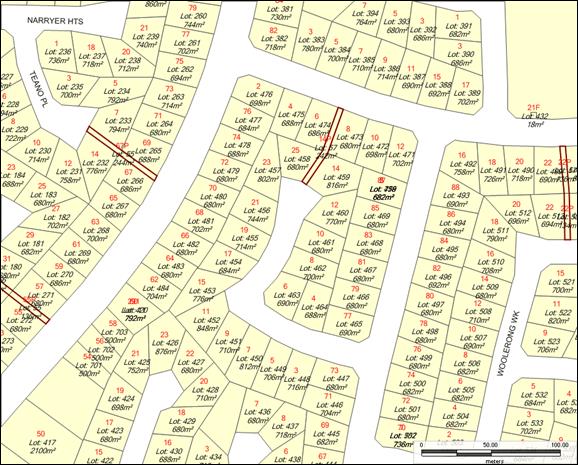
· There will be an impact
on the walkability of residents located within Collison Place. The specific
impact on the distance to identified destinations has been calculated from the
end of the cul-de-sac (greatest impact) and compared against other alternative
routes from that point. Consideration is given to the existing pathways
connections, pedestrian/cycle routes and access points into the community
facilities.
· The increased walking
distance relates to the distance to the community facilities (medical, family
centre and mini mart), bus stops and the primary school.
Effect
on Residents of Collison Place (taken from the point of greatest impact, which is
usually the end of the culdesac)
Rawlinson
Primary School
200 metre
increase (from 200m to 400m)
Community
facilities 180
metre increase (388m to 568m)
John
Moloney Park No
Impact
Bus Stops (Highclere
Boulevard) 330
metre increase (240m to 570m)
The
main increase in distance applies to the primary school and bus stops located
along Highclere Boulevard. The PAW closure only impacts on for the 17 residents
of Collison Place. Consultation should be initiated to ascertain the opinions
of the local residents to determine the suitability of the closure.
CONCLUSION
The
City is required to determine whether the PAW is either
‘Non-Essential’ of ‘Essential’.
Non-Essential – the pedestrian
access way could be closed without causing significant disadvantage to local
residents because it is not essential to the local or strategic
pedestrian/cyclist movement network. Progress to Step 2 to evaluate contextual
crime, consider using situational crime prevention tools and progress closure
if appropriate.
Essential - The pedestrian access
way should be retained and kept open because it plays an essential role in the
local movement network. Progress to Step 2 to evaluate contextual crime and
make recommendations on situational crime prevention and management of the PAW.
With
due consideration for the local and strategic significance of the PAW between
Rawlinson Drive and Collison Place, the pedestrian/cyclist connection is
considered to be ‘NON – ESSENTIAL’.
CONSULTATION SECTION
In
accordance with Section 87 of the Land Administration Act 1997 and subsequent
to the City determining that the PAW is non-essential, the local government is
required to consult with the community to be affected by the proposed closure.
The City referred the proposal to the relevant infrastructure providers and
carried out public consultation for a minimum period of 35 days, which closed
on 7 January 2011. The results of the public consultation are as per the
following;
Service
Authority referral
|
|
Agency
|
Submission
Details
|
Action
|
|
1.
|
Department
of Planning
|
From
an officer level it is possible that the Commission may not support the
proposed PAW closure. Although it is identified by the City as
‘non-essential’ in the wider pedestrian network, it does provide
a greater ease of access to local public transport facilities and a primary
school for those living within Collision Place. When the full report is
provided, including public consultation and all the necessary steps required
in accordance with the ‘Procedures for the Closure of Pedestrian
Access Ways’, the Commission will be able to make a more conclusive
decision.
|
Noted.
|
|
2.
|
WA
Police
|
Refer
‘Step 2’ Contextual Crime Assessment
|
Noted
|
|
3.
|
Water
Corporation
|
Water
Corporation has no objection to the proposed closure. The PAW contains a
100RC water main, which should not be located within private property.
Cutting and capping of the water main will be required at each end.
|
If
closure is progressed, these works will need to be completed by the water
Corporations contractors at the expense of the landowners.
|
|
4.
|
Western
Power Corporation
|
No
objections. Note – If existing infrastructure needs to be relocated due
to any requirement of the proposed amalgamation then Western Power upon
receipt of a request will advise what costs will apply or if easements could
be an appropriate option.
|
Noted
|
|
5.
|
WA
Gas Networks
|
WA
Gas Networks has no assets in the area specified and have no proposed work
which will require amendment to your works.
|
Nil
|
|
6.
|
Telstra
|
Telstra
records indicate that there are no Telstra assets within the area of the
subject proposed closure. No objections. However Tesltra plant records
indicate the approximate location of plant and that constructors and
landowners have a responsibility to anticipate and request nominal location
of Telstra plant in advance of any construction activities including
‘dial before you dig’ and potholing and physical exposure to
confirm actual locations of plant.
|
Noted
|
Public
Submissions
|
1.
|
Fay
Parrella
|
Objects
to the closure of the PAW on the following grounds;
· Experienced no problems
with the PAW
· Others in the street
use the PAW.
· Her children may (as
they get older) use the PAW to walk to school.
· Does not want the
adjoining landowner to have a common boundary and prefers the separation that
the PAW provides.
Requests
that the City assist the other abutting landowners with possible security
measures including the following;
· Have bright lights
installed at the ends of the PAW.
· Increase the fence
height in the lower areas that exist along the PAW.
· Install security
cameras.
· Increase Ranger
security patrols.
· Improve security within
the abutting dwellings including security screen doors, security windows,
alarm systems and repair fencing.
|
Noted
|
|
2.
|
Darren
Chapman
|
The
PAW provides convenient access for local residents to go to the local shops
and local primary school and other locations. I have not witnessed any
anti-social behaviour coming from this pathway and I don’t see any
reason why it should be closed.
|
Noted
|
|
3.
|
Barry
Lockhart
|
I
use this PAW when walking my dog and would be disappointed if it were closed.
Rawlinson Drive can get quite busy and it would mean that I have to cross the
road at a roundabout intersection. When we purchased the property four years
ago, we looked for a culdesac road with a walk through specifically.
|
Noted
|
STEP 2 – CONTEXTUAL CRIME ASSESSMENT
CONTEXTUAL
CRIME ASSESSMENT
Reliable
information about actual and perceived levels of crime associated with a
pedestrian access way is a crucial backdrop to decision making about
interventions aimed at reducing crime and anti-social behavior. It is
uneconomic to commit resources to crime prevention or improving the security of
a PAW, which does not have a crime problem.
The
following information should be obtained regarding actual crime and perceived
crime from users of the PAW and those living or working in close proximity.
· Recorded crimes against
users
· Recorded crimes involving
damage or theft.
Recorded
Crimes (Police Data)
Warwick
Police have reviewed reported crime for both Rawlinson Drive and Collison Place
for the 2010 period and provided the following information.
· Burglaries at 8, 16 and
46 Rawlinson Drive and 21 Collison Place.
· Stealing at 4 and 8
Rawlinson
· 2 x Robberies in
Rawlinson from 1 incident
· 1 x Trespass
Rawlinson
· 1 x Steal motor vehicle
Rawlinson cross of Mirrabooka
· 1 x damage at 30
Rawlinson
Warwick Police have advised that the extent of reported crime is
not a huge volume considering the length of Rawlinson and that no crime was directly
linked or recorded as being directly linked to the PAW.
Recorded
damage to the PAW (COW Maintenance data )
Two
recorded requests to the City to maintain and clean up rubbish in the PAW. One
request in 2007 and the other in 2010.
No
recorded requests for graffiti removal from the PAW.
Recorded
Data on Safer Citizens/Security Call-Out
No
recorded reports of anti-social behaviour or crime related incidents in the
subject PAW within the last 12 months.
Anti-social
activity log (provided by the applicant)
An
anti-social behaviour log has been submitted by the owner of 8 Rawlinson Drive.
The log identifies several recorded incidents occuring last year and other
ongoing incidents including the following:
· Home ‘break
in’ (reported to police March 2010).
· Broken bottles.
· Graffiti
· Syringes in laneway
· Loitering
· Noise
· Litter
RESULTS
OF CONTEXTUAL CRIME ASSESSMENT
The
results of the contextual assessment indicate that there is some identified
risk of anti-social behaviour occurring within the PAW, although the overall
extent of recorded crime and reports of antisocial behaviour are relatively
low. It is noted that the applicants dwelling does have a higher number of
recorded incidents than other properties (based on the WA Police data) and that
there may be specific issues associated with the building security, orientation
or location as a target for anti-social behavior and crime. Whilst the
PAW is considered to be ‘non-essential’, consideration of the
merits of closing the PAW is required using the decision tree (below), which
indicates that a situational crime assessment should be completed along with
any recommendations for improvements/upgrades of the PAW or possible closure.
(Source –
‘Reducing Crime and Antisocial behaviour in Pedestrian Access ways 2009
– WAPC’):
STEP 3 –
SITUATIONAL CRIME ASSESSMENT
INFRASTRUCTURE
PROVIDER IDENTIFICATION
PAW’s
are often used to locate private and public infrastructure such as water,
sewer, gas pipes and electrical cables. The City’s GIS –Utilities
system indicates that the PAW contains the Water Corporations reticulated water
services. Other infrastructure may exist within the PAW and as such
consultation has occurred with all relevant providers as part of the
consultation process (.i.e. Water Corporation, Telstra and Western). No
specific objections were received, however some service modification works will
be required to the Water Corporations infrastructure at the cost of abutting
purchasers.
PHYSICAL
ASSESSSMENT (photos included)
Location: Between Rawlinson Drive
and Collison Place, Marangaroo
Design
Characteristics:
The subject PAW is 4 metres wide and approximately 60 metres long. The path is
2 metres wide with 1.0 metre landscape strips on either side. The path slopes
gently from Rawlinson Drive to Collison Place and has a bend in the middle
preventing a direct line of sight between the ends of the PAW.
Paving:
The paving is older concrete in average condition.
Fencing: The PAW has super
six/fibro fencing along both sides of its entire length. The fibro fencing is
in average condition with some evidence of damage.
Landscaping:
The PAW
has no vegetation with the exception of small weeds. Some additional
maintenance could be carried out, however, the PAW is in generally in
acceptable condition.
Lighting:
Street
light exists at either end of the PAW.
Access
Barriers:
The PAW has access barriers at either end.
Antisocial
Behaviour:
A few empty bottles and cans and some evidence of graffiti was noted that might
indicate some extent of anti-social behavior and/or littering.
Collison
Place end of the PAW
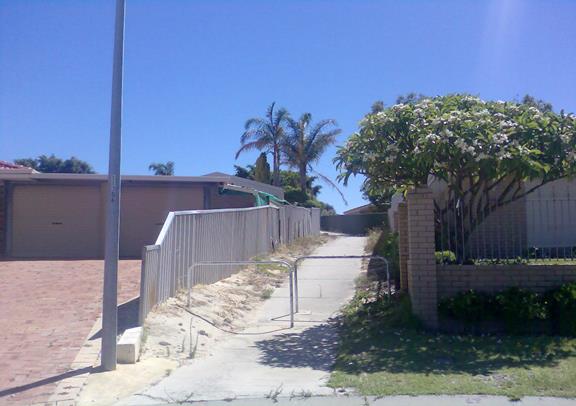
Rawlinson
Drive end of the PAW.
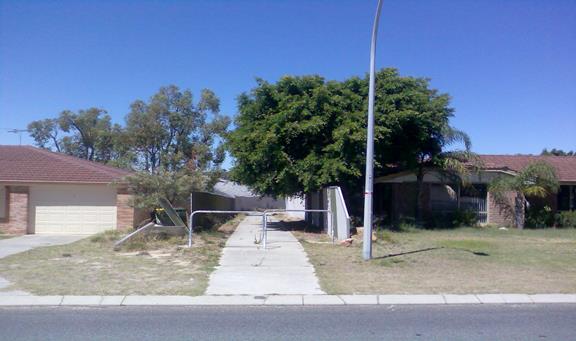
The
bend in the PAW obscures sight lines between the entrance and exit of the PAW.
The overgrown vegetation in this location compounds the issue by further
obscuring the users sight lines.
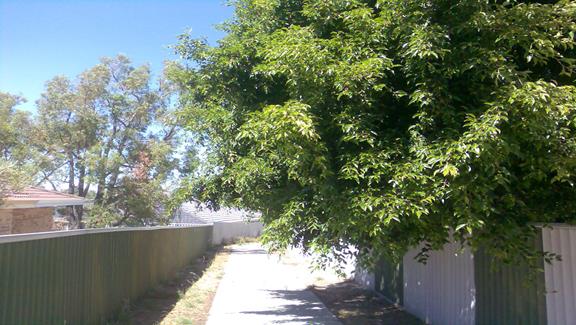
The
PAW has no surveillance from the adjoining property’s.
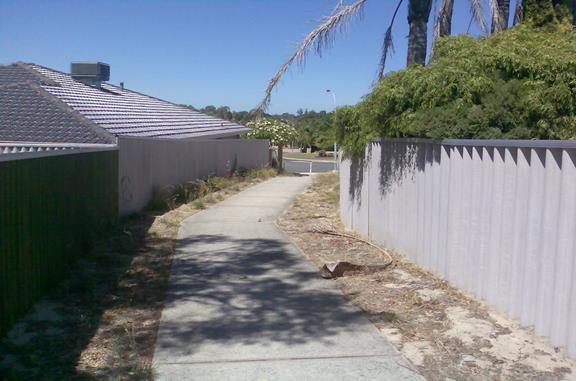
The
boundary fence is in poor condition along several sections, with some sections painted
and others unpainted.
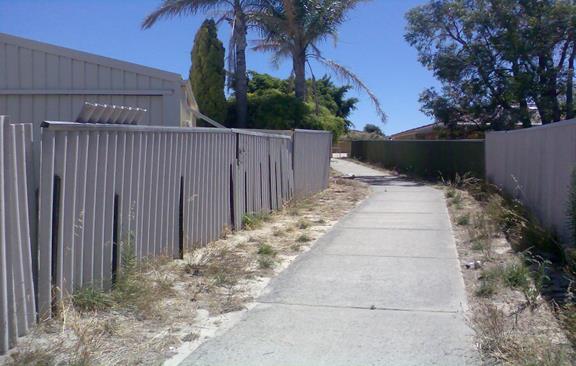
The
boundary fence along 8 Rawlinson Drive is only 1.5 metres at is lowest point ,
which enables users of the PAW to view into the backyard of this property.

DESIGNING
OUT CRIME PAW ASSESSMENT – TABLE 1 (RISK CRITERIA)
|
1.
The pedestrian access way is overlooked (visual surveillance) at either of
its ingress/egress points.
|
YES
|
|
|
2.
The pedestrian access way is overlooked (visual surveillance) along its
route.
|
|
NO
|
|
3.
Does the pedestrian access way have adequate lighting (eg facial recognition
at 10 m distance)?
|
|
NO
|
|
4.
On entering the pedestrian access way, can you see the exit?
|
|
NO
|
|
5.
There are no entrapment spots or hiding places along the length of the
pedestrian access way.
|
|
NO
|
|
6.
The pedestrian access way is appropriately maintained.
|
|
NO
|
|
7. The
boundaries between public space and private space are clearly defined.
|
YES
|
|
|
8. The
boundaries between public space and private space are robustly fenced.
|
|
NO
|
|
9.
Does the pedestrian access way have signs indicating acceptable Behaviour?
|
|
NO
|
|
10.
The pedestrian access way is wide enough to allow pedestrians to pass each
other easily.
|
YES
|
|
|
11.
The pedestrian access way is not adjacent to vacant land or property.
|
YES
|
|
|
12.
The pedestrian access way is not close to a supplier of alcohol (eg liquor
store, hotel, tavern, bottle shop).
|
YES
|
|
|
13.
The pedestrian access way is not a path to a school.
|
|
NO
|
|
14.
The pedestrian access way is not close to an ATM, public telephone box or
public toilet
|
YES
|
|
|
TOTAL
|
6
|
8
|
Designing out crime
pedestrian access way assessment (number of yes answers)
· High designing out crime pedestrian access way
assessment (low vulnerability pedestrian access way): 10-14
· Medium designing out crime pedestrian access way
assessment (medium vulnerability pedestrian access way): 5-9
· Low designing out crime pedestrian access way
assessment (high vulnerability pedestrian access way): 0-4
SOCIO
ECONOMIC VULNERABILITY ASSESSMENT
The
Australian Bureau of Statistics socio-economic index for areas (SEIFA) is obtained
from the ABS website and provides a means for assessing the relative
socio-economic advantage of different areas based on census data. The SEIFA
data can be used alongside the physical analysis to represent whether a PAW is
likely to be of a high or low crime risk due to socio-economic context. The
SEIFA information released by Australian Bureau of Statistic in May 2008 (2006
data) has been utilised and whilst the City does not associate a direct link
between SEIFA data and a particular area, the WAPC guidelines indicate that
statistically areas of lower socio-economic status are often associated with
increase crime levels.
City
of Wanneroo SEIFA Rating derived from the Australian Bureau of Statistic
– 2006 (released 2008)
|
SUBURB
|
SEIFA RATING
|
SUBURB
|
SEIFA RATING
|
SUBURB
|
SEIFA RATING
|
|
Alexander
Heights
|
1004
|
Hocking
|
1060
|
Pearsall
|
1091
|
|
Ashby
|
1026
|
Jandabup
|
N/A
|
Pinjar
|
N/A
|
|
Alkimos
|
N/A
|
Jindalee
|
1165
|
Quinns Rocks
|
1032
|
|
Banksia Grove
|
946
|
Koondoola
|
875
|
Ridgewood
|
991
|
|
Butler
|
1066
|
Landsdale
|
1082
|
Sinagra
|
1053
|
|
Carabooda
|
1002
|
Madeley
|
1071
|
Tapping
|
1076
|
|
Carramar
|
1095
|
Marangaroo
|
958
|
Tamala Park
|
N/A
|
|
Clarkson
|
990
|
Mariginiup
|
N/A
|
Two Rocks
|
948
|
|
Darch
|
1084
|
Merriwa
|
954
|
Wangara
|
1008
|
|
Eglington
|
N/A
|
Mindarie
|
1121
|
Wanneroo
|
995
|
|
Girrawheen
|
884
|
Neerabup
|
1007
|
Woodvale
|
1101
|
|
Gnangara
|
N/A
|
Nowergup
|
1011
|
Yanchep
|
979
|
*City
of Wanneroo Average 1023
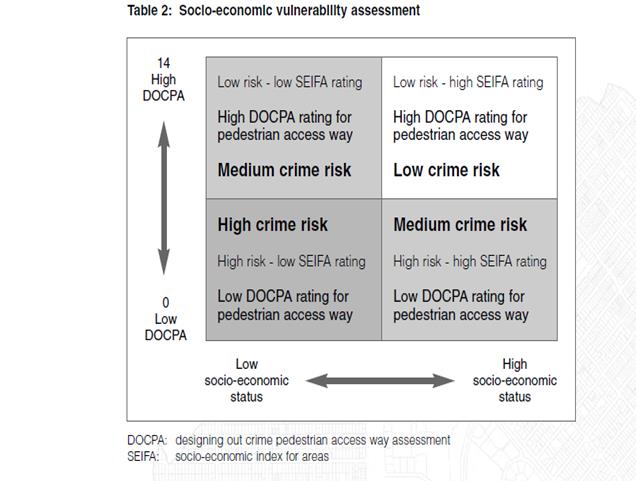
OUTCOME
– RECOMMENDED MANAGEMENT ACTIONS SHOULD THE PAW CLOSURE NOT BE PROGRESSED
The
PAW locality has a relatively low SEIFA score of 958 (City of Wanneroo average
1023) and a medium DOCPA score of six (6). The PAW is considered to be a
‘MEDIUM to HIGH RISK’ pedestrian/cyclist access link.
The
following table represents strategies that may be implemented by the relevant
business unit of the City to assist in designing out crime in the subject PAW.
The following strategies are the actions that may be recommended by Planning
Implementation, however, the relevant business unit will need to determine the
priority and suitability of implementing these recommendations. The
recommendations of the Council report will include appropriate strategies
relevant to the subject PAW, should closure not be supported by Council.
· Remove
overhanging vegetation to improve sight lines
· Remove
graffiti quickly to send the message that the PAW is being properly managed as
a public space.
· Clean
and make repairs quickly
· Ensure
that the walking surfaces are well maintained.
· Improve
lighting (brighter lights) to enhance visibility both ends of the PAW or the
possibility of lighting along the route of the walkway (also sensor lighting).
· Install
safety mirrors to improve sight lines
· Clear
weeds and shrubs
· Install
permeable fencing
· Increase
passive surveillance
· CCTV for
high use PAWs near commercial areas
· Mobile
CCTV
· Install
signage
· Density
matting, climbing plants on fencing subjected to vandalism. This technique can
also make accessing the abutting property’s more difficult.
· Install
bollards to restrict vehicle access
· Closing
PAW during vulnerable times (i.e. sunset to sunrise)
· Establish
police or security patrols
PS08-04/11 Sustainability
Investment Fund Policy
File Ref: 5375
– 11/25212
Responsible
Officer: Director, Planning and Sustainability
Disclosure
of Interest: Nil
Attachments: 1
Issue
To consider endorsement of the Sustainability Investment
Fund (SIF) Policy.
Background
In the 2010-2011 financial year budget, Council set aside a
sum of $50,000 in the Environmental Initiative Reserve (EIR), for the purpose
of establishing the SIF. The SIF concept was presented to Council as part of
the June 2010 budget approval process and again at the 14 December 2010 Council
Meeting (PS12-12/10) where Council resolved to expend $48,995 from the reserve
to fund SIF initiatives.
SIF initiatives are aimed at reducing the City’s environmental
footprint and reducing the City’s utility/energy bills. It is intended
that utility cost-savings arising from initiatives funded through the SIF will
be redirected back into the EIR, thus growing the funding available to
undertake further initiatives in future. A policy has now been developed
to assist in the operation of the SIF.
Detail
Included as Attachment 1,
the SIF Policy identifies the type and features of projects suitable for
funding through the reserve, how they are selected and managed, and the
required reporting on these projects to ensure the financial savings are
reinvested back into the fund.
Examples
of projects and initiatives funded through the SIF in 2010-2011 include
lighting upgrades, installation of standby timers, meter upgrades and energy
audits. Particular projects were chosen as payback on investment could
be demonstrated within 12 months and the City's carbon footprint could be
significantly reduced.
Elected Members will be updated on
the SIF expenditure through the annual report and other internal communication
processes.
Comment
Expenditure of the SIF allows the City to fund initiatives
that SERVE TO REDUCE THE City’s carbon emissions while also reducing
costs associated with water and power usage. Implementation of the SIF Policy
will enable financial savings, when compared to a ‘business as
normal’ approach, to be demonstrated and translated into carbon emissions
savings and other environmental benefits. Endorsement of the SIF Policy will
provide Council direction on expenditure of the fund over time with the
achievement of specified sustainability outcomes.
Strategic
Implications
The proposal accords with the following Outcome Objective of
the City’s Strategic Plan 2006 – 2021:
“1 Environment
1.1 Improve
conservation of local biodiversity in designated areas”
1.2 Protect,
conserve and recycle water
1.4 Improve
the quality of the built environment
Policy
Implications
The Sustainability Investment Fund Policy will become an
endorsed policy by council.
Financial
Implications
In June 2010, Council approved the allocation of $50,000
seed funding to a reserve for the purpose of expenditure on sustainability
initiatives that demonstrate improved environmental benefit and financial
savings. It is intended that the fund will be replenished through the Council
budget for a five year period after which the fund will be self sustaining by
accumulating the demonstrated savings achieved through the implementation of
the environmental initiatives. This time period will, however, be
reviewed as the Policy is implemented to ensure the fund is adequately able to
adjust to the large growth in population currently being experienced and ensure
self-sufficiency within the fund is established.
Through the annual Budget adoption process, Council will
determine the continuing allocation of any future funds to the SIF and
replenishment of the SIF using savings generated by sustainability initiatives.
Voting
Requirements
Simple Majority
Recommendation
That Council ADOPTS the Sustainability Investment
Fund Policy as detailed in Attachment 1.
CITY OF WANNEROO Agenda
OF Ordinary Council Meeting 05 April, 2011 108
Sustainability Investment Reserve Fund Expenditure and Reporting Policy
Policy
Owner: Planning
and Sustainability
Contact
Person: Sustainability
Officer
Date
of Approval:
POLICY OBJECTIVE
To outline the purpose of
the sustainability investment fund, the process for expenditure and how
financial savings will be reinvested back into the fund.
POLICY STATEMENT
· Identify
criteria for project assessment and selection
· Develop
a process for fund expenditure
· Identify
what savings are and how these will be reinvested back into the fund.
SCOPE
City of Wanneroo projects with measurable sustainability
outcomes.
Background
In June 2010, Council approved the allocation of seed
funding to a reserve for the purpose of expenditure on sustainability
initiatives that demonstrate improved environmental benefit and financial
savings. It is expected that the fund will be replenished through the Council
budget for a five year period after which the fund will be self sustaining by
accumulating the demonstrated savings achieved through the implementation of
the environmental initiatives. This time period will be reviewed as the
policy is implemented to ensure the fund is able to adjust to the large growth
in population currently being experienced and ensure financial self-sufficiency
is established.
Through the annual Budget adoption process, Council will
determine the continuing allocation of any future funds to the SIF and
replenishment of the SIF using savings generated by the sustainability
initiatives.
CONSULTATION WITH STAKEHOLDERS
An investment plan will be developed at the beginning of
each financial year and shall involve consultation with Executive Management
Team and approval by Council, to ensure the highest priority projects which
offer the greatest environmental and financial rewards are funded.
IMPLICATIONS (Financial, Human Resources)
Investment tracking may require the use of additional
resources (staff, contractors or materials) in order to effectively report,
especially as the fund grows and larger projects are funded. It is the
responsibility of the City’s Sustainability Officer to demonstrate that
resources are available and gain commitment to meet the reporting requirements.
IMPLEMENTATION
The City’s Sustainability Officer will request
potential projects from across the organisation on an annual basis. Potential
projects will then be reviewed and if acceptable collated with others as part
of an annual recommendation to the Executive Management Team (EMT) in an
investment plan, which will be subject to Council approval. The
assessment will be based on a project’s ability to provide environmental
benefit, while providing a saving that provides an average of less than twenty
four months to repay initial funds. An investment may be an entirely new
proposal, or to supplement an existing proposal paying a “premium”
to allow for greater consideration of whole of life costing and benefit.
Each project will include a tangible reporting mechanism for
demonstrating savings. Only reporting mechanisms that contain known,
measurable variables[1]
will be considered as suitable for isolation to return to the fund. Where
there are further estimated savings[2],
these will be included in the report, but will be deemed as associated benefit
and not isolated for return. Reporting on fund progress will be presented
during the budget preparation period and as part of the Annual Report with
estimations of current savings to coincide with budget requirements for the
next financial year.
Additional communication on the success of the SIF may be
communicated through other methods such as the CEO report or Clipboard as
deemed appropriate.
ROLES and RESPONSIBILITIES
Council
will endorse the funding for the sustainability investment reserve on an annual
basis and will be responsible for approving the annual investment plan.
Release of the reserve funds in accordance with the approved
Investment Plan will be the responsibility of the Director, Planning and
Sustainability following presentation to EMT.
The Sustainability Officer is responsible for assessment of
potential projects to be implemented through the fund, preparation of a report
to EMT for release of the funds and preparation of annual reports and project updates.
Assessment, implementation and reporting of the projects
will be overseen by the Principal Environmental Planner.
DISPUTE RESOLUTION
All disputes in regard to this Policy will be referred to the Director,
Planning and Sustainability.
WHO NEEDS TO KNOW about THIS POLICY?
All service units can request projects be considered and the
entire organisation should be aware of the Policy.
EVALUATION and Review Provisions
The effectiveness of the Policy will be established through
the success of the projects supported through the Fund. Environmental
improvement and financial savings will be monitored and included in annual
reporting.
Environmental improvement will be measured by establishing a
baseline and then measuring set criteria to demonstrate environmental benefit.
For example, carbon emissions reductions can be established through current
electricity usage, reduced energy usage will produce a known reduction in
carbon emissions. Other environmental variables that could be used to
demonstrate environmental improvement include water quality, reduced water use,
reduced waste production and protection of biodiversity and associated habitat.
Financial saving will be assessed by tracking known
variables and demonstrated monetary savings.
Projects will be tracked and savings isolated for their
complete life cycle or up to a maximum period of five years.
RESPONSIBILITY FOR IMPLEMENTATION
Sustainability Officer
|
Version
|
Next Review
|
Record No:
|
|
|
June 2013
|
|
|
|
|
|
|
|
|
|
File
Ref: 2079
– 11/17188
Responsible
Officer: Director, Planning and
Sustainability
Disclosure of Interest: Nil
Attachments: 9
Issue
To consider the final East Wanneroo Structure Plan (EWSP)
which has been released by the Western Australian Planning Commission (WAPC),
and the concerns it presents in respect to the timely provision of certainty to
landowners in that area regarding prospects for future urban use.
Background
Draft EWSP (November 2009)
The draft EWSP was released for public comment by the WAPC
in November 2009. Key plans included in the draft are included as Attachments
1 and 2 to this report.
The draft was considered at Council’s meeting of
15 December 2009 (item PS05-12/09). It was resolved that Council:
“1. ENDORSES
the comments contained in Attachment 4 as the basis for the City’s
submission to the Western Australian Planning Commission on the East Wanneroo
Structure Plan; and
2. NOTES
the Mayor has already addressed the Council’s concerns to the Hon.
Minister for Planning on the consultation strategy and lack of information by
the Department of Planning.
3. INVITE
the Member for Wanneroo to hold a public forum for local affected residents and
key interested parties to enable the stakeholders to identify issues of concern
and to seek practical solutions.”
Further details concerning the comments contained in
Attachment 4 referred to in point 1 of the above resolution, and particularly
how these have been (or not been) addressed in the final EWSP, are provided in
the Comment section below.
Analysis of Public Submissions Report (June 2010)
In June 2010, the WAPC released an ‘Analysis of Public
Submissions’ report. This analysed the key issues raised in the 738
submissions received on the draft EWSP and included an indication as to how the
WAPC intended to respond to these issues, including, in general terms, the
changes intended to the draft EWSP.
The report advised that the Department of Planning (DoP)
would be proceeding to prepare the proposed final EWSP for WAPC consideration
around the end of that year.
Detail
The final EWSP was released by the WAPC on 27 January
2011. Copies of the plan have been provided to each Elected Member.
The main parts of the EWSP are Section 5 (‘The Structure Plan’) and
Section 6 (‘Implementation’). Section 5 includes five
‘key strategic objectives’ of the plan. The overriding
objective of the Plan is “To provide a high level strategic framework
to guide future more detailed planning within the study area and identify
matters requiring further investigation”. Section 5 also
includes a EWSP map (see Attachment 3) and description of the five
‘key elements’ of the Structure Plan. These relate to land
use, public utilities, ecology and environment, movement and access and economy
and employment.
Section 6 includes an ‘Implementation Plan’
(section 6.2) which deals with:
·
Amendments to the Metropolitan Region Scheme (MRS) and City of
Wanneroo District Planning Scheme No. 2 (DPS 2);
·
District and Local Structure Plans;
·
Staging of urban development;
·
Land assembly and financing infrastructure;
·
Development sequencing. (This refers to an Appendix B of
the Structure Plan, part 1 of which is a plan showing the study area divided
into precincts, with dwelling potentials given for each precinct (see Attachment
4). Part 2 is a table which summarises current servicing capacity for
each precinct, and infrastructure required for each precinct).
The implementation aspect of the EWSP is particularly
important and further details regarding the EWSP’s proposals for this are
provided in the following Comment section.
Consultation
Nil
Comment
COMPARISON OF THE FINAL EWSP AND THE DRAFT EWSP
The differences between the draft EWSP and the final EWSP
are included in a table in Attachment 5. The key differences are
briefly described below:
1. Key differences in
the main Structure Plan maps:
a) A
number of existing special rural subdivisions are proposed to remain rural, and
not change to urban as proposed under the draft EWSP (see 2. b) and c) of Attachment
5).
b) An
area in Wanneroo and Gnangara is proposed for urban use, rather than remaining
rural as proposed under the draft EWSP (see 2. d) in Attachment 5).
c) An
extension is proposed to the Wangara industrial area, north of Ocean Reef Road
(see 2. g) in Attachment 5).
2. Key
differences in the implementation proposals:
a) The
draft EWSP proposed that initially, the MRS would be amended to Urban Deferred,
and then subsequently the deferment status would be lifted following completion
of local structure planning and preparation of development contribution
arrangements. The final EWSP, while making some initial reference to
rezoning to ‘Urban Deferred or Urban’, focuses on rezoning to
Urban, with little consideration to a staged rezoning approach.
b) The
draft EWSP did not propose a District Structure Plan stage of planning, while
the final EWSP does. (The City’s position on this proposal of the
draft EWSP was that it had no objection with there being no District Structure
Plan, provided that the final EWSP includes an adequate level of detail to give
effective guidance for preparation of local structure plans. The WAPC has
evidently decided that it does now not wish the EWSP to provide that level of
detail and guidance and has therefore reintroduced a requirement for district
structure planning).
c) The
draft EWSP proposed that most of the further studies required as a next stage
to progress rezoning and planning of the area would be done by State and
Federal agencies. However, the final EWSP places most of the
responsibility for doing these studies with ‘proponents’ (i.e.
landowners and developers) and the City.
This matter is discussed further
under the heading of ‘Key Issues for Consideration’ below.
HOW THE FINAL EWSP HAS RESPONDED TO COUNCIL’S
SUBMISSION ON THE DRAFT EWSP
Council’s submission on the draft EWSP included
comments on eight ‘major issues’ and 53 ‘Detailed
Comments’. Rather than addressing all of the comments made in the
submission in this report, only those key comments are addressed which the
final EWSP is considered to have not satisfactorily responded to. A table
is included in Attachment 7 which sets out the relevant submission
comments and the response to each of those comments.
Significant submission comments and responses are briefly
described below:
1. The
City sought that a longer term planning horizon be used, and that on this
basis, the East Wanneroo area not be viewed as the long term urban
‘edge’. The final EWSP continues to use only a 2031 planning
horizon, and to view this as the long term urban ‘edge’.
2. A
detailed implementation program needed to be prepared which clearly set out
what was required to be done, by whom, and by when. The final EWSP does
not include such a detailed program.
3. Detailed
planning studies by the City should not be required to be carried out until MRS
rezoning to Urban Deferred was in place. The final EWSP requires that the
City completes such detailed planning studies (particularly in respect to
district structure planning) as a prerequisite to MRS rezoning.
KEY
ISSUES FOR CONSIDERATION
1. Proposed
Implementation Plan
It
is recommended that the EWSP’s proposed Implementation Plan be rejected
for the following reasons:
a) It
does not provide an adequately detailed implementation strategy in terms of
exactly what now needs to be done to take matters to the point of landowners
being in a position to apply to subdivide and develop their land. Such a
strategy needs to set out in detail exactly what is to be done, by whom, and by
when.
b) It
involves the next phase of planning having to address not only whether land is
suitable for future urban development, but how and when it would be
developed. This means many further detailed planning studies (including
detailed plans for infrastructure provision, staging, activity centres,
detailed buffers to poultry and mushroom farms) having to be done which are
unnecessary in terms of confirming suitability for future urban use, and would
significantly prolong the process of giving landowners in the area certainty as
to whether they are going to have a rural or urban future. The process
should be aiming to provide certainty to all stakeholders as soon as possible
through initially rezoning to Urban Deferred under the MRS. Such certainty would
also provide the confidence required for the more detailed stages of planning
to be undertaken, and give the City assurance that any costs it may incur in
progressing the planning of this area should be able to be recouped through
development contributions.
The
studies which are likely to be required to confirm suitability of land for
future urban use, and to determine any regional reservation requirements (which
would also need to be included in a MRS Amendment to Urban Deferred) are listed
in Attachment 8.
c) It
puts the onus for doing the many further studies required to support an MRS
amendment mainly on the landowners/developers and the City. While this
approach may be workable for areas like the coastal ‘corridor’ west
of Wanneroo Road which involves large landholdings owned by relatively few
large developers, it is not workable for an area like East Wanneroo in terms of
its fragmentation and land ownership patterns.
The
final EWSP itself recognises this (page 35): “The mixed use nature of
the Structure Plan, together with multiplicity of landownership and need for
substantial infrastructure investment, will contribute to cost and complexity
in achieving urbanisation. Implementation will require cooperation and
involvement of State government agencies, local government, the private sector
and the community. In particular, implementation will require a careful
approach to staging and will necessitate preparation of developer contributions
and cost sharing arrangements”.
Such
a cooperative approach is required from the State government agencies and it is
recommended that such cooperation now be sought on this matter, with the State
Government needing to accept a significant role, particularly in confirming
urban suitability of the land and determination of regional reservation
requirements, as intended under earlier State Government reports on this area.
2. Provision of
Infrastructure and Services
The
implementation issues dealt with in 1. above focus mainly on what is required
to be done to take the planning of this area from the broad level as now
represented by the final EWSP, to the detailed level represented by Local
Structure Plans and development contribution planning (after which subdivision
and development can follow).
Strategic
planning, however, involving integration of land use planning with the
provision of the infrastructure and services which is required to enable
development to actually occur is also required. This particularly relates
to the provision of the key utilities such as water supply, sewerage and
electricity, and especially the ‘mains’ infrastructure required for
these. In accordance with Directions 2031 and Beyond, the Infrastructure
Coordinating Committee of the WAPC is overseeing the preparation of a program aimed
at facilitating the timely delivery of such infrastructure.
It will be important that the East Wanneroo area is given appropriate attention
in this program, and that this flows onto the capital works programs of each
agency, particularly the Water Corporation, which has indicated through the
EWSP that significant water and sewerage related mains infrastructure will be
required.
3. Environmental
Issues
The
final EWSP identifies the various environmental issues which will require
further study, the key ones being:
·
Obtaining of Federal Government environmental approvals in
respect to Carnaby’s Black Cockatoo and the Graceful Sun Moth;
·
Protection of regionally and locally significant bushland areas;
·
Protection of significant wetlands and wetland buffers;
·
Provision of ecological linkages;
·
Groundwater management (including acid sulfate soils).
These
issues should desirably be addressed in a holistic manner, requiring close
cooperation of relevant Federal and State agencies and this City. There is a possibility
that the Environmental Protection Authority (EPA) may require formal
Environmental Review of proposed MRS Amendments for this area, and this would
also require such a holistic approach, and would raise the question of who is
to be the proponent, and therefore hold main responsibility for addressing
these matters.
Implementation
will also require a broad and cooperative approach: while it may be one thing
to propose areas for protection, it is another to determine exactly how that
protection is to be achieved, particularly if the intention is for the land
concerned to be brought into public ownership.
The
Gnangara Sustainability Strategy (GSS) study has recommended that parts of East
Wanneroo should change from rural to urban use as this would not only assist in
provision of affordable housing land in this part of the metropolitan region,
but also because it would assist in addressing declining groundwater levels in
the area, which is impacting on environmental values of the area. The GSS
study argues for this area being able to urbanise as soon as possible, and for
Government agencies to facilitate this in an effective manner. This also
means not placing the onus for progressing the planning of this area mainly on
the many small landowners in the area (which the WA Planning Commission is
currently proposing), but rather the onus being placed more on the relevant
Government agencies, particularly for the next stages of planning required.
4. Lack
of Governance Structure
The
issues dealt with in 1, 2 and 3 above will involve a need for close cooperation
between a wide range of government agencies. To enable such close
cooperation, an appropriate governance structure should be established by the
WAPC.
5. Land
Affordability and Choice
The
existing East Wanneroo urban ‘cells’ from Madeley/Darch/Landsdale
in the south, to Carramar/Banksia Grove in the north, are likely to be fully
developed over the next few years. (East Landsdale and Banksia Grove will
take somewhat longer to fully develop).
Full
development of those areas, without the proposed new East Wanneroo areas being
available for new residents, will mean a significant reduction in choice of
location for future residents of this City.
It is also likely to mean a reduced availability of affordable housing land, as
the eastern parts of this City have generally tended to be more affordable than
the new residential areas nearer the coast.
This
indicates a need for the planning and development of the EWSP area to be
progressed in as timely a manner as possible, and again argues for an
appropriate governance structure to be established to facilitate this.
6. Longer
Term Strategic Planning
This
City has previously made submissions on a number of State Government planning
initiatives (e.g. draft Directions 2031, draft Gnangara Sustainability, draft
EWSP), which argued that a planning horizon well beyond 2031 needed to be
considered. On this basis, a strong case was felt to exist for longer
term urbanisation to extend east of the urban areas proposed in the EWSP,
into the current State forest areas, and potentially linking to
Ellenbrook. Further development on State owned land would assist in
justifying and delivering key infrastructure to support the growth corridor
such as new road and rail links (to strategic sites like Neerabup) and a new
regional airport.
Although
these submissions have not proved successful to-date, the arguments put forward
are still considered sound and it is therefore recommended that Council
continue to pursue these initiatives.
This
would have important implications for the planning of the EWSP area if
successful, as it would mean infrastructure would need to be able to
accommodate such additional growth.
7. Implications
for Existing and Proposed Activity Centres
The
EWSP estimates a dwelling potential of 24,900 dwellings for the potential urban
areas proposed. This equates to a population of approximately
65,000. Such a significant additional population in this area would
represent a substantial boost to the development potential of adjacent existing
and proposed activity centres, particularly the Wanneroo Town Centre and the
proposed Banksia Grove District Centre, greatly enhancing their prospects for
becoming successful activity centres with a wide range of services and
jobs. Should the development of the East Wanneroo area be delayed through
inefficient planning processes or delays in major infrastructure provision then
that would be expected to also delay the benefits which this future growth hold
for these centres. This again argues for planning processes and enabling
governance structures which will facilitate the timely planning and provision
of infrastructure for this area.
8. Consideration
of Planning Proposals
At
its meeting of 11 December 2007 (item PD01-12/07), Council considered the
‘Future of East Wanneroo’ report of the WAPC. This report
preceded the draft EWSP. In summary, Council resolved to:
a) Endorse
a process prepared by Administration for how to progress the planning of the
proposed East Wanneroo Urban areas (see Attachment 9)
b) Not
to support any independent planning proposals for this area which may be viewed
as premature in relation to the above planning process;
c) Require
the Director, Planning and Sustainability to only accept planning proposals for
the consideration of Council if the Director was satisfied that the proposal
was not premature having regard to the stage reached in the planning process
generally for the area and particularly having regard for the process referred
to in a) above.
The process set out in Attachment
9 is still considered to be generally sound, but should not be relied upon as a
long-term City position on planning and development in East Wanneroo, for the
simple fact that the planning landscape has now changed (with the release of
the EWSP) since that Council position was adopted in December 2007. With the
release of the EWSP, landowner pressure and expectations to progress planning
for the area will understandably rise over time, and it will be both
insufficient and ineffective for the City to indefinitely deal with planning
proposals on a case-by-case basis, in accordance with Council’s December
2007 resolution.
Administration was hopeful that
the EWSP would include some meaningful guidance for implementation to avoid the
need for the City to continue to rely on its December 2007 resolution, but that
has not occurred. Consequently, for the benefit of affected landowners and in
order to proactively advance the planning of the area, Administration is
proposing to prepare a Local Planning Policy for Council’s consideration,
to clearly dictate the City’s requirements and expectations for
progressing planning proposals in East Wanneroo. Council’s December 2007
resolution will serve as an acceptable interim position for dealing with such
proposals, until it is superseded by a more comprehensive and formal policy
position, adopted under DPS 2.
A Local Planning Policy for the
EWSP area will need to identify, among other things, the various steps in the
planning process that need to be completed in order for a proposal to gradually
progress towards development (if at all), and the prerequisites that need to be
satisfied before a proposal is allowed to progress to the next stage of
planning. It is envisaged that such a policy could dissect the broader East
Wanneroo area into more manageable and clearly defined precincts that share
common characteristics, opportunities and constraints, so that the planning in
less constrained and more developable precincts can progress without being
disadvantaged or delayed by issues and constraints that affect other, more
remote precincts.
If Council supports this approach,
Administration will commence preparation of a Draft Policy immediately, to
clearly determine what Council will expect and accept in terms of planning
proposals in the East Wanneroo area.
9. City
Position on the Final EWSP Land Use Proposals
Further
studies will be required to be completed to confirm suitability of the subject
land for the urban and other uses proposed. It is recommended that
Council reserves its position at this stage regarding the various proposals
shown on the EWSP map, pending the outcome of those studies.
10. Community
Perception of ‘Ownership’ of EWSP Document
It
needs to be made very clear to the community that the EWSP is a WAPC document,
and not a City of Wanneroo document.
The
EWSP itself gives a misleading impression regarding the extent of this
City’s involvement in the preparation of the final EWSP, by stating that
it has been prepared in close consultation with the City Of Wanneroo (page
2). While City Administration was reasonably closely involved in the
preparation of the draft EWSP, and the early stages of preparation of the final
EWSP, it was not involved in the final stages.
In preparing the final EWSP, the DOP and WAPC have chosen to ignore many of
this City’s key comments and concerns in relation to the future planning
of East Wanneroo, particularly to the next stages in the planning
process. The issues raised in this report need to be addressed by the
State Government as a matter of urgency to provide clarity and certainty to the
residents of East Wanneroo.
11. Comparison
with Processes Involved with Existing East Wanneroo Urban ‘Cells’
It
may be useful to briefly compare what is currently being proposed by the EWSP
in terms of planning and implementation process, with what has occurred in
respect to the existing East Wanneroo urban ‘cells’ (referring to
the new residential areas located east of Wanneroo Road and north of Hepburn
Avenue, comprising the localities of Madeley, Darch, Landsdale, Pearsall,
Hocking, Sinagra, Ashby, Tapping, Carramar, Banksia Grove and parts of
Wanneroo).
In
the case of the latter, that area was first proposed for urban use, at a
regional strategic level, through ‘Metroplan’, which was adopted as
the new strategic plan for the Perth metropolitan region in 1990 (and which has
subsequently been replaced by ‘Directions 2031 and Beyond’).
In
1992, a revised North West Corridor Structure Plan (NWCSP) was approved, which
included broad structure plan proposals for the proposed new urban areas
east of Wanneroo Road as described above.
Having
prepared the NWCSP, the then State planning agency (Department of Planning and
Urban Development – DPUD) proceeded to prepare a major amendment to the
MRS to rezone the proposed urban areas to Urban and Urban Deferred zones under
the MRS and the then State Planning Commission and the then Minister for
Planning approved initiation of the amendment. Through this process, with the
State planning agency as proponent, that area was rezoned for urban use under
the MRS.
The
fundamental difference between the older areas of East Wanneroo and what is
proposed now is that the State Government provided the lead role in the MRS
amendment process to rezone land to Urban/Urban Deferred which they are leaving
to the landowners/City to progress in the case of the current EWSP. There is a
long established precedent and process which works and this raises concerns
with the current implementation process which, given the fragmented land
ownership, is unlikely to progress efficiently.
Statutory
Compliance
Nil
Strategic
Implications
The final EWSP has important implications for all of the
outcomes sought under the City’s Strategic Plan, and especially for the
following objectives of the plan:
“1 Environment
1.1 Improve
conservation of local biodiversity in designated areas
1.1.1 Improve
local biodiversity protection.”
Policy
Implications
The City’s Smart Growth Local Planning Policy requires
that sustainability related considerations be properly taken into account.
Local Planning Policies 4.1 (Wetlands), 4.2 (Structure
Planning) and 4.3 (Public Open Space) will also be relevant when those issues
are subsequently addressed in further detail.
Separately to the above, and as outlined earlier in this
report, Administration intends to prepare a Local Planning Policy for
Council’s consideration, to establish a more contemporary position on
what the City will accept and expect in terms of planning proposals in the East
Wanneroo area. In accordance with DPS 2, such a policy will need to be
advertised for public comment if accepted by Council. This would include
referral to affected landowners, developer stakeholders and government agencies
for comment.
Financial
Implications
Plans involving change of use of a large rural area to urban
has significant financial implications for the City, particularly in relation
to provision of infrastructure and services which will be required by these
future urban communities. The preparation of the plans themselves (and
the supporting studies required), where not able to be undertaken by
developers, can also be costly.
This will need to be addressed through preparation of developer
contribution plans for these areas.
It should be noted that developer contributions are only
able to be charged if the land concerned is actually rezoned and developed for
the proposed urban use. This argues for the City not incurring any costs
intended to be recouped through developer contributions, until there is
adequate certainty provided, through Urban Deferred zoning being in place.
Voting
Requirements
Simple Majority
Recommendation
That Council:-
1. REQUESTS
the Western Australian Planning Commission (WAPC) to prepare a detailed and
clear implementation process that addresses the issues raised in this report.
2. REQUESTS
the WAPC to fund the various studies required to enable initiation of rezoning
to Urban Deferred, and reserving the relevant regional reservations, under the
Metropolitan Region Scheme.
3. SEEKS
a deputation with the Infrastructure Coordinating Committee of the WAPC to
discuss the matter of future infrastructure provision for the East Wanneroo
area.
4. REQUESTS
the WAPC to establish a governance structure which can facilitate a properly
coordinated approach across Federal, State and Local Government to the planning
and development of the East Wanneroo area.
5. ADVISES
the WAPC that Council maintains the view expressed in its previous submissions
on State planning initiatives affecting this area, that a longer term planning
horizon is required, and on this basis, consideration should be given to longer
term urban development to extend further eastward into the State forest area,
potentially linking to Ellenbrook. Prior to decisions being made on this
matter, provision should be included in the planning of the EWSP area to make
it robust enough to be able to accommodate such longer term development.
6. REQUIRES
Administration to prepare for Council’s consideration a Local Planning
Policy to define the City’s expectations and requirements for progressing
planning proposals in East Wanneroo and REAFFIRMS its resolution of 11 December
2007 (item PD01-12/07) as the City’s interim position on planning
proposals for the East Wanneroo area, until such time as an alternative policy
position is adopted by Council.
7. RESERVES
its position regarding the various land use proposals shown on the East
Wanneroo Structure Plan map pending the outcome of the studies required to
confirm the suitability of the subject land for those uses.
8. WRITES
to all landowners in the East Wanneroo Structure Plan study area, clarifying
that the East Wanneroo Structure Plan is a State Government document and
therefore any comments in relation to that document should be directed to the
Department of Planning or the WAPC, and advising of Council’s
position as set out in this resolution.
9. WRITES
to the Minister for Planning, advising of Council’s concerns on this
matter as set out in this resolution, and advising that should the WA Planning
Commission not satisfactorily address these concerns, Council may consider
requesting the Minister to give direction to the Commission pursuant to Section
17 of the Planning and Development Act 2005, requiring that the Commission take
the necessary actions to satisfactorily address these concerns.
CITY OF WANNEROO Agenda
OF Ordinary Council Meeting 05 April, 2011 121
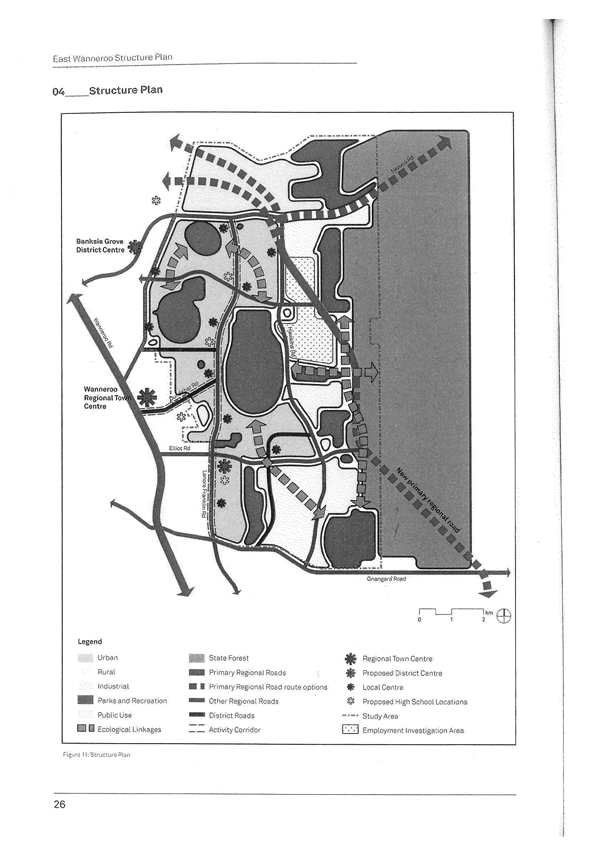
CITY OF WANNEROO Agenda OF Ordinary Council Meeting 05
April, 2011 122

CITY OF WANNEROO Agenda OF Ordinary Council Meeting 05
April, 2011 123

CITY OF WANNEROO Agenda OF Ordinary Council Meeting 05
April, 2011 124
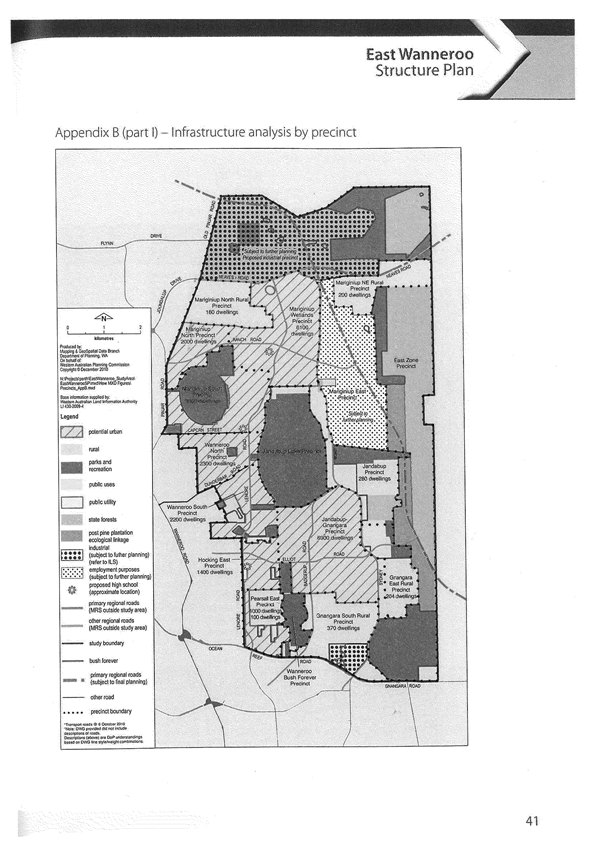
CITY OF WANNEROO Agenda OF Ordinary Council Meeting 05
April, 2011 125
DIFFERENCES BETWEEN
THE DRAFT EWSP AND THE FINAL EWSP
|
Draft EWSP
|
Final EWSP
|
|
1. Detail
of Maps
|
|
Included a detailed map showing the EWSP proposals on the
cadastral base (showing individual properties). (see Attachment 2)
|
Does not include a cadastral-based map. The final
EWSP map (Attachment 3) could be seen to be somewhere between the maps
shown in Attachments 1 and 2 in the terms of level of detail.
|
|
2. Main Structure Plan Maps
|
|
a) Legend
refers to ‘urban’ land.
|
Legend refers to ‘potential urban’ land
|
|
b) Area
on the south east corner of Neaves Road and Greenvale Place, Mariginiup (the
existing Lake Adams and Pennygum Special Rural Estates – marked as
“A” on Attachment 6) shown as Urban, and the Lake Adams
wetland area as Parks and Recreation.
|
This area shown as rural
|
|
c) The
existing Special Rural Subdivision generally situated between Lenore Road and
Badgerup Lake, Wanneroo (marked as “B” on Attachment 6)
shown as Urban.
|
This area shown as Rural, except for a narrow strip of
land along Lenore Road which is shown as Potential Urban
|
|
d) The
area situated south of the proposed eastern extension of Elliot Road and
between the Nanovich Park reserve and Sydney Road (marked as “C”
on Attachment 6) shown as rural.
|
This area shown as Potential Urban.
|
|
e) Overall
extent of urban land has an estimated dwelling potential of 24,000.
|
Overall extent of Potential urban land has an estimated
dwelling potential of 24,900.
|
|
f) Area
south of Neaves Road marked as “D” on Attachment 6 shown
as Rural.
|
This area shown as a northern extension of the
‘Employment Purposes’ area.
|
|
g) Area
north of Ocean Reef Road marked as “E” on Attachment 6
shown as Rural.
|
This area shown as a possible extension of the Wangara
industrial area. (The draft Industrial Land Strategy 2009 (Perth and
Peel) also proposed this extension).
|
|
h) The
pocket of current State Forest land situated generally between Pine Crest Way
and Paini Way, Jandabup (marked as “F” on Attachment 6)
shown as Parks and Recreation.
|
This area shown as State Forests.
|
|
i) Badgerup
Road shown as a “District Road”.
|
This road shown as an “Other Regional Road”,
and with a different alignment between the Elliot Road extension and Sydney
Road extension (see “G” on Attachment 6).
|
|
j) Elliot
Road shown as an “Other Regional Road” between Wanneroo Road and
Lenore Road.
|
This road shown commencing as an “Other Regional Road”
from roughly midway between Wanneroo Road and Lenore Road (see
“H” on Attachment 6).
|
|
k) Sydney
Road extension proposed with a straight alignment to the south-east of Lake
Jandabup (see Attachment 2).
|
A different alignment proposed for this road extension
(see “I” on Attachment 6).
|
|
l) An
alignment proposed for the northern extension of Lenore Road, to Neaves Road.
|
A different alignment proposed for this road extension at
points marked as “J” Attachment 6.
|
|
m) An
alignment proposed for a “Ranch Road” east-west Other Regional
Road, to the north of Lake Mariginiup.
|
A different alignment proposed for this road link at the
point marked “K” on Attachment 6.
|
|
n) The
proposed new north-south primary road shown linking into either Old Yanchep
Road or Flynn Drive.
|
This road shown linking into Old Yanchep Road (see
“L” on Attachment 6).
|
|
o) The
treatment of intersection of Neaves Road and the proposed north-south primary
road shown as still to be determined.
|
A treatment shown for this intersection, including a
northern realignment of Neaves Road (see “M” on Attachment 6).
|
|
p) A
Proposed District Centre and ten proposed Local Centres shown.
|
These centres not shown. (The final EWSP instead
says that this will be determined in subsequent stages of structure
planning).
|
|
q) Showed
“Ecological linkages” (see Attachment 1) and ‘priority
local natural areas’ (see Attachment 2).
|
These are not shown on the final EWSP map (Attachment 3),
however the EWSP report does include a separate map (Figure 10) which does
show these, and proposes that provision of these be addressed in subsequent
stages of structure planning.
|
|
3. Proposals for Implementation
|
|
a) Proposed
that land initially be rezoned to Urban Deferred under the Metropolitan
Region Scheme (MRS).
|
While initially referring to rezoning to either Urban or
Urban Deferred under the MRS, then only describes requirements for rezoning
to Urban (not Urban Deferred).
|
|
b) Detailed
the further studies required prior to MRS rezoning to Urban Deferred.
|
Refers to the following requirements for rezoning to Urban
under the MRS:
· Eight criteria
to be addressed;
· A number of
studies and strategies to be prepared;
· Federal
environmental approvals to be obtained;
· A District
Structure Plan (DSP) likely to be required (with the matters which a DSP
would be required to address then being listed).
|
|
c) Did
not require District Structure Planning.
|
Requires District Structure Planning.
|
|
d) Proposed
a significant role by State and Federal agencies in the undertaking of the
further studies required for rezoning to Urban Deferred under the MRS.
|
Places the onus largely on the proponent and the City for
the undertaking of the various tasks required for rezoning to Urban under the
MRS.
|
CITY OF WANNEROO Agenda OF Ordinary Council Meeting 05
April, 2011 129
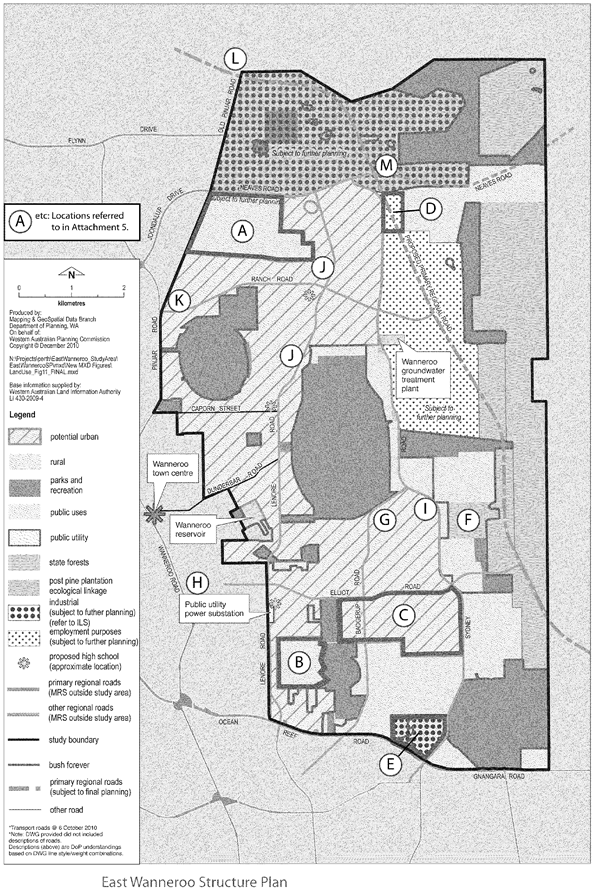
CITY OF WANNEROO Agenda OF Ordinary Council Meeting 05
April, 2011 130
KEY CITY SUBMISSION COMMENTS AND RESPONSES
|
Submission
comment
|
Response
|
|
1. A
much longer term planning horizon (well beyond 2031) should be used.
(Similar comment was made in Council’s submissions on draft Directions
2031 and the draft Gnangara Sustainability Strategy).
|
A planning horizon of 2031 is still used, consistent with
Directions 2031 and Beyond. (Given that Directions 2031 and Beyond still is
mainly based on a 2031 planning horizon, this response is to be expected).
|
|
2. East
Wanneroo should not be regarded as the long term urban ‘edge’ to
this part of the metropolitan area.
|
The final EWSP still regards East Wanneroo as the long
term urban ‘edge’.
|
|
3. Regarding
protection of Carnaby’s Black cockatoo habitat, an option was suggested
of expanding urbanisation into the State Forest areas, where the pine
plantations are being harvested. The funds generated for the government
by this could be used to purchase land containing Carnaby’s habitat in
the East Wanneroo area.
|
This option has not been addressed
|
|
4. Inadequate
guidance is provided as to what form the proposed ecological linkages should
take and how they should be implemented.
|
Little guidance is still provided on these
matters.
|
|
5. Water
management strategies need to properly address acid sulfate soils (ASS) and
related issues.
|
While a District Water Management Strategy is
included as a prerequisite to initiation of an MRS Amendment, it appears that
further assessment of ASS issues is intended to be only addressed at local
structure plan stage.
|
|
6. MRS
amendment to rezone to Urban Deferred should not be initiated until all
studies have been completed which are required to confirm suitability of the
land for urban development.
|
While the draft EWSP proposed initially
rezoning to Urban Deferred, and indicated what studies were required to
enable that, the final EWSP is unclear on this, at one point referring to
rezoning to either Urban Deferred or Urban, but then going on to indicate
prerequisites to only Urban rezoning (not Urban Deferred). Even for
Urban rezoning, the studies required by the final EWSP are considered deficient.
|
|
7. If
a District Structure Plan (DSP) level of planning is not intended (which was
what the draft EWSP was proposing), then the EWSP needs to provide the
equivalent level of detail as a DSP to provide effective guidance for local
structure planning. A number of matters needed to be addressed by the
EWSP to provide this level of detail.
In
general, the implementation process as a whole needs to be more carefully
considered, and a detailed program prepared which clearly sets out what is
required to be done, by who, and by when.
|
The final EWSP has taken a different approach by now
proposing a DSP level of planning. However, while it purports to
provide clear guidance as to what now needs to be done to lead to
urbanisation, this is not the case, and is considered in further detail in
this report.
|
|
8. Dundebar
Road should be shown as an Other Regional Road.
|
This is still shown as a District Road.
|
|
9. Detailed
planning by the City such as more detailed structure planning and preparation
of development contribution arrangements should not be required to be
prepared until rezoning under the MRS has been completed. Otherwise,
significant time and resources could be wasted if the rezoning is not able to
be successfully completed.
|
The final EWSP is proposing that District Structure
Planning and development contribution planning be done as a prerequisite to
MRS rezoning:
|
CITY OF WANNEROO Agenda OF Ordinary Council Meeting 05
April, 2011 132
STUDIES LIKELY TO BE REQUIRED TO
ENABLE REZONING TO URBAN DEFERRED UNDER THE METROPOLITAN REGION SCHEME
1. Traffic
modelling of the proposed major road network, based on the proposed final EWSP
(regarding land use, population, employment etc inputs). This is not
mentioned in the final EWSP as further work required, however as far as this
office is aware, it is still required to be done.
2. More
detailed planning of public transport. (This may have implications for
land requirements for the proposed regional roads to be reserved).
3. Preparation
of detailed land requirement plans for the major roads to be reserved under the
MRS amendment. (While DoP has commenced work on this, it is unclear
whether it has been satisfactorily completed).
4. Whatever
studies may be required to obtain Federal environmental approvals relating to
federally listed endangered species. (The suitability of land for urban
development cannot be confirmed until this matter has been finally resolved).
5. Determination
of sites required for major infrastructure e.g. power sub-stations; any major
sewer or water pumping stations. Such sites should be reserved in the MRS
Amendment, and therefore require detailed site delineation to enable this.
(While high school sites will generally eventually also be reserved under the
MRS, this does not need to occur at this MRS amendment stage).
6. Assessment
of implementation of proposed district open spaces. Administration has
determined that two district open space areas will be required, each of
possibly around 10 hectares. Sites of this size are difficult to provide
as part of the 10% public open space (POS) provision (due to other competing
demands on the 10% ‘budget’) and therefore an alternative
implementation mechanism is required. The main alternatives are using
existing reserves (which are not ‘10%’ reserves), via development
contribution arrangement, or reserving as Parks and Recreation under the MRS.
If the last alternative is required to be used, then this needs to be provided
for in the MRS Amendment.
7. Preparation
of a District Water Management Strategy.
8. Assessment
of implementation of proposals relating to Bush Forever Sites, Priority Local
Natural Areas and ecological linkages. If the assessment finds that
implementation will need to include reservation for Parks and Recreation under
the MRS, then such areas will need to be included a such in the MRS amendment.
9. Determination
of wetland management categories and wetland buffers, and assessment of how
areas requiring protection will be implemented. If the outcome of the
assessment is that any areas need to be reserved for Parks and Recreation under
the MRS, then they will need to be included as such under the MRS Amendment.
10. Assessment
of implementation of protection of ethnological and cultural heritage
sites. If the assessment finds that implementation will need to include
reservation for Parks and Recreation under the MRS, then such areas will need
to be included as such in the MRS Amendment.
11. Further
assessment of acid sulfate soils (ASS). The final EWSP states (page 18): “In
accordance with the WAPC’s Acid Sulfate Soils Planning Guidelines,
further detailed assessment to determine the occurrence of acid sulfate soils,
and identification of an appropriate response, will be required as part of
future local structure planning”. As far as the City is aware,
this matter has still not been satisfactorily resolved to a point that it can
be said that all areas within the potential urban area which are affected by
ASS are suitable for urban development; that the issue can be viably managed;
and therefore this should not prevent Urban Deferred zoning.
12. Assessment
of interface between the Potential Urban area at Mariginiup and the possible
South Pinjar Industrial Area.
CITY OF WANNEROO Agenda OF Ordinary Council Meeting 05
April, 2011 134
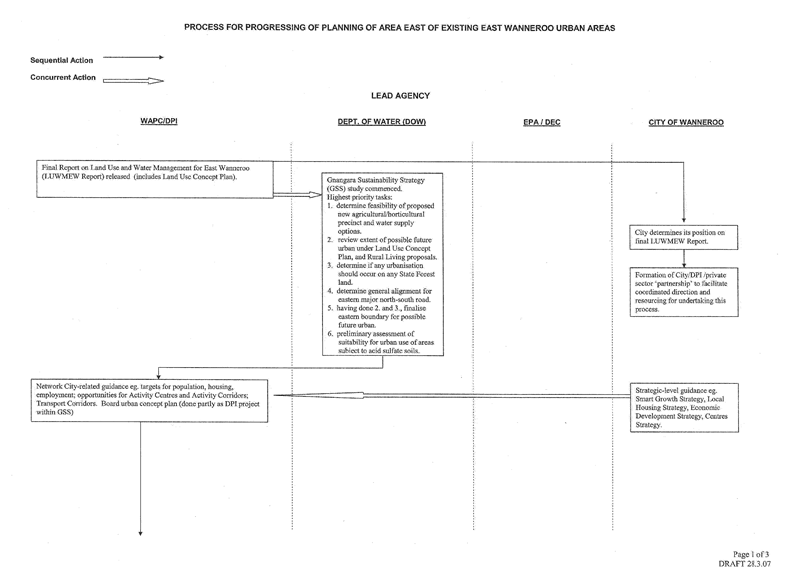

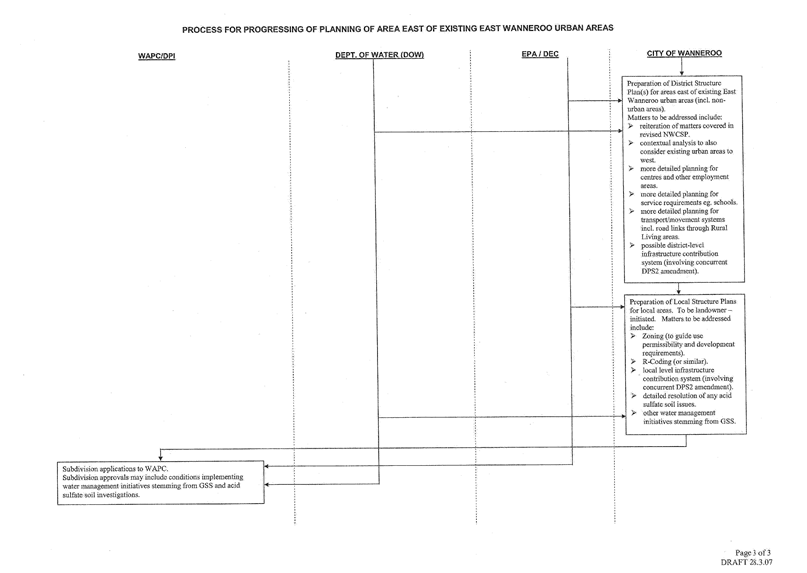
City Businesses
Regulatory Services
CB01-04/11 Application
to Keep More Than Two Dogs
File
Ref: 2323
– 11/21440
Responsible
Officer: Director, City Businesses
Disclosure of Interest: Nil
Attachments: Nil
Issue
To consider five applications for an exemption under section
26(3) of the Dog Act 1976 to keep more than two dogs.
Background
Clause 14 of the City of Wanneroo Animals Local Law 1999
(Amendment 2008 GG 508) stipulates:
“A person shall not keep
or permit to be kept on any premises more than:
a) 2
dogs over the age of 3 months and the young of those dogs under that age; or
b) 6
dogs over the age of 3 months and the young of those dogs under that age if the
premises are situated on a lot having an area of 4 hectares or more,
unless the premises are
licensed as an approved kennel establishment or have been granted exemption
pursuant to section 26(3) of the Dog Act and have planning approval under the
town planning scheme.”
Detail
The following applications have been made under the Dog
Act 1976 and are submitted for consideration:
|
Address of
Applicants
|
Description of
Dogs
|
|
17 Cresswell Place, Quinns Rocks
|
1. Female
sterilised black Staffordshire Terrier
2. Female
sterilised black and tan Shepherd cross
3. Male
unsterilised black Shepherd cross
|
|
12 Wonambi Way, Wanneroo
|
1. Male
sterilised black and white Siberian Husky
2. Male
unsterilised black and white Siberian Husky
3. Male
unsterilised black and white Siberian Husky
|
|
54 Monaltrie Loop, Carramar
|
1. Female
unsterlised grey and white Maltese cross
2. Male
sterilised grey and white Maltese cross
3. Female
sterilised grey and white Maltese cross
|
|
20 Maree Place, Gnangara
|
1. Female
sterlised white Jack Russell
2. Male
sterilised black Labradoodle
3. Female
sterilised tan Kelpie X
|
|
76 Evandale Road, Darch
|
1. Female
sterlised black and tan Rottweiler
2. Female
unsterilised black and tan Rottweiler
3. Female
unsterilised black and tan Rottweiler
4. Female
unsterilised black and tan Rottweiler
|
Rangers have inspected the aforementioned properties to
ensure means exist on the premises at which the dogs will ordinarily be kept
for effectively confining the dogs within the premises.
|
Address of Applicants
|
Origin of Application
|
|
17 Cresswell Place, Quinns Rocks
|
Owner generated application to comply with local laws.
|
|
12 Wonambi Way, Wanneroo
|
Owner generated application to comply with local laws.
|
|
54 Monaltrie Loop, Carramar
|
Owner generated application to comply with local laws.
|
|
20 Maree Place, Gnangara
|
Application generated following complaint from neighbour.
|
|
76 Evandale Road, Darch
|
Application generated following complaint from neighbour.
|
|
Address of Applicants
|
Property Zonings
|
Size of Properties
|
|
17 Cresswell Place, Quinns Rocks
|
Residential
|
0.0722 hectares
|
|
12 Wonambi Way, Wanneroo
|
Residential
|
0.0684 hectares
|
|
54 Monaltrie Loop, Carramar
|
Residential
|
0.0740 hectares
|
|
20 Maree Place, Gnangara
|
Special Rural 02
|
1.0896 hectares
|
|
76 Evandale Road, Darch
|
Residential
|
2.1726 hectares
|
Consultation
Where applications have been received by the City to keep
more than two dogs, residents immediately adjoining the applicant’s
property in question are consulted by letter to ascertain if they have any
objections.
On this occasion the following objection have been received:
|
Address of
Applicant
|
Number of
Objection Forms Received
|
|
17 Cresswell Place, Quinns Rocks
|
Nil
|
|
12 Wonambi Way, Wanneroo
|
Nil
|
|
54 Monaltrie Loop, Carramar
|
Nil
|
|
20 Maree Place, Gnangara
|
One
|
|
76 Evandale Road, Darch
|
Nil
|
Comment
In considering these applications for exemption, the
following two options are available:
a) Council
may grant an exemption pursuant to Section 26(3) of the Dog Act 1976 subject
to conditions; or
b) Council
may refuse permission to keep more than two dogs.
Application One: 17 Cresswell Place, Quinns Rocks
The applicant is seeking permission from the City to keep
three dogs at 17 Cresswell Place, Quinns Rocks.
The third dog was given to the applicant by the original dog
owner who could no longer care for it. A check of the City’s records
reveals that prior to this application being made, no previous complaints have
been lodged with Regulatory Services. Upon consultation with neighbouring
properties no objections were received.
A Ranger has inspected the property and confirmed it is
adequate for the confinement and exercise of the dogs. The rear, side and
front fences are 1.8 metres in height and are as such in compliance with the Dog
Act 1976. The dogs are kept in a medium sized yard and sleep in the
house at night. It is recommended that an exemption under section 26(3)
of the Dog Act 1976 be granted.
Application Two: 12 Wonambi Way, Wanneroo
The applicant is seeking permission from the City to keep
three dogs at 12 Wonambi Way, Wanneroo. A check of the City’s records
reveals that prior to this application being made, no previous complaints have
been lodged with Regulatory Services. Upon consultation with neighbouring
properties no objections were received.
A Ranger has inspected the property and confirmed it is
adequate for the confinement and exercise of the dogs. The rear, side and
front fences are 1.8 metres in height and are as such in compliance with the Dog
Act 1976. The dogs are kept in a large yard and sleep in the house at
night. It is recommended that an exemption under section 26(3) of the Dog
Act 1976 be granted.
Application Three: 54 Monaltrie Loop, Carramar
The applicant is seeking permission from the City to keep
three dogs at 54 Monaltrie Loop, Carramar. The applicant cares for the
third dog one week in every two for her son that works in the mining industry.
A check of the City’s records reveals that prior to this application being
made, no previous complaints have been lodged with Regulatory Services.
Upon consultation with neighbouring properties no objections were received.
A Ranger has inspected the property and confirmed it is
adequate for the confinement and exercise of the dogs. The rear, side and
front fences are 1.8 metres in height and are as such in compliance with the Dog
Act 1976. The dogs are kept in a large yard and sleep in a shed at
night. It is recommended that an exemption under section 26(3) of the Dog
Act 1976 be granted.
Application Four: 20 Maree Place, Gnangara
The applicant is seeking permission from the City to keep
three dogs at 20 Maree Place, Gnangara. The applicant was previously successful
in gaining approval to keep more than two dogs on the property, however the dog
under the previous approval has now passed away and applicant would like to
replace with a new puppy. There are no previous complaints recorded with regard
to the keeping of dogs on the applicant’s property, however the
application for an additional dog was received only after the neighbour
complained to the City that there was a third dog on the applicant’s
property.
A Ranger has inspected the property and confirmed it is
adequate for the confinement and exercise of the dogs. All fences are 1.2
metres in height with a gate of 1.2 metres in height in compliance with the Dog
Act 1976 for Special Rural 02 properties. The dogs are kept in a
large yard and sleep in the house at night. The objection to the third dog was
based on that the dogs were barking every time the neighbour went out into her
own back yard. Due to the one lodged objection in this instance relating to
excessive noise, it is not recommended that an exemption under section 26(3) of
the Dog Act 1976 be granted.
Application Five: 76 Evandale Road, Darch
The applicant is seeking permission from the City to keep
four dogs at 76 Evandale Road, Darch. The two new puppies are to replace,
eventually, the older two guard dogs which have various age related health
conditions. A check of the City’s records reveals that prior to this
application being made, a complaint was lodged in regards to the numbers of
dogs on the property to Ranger Services. Upon consultation with
neighbouring properties no objections were received.
A Ranger has inspected the property and confirmed it is
adequate for the confinement and exercise of the dogs. The rear, side and
front fences are 2 metres in height and are as such in compliance with the Dog
Act 1976. The dogs are kept in a large yard and sleep in a shed at
night. It is recommended that an exemption under section 26(3) of the Dog
Act 1976 be granted.
Statutory
Compliance
The exemptions sought to Council’s Animals Local Law
1999 are permissible under Section 26(3) of the Dog Act 1976.
Strategic
Implications
The proposal accords with the following Outcome Objective of
the City’s Strategic Plan 2006 – 2021:
“2 Social
2.4 Improve
community safety”
2.4.3
Develop and implement a range of activities that promote community
inclusiveness, safety and well being.
Policy
Implications
Nil
Financial
Implications
Nil
Voting
Requirements
Simple Majority
Recommendation
That Council:-
1. GRANTS
an exemption under the City of Wanneroo Animal Local Laws 1999 made under
Section 26(3) of the Dog Act 1976 to keep three dogs at the following
properties;
§
17 Cresswell Place, Quinns Rocks
§
12 Wonambi Way, Wanneroo
§
54 Monaltrie Loop, Carramar
§
76 Evandale Road, Darch
2. ADVISES
that the exemption is subject to the following specified conditions:
a) If
any one of the dogs die or is no longer kept on the property, no replacement is
to be obtained;
b)
Any barking by the subject dogs is to be kept to a minimum; and
c)
This exemption may be varied or revoked if any complaints
are received which are considered reasonable;
3. ADVISES
the applicant and adjoining neighbours of this decision in relation to the
properties;
4. REFUSES
an exemption to the City of Wanneroo Animal Local Law 1999 made under Section
26(3) of the Dog Act 1976 for the applicants at the property at 20 Maree Place,
Gnangara;
5. ADVISES
the applicant that they may appeal Council’s decision by writing to the
Hon Minister for Local Government; Heritage; Citizenship and Multicultural
Interests within 28 days of receiving notice of Council’s decision; and
6. ADVISES
the adjoining neighbours of this decision in relation to the property at 20
Maree Place, Gnagara.
CB02-04/11 Service
Level Agreement Between the City of Wanneroo and FESA for the Provision of a
Community Emergency Services Manager (CESM)
File Ref: 3916
– 11/23612
Responsible
Officer: Director City Businesses
Disclosure
of Interest: Nil
Attachments: 2
Issue
To consider a request from the Fire and Emergency Services
Authority of Western Australia (FESA) to sign a new Service Level Agreement
(SLA) for the Provision of a Community Emergency Services Manager.
Background
In July 2002 the City of Wanneroo and FESA signed a
Management Agreement (also referred to as a Service Level Agreement)
incorporating a number of initiatives to be achieved during a two year period.
It included agreed funding mechanisms to ensure improved service delivery
outcomes.
In April 2004, following the expiry of the original
agreement, FESA wrote to the City with a request to renew the partnership under
cover of a new Service Level Agreement. When Council considered this request in
August 2004 it was suggested that the City and FESA enjoyed a cooperative
partnership at the operational level, and that it was that level of commitment
that precluded the necessity to enter into a new SLA. This was reinforced by
the financial security offered by the introduction of the Emergency Services
Levy (ESL) and the established protocols and standards understood by both
organisations. Accordingly, Council resolved not to enter into a further formal
agreement.
Detail
FESA has recently reviewed the role of the Community Fire
Manager (CFM) within local government and have developed a new Job Description
and position title for a Community Emergency Services Manager (CESM). The
position incorporates the role of Chief Bush Fire Control Officer (CBFCO) and
is a shared cost between the City and FESA on a 50/50 basis. In conjunction
with the review of the position FESA have developed an updated SLA (Attachment
1) and Business Plan (Attachment 2) for the CESM position and are
requesting that the City become a signatory to the agreement.
An outcome of the Business Plan is to develop practices for
fire management on local government bushland in the City. One of the strategies
requires the CESM to engage with FESA’s Bush Fire & Local Government
Relations Branch to conduct Hazard Reduction Burn programs in accordance with
the allocated budget. A recommendation of this report will be to list $20,000
in future budgets to achieve this.
Consultation
No external consultation has been undertaken in the
preparation of this report however, Council will be aware of heightened
community interest in the role that local government plays in emergency
management in light of the recent flooding and bushfire events across Australia.
Whilst the City continues to enjoy a very good relationship
with FESA, the Administration believes that entering into a formal partnership
will demonstrate Council’s ongoing commitment to emergency management and
enhance our reputation in the community.
Comment
The role of the CESM has been expanded from that previously
assigned to the CFM. As well as being responsible for fire management within
the City the CESM will also be responsible for the management of all local
emergencies, and hazard reduction. The SLA and action plan have been developed
with this in mind. In summary the role of the CESM includes:
1. To
ensure the implementation and delivery of fire preparedness, prevention,
response and recovery services within the City.
2. To
provide leadership and expert technical and professional advice to volunteer
bush fire brigades and emergency volunteer groups.
3. To
support, coordinate and deliver quality training for volunteer bush fire
fighters.
4. In
partnership with the City and community groups, to continuously seek to improve
the mitigation of risk to the community from bush fires and other hazards.
5. To
consult widely in the development, implementation and maintenance of fire
management planning within the City of Wanneroo.
6. To
manage the physical and financial resources of the City’s volunteer bush
fire brigades.
7. To
undertake the role of Chief Bush Fire Control Officer both operationally and
administratively.
Currently there are five registered volunteer bush fire
brigades within the City of Wanneroo. Three of these operate from the Ashby
Operations Centre, one from Quinns Rocks and the other from Two Rocks. Advice
from FESA is that these are likely to be viable for another 10 to 25 years.
This highlights the important role the CESM/CBFCO plays in managing and
administering these volunteer organisations and the need to formalise
arrangements between FESA and the City. It is also important to note that the
City of Wanneroo is considered a leader in fire management, and that the
Wanneroo Volunteer Bush Fire (VBF) Brigades would probably be retained as a
regional resource due to its strong volunteer base.
The SLA will take effect from the date of the last signatory
and will remain in force for a three year period. There is an option for a further
three year period subject to the agreement of both parties. The SLA includes a
termination clause that allows for the termination of the agreement by the
mutual agreement of both parties in writing, or either party by giving three
months notice to the other party in writing.
FESA is currently reviewing the Fire Brigades Act 1942,
Bushfires Act 1954, and the Fire and Emergency Services Authority of
Western Australia Act 1998 with a view to amalgamating them into a single
Emergency Services Act. It is too early at this stage to forecast any changes
that may affect local government as a result of the review however, the process
is likely to take three years and fits in well with the proposed three year
duration of the SLA.
The Administration has discussed with the FESA North Coastal
District Manager the potential for expansion to the ESL boundary that would
result in FESA assuming a greater responsibility for fire management within the
City. We have been advised that expansion is dependent on population growth and
the establishment of new career fire stations within the City. There are no
plans to extend the boundary in 2011/12 however, it may expand in 2012/13 due
to rapid growth in the northern corridor. FESA review boundaries every 12
months in conjunction with affected local governments.
Currently the position of CFM within the City is filled
through a temporary contract arrangement. The initial term of the contract was
three months however, this has recently been extended by another three months.
Commencement of the recruitment process for the vacant CESM (previously CFM) is
on hold pending Council’s consideration of this report and signing of the
SLA. There is some urgency to this as the state government recruitment process
can be timely and is likely to require a further extension of the contract
arrangements that are currently in place.
Statutory
Compliance
The SLA itself does not constitute or create, and shall not
be deemed to constitute, any legally binding or enforceable obligations on the
part of either party. However, the City and FESA has obligations under the
following legislation in relation to the provision of fire management services,
and the appointment of officers in relation to the provision of those services:
· Local
Government Act 1995
· Fire Brigades
Act 1942
· Bush Fires Act
1954
· FESA WA Act
1998
Strategic
Implications
The proposal accords with the following Outcome Objective of
the City’s Strategic Plan 2006 – 2021:
“2 Social
2.4 Improve
community safety”
“4
Governance
4.1 Improve strategic partnerships”
Policy
Implications
Nil.
Financial
Implications
The SLA is a standard document and is in use across 26 local
governments. FESA anticipate this number will rise to 52 local governments by
the end of next year. The ratio for cost sharing of this service is based on
rates income with all larger local governments contributing the maximum 50%.
The cost of providing the CESM position at the City of
Wanneroo is shared on a 50/50 basis, however FESA meet all costs associated
with sanctioned overtime and on-call arrangements. Currently, the estimated
annual cost to the City for the provision of the CESM position is $76,250. If
Council were to opt out of the arrangement with FESA all costs would need to be
met by the City.
Voting
Requirements
Simple Majority
Recommendation
That Council:-
1. AUTHORISES
the Mayor and the Chief Executive Officer to sign the Service Level Agreement
between the Fire and Emergency Services of Western Australia for the Provision
of a Community Emergency Services Manager;
2. NOTES
that the Service Level Agreement will remain in force for three years from the
date of signing, with an option for a further three year period subject to the
agreement of both parties;
3. NOTES
that one of the roles of the Community Emergency Services Manager is to
undertake the role and responsibility of the City of Wanneroo’s Chief
Bush Fire Control Officer, and assumes a leadership role in all local
emergencies within the City of Wanneroo; and
4. NOTES
that an amount of $20,000 will be listed in the future operating budgets, for
the consideration of Council, to support FESA in carrying out Hazard Reduction
Burns within the City’s bushland on an annual basis.
CITY OF WANNEROO Agenda
OF Ordinary Council Meeting 05 April, 2011 146

SERVICE LEVEL AGREEMENT
between the
FIRE AND EMERGENCY SERVICES AUTHORITY
OF WESTERN AUSTRALIA
AND
CITY OF WANNEROO
FOR
THE PROVISION OF A
COMMUNITY EMERGENCY SERVICES MANAGER
1. PURPOSE
This Service Level
Agreement (SLA) is intended to identify and document the respective
roles and responsibilities of the CITY OF WANNEROO, (The City) the Fire
and Emergency Services Authority of Western Australia, (FESA) and the
Community Emergency Services Manager (CESM) as considered necessary to
manage the City’s Fire and Emergency services.
This SLA
recognizes the responsibilities and undertakings of the agencies within this
agreement, for Fire and Emergency Services delivery to the City community in
accordance with FESA’s best practices.
This SLA does not
constitute or create, and shall not be deemed to constitute, any legally
binding or enforceable obligations on the part of any party.
2. FESA
This SLA will support
FESA’s mission, vision and values:
Mission: in
partnership with the people of Western Australia to:
· Improve community safety practices; and
· Provide timely, quality and effective emergency
services.
Vision: A safer community.
Values: Put
the community first;
Work
together as a committed team;
Respect
and value each other;
Continuously
improve our service;
Act
with integrity and honesty;
Have
open and honest two-way communications;
Strive
to keep ourselves and others safe
3. CITY
OF WANNEROO
Vision: The centre for creative and sustainable growth,
delivering strong, vibrant and connected communities.
Mission: Through strategic partnerships and effective
leadership, we will provide spaces, places that:
· Build on natural resources and cultural heritage
· Create distinct and vibrant village communities
· Enhance lifestyle choices
· Foster economic prosperity
· Encourage citizen and stakeholder participation in
governance development decisions.
4. DEFINITION
Emergency Management: means the provision of Prevention, Preparedness, Response and
Recovery functions in order to provide a comprehensive approach to emergency
management within the City.
5. SLA
OBJECTIVES
5.1 To establish
specific responsibilities with respect to the delivery of fire services within
the City in particular to:
§ Deliver coordinated prevention programs to reduce the
incidence of emergencies and improve the level of safety in the community;
§ Operate to a consistent set of protocols and equipment
standards;
§ Provide efficient systems of communication between
organizations at all levels to improve service delivery outcomes;
§ Promote and support volunteer organisational
arrangements that combine the spirit of volunteerism to attract and retain
members;
§ Provide and or coordinate the level of training to
personnel, to ensure the competencies are appropriate to the risk level of
emergencies to which volunteers will be required to respond;
§ Develop a partnership that will see a best practice
approach to emergency management delivery between the City and FESA; and
§ Enhance community ownership of fire prevention and
preparedness programs and activities.
5.2 To establish
an agreement between the City and FESA, under Part 3 Section 12(2)(E) and (f)
of the Fire and Emergency Services Authority of Western Australia Act 1998,
to ensure the City’s Volunteer Bush Fire Brigades are supported, trained,
equipped and capable of providing appropriate fire services to the community.
6. ACKNOWLEDGMENTS AND UNDERTAKINGS BY FESA
6.1 FESA
will deliver the following services:
· Prevention: The development and implementation of community
safety programs and services, to City staff and emergency service volunteers as
required and mutually agreed. Programs and services include (but are not
limited to) Bush Fire Ready, Home Fire Safety, Schools Education program and
Smoke Alarm program.
· Preparedness: In addition to the programs described for prevention
the training of volunteers will be managed, in partnership with the volunteer
training network, aware of the increased risks faced by the emergency services
and resourcing profile required. Access to specific courses that align with
increased roles will be provided.
· Response; FESA will assist with the day to day incidents via
the Communications Centre. Management and leadership will be provided by FESA
at fire incidents, when requested by the City and agreed to by FESA.
· Recovery: FESA will provide strategic assistance and advice to
The City concerning the development and implementation of recovery management
plans and recovery management.
· Management and Administration: FESA will provide day to day and
strategic management services, including vehicle and equipment standards,
guidance on Emergency Services Levy (ESL) budgeting, standards of operation,
brigade training maintenance, community liaison and administrative returns such
as incident reports and activity statements.
· Community Emergency Services Manager: FESA will meet 50% of the costs incurred
for the employment of a CESM within the City. Activities undertaken by this position
will be listed as part of an annual business plan which will be approved of by
both FESA and the City. The plan will be reviewed each year.
6.2 FESA
will provide strategic advice and access to programs and/or services in order
to support services delivered by the City.
7. ACKNOWLEDGMENTS AND
UNDERTAKINGS BY THE CITY OF WANNEROO
7.1 The
City will deliver the following services:
· Prevention:
Administer and enforce the fire prevention provisions Bush Fires Act 1954
and also promote and participate in appropriate community safety programs
in consultation with FESA;
· Preparedness:
In addition to the applicable community safety programs identified against
prevention, the City will through its staff and infrastructure support the
emergency services preparedness programs developed and implemented by FESA;
· Response:
The City will respond to day to day incidents through the turnout of their Bush
Fire Brigades. City support will be extended to FESA controlled incidents when
requested by the Incident Controller
· Management and Administration: The City will provide leadership and support to the
development and management of its community Emergency Risk Management
Arrangements in relation to bush fire.
·
7.2 The City will input
into the development of the emergency services operating and capital budget, to
ensure sufficient funds are requested through the Emergency Services Levy
Funding process to maintain emergency services buildings, appliances and
associated operational infrastructure. The City will make provision within its
annual budget, those agreed funds, to meet 50% of the expenses associated with the CESM position.
7.3 The City will
maintain the existing emergency services buildings, appliances and operational
infrastructure and provide access to FESA through normal mobilising
arrangements.
8. COMMUNITY
EMERGENCY SERVICES MANAGER ACKNOWLEDGMENTS
8.1 The CESM will
undertake the activities as listed in the agreed Business Plan. See attached
plan.
8.2 The CESM will
operate under the supervision of a designated FESA District Manager and The
City’s Manager Regulatory Services. Any disputes or inconsistencies
between the two parties will need to be settled as per the dispute resolution
procedure contained in this document, and will be settled as quickly as
practicable.
9. CONDITIONS OF
EMPLOYMENT
9.1 The CESM will
be employed by FESA under the United Fire Fighters Award. Special allowances
will be paid according to this award.
9.2 The hours of
duty will be 40 hours per week including after hours training and meetings as
required. These hours of duty do not include overtime and call-outs.
9.3 The CESM
uniform will be light blue with shoulder patches displaying FESA Fire and
Emergency Services and epaulettes showing local Government CESM.
9.4 Any
performance based issue or grievance will be jointly addressed by the City and
FESA.
9.5 The vehicle
used by the CESM will be by agreement between the City and FESA.
9.6 The CESM will be required to perform
operational bush fire duties when necessary and must be appointed upon
agreement with the City to the position of Chief Bush Fire Control Officer.
10. FINANCIAL
ARRANGEMENTS
10.1 FESA and the City will be
responsible for 50/50 sharing of all costs associated with the CESM position,
excepting those described in 10.3 below. Refer to attached document.
10.2 FESA will invoice the City
quarterly for the CESM position
10.3 Sanctioned wildfire overtime/on
call and availability allowance will be paid by FESA.
11. HUMAN
RESOURCE ARRANGEMENTS
11.1 The selection process for the
position of the CESM will be managed by a member from FESA, supported by the City
and an independent party, as agreed between FESA and The City.
11.2 The CESM will be required to
work to an agreed business plan which will be developed by FESA and the City
and reviewed yearly.
11.3 The
City and the FESA Regional Office will provide office facilities.
12. REPORTING
The
CESM will provide a written report to FESA and the City twice per year with
outcomes on performance indicators from the agreed business plan.
13. DURATION AND AMENDMENT
13.1 This SLA will take effect from
the date of the last signatory, (refer page 8), and will remain in force for a
three year period, with the option for a further three year period, subject to
the agreement of both parties.
13.2 This Agreement shall not be
altered varied or modified in any respect except by agreement in writing.
14. DISPUTE RESOLUTION
Dispute resolution with
regards to the content of this document is to be conferred, deliberated and
resolved by the FESA CEO or a nominated delegate and the CEO of The City or a
nominated delegate.
15. TERMINATION
This Agreement may be
terminated by:
(a) Mutual
agreement of both parties in writing at any time: or
(b) Either
party by giving three months notice in writing to the other party at any time.
16. NOTICES
Notices or other
communications by each party to each other and under this SLA must, unless
otherwise notified in writing, be addressed and forwarded as follows:
FESA
Chief Executive Officer
Fire
and Emergency Services Authority of Western Australia
FESA
House
PO Box P1174
PERTH Western Australia 6844
Chief Executive Officer
CITY OF WANNEROO
Locked Bag 1
WANNEROO WA 6065

SERVICE LEVEL AGREEMENT
This Service Level Agreement is made
BETWEEN THE
Fire and Emergency Services Authority of Western Australia
480 Hay Street
PERTH
WA 6000
AND
CITY OF WANNEROO
23 Dunbar Road
WANNEROO WA 6065
And will take effect from the date of the
last signature and remain in force for a 3 year period.
SIGNED for and on behalf of the Fire and Emergency Services Authority
of Western Australia by:
JO HARRISON-WARD ___________________________ ____________
CHIEF EXECUTIVE OFFICER Signature Date:
SIGNED for and on behalf of the CITY OF WANNEROO by:
DANIEL SIMMS ________________________ ____________
CHIEF EXECUTIVE OFFICER Signature Date
JON KELLY ________________________ ____________
Mayor Signature Date
INDICATIVE COST
SHARING
BETWEEN FESA AND
THE CITY OF WANNEROO
AS AT 5 JAN 2011 FOR A
CESM
|
PERSONNEL COST
|
SHARED
|
FESA
|
L.GOVT
|
|
Salary
|
93k
|
46.5k
|
46.5k
|
|
On Costs
|
27k
|
13.5k
|
13.5k
|
|
Sanctioned Overtime
|
n/a
|
As approved
|
n/a
|
|
On call
|
n/a
|
2,600
|
n/a
|
|
Availability Allowance
|
n/a
|
8,062
|
n/a
|
|
|
|
|
|
|
|
|
|
|
ITC COST
|
|
|
|
|
PC
|
1500
|
750
|
750
|
|
Mobile Phone
|
2400
|
1200
|
1200
|
|
|
|
|
|
|
|
|
|
|
VEHICLE COSTS
|
|
|
|
|
Lease
|
18000
|
9000
|
9000
|
|
Fuel/Servicing
|
5000
|
2500
|
2500
|
|
|
|
|
|
|
|
|
|
|
UNIFORM
|
|
|
|
|
Purchase/Maintenance
|
500
|
250
|
250
|
|
|
|
|
|
|
|
|
|
|
TRAINING
|
1200
|
600
|
600
|
|
|
|
|
|
|
Grand Total
|
148,600
|
84,762
|
76,250
|
|
|
|
|
Note:
1. FESA to pay for
sanctioned overtime and on call arrangements
2. All other costs
to be shared by 50:50 by FESA and City of Wanneroo
3. Costs are an
approximation only
4. City of Wanneroo
to provide office space
CITY OF WANNEROO Agenda OF Ordinary Council Meeting 05
April, 2011 155
BUSINESS PLAN 2010/13
An agreement between the City of Wanneroo and the Fire
and Emergency Services Authority of Western Australia. All parties agree that
the BP is a guide & outcomes may not be achieved in a twelve month period.
Business Plan Priorities:
1. Operational
Response in City of Wanneroo when appropriate
2. Management
of LG Bushlands
3. Management
of UCL/UMR
4. Training of Bush Fire Brigades
1. PREVENTION
To
provide a range of prevention services to increase community awareness of
hazards and their involvement in minimising impact.
|
OUTCOME
|
STRATEGY
|
WHO
|
DUE
|
PERFORMANCE
INDICATORS
|
|
Develop practices for fire management on local
government bush lands in City of Wanneroo(COW)
|
Assist LG to develop &
implement mitigation pre- plans for council vested reserves and private
property.
Conduct risk assessment plan
containing annual schedule of works, including fire hazard inspections of all
shire reserves, map & rate bush fire hazards, strategic firebreak
network.
Engage BFBs to assist with
Hazard Reduction Burns including alternative treatment options
Engage with FESA’s
Bush Fire & Local Government Relations Branch to conduct fuel reduction
programs in accordance with the allocated budget
|
CESM
COW
|
1 October
1 October
April to Nov
On going
|
Number of plans maintained and updated
No of hazard reduction burns/ other treatment
options. Number and size of hazard reduction burns conducted
CESM and Volunteer man hours spent on programs
Development of agreed program & implementation
of prescribed burns.
(See also Special projects)
|
|
Fire Hazard inspections
of private properties in City of Wanneroo
|
LG Fire Control Officers to conduct inspections to ensure compliance
with Council Fire Break Notice
|
CESM advice to COW
|
Annually
|
Number of Inspections, work orders, level of
Compliance
|
|
Administer Provisions of
Bush Fires Act & Emergency Management Act
|
· Ensure due observance with relevant Acts throughout
the district, including RBT, PBT
|
CESM advice to COW
|
Ongoing
|
LG community compliance with statutes and
regulations
|
|
OUTCOME
|
STRATEGY
|
WHO
|
DUE
|
PERFORMANCE INDICATORS
|
|
Develop practices for fire management on all
Unallocated Crown Land (UCL) & Unmanaged Reserves (UMR)within COW
|
Develop & implement
mitigation plans for all UCL/UMR blocks
Maintain UCL data base
Engage BFB in hazard
reduction burning programs & other treatment options
Engage with FESA’s
Bush Fire & Local Government Relations Branch to conduct fuel reduction
programs in accordance with the allocated budget
|
CESM & UCL Co-ord. in
ESL 3, FRS DM & UCL Co-ord in ESL1 areas
|
Ongoing
|
Number of Plans in place
No of Hazard Reduction burns/
other treatment options
Volunteer & CESM man hours spent on programs
Development of agreed program & implementation
of prescribed burns.
(See also Special projects)
|
|
Provide strategic advice
on Sub-divisional planning
Provide building
standards advise for fire protection as per BFTA
|
Review and provide advice to developers, city and consultants when
required
Advice to developers, LG & consultants in
regards to new buildings to comply with Building Code AS 3959
|
CESM advice to COW Planners & Builders
FESA DM
|
Ongoing
|
The number of subdivisions where advice is accepted
|
|
Education programs for
the community and schools to build knowledge & understanding of fire
prevention and preparedness management practices
|
· Review & identify suitable programs for the
community eg Prepare, Act Survive/ Bush Fire Ready/ JAFFA, Arson, & Smoke
Alarm program
·
· Coordinate the provision of public information
& develop media contacts
·
Coordinate the implementation of the FESA school
education program including the use of volunteers for delivery of programs
|
CESM to Coordinate and
assist the COW, BFBs & JAFFA Team, Community Engagement, and BRAG
coordinator
|
Ongoing
|
Number of education programs delivered to the
community, including effectiveness of these programs
Training program delivered to LG & BFB
Volunteers on basic fire investigation and preserving origin of suspicious
fires
Notices and articles in media outlets
No of schools visited
|
|
|
·
|
|
|
|
PREPAREDNESS
To provide and maintain
appropriate and adequate infrastructure, equipment, skilled personnel, plans
and programs in preparation for emergencies. To provide support to the
community in its preparation for emergencies and mitigation of risks.
OUTCOME
|
STRATEGY
|
WHO
|
DUE
|
PERFORMANCE INDICATORS
|
|
Establish a Local Govt.
training calendar for BFBs to meet the operational requirements of brigade
profile and members
Level 2 incident
training for BFBs
|
In
consultation with Brigade, develop a program of appropriate courses for Bush
Fire Brigade volunteers & Council staff, through a training needs
analysis.
Coordinate Volunteer
instructors and LG Staff to establish and maintain a local training data
base.
Ensure BFBs have the
appropriate level of training to meet Brigade Profile and be operationally
effective
Coordinate FESA Region
Staff to maintain a record of courses and attendees on TRAIN data base
Identify training
requirements for region calendar
|
CESM
& Vol Instructors.
CESM
& Vols
CESM
|
Ongoing
|
The
number of courses programmed
No
of volunteers trained
No
of hours CESM commits to record maintenance, training delivery &
preparation
Maintain
and update TRAIN & RMS database
|
|
Support
and advice to key meetings including Bush Fire Advisory Committee (BFAC,
District operations Advisory Committee (DOAC) & brigade meetings
|
· Provide reports to meetings where applicable.
Attend meetings where applicable
·
Provide advice to council when required
Liaise with Key Stakeholders Regularly and building
relationships, i.e. Police, DEC, DCP
|
CESM
DM
|
Ongoing
|
No
of meetings attended
Quarterly
progress reports against the business plans tabled at these meetings
Number
of Meetings with Stakeholders
|
|
Emergency
fire water supplies in COW for emergencies
|
Liai Ensure
inspections and & maintenance on static water supplies pre and post
–fire season
|
CESM
COW
|
April
Nov
|
Maintain
water supply data base
|
|
OUTCOME
|
STRATEGY
|
WHO
|
DUE
|
PERFORMANCE
INDICATORS
|
|
Support
for Local Emergency Management Committee
|
Attend LEMC meetings
Provide advice and assistance to the committee and to the
executive officer
Update LEMC arrangements.
Provide advice to LG for the
development & updates to the LEMC Recovery Plan, and training plan for
committee members
Provide advice to LG on the identification and records in
Recovery Plan
|
CESM
|
Ongoing
|
LEMC
compliance with SEMC policy
No
of meetings attended
Recovery
plan updated
|
|
Establish Relocation (Welfare) Centres in COW to support
the community in times of need
|
Liaise with LEMC and DCP to assist in identifying
& maintaining welfare and recovery centres
|
CESM advice to COW LEMC
|
Ongoing
|
Number
of Centres in place
|
|
Establish Emergency Coordination Centres and ensure they
are in a state of readiness
|
Coordinate and assist LG to establish & maintain ECC
and develop Standard Operating Procedures
|
CESM
COW
LEMC,
|
Annual
|
Audit
ECC
Updated
SOP’s
|
|
Major Emergency Management exercise in COW
|
Liaise with LEMC on exercise & provide support
|
CESM advice to COW LEMC
|
Annually
|
Number
and type of exercise
|
RESPONSE
To
ensure rapid and comprehensive response to emergencies, to contain and minimise
the impact of emergencies.
.
To support the community in its own response to emergencies.
|
OUTCOME
|
STRATEGY
|
WHO
|
DUE
|
PERFORMANCE
INDICATORS
|
|
Respond to emergency incidents that impact on the community in COW
|
Maintain & review mobilisation response procedures
for BFBs
All mobilisation to be monitored in line with SOP
Provide IMT support as required,
including participation and advice to Emergency Management Support Advisory
Group
Provide adequate training for BFB Captains/FCO to ensure
they can manage incidents
|
CESM
|
Ongoing
|
Number of incidents attended by brigades
Number of incidents attended by CESM
The number of hours spent at incidents by BFBs and CESM
Mentor of BFB members in Incident Management Team experience
|
|
Liaison at EM incidents
|
Act as liaison officer at all emergencies requiring local
government
|
CESM &
COW
|
Ongoing
|
Level of Support and number of incidents requiring attendance
|
|
Respond to incidents in
neighbouring LGs when requested
|
Respond to incidents when
requested by FESA or neighbouring LGs
Provide IMT support as required
Monitor all incidents &
support with resources when required.
Support FESA and other Local Governments as per the
Mutual Aid Agreement.
|
CESM
|
Ongoing
|
Number
of requests for assistance
Incidents
attended by CESM &
man
hours spent at incidents in regional response
Number
of incidents attended by the COW BFBs, and SES
|
RECOVERY
Those activities, both
short and long term, which are intended to return a community to normal after
the impact of an emergency.
|
OUTCOME
|
STRATEGY
|
WHO
|
DUE
|
PERFORMANCE
INDICATORS
|
|
Counselling service & Peer Support for volunteers in
place for all volunteers
|
Encourage BFB to utilise services
All major incidents involving volunteers, whereby there
are serious injuries, trauma or fatalities to be reported to the FESA Comcen
Ensure OHS&W as required
|
CESM
FESA Peer Support & Chaplain
|
Ongoing
|
Peer support group formed and maintained.
Counselling offered to volunteers and staff
Lost Time Injury records
|
|
Provide support to the Incident Recovery team
|
Provide advice on the activation and implementation of
the LG recovery plan
Monitor & review recovery plan with LEMC & LG
|
CESM
COW
|
Ongoing
|
Recovery plan activated
Evacuation/ Relocation plan activated
|
SPECIAL PROJECTS
To assist local
government and FESA with special projects that mitigates the impact of
incidents on the community
|
OUTCOME
|
STRATEGY
|
WHO
|
DUE
|
PERFORMANCE
INDICATORS
|
|
Special
Projects
|
Coordinate & manage projects for
FESA & LG in regard to fire and
emergency management
|
CESM
|
Ongoing
|
Completion according to timelines
Project reports/Hours spent
|
|
Hazard
reduction burning on
council
reserves
|
Coordinate and map all council reserves and fuel loadings
|
CESM/FESA
|
Ongoing
|
Number of hazard reductions
burn completed.
|
|
ADMINISTRATION
DUTIES
|
|
OUTCOME
|
STRATEGY
|
WHO
|
DUE
|
PERFORMANCE
INDICATORS
|
|
Establish COW Emergency
Service Directory
|
Develop
& maintain a directory for emergency service contacts
|
CESM
COW
support
|
1 Dec
|
Annual
directory completed by due date
|
|
BFB Membership List in place
|
Audit
and update existing BFB m/ships inc. medicals & police clearances
|
CESM
COW
support
|
Ongoing
|
BFB
list accurate and up to date
|
|
Risk
to Resources (R2R) Model established each year
|
Review
& analyse the R2R model against current resource inventory
|
CESM
DM
COW
|
1 Nov
|
Review model annually
|
|
Manage
Bush Fire Brigades administration process
|
Coordinate
the drafting the ESL budget accurately for BFB & on behalf of the COW
including acquittal
Ensure
BFB comply with ESL requirements, report on all accounts and line items
Liaise between City and local BFB to assist / provide
operational & administrative support, additionally administer
insurance procedures
|
CESM
COW
|
Ongoing
|
Time
spent on ESL Draft and submission submitted within scheduled time frames
ESL
accounts within budget & compliant
|
|
Establish
a Bush Fire Brigade fleet maintenance program
|
Liaise
with LG and assist LG program & coordinate maintenance of vehicles &
equipment including communication systems.
|
CESM
COW depot records
|
April/Sep
|
Maintain vehicle servicing
records
|
|
Establishment
a PPE / PPC & other equipment monitoring & replacement system
|
Develop
& coordinate the maintenance of a data base system for COW
BFBs to manage all PPE/Equipment
|
CESM & Volunteers
|
Ongoing
|
Systems implemented
|
|
ADMINISTRATION
DUTIES
|
|
Evaluate
and establishment of a incident records system for the LG
|
Develop
and coordinate the maintenance of a localised database for record management
of incident and emergencies
|
CESM
COW
|
Ongoing
|
Systems implemented
|
|
COW
Strategic Business Reporting
|
Attend
monthly and quarterly meetings & provide input for City of Wanneroo
Strategic Plan
|
CESM
|
Monthly
|
No of meetings attended
|
|
Budget
- Monthly Finance Management Reports
|
Complete
reports monthly
|
CESM
|
Monthly
|
No of reports and information
provided to BFB
|
|
Maintain
FESA Resource Management System
|
Update
all new appliances on RMS
Update
all new BFB members on RMS
|
CESM
|
On going
|
Time spent on RMS
|
|
Community
Emergency Services Manager - Personal Development
Set goals to achieve the following
key IMT, Emergency Management Training and computer training courses:
|
|
Course Type
|
Agency
|
Date Planned
|
|
1. Planning
5.04
|
FESA/DEC
|
|
|
2. Operations
course
|
|
|
|
3. Situation
course
|
|
|
|
4. Mimic
course
|
|
|
|
5. Management
Training
|
|
|
|
6. Leadership
courses
|
|
|
|
7. Prescribed
Burning Course
|
|
|
|
8. Logistics
course
|
|
|
Emergency Management
Training
|
1. Intro to Emergency Risk Management
|
|
|
|
2. Intro to Recovery
|
|
|
|
3. Risk Management
|
|
|
|
4..Exercise
Management
|
|
|
|
9. Business Continuity
|
|
|
Key Computer Courses
|
1. Word basic & Intermediate
|
|
|
|
2. Excel
|
|
|
|
3. Power point basic
|
|
|
|
Community Emergency Services Manager - Succession
Planning
Develop future leaders for City of Wanneroo/FESA to
fulfil the role of CESM during leave periods, acting opportunities and
vacancy periods.
|
Goals:
1. Identify
personnel to fill the role of the CESM position in the future
2. Organise
and provide personal development training for the above identified people.
BUSINESS PLAN
AGREEMENT
Fire and Emergency
Services Authority of Western Australia
480 Hay St Perth WA
6000
AND
City of Wanneroo
23
Dundebar Road, WANNEROO, WA 6076
Date of effect 01
April 2011 to 31 March 2014
Signed
for and on behalf of the Fire and Emergency Services Authority of Western
Australia by:
|
MERV AUSTIC
MANAGER BUSH FIRE & LOCAL
GOVERNMENT RELATIONS
|
|
|
|
|
Signature
|
Date
|
Signed for on behalf
of the City of Wanneroo
|
DANIEL SIMMS
CHIEF EXECUTIVE OFFICER
|
|
|
|
|
Signature
|
Date
|
|
JON KELLY
MAYOR
|
|
|
|
|
Signature
|
Date
|
Signature of
Community Emergency Services Manager
CB03-04/11 Fluoridation
of the Yanchep Drinking Water Supply - Public Consultation
File Ref: 2370
– 11/30524
Responsible
Officer: Director, City Businesses
Disclosure
of Interest: Nil
Attachments: 1
Issue
Council is invited to provide comment to the Fluoridation of
Public Water Supplies Advisory Committee in respect to the proposed
fluoridation of Yanchep’s potable water supply.
Background
Correspondence was received from the Fluoridation of Public
Water Supplies Advisory Committee on 24 February 2011 (Attachment 1),
advising that a public consultation process was to be carried out on 9 March
2011, and seeking comments from Council in respect to a proposal to fluoridate
Yanchep’s potable water supply.
A public meeting arranged by the committee was held on 9
March 2011 at the Yanchep Community Centre. The general consensus of attendees
at this meeting was one of opposition to the proposal to fluoridate the water
supply.
Detail
All areas in Perth connected to the Integrated Water Supply
Scheme have fluoride added to drinking water. At present, Yanchep’s
potable water supply is not connected to the scheme as it has its own separate
potable water supply and therefore is not fluoridated. The Fluoridation of
Public Water Supplies Advisory Committee’s function is to provide the
Minister for Health, who is responsible for the decision of fluoridating
Yanchep’s water supply, advice relating to the suitability of its use in
that particular scheme as provided for under the Fluoridation of Public
Water Supplies Act 1966.
It should be noted that at some stage in the future when
Yanchep’s water supply is connected to the Integrated Water Supply
Scheme, fluoridation will automatically occur as it is provided to the rest of
the metropolitan area.
Consultation
A public meeting arranged by the
Fluoridation of Public Water Supplies Advisory Committee was held on 9 March
2011 at the Yanchep Community Centre.
Comment
Several countries including Australia add fluoride to water
supplies to prevent dental caries. Plans to add fluoride to water supplies are
often contentious. Controversy relates to potential benefits of fluoridation,
difficulty of identifying harms, whether fluoride is a medicine, and the ethics
of a mass intervention. The majority of health professional bodies however,
recognise that the existing body of evidence strongly suggests that
fluoridation is beneficial for reducing dental caries.
The Center for Disease Control and Prevention, in relation
to the fluoridation of public water supplies states that the “widespread
use of fluoride has been a major factor in the decline in the prevalence and
severity of dental caries (i.e., tooth decay) in the United States and other
economically developed countries. When used appropriately, fluoride is both
safe and effective in preventing and controlling dental caries”.
The Australian National Health and Medical Research Council
states: “Fluoridation of drinking water remains the most effective and
socially equitable means of achieving community-wide exposure to the caries
prevention effects of fluoride. It is recommended that water be fluoridated in
the target range of 0.6 to 1.1 mg/L, depending on climate, to balance reduction
of dental caries and occurrence of dental fluorosis”.
Statutory
Compliance
The role of the Fluoridation of Public Water Supplies
Advisory Committee is determined by the Fluoridation of Public Water
Supplies Act 1966.
Strategic
Implications
The proposal accords with the following Outcome Objective of
the City’s Strategic Plan 2006 – 2021:
“1 Environment
1.2 Protect,
conserve and recycle water”
“1.2.2 Maintain
or improve water quality”
Policy
Implications
Nil
Financial
Implications
Nil
Voting
Requirements
Simple Majority
Recommendation
That Council:-
1. RECOGNISES
that the existing body of evidence strongly suggests that fluoridation is beneficial
for reducing dental caries; and
2. REQUESTS
the Chief Executive Officer to forward correspondence to the Fluoridation of
Public Water Supplies Advisory Committee requesting community consultation be
taken into consideration, in determining the decision on the fluoridation of
Yanchep’s potable water supply.
CITY OF WANNEROO Agenda
OF Ordinary Council Meeting 05 April, 2011 169
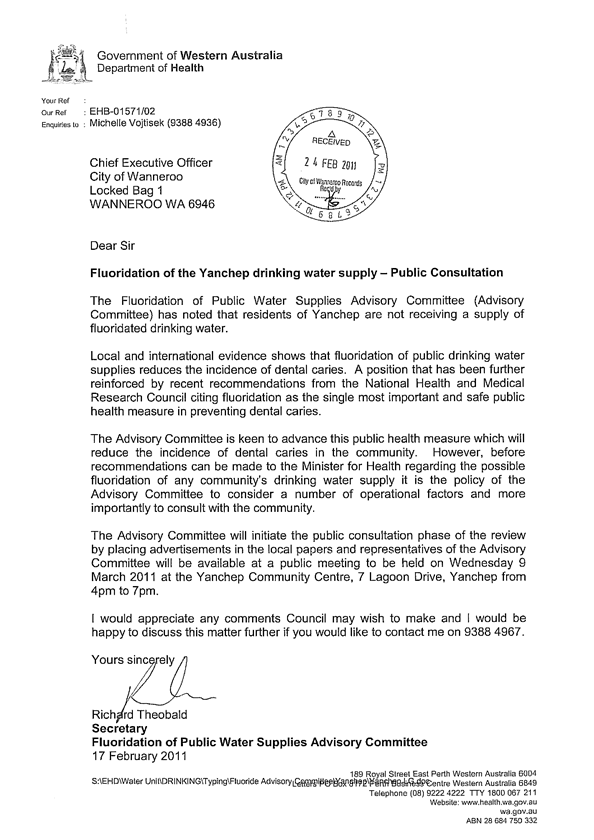
City Business
CB04-04/11 Appointment
of Delegate to the Mindarie Regional Council
File Ref: 112
– 11/26935
Responsible
Officer: Director, City Businesses
Disclosure
of Interest: Nil
Attachments: Nil
Issue
To consider the appointment of a Deputy Delegate to the
Mindarie Regional Council (MRC) for its meeting to be held on 28 April 2011,
due to the absence of Delegate Cr Gray.
Background
At the special meeting of Council held on 26 October 2009
Council appointed Cr Gray and Cr Newton as delegates for the City of Wanneroo
to the MRC.
It should be noted that the MRC does not recognise Deputies
under its constitution agreement. Therefore if a delegate is unable to
attend a meeting and wishes to have another elected member attend in their
place, it is necessary for the matter to be presented to Council in order for a
deputy delegate to be appointed.
Detail
Cr Gray has advised that she will not be able to attend the
MRC meeting to be held on 28 April 2011 at the City of Wanneroo. As a
result, this report seeks Council to appoint a delegate to the MRC for the
meeting held on 28 April 2011 only, after which Cr Gray will resume her
position as a City of Wanneroo delegate to the MRC.
It is essential that the City of Wanneroo has full
representation at this meeting given that the MRC is in the process of
developing its 2011/2012 budget and is working through significant issues
pertaining to the Resource Recovery Facility and the withdrawal of the City of
Stirling.
Comment
Nil
Statutory
Compliance
Under the Local Government Act 1995:
Part 5 – Administration
Division 2 – Council meetings, committees and their
meetings and electors’ meetings Section 5.10
“(1) A committee is to
have as its members-
(a) Persons
appointed* by the local government to be members of the committee…”
*Absolute
Majority required.
Strategic
Implications
The proposal accords with the following Outcome Objective of
the City’s Strategic Plan 2006 – 2021:
“1 Environment
1.5 Reduce
the City’s carbon footprint”
1.5.3 Improve
waste management through reduce, reuse and recycling of waste.”
Policy
Implications
Nil
Financial
Implications
Nil
Voting
Requirements
Absolute Majority
Recommendation
That Council by ABSOLUTE MAJORITY appoint Cr
______________ as a delegate for the City of Wanneroo to the Mindarie Regional
Council for the Mindarie Regional Council meeting to be held on 28 April 2011,
after which Cr Gray will resume her role as a City of Wanneroo delegate.
CB05-04/11 Tender
No. 01044 - The Supply and Delivery of 3.45mm Baling Wire for the Wangara
Recycling Centre for the Period of One (1) Year with an Option for a Further
One (1) Year.
File
Ref: 5435
– 11/21210
Responsible
Officer: Director, City Businesses
Disclosure of Interest: Nil
Attachments: Nil
Issue
To consider Tender 01044 for the Supply and Delivery of
3.45mm Baling Wire to the Wangara Recycling Centre (WRC) for a period of one
(1) year with an option of a further one (1) year.
Background
Tender 01044 was called for the supply and delivery of
3.45mm annealed baling wire for the Wangara Recycling Centre. The baling
wire is used to wrap newspapers, cardboard and plastic container bales for
transporting to international markets and is a critical purchase in relation to
the WRC’s operation.
The purchase of baling wire is funded via GL Account Number
717533.9399.243, which also funds the purchase of other major parts and
components critical for the WRC’s operations including conveyor belts,
motors, gear boxes, tools etc.
The Contract is due to commence on 11 April 2011 for a
period of one (1) year and at the expiry of the initial contract period, the
City may consider a possible one (1) year extension or part thereof. Any
such extension will be in accordance with the same terms and conditions of the
original contract. Contract prices will be subject to adjustment as per a
formula provided in the tender document.
Essential details of the contract are outlined below.
|
Contract Type
|
Schedule of Rates
|
|
Contract Duration
|
1 Year
|
|
Commencement Date
|
11 April 2011
|
|
Expiry Date
|
10 April 2012
|
|
Extension Permitted
|
Yes
|
|
Rise and Fall Included
|
Yes
|
Detail
Tender 01044 for the supply and delivery of 3.45mm annealed
baling wire for the Wangara Recycling Centre was advertised on 11 December 2010
and closed on 11 January 2011.
Two tender submissions were received as follows:
·
Concept Wire Industries
·
Whites Group Pty Ltd
The Tender Assessment Panel comprising of the City’s
Business Manager WRC, Administration Officer WRC and Contracts Officer have
evaluated the Tender submissions as follows:
Price for the services offered (50%):
The Price Schedule was compared at the fixed rate price for
the period of the contract but is subject to quarterly rise and fall as
detailed in Clause 2 of the Specification and Scope of Works. Prices
quoted include delivery to the Wangara Recycling Centre.
Both Tenders were assessed on the overall price and were
ranked as follows:
|
Price Schedule
1A& 1B Tenderer
|
Ranking
|
|
Whites Group Pty Ltd
|
1
|
|
Concept Wire Industries
|
2
|
Supply time and product availability (30%):
Concept Wire Industries requires 4 weeks lead time for the
first delivery of the wire from the east coast, while Whites Group Pty Ltd required
an initial lead time of 12 weeks for the first delivery of wire from China.
Both tenderers indicated that upon receiving the first order, they would store
enough stock in WA to meet the full 12 month order. Both tenderers required a
lead time of 2 – 3 days to fill orders from their stock held in WA.
Assessment in this instance is reflected in the ranking as
below:
|
Tenderer
|
Ranking
|
|
Concept Wire Industries
|
1
|
|
Whites Group Pty Ltd
|
2
|
Tenderers adherence to Product Specification (20%)
Both tenderers demonstrated sufficient resources and
capacity to service the supply of 3.45mm annealed baling wire to desired
specification. Ranking for this criterion is shown as follows:
|
Tenderer
|
Ranking
|
|
Concept Wire Industries
|
1
|
|
Whites Group Pty Ltd
|
1
|
Overall Weighted Score (100%):
The tenderers’ submissions were reviewed in accordance
with the weighted score analysis process and the consolidated overall ranking
of tenderers based on a weighted score for the separate Price Schedule is shown
below:
|
Tenderer
|
Ranking
|
|
Whites Group Pty Ltd
|
1
|
|
Concept Wire Industries
|
2
|
Based on the Tender Evaluation Team’s assessment of
submissions tendered, it is recommended the supply and delivery of 3.45mm
annealed baling wire be awarded to Whites Group Pty Ltd.
Comment
Whites Group Pty Ltd provides similar baling wire to other
recycling companies in Perth. Whites Group Pty Ltd is a competent contractor
and has provided similar wire to the City in the past two years. They have
scored the highest overall ranking in accordance with the assessment criteria
weighting as detailed in the tender document and therefore are recommended as
the successful tenderer.
Statutory
Compliance
Tenders have been invited and properly evaluated against the
selection criteria in accordance with Section 3.57 of the Local Government
Act and associated Local Government (Functions and General) Regulations 1996.
Strategic
Implications
The proposal accords with the following Outcome Objective of
the City’s Strategic Plan 2006 – 2021:
“4 Governance
4.4 Maintain
long-term financial stability”
Policy
Implications
Nil
Financial
Implications
Whites Group Pty Ltd has indicated that if it is awarded the
Tender, delivery of the first load would take about 12 weeks. Being the case,
it is anticipated that the first delivery would arrive on 5 July 2011. In the
meantime, the City would continue to call for quotes through the usual process,
until the first delivery.
As there is only one rate in the Schedule of Rates the
expected contract cost has not been stated in this report to respect commercial
confidentiality.
The following table provides estimated expenditure for the
purchase of baling wire in the 2010-2011 financial year.
Baling Wire –
Anticipated Expenditure 2010-2011
|
YTD Expenditure
|
Estimated
Expenditure to 30/6/11
|
Total Expenditure
|
|
$111,985
|
$48,250
|
$160,235
|
Sufficient funding will be listed in the 2011/12 budget
process to cover the purchase of baling wire.
Voting
Requirements
Simple Majority
Recommendation
That Council ACCEPTS Tender No 01044 for the supply
and delivery of 3.45mm annealed baling wire, submitted by Whites Group Pty Ltd
for a period of one (1) year, commencing 11 April 2011, with an option of a
further period of one (1) year or part thereof, with CPI in the extension
period.
Other Matters
CB06-04/11 Update
on the exit of the City of Stirling from the Mindarie Regional Council
File Ref: 2408
– 11/30694
Responsible
Officer: Director, City Businesses
Disclosure
of Interest: Nil
Attachments: 1
Issue
To provide a report to Council on the process for valuing
the share of the Mindarie Regional Council (MRC) attributable to the City of Stirling. This is part of the process whereby the City of Stirling intends to exit from the
MRC.
Background
Council on the 10th August 2010 resolved, inter
alia, under recommendation 6, “Authorises the Chief Executive Officer
to negotiate with the MRC and other participants in the MRC as to the
adjustment of the Assets and Liabilities of the MRC (as specified in
recommendation 5 above) and provide a further report for the consideration of
the Council.” CR01-08/10.
Detail
PriceWaterhouseCoopers (PwC) were appointed by the MRC to
assist the MRC and its Members in the calculation of the worth of the City of Stirling’s share of the MRC. This was to be a two stage process, the first of which
was to agree the methodology for the valuation. Each Member Council has been
requested to seek individual Council endorsement of the methodology proposed by
the PwC Consultants before commencement of the second stage, being the actual
valuation. The PwC Consultant’s Report (Attachment 1) provides the
preferred valuation method to be undertaken, and the Members of the MRC via
their individual Councils are to give approval or otherwise to the methodology
outlined, to enable stage 2 of the consultancy to proceed.
The Consultant examined three commercially used valuation
techniques and these outlined below by way of an extract from the
Consultant’s Report. Additionally the Consultant explored the possibility
of a comparison to sales of actual Waste Operations businesses, but there
appears to have been limited ones of relevance to the MRC.
1. Discounted
Cash Flow (“DCF”) Approach
This method
indicates the value of a business based on the present value of the cash flows
that the business expects to generate in the future. Such cash flows are
discounted at a discount rate (the cost of capital) which reflects the time
value of money and the risks associated with the generation and timing of the
future cash flows.
The DCF
approach comprises the following steps:
§ estimating future cash
flows for a certain discrete projection period. In the case of the MRC, the
cash flows for the waste disposal operations including rehabilitation
liabilities would be evaluated over the expected economic life of the waste
disposal operations;
§ discounting those cash
flows to present value at a rate of return that reflects the relative risk of
achieving the cash flows and the time value of money;
§ estimating the residual
value of cash flows (if any) subsequent to the discrete projection period. In
the case of the MRC, this might include the royalty stream received from LGP;
and
§ combining the value of
the residual cash flows with the discrete projection period cash flow to
indicate the market value of the business.
2. Capitalisation
of Maintainable Earnings
The
capitalisation of maintainable earnings approach to a valuation of a business
requires the assessment of the following components:
§ The future maintainable
earnings (“FME”) of the business. This is usually based on earnings
before interest, tax, depreciation and amortisation (“EBITDA”) or
earnings before interest and tax (“EBIT”); and
§ An appropriate earnings
multiple with which to capitalise the FME.
The FME
represents the assessment of expected earnings that can be derived from the
business on an ongoing basis. The earnings multiple reflects the risks in
achieving these earnings, the potential growth and the time value of money.
The
capitalisation of maintainable earnings methodology is generally used to value
established, profitable businesses with stable earnings and an indefinite
economic life.
3. Net
Assets Approach
The net assets
approach indicates the fair market value of the business by adjusting the asset
and liability balances on the balance sheet to their fair market value
equivalents. The net assets approach is based on the summation of the
individual piecemeal values of the underlying assets. The market value of the
business is then represented by the sum of the market value of the assets less
the market value of the liabilities.
This approach
is performed in two steps:
§ The value of each of
the component assets and liabilities are estimated; and
§ The net asset value of
the business is calculated by subtracting the value of the liabilities from the
value of the assets.
The major
deficiency with this approach is that it does not allow for the identification
and valuation of intangible assets which may form part of the business subject
to valuation. In the case of the MRC, these intangible assets could include the
value of the:
§ airspace which is not
specifically identified or valued on the balance sheet of the MRC;
§ lease of the Tamala
Park landfill site; and
§ licence to operate the
business.
Each method of valuing an entity has its advantages and
disadvantages however the Consultant (who has extensive experience in
valuations) has recommended using the Discounted Cash Flow (DCF) method for
reasons explained in detail on page 21 of their Report (Attachment 1).
Essentially the DCF method is forward looking and therefore would not be
influenced by the previous and current results which of course include the City
of Stirling. Furthermore the DCF approach is appropriate for assets with a
finite life, such as a landfill site. The DCF approach will implicitly
incorporate the value of the assets and liabilities, including the intangibles
of airspace and remediation.
As a cross check the Consultant is also proposing to compare
the results achieved through DCF with the other methods and additionally to
compare to the value of “airspace”, should they be able to identify
any public company acquisitions of a landfill.
Administration concurs with the Consultant that the DCF
method is the most appropriate, especially given the level of cross checking
that will apply. Some elements of the methodology have been queried by other
Member Councils and the actual methodology will be tailored further to include
addressing their specific aspects, if relevant.
Consultation
Chief Executive Officers and other executives of the Member
Councils were given a briefing by the Consultant at the offices of the Town of Cambridge on Tuesday 8 March 2011, whereby questions were asked of the Consultants on
their Draft Report as presented. A revised Final Report, as per Attachment 1,
was provided post this meeting following feedback by attendees at the meeting.
Comment
The Consultants are well known and credentialed providers of
Corporate Valuation Advisory Services. Their recommendation follows normal
accounting and valuation practices. The Consultant considered a number of
possible valuation methods including:
· Present value of
future cash flows generated (DCF);
· Capitalisation of
future maintainable earnings (FME) based on EBITDA (earnings before interest,
tax, depreciation and amortisation) or EBIT; and
· Net Assets at Fair
Market Value approach (NA).
For the various reasons stated, the Consultants recommend
and Administration concur, that the most practical method would be the DCF, but
cross checked with reference to the NA and FME methods and also with reference
to the value of air space implied by the acquisition of other Landfill
operations by publicly listed corporations.
Administration recommends that the approval to the
methodology (if given) be qualified as follows:
That the Consultant, in valuing the waste business considers
the following:
· In
assessing future cash flows, whether the MRC will continue to accept non Member
waste in future years;
· Whether
the current Member fees are accurately reflecting the “cost
recovery” intention of the pricing of Member tipping fees;
· Clarification
that the land upon which the MRC operates (Tamala Park), which is owned by the
Member councils but leased to the MRC, is included in the calculation; and
· Identifying
how the Consultant intends to value the residual liability that may occur
should pollutants escape in future years, post closure or to factor in future
legislative requirements which may impact on the cost or remediation.
Statutory
Compliance
Nil
Strategic
Implications
The proposal accords with the following Outcome Objective of
the City’s Strategic Plan 2006 – 2021:
“4 Governance
4.6 Provide
and maintain a high standard of governance and accountability”
Policy Implications
Nil
Financial
Implications
Possible implications include indirect impacts due to the
change in ownership and usage of the MRC (Landfill and RRF facilities); quantum
unknown at this stage.
Voting
Requirements
Simple Majority
Recommendation
That Council:-
1. NOTES the
Report of PriceWaterhouseCoopers in Attachment 1;
2. ACCEPTS
the recommended methodology of valuing the Mindarie Regional Council by
reference to the Discounted Cash Flow method, cross checked to alternative
valuations methods including both the Net Assets Approach and the Future
Maintainable Earnings Approach, enabling PriceWaterhouseCoopers to proceed to
stage 2 of the valuation process; and
3. REQUESTS
that PriceWaterhouseCoopers, in valuing the waste business,
consider the
following:
a) In
assessing future cash flows, whether the MRC will continue to
accept
non Member waste in future years;
b) Whether
the current Member Fee accurately reflects the “cost recovery”
intention of the pricing of Member tipping fees;
c) Clarification
that the land upon which the MRC operates (Tamala Park), which is owned by the
Member councils, but leased to the MRC, is to be sold/given up by the City of
Stirling; and
d) Identify
how the Consultant intends to value the residual liability that may occur
should pollutants escape in future years, post closure, or to factor in future
legislative requirements which may impact on the cost of remediation of the
Tamala Park site, or any other such landholdings associated with the MRC.
CITY OF WANNEROO Agenda
OF Ordinary Council Meeting 05 April, 2011 181
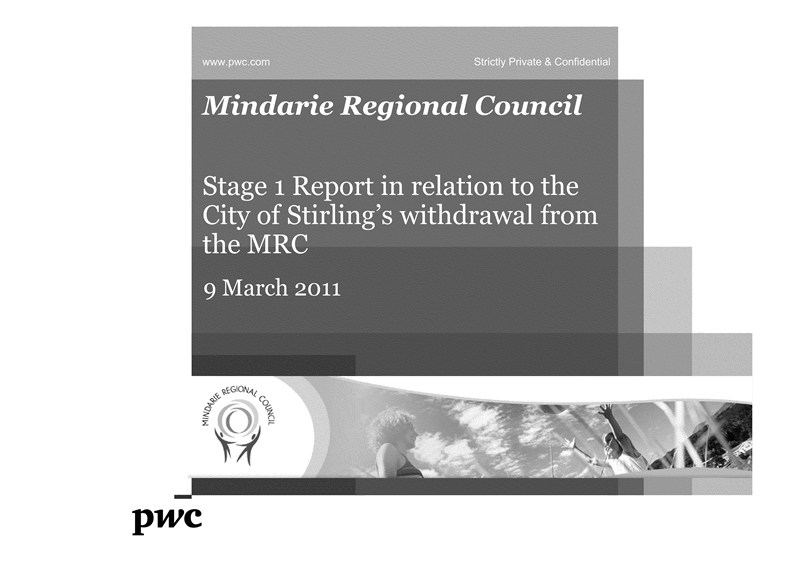
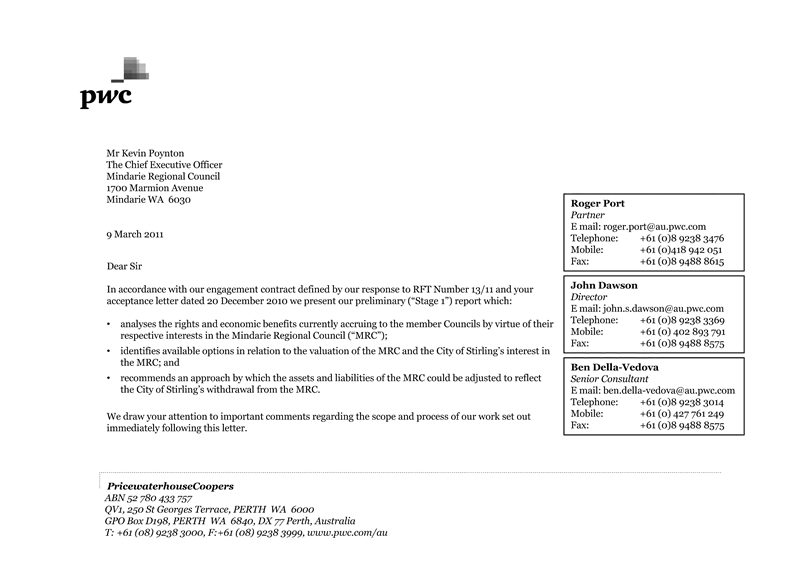



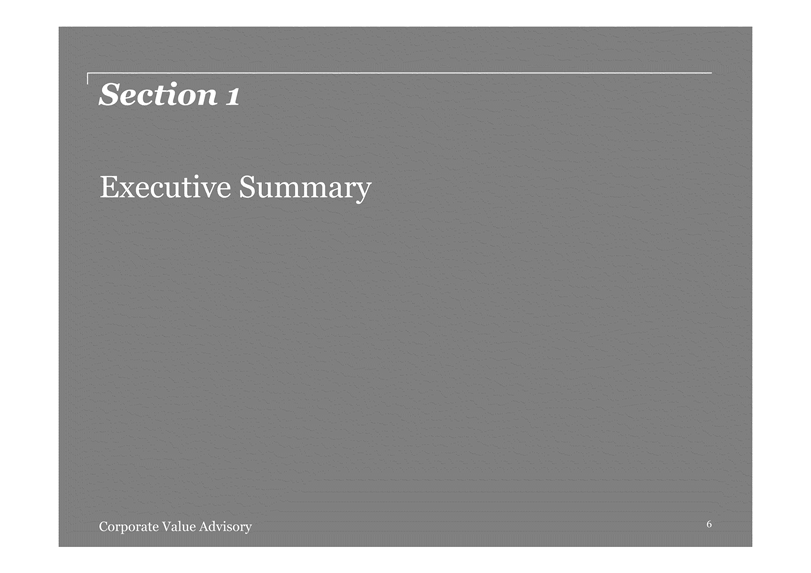
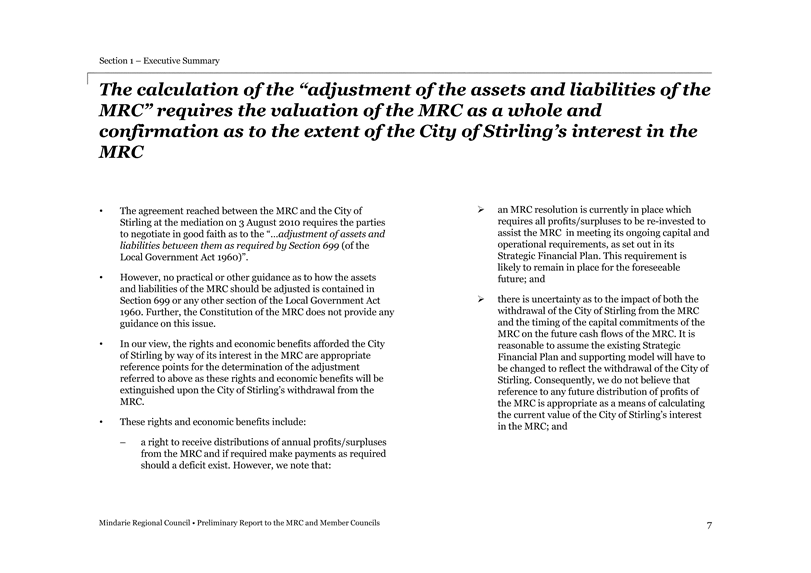
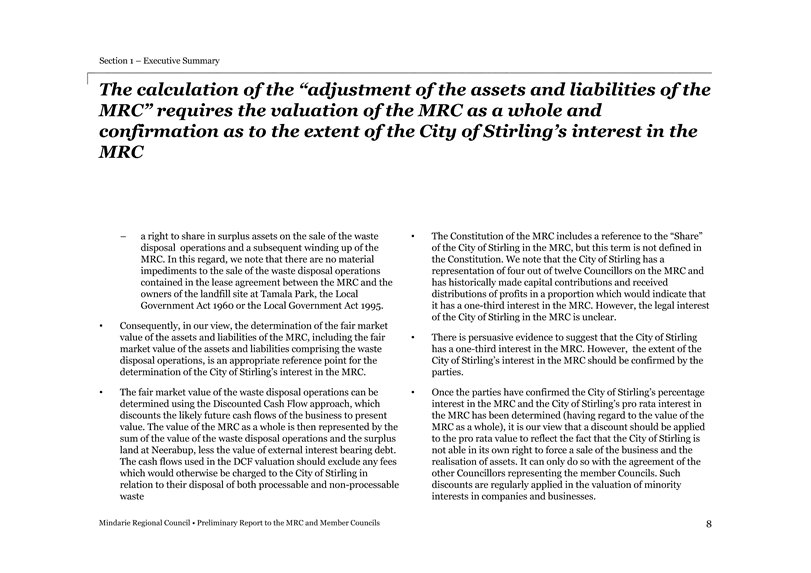
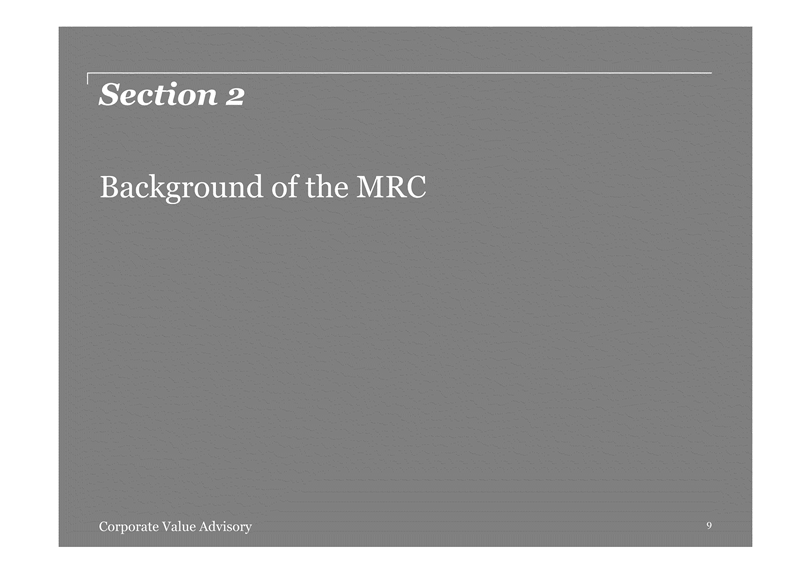

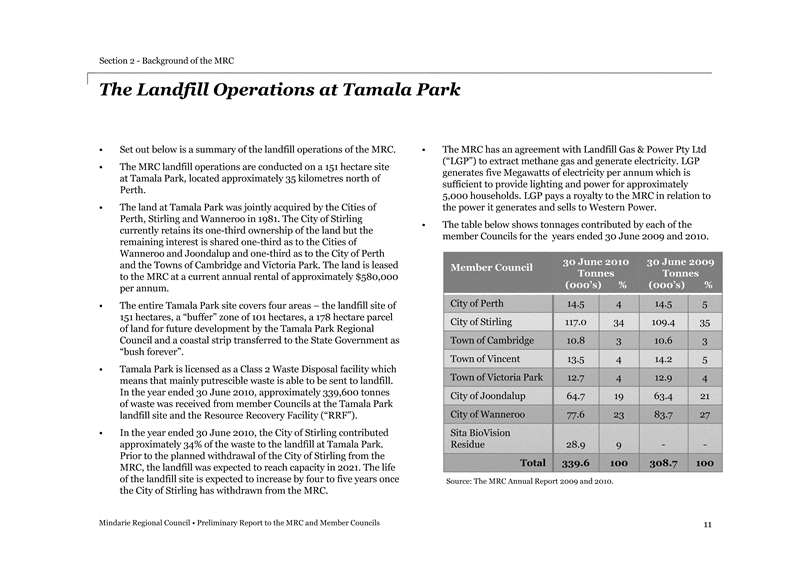
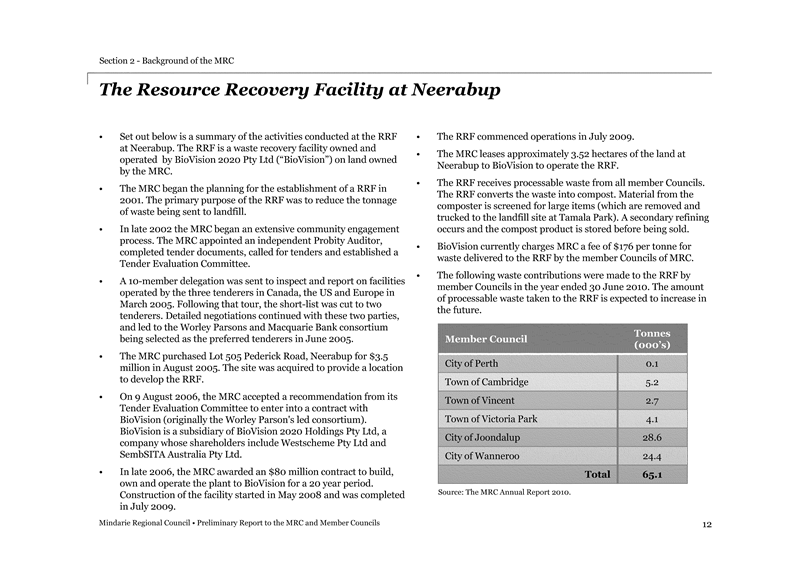
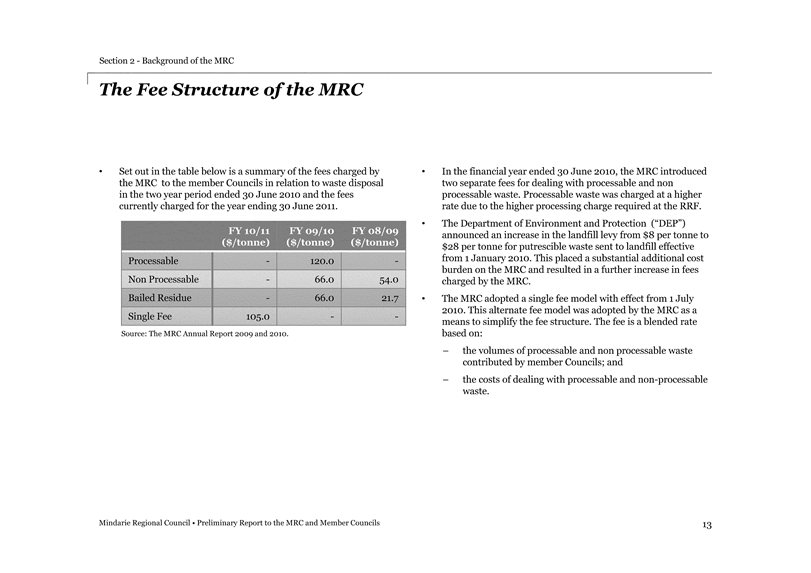
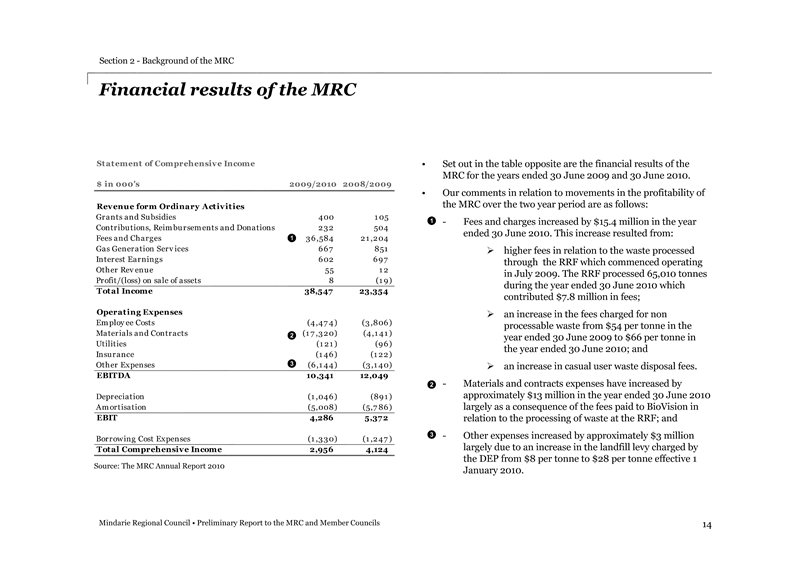

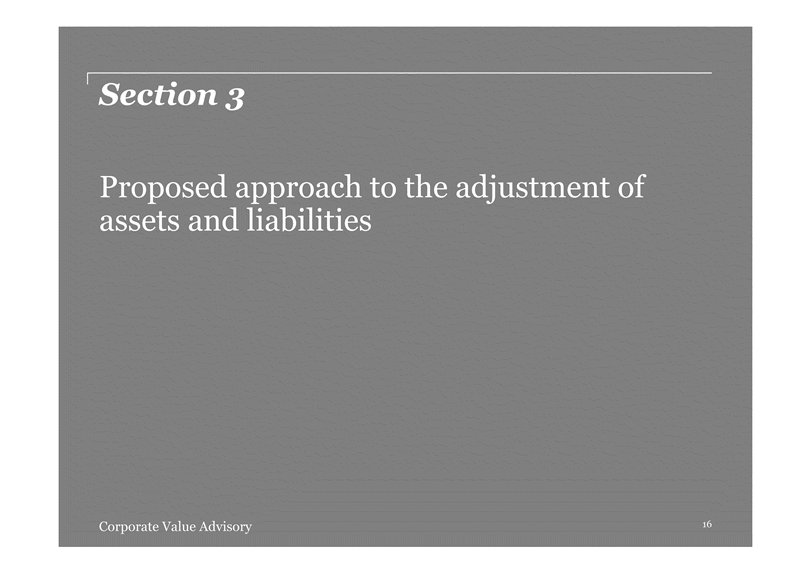
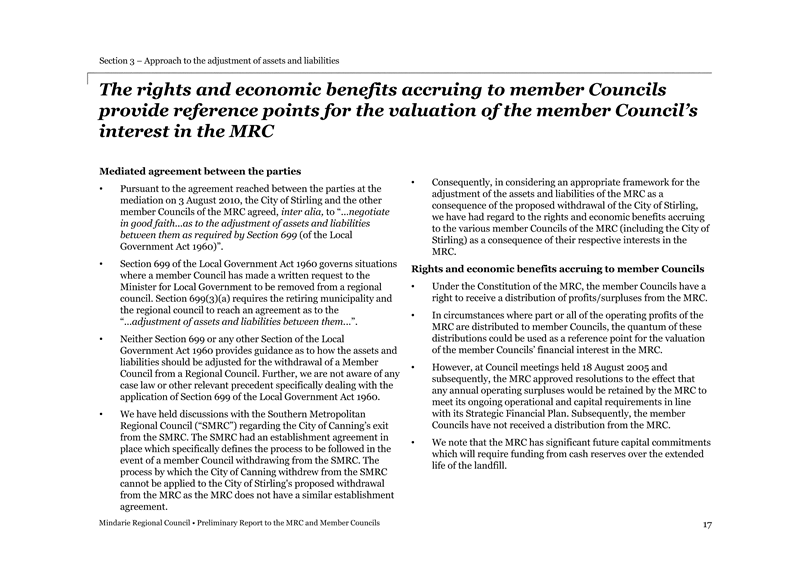
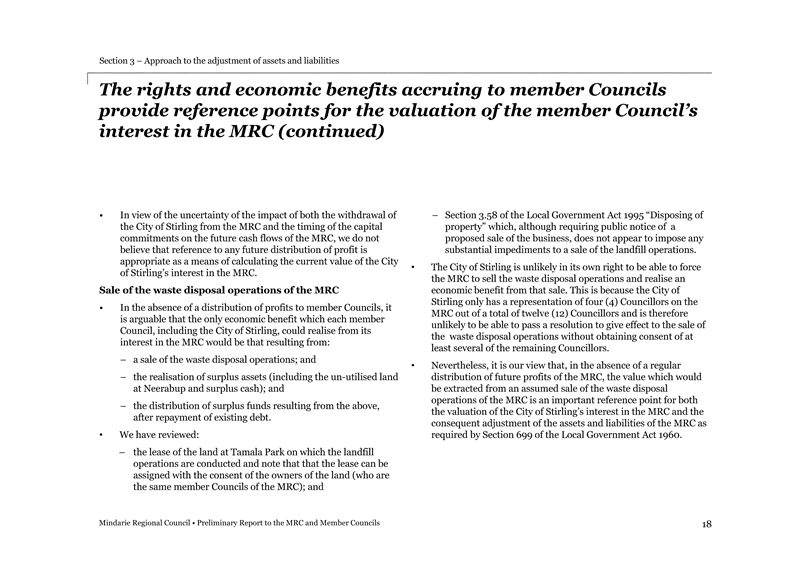

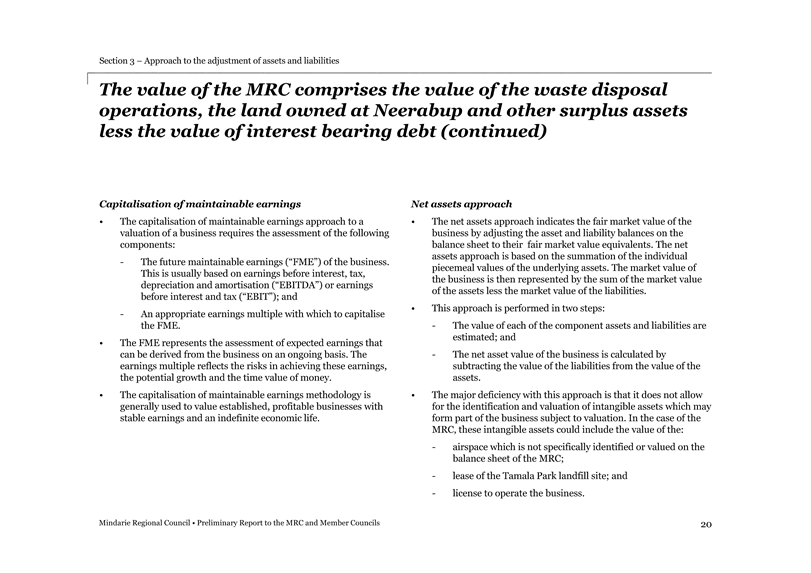
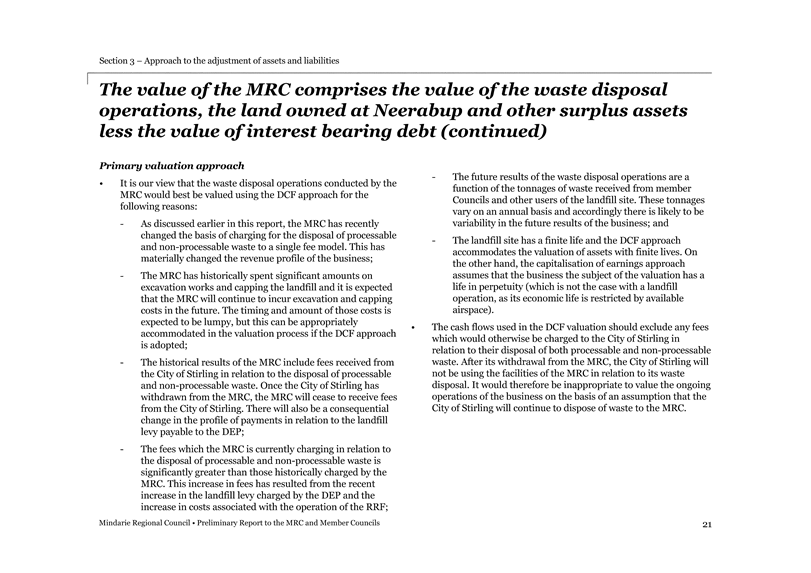
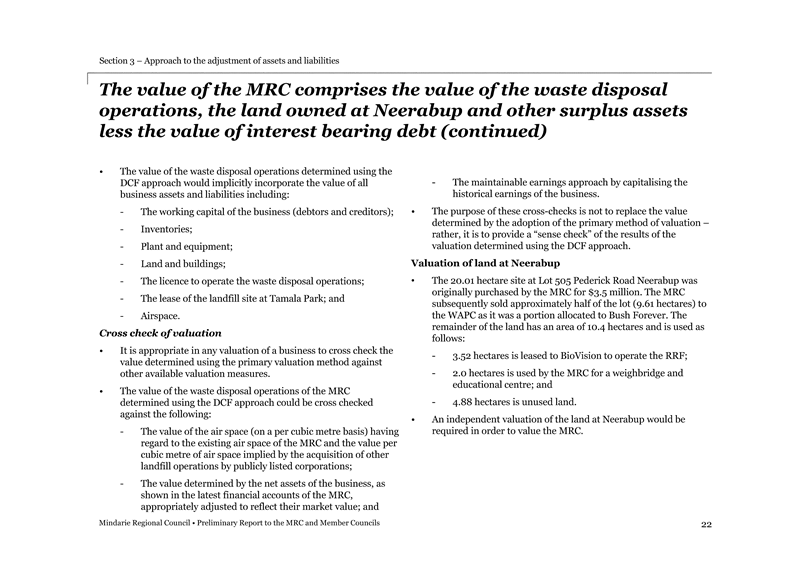
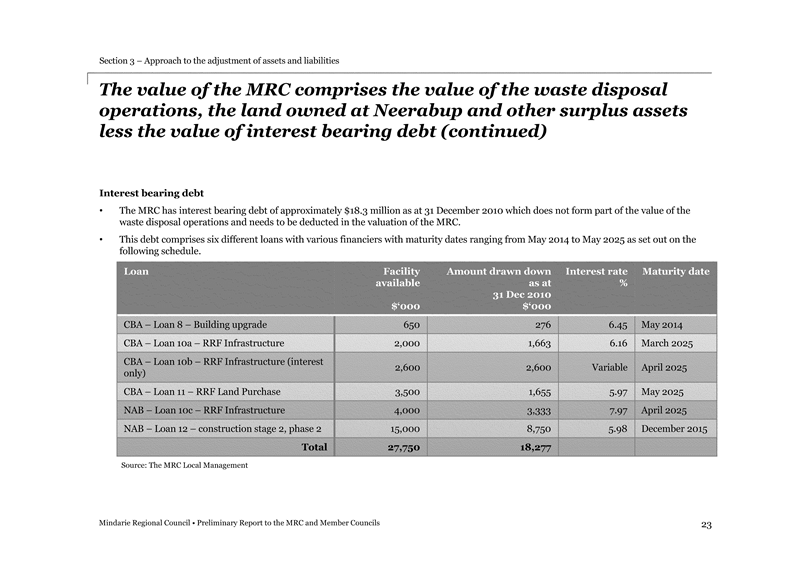
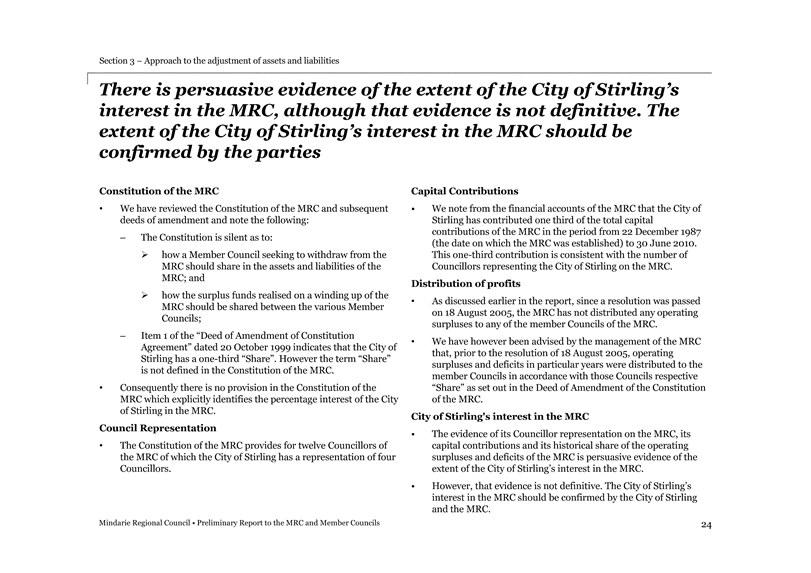

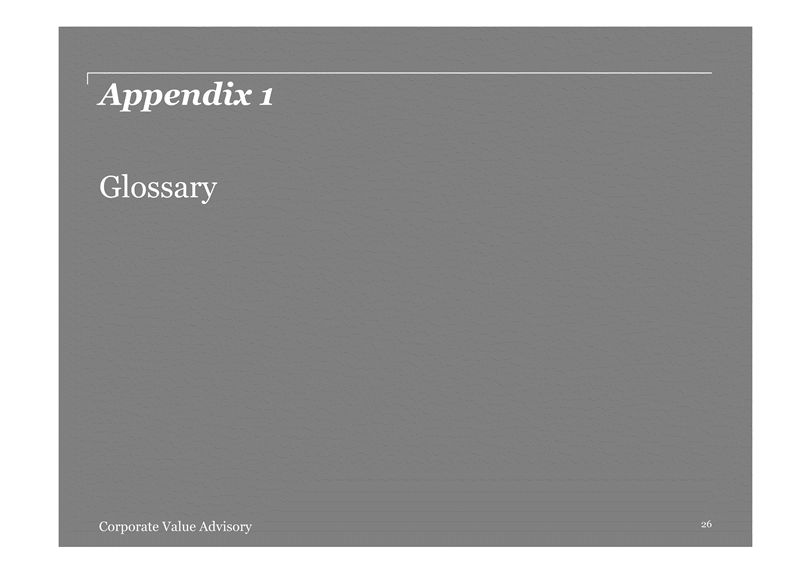
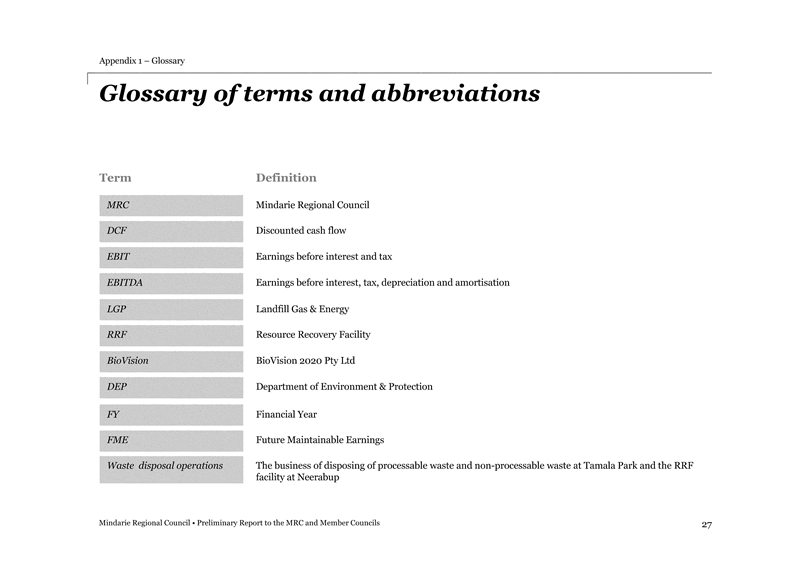
Infrastructure
Infrastructure Projects
IN01-04/11 Queenscliffe
Park Beach Access Concept Plan, Quinns Rocks
File Ref: 3503
– 11/23692
Responsible
Officer: Director, Infrastructure
Disclosure
of Interest: Nil
Attachments: 1
Issue
To consider a concept plan for the Queenscliff Park Beach
Access, Quinns Rocks.
Background
At its meeting of 15 December 2009 (IN01-12/09), Council
considered a report on the amendments to the 2009/2010 Foreshore Management
Capital Works Program and resolved as follows:
“1. DELETES
the following projects from the 2009/2010 Foreshore Management Capital Works
Program:
Design
and construction of a beach access stairs opposite 208 Ocean Drive, Quinns
Rocks (Project Nos 1487 and 1909); and
Installation
of Beach Access fencing opposite 40 Brazier Road, Yanchep.
2. Pursuant
to Section 6.8(1)(b) of the Local Government Act 1995 APPROVES BY ABSOLUTE
MAJORITY the expenditure of $148,500 for the following projects:
Design of Beach Access near
Camira Way, Quinns Rocks;
Design of Beach Access Queenscliff
Park Quinns Rocks; and
Design of Beach Access opposite
40 Brazier Road, Yanchep.
3. NOTES
the following budget variations to fund the projects outlined in Item 2:
|
Project No
|
From
|
To
|
Description
|
|
PR 1487
|
$19,400
|
|
Quinns Rocks Foreshore design
and consultation for the upgrade of existing Beach Access stairs opposite 208
Ocean Drive, Quinns Rocks
|
|
PR 1909
|
$100,000
|
|
Construction and upgrade of
existing Beach Access stairs opposite 208 Ocean Drive, Quinns Rocks
|
|
PR XXX
|
|
$35,000
|
Design of Beach Access from
Queenscliff Park, Quinns Rocks
|
|
PR XXX
|
|
$84,400
|
Design and part construction
of Beach Access near Camira Way, Quinns Rocks
|
|
PR 1453
|
$29,100
|
|
Install Beach Access fencing
opposite 40 Brazier Road, Yanchep
|
|
PR XXX
|
|
$29,100
|
Design of Beach Access
opposite 40 Brazier Road, Yanchep
|
4. NOTES
that the City’s Draft Ten Year Capital Works Program will need to be
amended to provide for the construction of a Beach Access near Camira Way and
Queenscliffe Park, Quinns Rocks.”
The following project numbers were assigned to each
location:
· Queenscliff
Park opposite 240 Ocean Drive, Quinns Rocks PR-2003
· Camira
Way Beach Access, Quinns Rocks PR-2004
· Yanchep
Beach opposite 40 Brazier Road, Yanchep PR-2005
Detail
The consultancy quotation provided by MP Rogers and
Associates was accepted in February 2010, with the consultant required to:
· Assess
the local oceanic conditions prevailing at each foreshore site and after
investigation provide a report with recommendations as to the suitability and
actions to be taken at each site;
· Provide
a concept design with cost estimate for each site;
· With
agreed costs and concept designs the City Administration to then lodge plans
for City of Wanneroo endorsement prior to concept plan submission to both the
City of Wanneroo and WAPC for Development Approval consideration and to DEC for
a clearing permit for each foreshore access way;
· After
WAPC approval, to provide contract documentation in compliance with BCA
standards together with a pre-tender cost estimate for each site;
· The
City to advertise for construction of the Camira Way site in the 2010/2011
financial year and the other two sites in subsequent financial years, and;
· After
tender closing, to provide an assessment report and administer construction
activity associated with each contract.
The timeframe for redeveloping the beach access at each site
is to be continued within the two year WAPC Development Approval as issued,
with construction to be undertaken over consecutive financial years and in the
following order:
· Camira
Way Beach Access, Quinns Rocks
· Queenscliff
Park opposite 240 Ocean Drive, Quinns Rocks
· Yanchep
Beach opposite 40 Brazier Road, Yanchep
Consultation
Public consultation for the construction of the Queenscliff
Park Beach Access at Quinns Rocks will be undertaken after Council’s
endorsement of the concept plan, and prior to submission of the Development
Approval Application and Clearing Permit. This consultation will include
a community meeting in Quinns Rocks with a presentation by MP Rogers and
Associates.
Comment
The concept plan for the Queenscliff Park Beach Access has
been designed to formalise and extend the life of the existing access, noting
that this location is subject to ongoing coastal erosion.
The Consultant has advised that at the proposed Queenscliff
Park access location there is an established trend of shoreline erosion which
is occurring at a net rate of around 1.2m per year, with approximately 33m of
coastline erosion occurring between 1981 and 2008.
Site visits during winter of 2010 has indicated that the
shoreline is continuing to erode and any access in this location should
therefore adequately cater for this trend to continue. It is noted that
there is a rock base at around 2m AHD within the access location and it is
assumed that the beach to the north and south of the site, is a sandy shoreline
base which will erode at a similar rate to the longer term historic rate.
If it is also assumed that the width of beach at the access
stays relatively constant, then the safest location for the access to limit
erosion is similar to the current position, behind the section of rock
shoreline. The actual shoreline position will be influenced by factors
such as how much rock is buried in the dunes and available sediment supply from
the adjacent beaches.
Several options for the access were explored, including;
replacement ramp, high and low stairs and concrete steps.
The main features of the proposed concept plan are:
· Retention
of the existing concrete access path;
· Small
extension / replacement at the base of the existing concrete path;
· In-situ
concrete steps cast into the existing limestone rock at the base of the path;
· Revegetation
of the informal access track over the dunes and replacement of a section of
fence in this area; and
· Brushwork
placed over the remaining dune where vegetation is sparse to encourage
rehabilitation.
The concept design for the Queenscliff Park Beach Access is
shown in City of Wanneroo Drawing No 2552-01-0, refer Attachment 1.
An outcome of the Consultants shoreline study at the
Queenscliff Park Beach Access location is a confirmation that the City should
review the option of constructing the fourth proposed groyne and modifying the
existing three groynes in the Quinns Rocks beach shoreline in the next couple
of years.
Statutory
Compliance
Before the consultant prepares contract documentation, the
concept plan and consultant’s supporting report will need to follow the
following sequential approval process:
· endorsement
by Council;
· community
consultation;
· development
approval submission to the local authority;
· development
approval submission to the WAPC, and
· clearing
and “offset” planting requirement submission to DEC.
Strategic
Implications
The proposal accords with the following Outcome Objective of
the City’s Strategic Plan 2006 – 2021:
“1 Environment
1.3 Minimise
impact of development on the environment”
1.4 Improve
the physical quality of the built environment
2 Social
2.1 Increase
choice and quality of neighbourhood and life style options
2.4 Improve
community safety”
Policy
Implications
Nil
Financial
Implications
A summary of project costs and funding for the works is
tabled below.
|
Quinns Rocks Beach Access - Queenscliff Park
|
|
PR-2004 Estimated
Project Cost
|
|
Project Funding 2009/2010
|
|
$35,000
|
|
Proposed Project Funding 20011/2012
|
|
$110,000
|
|
MP Rogers Consultancy fees
|
$35,520
|
|
|
Cost Estimate for Works
|
$62,000
|
|
|
Project Management Cost
|
$3,000
|
|
|
DEC “Offset” planting requirements
|
-
|
|
|
Advertising
|
$2,500
|
|
|
Contingency
|
$10,000
|
|
|
Total Estimated Project Cost
|
$113,075
|
|
|
Proposed Total Funding
|
|
$145,000
|
|
Funding Surplus
|
|
$31,925
|
A surplus in funding is noted, however there is no
expenditure items listed in the table for:
· A
community meeting in Quinns Rocks with a presentation made by MP Rogers and
Associates;
· Contingent
cost for concrete steps dependent on the extent of existing rock;
· Cost
escalation; and
· DEC
“offset” planting with funding for this work to be included
separately in the City’s 10 Year Capital Works Program (Environmental
Offsets).
Voting
Requirements
Simple Majority
Recommendation
That Council:-
1. ENDORSES
the Queenscliff Park Beach Access Concept Plan, Quinns Rocks as shown on City
of Wanneroo Drawing No. 2552-01-0 as Attachment 1 for community consultation;
and
2. NOTES
that a further report will be presented to Council on the outcomes of the
community consultation process prior to submitting a Development Application
for Western Australian Planning Commission consideration and an application for
Clearing Permit (if required) to the Department of Environment and
Conservation.
CITY OF WANNEROO Agenda
OF Ordinary Council Meeting 05 April, 2011 213
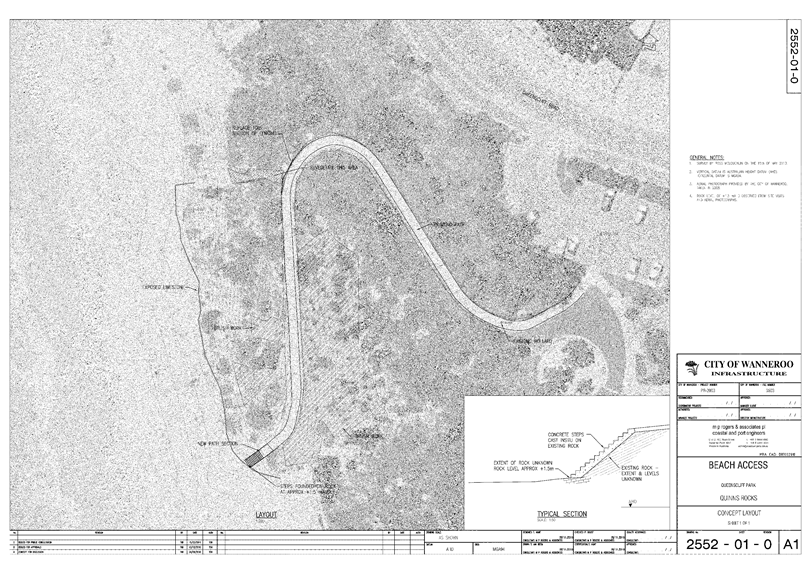
IN02-04/11 Pedestrian
Pathway - Compass Circle to Foreshore Vista, Yanchep
File Ref: 4445
– 11/23731
Responsible
Officer: Director, Infrastructure
Disclosure
of Interest: Nil
Attachments: 1
Issue
To consider the outcomes of the community consultation
process associated with the proposed Pedestrian Pathway between Compass Circle
and Foreshore Vista, Yanchep.
Background
Council, at its meeting of 24 August 2010 (Item No
PS09-08/10 refers) resolved:
1. “NOTES
the Western Australian Planning Commission’s approval to commence
development under the Metropolitan region Scheme, dated 8 July 2010 and
included as Attachment 2, for removal of the Yanchep Boardwalk and to undertake
other incidental works in accordance with the conditions contained therein and
the plan included in Attachment 1;
2. AUTHORISES
the Chief Executive Officer to lodge an application for a Demolition Licence
with the City’s Building Service unit, for removal of the boardwalk in
accordance with the plan included in Attachment 1 and;
3. NOTES
that a further report(s) will be presented to Council by Administration to
consider provisions of an alternative pedestrian access route between Foreshore
Vista and Compass Circle.”
Council considered a further
report, (Item No IN03-12/10 refers) at its meeting on
14 December 2010 addressing a proposed program for the removal of the boardwalk
and the
provision
of an alternative pedestrian access route and resolved:
1. “AMENDS
the timeframe for the removal of the Yanchep Boardwalk so that its removal
coincides with the construction of the alternative pedestrian path between
Compass Circle and Foreshore Vista, Yanchep
2. ENDORSES
the concept plan for the alternative pedestrian route between Compass Circle
and Foreshore Vista, Yanchep as shown on City of Wanneroo Drawing No 2532-6-0
(refer Attachment 2);
3. ENDORSES
that public consultation across the wider Yanchep community be undertaken in
relation to the alternative pedestrian route between Compass Circle and
Foreshore Vista, Yanchep;
4. NOTES
that the outcomes of public consultation undertaken in relation to
consideration of the alternative pedestrian route between Compass Circle and
Foreshore Vista, Yanchep, will be reported to Council prior to proceeding with
any submissions of applications for statutory authority approvals and;
5. LISTS
for consideration in the City of
Wanneroo’s 10-year Capital Works Program, a sum of $25,000 for 2011/2012
to cover offset planting associated with the proposed alternative pedestrian
route between Compass Circle and Foreshore Vista, Yanchep.”
Detail
In accordance with the resolutions of the 14 December 2010
meeting, Administration arranged for public consultation to include:
· A
mail out to 3,323 owners/occupiers on 17 January 2011 which included a copy of
the concept plan and a comment form (with a reply paid envelope), to be
returned to the City by no later than close of business on 15 February 2011;
· Listing
of the proposal on the City’s website under the section titled
“Your Say” during January 2011;
· Public
notices published in both the North Coast Times and Sun City News;
· Erection
of a sign on site at the entry to the existing path that leads to the Boardwalk
section of both Foreshore Vista and Compass Circle on 21 January 2011, advising
of the City’s intent and noting that any comment be forwarded to the City
no later than close of business on 15 February 2011; and
· Advice
that Administration staff would be on-site at the Foreshore Vista path entry on
the afternoon of Thursday, 3 February 2011 from 2 to 4 pm to discuss aspects of
the proposed design and answer any queries relating to the project.
Detail
Public consultation focused on
surveying the wider Yanchep community by direct mail, seeking comment to the
information provided.
Of the 3,323 letters mailed out by
the City to property owners/occupiers, 556 responses were received (16.73%
response rate), of which 442 (82%) supported the proposed pedestrian pathway,
92 (17%) opposing it and 6 (1%) providing no direction on whether the pathway
is supported or not.
Of the responses received
supporting the proposed pedestrian pathway, 35 (8%) also noted a preference to
retaining the Boardwalk by way of unsolicited comment. Similarly, 50 (54%) of
those opposing the proposed pedestrian pathway expressed the need to retain the
Boardwalk. In considering from an overall perspective, 85 (16%) expressed
support to retain the Boardwalk. Subsequent to the closing of the public
comment period the following petition with 391 signatures was received at the
City on 14 March 2011:
“We, the undersigned, all
being residents of the City of Wanneroo do formally request Council’s
consideration to reverse the decision to demolish the Boardwalk on Foreshore
Vista. We believe that such an act will deprive our estate of a great
asset which would be sorely missed by many residents. We feel very strongly
that the money saved could be used for more worthy projects”
On 23 March, the City received a
further 75 signatures to the petition, bringing the total number to 466. A copy
of correspondence from the Member for Mindarie, John Quigley, was received on
29 March advising that a petition with over 300 signatures to immediately
remove the Yanchep boardwalk will be tabled at the Western Australian
Parliament in early April.
In summary of the responses
received from the mail out, there is an overwhelming consensus in support of
the proposed pedestrian pathway. However, responses received have also given
rise to the following additional comment/requests:
· Place
additional seating for rest points.
Response: Appropriate location
to be considered as part of the design.
· Pathway
from Lindsay Homestead to connect with Yanchep Lagoon.
Response: Adopted Two Rocks
Yanchep Foreshore Management Plan recommends a strong pedestrian link to be
provided between the adjoining residential areas and the beach. Furthermore a
recommendation for a dual use path in the lower dunes with a link to the
Yanchep Lagoon is proposed.
· Pathway
from Yanchep Beach Road to Yanchep Lagoon.
Response: This will be
investigated by Administration for consideration in the City’s 10 Year
Capital Works Program.
· Asphalt
pathway instead of concrete.
Response: Due to the earthwork
environment it is Administration’s considered opinion that concrete is
the preferred material.
· Extend
path system to Moonlighter Way.
Response: Existing dual-use
path along Trumpeter Way is linked to the dual-use path system.
· Owner
of Lot 703 (adjacent to proposed pedestrian pathway) has expressed concern
regarding property security/privacy.
Response: Administration is in
direct dialogue with property owner to determine impact of the proposed
pedestrian pathway in relation to property security and privacy.
· Retain
the existing Boardwalk.
Response: Council has already
resolved to remove the Boardwalk as per item PS06-05/10.
· Alignment
of pathway to be west of the existing Boardwalk within the dunes.
Response: Not possible due to
environmental and Aboriginal Heritage issues.
Comment
While there was only a 16.73% return of comment forms from
the 3,323 distributed to owners/occupiers in the Yanchep area, 82% supported
the proposed pedestrian pathway.
Subject to Council’s
consideration of this report, and satisfying all statutory requirements, it is
anticipated that the program for implementation for the proposed pedestrian
pathway will be:
|
Finalisation of design drawings
|
April 2011
|
|
Development Approval (DA) submission to the West
Australian Planning Commission (WAPC) for Pedestrian Pathway
|
April 2011
|
|
Clearing Permit submission to Department of Environment
and Conservation (DEC) for Pedestrian Pathway
|
April 2011
|
|
Anticipated Statutory Authority approval for Pedestrian
Pathway
|
July 2011
|
|
Report outcomes of DA and Clearing Permit applications to
Council
|
23 August 2011
|
|
Advertise Tender for Pedestrian Pathway Construction
(subject to Council resolution)
|
27August 2011
|
|
Report outcomes of Tender to Council and seek endorsement
|
11 October 2011
|
|
Award Pedestrian Pathway Construction Contract
|
14 October 2011
|
In assessing the risks associated with the Boardwalk removal
operation, it has been highlighted that the lifting operation would more than
likely be compromised by the intensity of the high westerly and easterly winds
from November to February. Costs would increase due to stand-down time of
cranes, trucks and crew. Therefore if receipt of statutory approvals
compromises the removal programme forcing works into November/December then to
contain costs and ensure the safe removal operation of the Boardwalk, it is
recommended that removal be delayed until March/April 2012. The original
construction of the Boardwalk, including the major lifting operations was
carried out during late March 2009. A detailed site survey and design has been
completed with Design Plan Drawing Number 2532-8-1, included as Attachment
1.
Statutory
Compliance
In progressing the Pedestrian Pathway implementation,
Administration will need to satisfy the following approval processes:
· Submission
to the WAPC for DA; and
· Submission
to the DEC for a Clearing Permit and if applicable, offset planting
requirements.
Any requirements arising from DA
and/or Clearing Permit conditions inclusive of any offset planting requirements
considered applicable in this instance will be incorporated as work items along
with any modifications to the design made prior to tender advertising.
Strategic
Implications
The proposal accords with the following Outcome Objective of
the City’s Strategic Plan 2006 – 2021:
“1 Environment
1.4 Improve
the quality of the built environment”
1.5 Improve the physical quality of the built
environment
2 Social
2.1 Increase
choice and quality of neighbourhood and lifestyle options”
Policy
Implications
Nil
Financial
Implications
A summary of project costs and funding for the works is
tabled below.
|
Modification to Boardwalk (PR-2015)
|
|
|
Estimated Project Cost
|
|
|
Budgeted Project Funding 2010/2011
|
|
$300,000
|
|
|
Removal of Boardwalk
|
$94,000
|
|
|
|
City of Wanneroo Project Management Cost
|
$9,000
|
|
|
|
City of Wanneroo
Administration
|
$2,500
|
|
|
|
Works Estimate of Cost (Based on the Design Drawing)
|
$189,200
|
|
|
|
Privacy Screening (Lots 702 and 703 Foreshore Vista)
|
$10,000
|
|
|
|
Contingency @ 10% of Estimated
Project Costs
|
$30,300
|
|
|
|
Total Estimated Project Cost
|
$335,000
|
|
|
|
Total Funding
|
|
$300,000
|
|
|
Funding Short fall
|
|
$35,000
|
|
In
addition to the above project costs further costs will be incurred as a
consequence of offset planting requirements arising from the City’s
proposed application for a Clearing Permit and for the purposes of this report
these costs have not been incorporated to the above table. However, to ensure
that costs are covered in this regard it is proposed that an amount of $29,000
and $20,000 be listed for consideration by Council in the City’s 10-Year
Capital Works Program, as part of funding allocation for 2011/2012 and
2012/2013 respectively. These amounts will be subject to review once conditions
of the Clearing Permit are known and the resultant extent of the offset requirements
is determined.
Given
that construction/removal works will not be undertaken until the 2011/2012
financial year, the balance of funds in the approved budget for this project
(PR-2015), it will be necessary to carry forward these funds. Furthermore, the
shortfall in funding of $35,000 will need to be listed as an additional sum
against this project as part of Council’s 2011/2012 budget consideration.
In
addressing the original installation costs of the Boardwalk it is noted that
Council awarded a tender in the sum of $546,580 at its meeting held in
September 2008 (Item No IN02-09/08 refers) for supply and installation.
In assessing the labour versus material costs associated with this tender it is
considered that a 30% labour/70% material split in cost is a fair and
reasonable split in cost. The 70% material costs is further justified as
the materials utilised for the construction of the Boardwalk where imported
from Germany in a kitset component format, with unloading and assembly only
into the various spans undertaken on site by appropriately trained/qualified
personnel. As a consequence, the total estimated cost incurred by the
City as a consequence of removal equates to the 30% labour component of the
original installation works plus the estimated cost to remove, that is;
$164,000 plus $94,000 respectively, giving a total cost of $258,000 that can be
attributed as the estimated cost of installation and dismantling. The
estimated cost of the materials as originally supplied, namely $383,000 is considered
to be salvage value given proposed recovery of the Boardwalk spans and
subsequent storage at the City’s Ashby Operations Centre pending use
elsewhere within the City’s jurisdiction.
Voting
Requirements
Simple Majority
Recommendation
That Council:-
1. RECEIVES
this report on the outcomes of the community consultation process for the
proposed Pedestrian Pathway between Compass Circle and Foreshore Vista,
Yanchep;
2. AUTHORISES
Administration to lodge applications for West Australian Planning Commission Development
Approval and Department of Environment and Conservation Clearing Permit for the
pedestrian pathway between Compass Circle and Foreshore Vista, Yanchep, based
on the Design Plan Drawing Number 2532–8– 1 (refer
Attachment 1);
3. NOTES
that Administration will present a further report to Council should the
Construction Cost Estimate arising out of detailed design, along with any
conditions of West Australian Planning Commission Development Approval and
Department of Environment and Conservation Clearing Permit impact on the
project budget funding;
4. NOTES
that a further report will be presented to Council to consider outcomes
of the tender process for the construction of the proposed pedestrian pathway
should the tender submissions exceed the $250,000 limit for the Chief Executive
Officer to accept tenders in accordance with Clause 6.4 – Choice of Most
Advantageous Tender of the Delegated Authority Register;
5. LISTS
that an amount of $35,000 for consideration in the draft 2011/2012 Capital
Works Budget as part of funding allocated for construction of the proposed
pedestrian pathway and removal of the Yanchep Boardwalk; and
6. LISTS
for consideration in the 10 Year Capital Works Program the amounts of $29,000
in 2011/2012 and $20,000 in 2012/2013 to accommodate identified environmental
offset requirements arising from an application for a Clearing Permit.
CITY OF WANNEROO Agenda
OF Ordinary Council Meeting 05 April, 2011 220
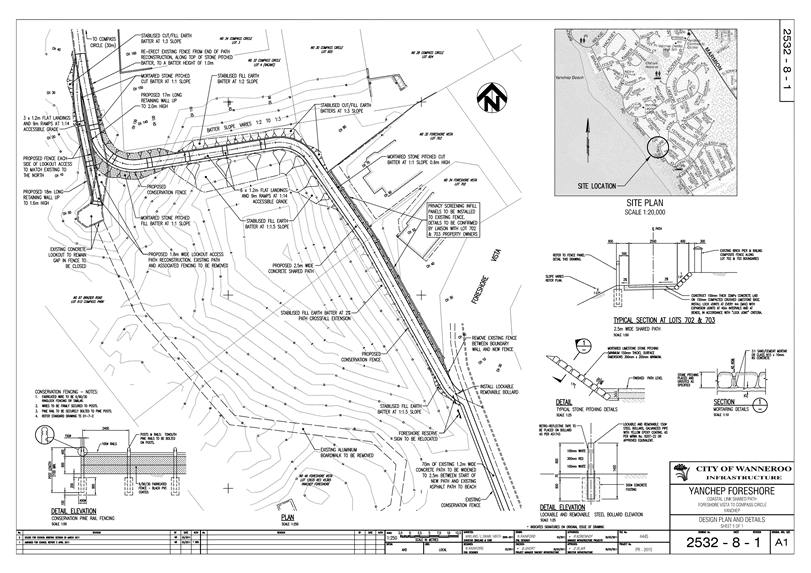
IN03-04/11 Yanchep
Active Open Space - Interim Agreement to Address Costs Associated with the
Earthworks
File Ref: 2403
– 11/30495
Responsible
Officer: Director,
Infrastructure
Disclosure
of Interest: Nil
Attachments: 1
Issue
To consider an interim agreement by the exchange of letters
between the City of Wanneroo and the Yanchep Beach Joint Venture in relation to
the costs associated with the earthworks for the Yanchep Active Open Space.
Background
Council at its ordinary meeting
of 14 December 2010 resolved the following:
“That Council:
1. NOTES
the agreed direction between the City of Wanneroo and the Yanchep Beach Joint
Venture, including the timeframes within which the Yanchep District Open Space
is being developed, subject to an appropriate Deed of Agreement being signed
between the City and the Yanchep Beach Joint Venture;
2. ENDORSES
the Yanchep Beach Joint Venture Program of Works for the Yanchep District Open
Space as shown at Attachment 1 and subject to Recommendation 1 above; and
3. ENDORSES
the concept plan for the Yanchep District Open Space, Drawing No SK021, Rev D,
as shown at Attachment 2.
CARRIED
UNANIMOUSLY”
Detail
The City and St Andrews Private Estate Pty Ltd & New
Orion Investments Pty Ltd (Joint Venturers) have been negotiating the terms and
conditions for the delivery by the Joint Venturers of construction earthworks
(Project) to support City infrastructure for two ovals in the Active Open Space
at Lot 602 Yanchep Beach Road Yanchep (the land) owned by the Joint
Venturers. The Joint Venturers have not applied, and will not apply for
some time, for subdivision approval in relation to the land and therefore delivery
of the Project prior to that application being contemplated by the Joint
Venturers in order to assist the City to meet community needs.
Consultation
Regular project meetings have been held between
Administration, representatives from the Joint Venturers and their consultants
to progress the development of the Yanchep Active Open Space.
Comment
A draft ancillary agreement has been provided by the City to
the Joint Venturers to reflect the agreement reached between the parties that
in the event that the City decides not to proceed with the Project prior to the
execution of a formal Deed of Agreement, the Joint Venturers and the City will
each bear their own costs in relation to the initial design and final design
prepared by the Joint Venturers and the internal costs of the City arising from
consultation with the Joint Venturers in anticipation of the delivery of the
Project (initial costs).
A draft Deed of Agreement relating to the specific terms and
conditions of the Project and including schedules setting out, inter alia, the
scope of works, time for delivery of the works and fees payable by the City to
the Joint Venturers etc has been provided by the City to the Joint Venturers.
Both the draft ancillary deed and the draft Deed of
Agreement were to be presented by Mr Gin Wah Ang (a director of New Orion
Investments Pty Ltd) to the Joint Venturers and their legal advisors in April
however given the current situation in Japan, Mr Ang has informed the City
lawyer that he will not be travelling to Japan as planned.
In the meantime, the City has agreed with Mr Ang that a
letter in respect to the initial costs will be signed by both parties in order
that both parties may move to formalising the agreements reached to date and
provide comfort to each other that both parties are committed to delivery of
the Project but in the event that does not proceed, neither will look to the
other party for a contribution towards costs incurred.
Copies of the signed letter by Mr Ang and a proposed letter
for the signature of the CEO are contained in Attachment 1.
Statutory
Compliance
Nil
Strategic
Implications
The proposal accords with the following Outcome Objective of
the City’s Strategic Plan 2006 – 2021:
“2 Social
2.1 Increase
choice and quality of neighbourhood and lifestyle options”
<Insert futher Strategic Implications if
required…>
Policy
Implications
Nil
Financial
Implications
The only costs currently being incurred by the City on this
project relates directly to staff input to the process. Council has approved
funds in the 10 Year Sports Facilities Capital Works Program for the
development of the Yanchep Active Open Space, however expenditure is not likely
to occur until the statutory approvals are finalised and earthworks have
commenced.
Voting
Requirements
Simple Majority
Recommendation
That Council:-
1. AGREES
to an interim agreement by the exchange of letters contained in
Attachment 1 between the City of Wanneroo and the Yanchep Beach Joint Venture
in relation to the costs associated with the earthworks for the Yanchep
Active Open Space, noting that a short draft Deed and draft Deed of Agreement
have been prepared to formalise the terms and conditions applicable for the
delivery of construction of earthworks on Yanchep Active Open Space by the Yanchep
Beach Joint Venture; and
2. ENDORSES
the signing of the City of Wanneroo letter contained in Attachment 1 by the
Chief Executive Officer.
CITY OF WANNEROO Agenda
OF Ordinary Council Meeting 05 April, 2011 224


Tenders
IN04-04/11 Tender
No 01104 - The Provision of Linemarking, Signs, and Spotting Services
File
Ref: 4240
– 11/21389
Responsible
Officer: Director, Infrastructure
Disclosure of Interest: Nil
Attachments: 1
Issue
To consider Tender No 01104 – The Provision of
Linemarking, Signs and Spotting Services.
Background
Due to the continuous need for linemarking and spotting
services associated with capital works and maintenance activities, quotation
arrangements that are currently utilised by the City are to be replaced with
proposed tender arrangements to reduce the administration task and to ensure
that all expenditure related to these activities is centrally administered.
Detail
Tender No 01104 – The Provision of Linemarking, Signs
and Spotting Services was advertised on 5 February 2011 and closed on 1 March
2011. Refer Attachment 1 for schedule of tender items.
Essential details of the contract are outlined below.
|
Contract Type
|
Schedule of Rates
|
|
Contract Duration
|
1 Year
|
|
Commencement Date
|
1 May 2011
|
|
Expiry Date
|
30 April 2012
|
|
Extension Permitted
|
Yes
|
|
Rise And Fall Included
|
No
|
At the expiry of the initial contract period, the City may
consider extending this contract for two additional periods of one year each or
part thereof. Any extension will be in accordance with the same terms and
conditions of the original contract and at the discretion of the City, with CPI
applicable.
Tenders were received from the following four companies
listed below:-
· Road
and Traffic Services
· Chris
Velios Contracting
· Intersectional
Line Markers Pty Ltd
· Weston
Road Systems
The Tender Evaluation Team comprising two Projects Engineers
and the Contracts Officer, has evaluated the tenders in accordance with the
following selection criteria:
|
Item No
|
Description
|
Score
|
|
1
|
Price for the services offered
|
50%
|
|
2
|
Tenderer’s experience and ability to do the work
|
30%
|
|
3
|
Tenderer’s resources
|
15%
|
|
4
|
Safety Management
|
5%
|
Price for the services offered (50%):
Price for the tendered items is quite varied and a range of
linemarking scenarios was used to do the price assessment.
The evaluation highlighted that the tenderers’ pricing
was very competitive. It was noted that Chris Velios Contracting, was the only
tenderer to submit prices for signs. However the evaluation did not include
this item in order for a fair comparison of prices to be made in general.
In undertaking the assessment it was noted that Road and
Traffic Services provided the lowest and second lowest price for the most
number of items, although this did not influence the scenario price assessment
approach that was used to determine price rankings for each company.
The four tenderers have been ranked in the following order
under this criterion:
|
Tenderer
|
Rank
|
|
Road and Traffic Services
|
1
|
|
Weston Road Systems
|
2
|
|
Intersectional Line Markers
|
3
|
|
Chris Velios Contracting
|
4
|
Tenderer’s experience and ability to do the work
(30%):
All four tenderers were assessed to have variable amounts of
experience with previous contracts for their tendered items. Intersectional
Line Markers Pty Ltd has no local government experience. However they do have
Main Roads WA experience with two of its term maintenance contractors to a
value over $1M for each of these contracts.
Road and Traffic Services and Weston Road Services both have
local government experience with both companies having made progress toward
quality accreditation.
The four tenderers have been ranked in the following order
under this criterion:
|
Tenderer
|
Rank
|
|
Road and Traffic Services
|
1
|
|
Weston Road Systems
|
1
|
|
Intersectional Line Markers
|
2
|
|
Chris Velios Contracting
|
3
|
Tenderer’s resources (15%):
All four tenderers were assessed to have sufficient
resources to provide the required services for their tendered items.
It was noted however that Chris Velios Contracting is a sole
trader and relies on sub-contractors for large scale works. Limited information
was provided in regards to resources and reliance on other sub-contractors for
traffic control and thermo and cold plastic treatments in this bid.
Weston Road Services also relies on a sub-contractor for
traffic management and it is apparent that the City will probably incur
additional costs in situations where considerable traffic control is necessary.
Road and Traffic Services, Weston Road Systems and Intersectional Line Markers
all provided comprehensive information on staff resources and available plant.
The four tenderers have been ranked in the following order
under this criterion:
|
Tenderer
|
Rank
|
|
Road and Traffic Services
|
1
|
|
Weston Road Systems
|
1
|
|
Intersectional Line Markers
|
1
|
|
Chris Velios Contracting
|
2
|
Safety Management (5%):
Evidence of safety management policies and practices was
assessed from the tender submissions. The assessment for safety management was
based on the tenderer’s response to an Occupational Health and Safety
Management System Questionnaire included within the tender documentation.
The four short-listed tenderers were assessed to have quite
varied safety management procedures and practices in place to provide the
tendered services. The companies showed evidence of having a varying degree of
policies and procedures in place with Job Safety Analysis sheets.
The four tenderers have been ranked in the following order
under this criterion:
|
Tenderer
|
Rank
|
|
Road and Traffic Services
|
1
|
|
Weston Road Systems
|
2
|
|
Intersectional Line Markers
|
3
|
|
Chris Velios Contracting
|
4
|
Overall Evaluation Results
The Tender Evaluation Team scored each tenderer against the
above-established criteria. The overall ranking of the tenders based on a
weighted score is as follows:
|
Tenderer
|
Rank
|
|
Road and Traffic Services
|
1
|
|
Weston Road Systems
|
2
|
|
Intersectional Line Markers
|
3
|
|
Chris Velios Contracting
|
4
|
Consultation
Nil
Comment
A variety of scenarios were used to determine a weighted
assessment of prices and it was noted that the leading bid identified from this
process was also the lowest and second lowest price tender in terms of raw unit
rates. This provides confidence in the assessment that has ranked Road and
Traffic Services as the lowest tender.
Typically linemarking, spotting and signing are used on new
works in carparks, new road construction, in advance of Main Roads WA road
marking, and resurfacing projects. The highest ranked tender, Road and Traffic
Services, can provide all scheduled items except signing, however it should be
noted that signing services can be sourced through the City’s existing signs
contract.
Tender bids include modest traffic management costs, however
it should be noted that substantial work on busy streets and intersections will
incur traffic management costs in addition to the tendered traffic management
rates. This is considered reasonable and necessary with such arrangements made
possible through the City’s new traffic management and traffic control
services contract.
This report’s recommendation is based on a detailed
evaluation of the tenders and the recommendation that tender No 01104 from Road
and Traffic Services be accepted is in accordance with the tender evaluation
results and accompanying objective assessment by the Tender Evaluation Panel.
Statutory
Compliance
Tenders were invited in accordance with the requirements of
Section 3.57 of the Local Government Act 1995. The tendering procedures
and evaluation complied with the requirements of Part 4 of the Local Government
(Functions and General) Regulations 1996.
Strategic
Implications
The proposal accords with the following Outcome Objective of
the City’s Strategic Plan 2006 – 2021:
“2 Social
2.5 Improve
transport options and connections”
Policy
Implications
Nil
Financial
Implications
The extent of expenditure associated with this tender is
dependent on the type of capital works projects approved in the Capital Works
Program. The cost of such works will be directly charged to projects.
Expenditure will also be incurred for maintenance works,
which will be charged to the Maintenance Works Operating Budget allocations.
Based on similar extrapolated quantities to those used in
2010/2011, the estimated annual cost of linemarking, signs and spotting
services is in the order of $90,000.
Voting
Requirements
Simple Majority
Recommendation
That Council ACCEPTS Tender No 01104 from Road and
Traffic Services as per the Schedule of Rates and general conditions of
tendering for a period of one year commencing 1 May 2011, as shown at
Attachment 1, with the option to extend for a further 2 x 12 months with CPI
applicable.
CITY OF WANNEROO Agenda OF Ordinary Council Meeting 05
April, 2011 230
SCHEDULE 1 – SERVICING PRICE SCHEDULE
(Complete the
following details and submit with the Tender)
AS PER SPECIFICATION
|
TENDER PRICES ALL PRICES EXCLUSIVE OF GST
|
|
|
ITEM
|
DESCRIPTION – LINEMARKING Supply
and install pavement markings
|
|
|
PAINT PAVEMENT MARKING
– Solvent borne chlorinated
rubber paint shall comply with AS/NZS 4049.3: - 2005. Glass beads shall be
used on the marking and shall comply with AS2009
|
|
|
Sizes (widths, spacings
etc) to be in accordance with appropriate Australian Standards (as per
specification clause 1.1)
|
PRICE PER LINEAL METRE
(EX GST)
|
|
|
1
|
On street parking bays
|
$
|
|
|
2
|
Parking bays in a car
park
|
$
|
|
|
3
|
Holding line (Stop)
prior to MRWA line marking
|
$
|
|
|
4
|
Holding line (Give Way)
prior to MRWA line marking
|
$
|
|
|
5
|
Bus bays – yellow
line
|
$
|
|
|
6
|
Painting of speed humps
|
$
|
|
|
7
|
ACROD parking stencil
|
$
|
|
|
8
|
Cyclist stencil on road
or cycleway
|
$
|
|
|
9
|
Pedestrian stencil on
shared path
|
$
|
|
|
10
|
Stencilled letters
– per letter
|
$
|
|
|
PAINT PAVEMENT
MARKING – Water borne
chlorinated rubber paint shall comply with AS4049.1: 2005. Glass beads shall
be used on the marking and shall comply with AS2009.
|
|
|
(USE SUBCONTRACTOR
RATES IF APPLICABLE)
|
PRICE PER LINEAL METRE (EX
GST) EXCEPT WHERE STATED OTHERWISE
|
|
|
11
|
On street parking bays
(Each)
|
$
|
|
|
12
|
Parking bays in a car
park (Each)
|
$
|
|
|
13
|
Temporary holding line
(Stop) prior to MRWA line marking
|
$
|
|
|
14
|
Temporary holding line
(Give Way) prior to MRWA line marking
|
$
|
|
|
15
|
Bus bays – yellow
line
|
$
|
|
|
16
|
Painting of speed bumps
|
$
|
|
|
THERMOPLASTIC
PAVEMENT MARKING – Water borne
chlorinated rubber paint shall comply with AS4049.1: 2005. Glass beads shall
be used on the marking and shall comply with AS2009.
|
|
|
(USE SUBCONTRACTOR
RATES IF APPLICABLE)
|
PRICE PER LINEAL METRE (EX
GST) EXCEPT WHERE STATED OTHERWISE
|
|
|
17
|
On street parking bays (Each)
|
$
|
|
|
18
|
Parking bays in a car
park (Each)
|
$
|
|
|
19
|
Holding Line (Stop)
prior to MRWA line marking
|
$
|
|
|
20
|
Holding Line (Give Way)
prior to MRWA line marking
|
$
|
|
|
21
|
Bus bays – yellow
line
|
$
|
|
|
22
|
Painting of speed humps
|
$
|
|
|
COLD-APPLIED PLASTIC PAVEMENT MARKING
Cold-applied plastic pavement marking shall be poly
methacrylate resin based marking material and shall comply with AS4049.2.
Glass beads shall be used on the marking and shall comply with AS2009.
|
|
|
(USE SUBCONTRACTOR
RATES IF APPLICABLE)
|
PRICE PER LINEAL METRE
(EX GST) EXCEPT WHERE STATED OTHERWISE
|
|
|
23
|
On street parking bays
(Each)
|
$
|
|
|
24
|
Parking bays in a car
park (Each)
|
$
|
|
|
25
|
Holding line (Stop)
prior to MRWA line marking
|
$
|
|
|
26
|
Holding line (Give Way)
prior to MRWA line marking
|
$
|
|
|
27
|
Bus bays – yellow
line
|
$
|
|
|
28
|
Painting of speed humps
|
$
|
|
|
29
|
ACROD parking stencil
(Each)
|
$
|
|
|
GLOW LINE - (USE
SUBCONTRACTOR RATES IF APPLICABLE)
|
|
|
Per lineal metre of road
unless stated otherwise
|
PRICE PER METRE (EX GST)
|
|
|
30
|
Apply Glow Line to
mountable kerbing
|
$
|
|
|
31
|
Apply Glow Line to
semi-mountable kerbing
|
$
|
|
|
32
|
Apply Glow Line large
arrows to kerb face
|
$
|
|
|
33
|
Apply Glow Line small
arrows to kerb face
|
$
|
|
|
PICKUP AND SPOTTING
SERVICES (USE ACCREDITED SUBCONTRACTOR RATES IF APPLICABLE)
|
|
|
Per lineal metre of road
unless stated otherwise
|
RATES per hour (EX GST)
|
|
|
34
|
Pickup survey of
existing line marking. (Minimum 2 hours) Hourly rate.
|
$
|
|
|
35
|
Pickup survey of
existing line-marking rate thereafter
|
$
|
|
|
36
|
Prepare as-constructed
delineation works drawings
|
$
|
|
|
37
|
Spotting of line marking
after road resurfacing. (Minimum 2 hours) Hourly rate.
|
$
|
|
|
38
39
|
Spotting of line marking
after road resurfacing. Rate thereafter.
|
$
|
|
|
Removal of existing
pavement marking – Price per metre.
|
$ per metre
|
|
|
TRAFFIC MANAGEMENT (USE SUBCONTRACTOR RATES IF APPLICABLE)
|
|
|
|
RATES per hour (EX GST)
|
|
|
40
|
Traffic management
charge for minimum 2 hours works rate
|
$
|
|
|
41
|
Traffic management
charge thereafter works hourly rate
|
$
|
|
|
42
|
Call out charge for
minor works of less than 2 hours duration
|
$
|
|
|
OTHER (USE
SUBCONTRACTOR RATES IF APPLICABLE)
|
|
|
|
RATES per hour (EX GST)
|
|
|
43
|
Other services to be
separately specified as independent additional line items if necessary
|
$
|
|
|
|
|
|
|
|
|
|
NAME OF TENDERER:
|
|
|
SIGNATURE OF
TENDERER:
|
DATE:
|
IN05-04/11 Tender
No 01108 - the Provision of General Weed Control Services for a Period of Two
Years
File Ref: 5697
– 11/28069
Responsible
Officer: Director, Infrastructure
Disclosure
of Interest: Nil
Attachments: 1
Issue
To consider Tender No. 01108 for The Provision of General Weed
Control Services within the City of Wanneroo for a Period of 2 Years.
Background
The City is responsible for the management/eradication of
weed growth throughout the City’s assets, including but are not
restricted to pathways, kerb lines, traffic calming devices, public access
ways, parks, reserves, verges and medians. This service has been contracted out
for a number of years to enable in-house staff and resources to be assigned to
other maintenance activities such as parks maintenance and development,
building surrounds maintenance and tree pruning activities.
Detail
Tender No. 01108 for The
Provision of General Weed Control Services within the City of Wanneroo was
advertised on 26 February 2011 and closed on 15 March 2011. Refer Attachment
1 for schedule of tender items
Essential details of the
contract are outlined below:
|
Contract Type
|
Schedule
of Rates
|
|
Contract Duration
|
2
years
|
|
Commencement Date
|
1
May 2011
|
|
Expiry Date
|
30
April 2013
|
|
Extension Permitted
|
12
Months or part there of
|
|
Rise And Fall Included
|
No
|
Tender submissions were received from the
following companies:
– Turfmaster
Facility Management
– Environmental
Industries Pty Ltd
– Maxwell
Robinson & Phelps
– Steamwand
International T/A Weed Technics
– Ghems
Revegetation Environmental
The Tender Evaluation Team,
consisting of the Coordinator Parks Maintenance, Coordinator Conservation
Maintenance and the Contracts Officer, has evaluated the tender submissions in
accordance with the following selection criterion:
|
Item No
|
Description
|
Weighting
|
|
1
|
Price for the services offered
|
50
|
|
2
|
Tenderer’s experience and ability to do the work
|
15
|
|
3
|
Tenderer’s resources
|
20
|
|
4
|
Safety Management
|
15
|
One of the tenderers, Weed
Technics in its tender submission has suggested the use of products to provide
“Chemical Free” weed management. Due to the nature, size and
general conditions of the tender, Weed Technics was unable to provide a
conforming tender and provided an alternate tender submission. Accordingly, the
tender submission from Weed Technics was not considered for evaluation.
Price
for the Services Offered (50%)
An overall estimated cost based
on the likely quantities and schedule of rates was calculated for each tender.
The overall estimated costs resulted in the tenderers being ranked as below under
this criterion:
|
Tenderer
|
Rank
|
|
Turfmaster Facility Management
|
1
|
|
Maxwell Robinson & Phelps
|
2
|
|
Environmental Industries Pty
Ltd
|
3
|
|
Ghems Revegetation
Environmental
|
4
|
Tenderer’s
experience and ability to do the work (15%)
The tenderer’s experience contained in the tender
documentation was examined in order to evaluate their ability to meet the
requirements of the contract. Assessment of this criterion considered the
tenderer’s previous and current experience similar to the services noted
within this tender which resulted in the following ranking:
|
Tenderer
|
Rank
|
|
Turfmaster Facility Management
|
1
|
|
Maxwell Robinson & Phelps
|
1
|
|
Environmental Industries Pty
Ltd
|
2
|
|
Ghems Revegetation
Environmental
|
2
|
Tenderer’s
Resources (20%)
The tenderer’s resources contained in the tender
documentation were examined in order to evaluate their ability to meet the
requirements of the contract. Assessment of this criterion considered the
tenderer’s staff resources, vehicles, plant/equipment and workshop
support to manage the contract which resulted in the following ranking:
|
Tenderer
|
Rank
|
|
Turfmaster Facility Management
|
1
|
|
Maxwell Robinson & Phelps
|
1
|
|
Ghems Revegetation
Environmental
|
2
|
|
Environmental Industries Pty
Ltd
|
3
|
Safety
Management (15%)
Evidence of safety management policies
and practices was assessed from the tender documents. The assessment for
safety management was based on the tenderers’ responses to an
Occupational Health and Safety Management System Questionnaire included within
the tender documentation.
All the tenderers provided varying details
of their safety management systems which resulted in the following ranking:
|
Tenderer
|
Rank
|
|
Turfmaster Facility Management
|
1
|
|
Maxwell Robinson & Phelps
|
1
|
|
Ghems Revegetation
Environmental
|
2
|
|
Environmental Industries Pty
Ltd
|
3
|
Overall
Weighted Score
The overall weighted score has resulted in
the following tender ranking:
|
Tenderer
|
Score
|
|
Turfmaster Facility Management
|
1
|
|
Maxwell Robinson & Phelps
|
2
|
|
Ghems Revegetation
Environmental
|
3
|
|
Environmental Industries Pty
Ltd
|
4
|
Additional
Comments
Nil
Consultation
Nil
Comment
The tender submission from Turfmaster Facility Management
achieved the highest score in accordance with the assessment criteria and
weighting as detailed in the tender document and is therefore recommended for
acceptance. Turfmaster Facility Management has provided these services to the
City in the past and therefore no further reference checking was undertaken.
It is appropriate that the City on a trial basis, gives
further consideration to chemical free weed management suggested by one of the
tenderers.
Statutory
Compliance
Tenders were invited in accordance with the requirements of
Section 3.57 of the Local Government Act 1995. The tendering procedures and
evaluation complied with the requirements of Part 4 of the Local Government
(Functions and General) Regulations 1996.
Strategic
Implications
The proposal accords with the following Outcome Objective of
the City’s Strategic Plan 2006 – 2021:
“1 Environment
1.4 Improve
the quality of the built environment”
Policy
Implications
Nil
Financial
Implications
Based on the recommended tenderer’s schedule of rates,
the total annual value of works under this contract is estimated to be in the
order of $240,000 which is accommodated in the annual Parks Maintenance
Operating Budgets.
Voting
Requirements
Simple Majority
Recommendation
That Council ACCEPTS the
tender submitted by Turfmaster Facility Management for Tender No.
01108 for The Provision of General Weed Control
within the City of Wanneroo as per the Schedule of Tender Items and general
condition of contract for a period of two years as shown at Attachment
1, with an option to extend the contract for a further 12 months or part
thereof, with CPI applicable.
CITY OF WANNEROO Agenda
OF Ordinary Council Meeting 05 April, 2011 236
Sheet 1 of 2
SCHEDULE 1 –
PRICE SCHEDULE
(Complete
the following details and submit with the Tender)
AS
PER SPECIFICATION PAGE 10
|
TENDER PRICES
ALL PRICES FIXED & EXCLUSIVE OF GST
|
|
ITEM
|
DESCRIPTION
|
UNIT
|
YEAR 1
01/05/11 to 30/04/12
|
YEAR 2
01/05/12 to 30/04/13
|
|
LOCATION SPECIFIC
|
|
PATHWAYS
|
|
1
|
Supply and application of a mix of
Roundup at 9 litres per hectare and Simazine at 6 kilograms/ hectare
|
/m2 /m2
|
$
|
$
|
|
KERB LINES
|
|
2
|
Supply and application of a mix of Roundup at 9
litres per hectare and Simazine at 6 kilograms/ hectare
|
/lineal metre /Lineal
|
$
|
$
|
|
TRAFFIC CALMING DEVICES (HARD SURFACE)
|
|
3
|
Supply and application of a mix of Roundup at 9
litres per hectare and Simazine at 6 kilograms/ hectare
|
/m2 /m2
|
$
|
$
|
|
DRAINAGE SUMPS
|
|
4
|
Supply and application of a mix of Razor at 6
litres/ hectare
|
/m2 /m2
|
$
|
$
|
|
PUBLIC ACCESSWAYS
|
|
5
|
Supply and application of a mix of Roundup at 9
litres per hectare and Simazine at 6 kilograms/ hectare
|
/m2 /m2
|
$
|
$
|
|
6
|
Supply and apply Razor 360 g/L at 6
litres/ hectare
|
/m2 /m2
|
|
$
|
|
7
|
Supply and apply Roundup at 9 litres/
hectare
|
/m2
|
$
|
$
|
|
8
|
Supply and apply of a mix of Roundup at 9
litres/ hectare and Simazine at 6 kilograms/ hectare
|
/m2
|
$
|
$
|
|
NAME OF TENDERER:
|
|
|
SIGNATURE OF TENDERER:
|
DATE:
|
Sheet
2 of 2
SCHEDULE 1 – PRICE SCHEDULE (CONT’D)
(Complete
the following details and submit with the Tender)
AS
PER SPECIFICATION PAGE 10
|
TENDER PRICES
ALL PRICES FIXED & EXCLUSIVE OF GST
|
|
ITEM
|
DESCRIPTION
|
UNIT
|
MIN.
QTY
|
YEAR 1
01/05/11 to 30/04/12
|
YEAR 2
01/05/12 to 30/04/13
|
|
GENERAL
|
|
9
|
Supply and apply Simazine 900 at 5 kilograms/
hectare
|
/m2 /m2
|
|
$
|
$
|
|
10
|
Supply and apply Fusilade Forte at 5 litres/ hectare
|
/m2 /m2
|
|
$
|
$
|
|
11
|
Supply and apply Spearhead at 5 litres/ hectare
|
/m2
|
|
$
|
$
|
|
12
|
Supply and apply Pantera at 5 litres/ hectare
|
/m2
|
|
$
|
$
|
|
13
|
Supply and apply a mix of Pantera at 5 litres/
hectare and Simazine at 6 kilograms/ hectare
|
/m2
|
|
$
|
$
|
|
14
|
Supply and apply Targa at 5 litres/ hectare
|
/m2
|
|
$
|
$
|
|
15
|
Supply and apply Ronstar at 200 kilograms per
hectare
|
/m2 /m2
|
|
$
|
$
|
|
16
|
Supply and apply Casoron (granular) at 60 kilograms
per hectare
|
/m2
|
|
$
|
$
|
|
17
|
Supply and apply a mix of Spearhead at 5 litres per
hectare and Simazine at 6 kilograms per hectare
|
/m2 /m2
|
|
$
|
$
|
|
18
|
Supply and apply spray pattern indicator (Rhodamine
free)
|
/m2 /m2
|
|
$
|
$
|
|
19
|
Supply only Kwikin
|
/Litre /m2
|
|
$
|
$
|
|
20
|
Supply only Pulse Penetrant
|
/Litre
|
|
$
|
$
|
Notes: Should any listed chemical become unavailable then the Contractor
shall seek an alternative, which is similar to the unavailable chemical in both
operation and price. The alternative will be negotiated with the Principal and
will be approved by the Principal if reasonable in both operation and price. If
the approved alternative results in savings or additional costs to the
Contractor then the Price Schedule shall be adjusted to reflect the savings or
costs.
Min. Qty: The Contractor is to specify the minimum quantity for the smallest
sized area it is willing to undertake per job.
|
NAME OF TENDERER:
|
|
|
SIGNATURE OF TENDERER:
|
DATE:
|
Traffic Management
IN06-04/11 Carramar
Special Rural Zone (Tranquil Drive) - Review of Traffic Issues
File
Ref: 3000
– 11/21160
Responsible
Officer: Director, Infrastructure
Disclosure of Interest: Nil
Attachments: 7
Issue
To consider traffic options to be included in community
consultation with the residents of the Carramar Special Rural precinct to
address through traffic and speeding within the precinct.
Background
Over many years the City has received numerous complaints
from the residents of the Carramar Special Rural precinct regarding traffic
issues along Tranquil Drive and Rustic Gardens, principally the speed of
traffic, the volume of transit traffic, and the volume of commercial vehicles. Refer
Attachment 1 for a location plan identifying the subject area.
Council last considered this issue at its meeting of 5 May
2009 (IN02-05/09 refers) where it resolved as follows:-
1. “Notes the results of the traffic
studies on Tranquil Road and Rustic Gardens, Carramar;
2. Endorses public consultation with the
residents of the Carramar Golf Links Estate on the following traffic treatment
options:
a) Closure
of Tranquil Drive at Flynn Drive;
b) Closure
of Tranquil Drive at Carramar Road;
c) Closure
of Tranquil Drive between Sublime Glade and Bushland Retreat; and
d) No
change to the existing road network
3. Considers the results of the public
consultations at a future meeting.”
Detail
The area of Carramar serviced by Carramar Road, Tranquil
Drive and Rustic Gardens is zoned ‘special rural’.
Carramar Road, Tranquil Drive and Rustic Gardens are
classified as local distributor roads in the City’s Functional Road
Hierarchy and provide the road network spine through the precinct. As a
special rural subdivision, the road network has also been designed to cater for
fire safety by providing alternate exits to the north and south.
Carramar Road runs east/west between Wanneroo Road and
Tranquil Road for a distance of 360 metres and has been constructed with an 8.5
metre wide pavement. Tranquil Drive runs north-south between Flynn Drive
and Carramar Road. It is 2.13 kilometres in length and has been constructed
with a 6.3 metre wide pavement. Rustic Gardens curves between Tranquil
Drive in the north and Golf Links Road in the south. Rustic Gardens is
1.92 kilometres in length and has been constructed with a 6.4 metre wide
pavement for the majority of its length.
Carramar Road, Tranquil Drive, Rustic Gardens and Wildflower
Drive are all posted with 60km/h speed limits. ‘Local Traffic
Only’ signs are installed at the intersections of Tranquil Drive and
Flynn Drive, Tranquil Drive and Carramar Road, and Rustic Gardens and Golf
Links Road.
As is typical for other special rural subdivisions, the
roads in the precinct are without kerbing, footpaths and street lighting.
As a result, pedestrians in the precinct either walk on the road or along the
road shoulder. As the majority of complaints focus on the proportion of
road users, believed to be non-local, transiting through the subdivision (i.e.
rat-running) and speeding, the residents perceive a loss in amenity in what is
a semi-rural precinct.
Complaints also centre on the volume of heavy commercial
vehicles using these roads and the noise generated by the early morning
users. The growth of the Neerabup Industrial Area and its future impact
on these roads adds to these concerns.
The attraction for drivers ‘rat-running’ along
Carramar Road and Tranquil Drive in preference to using the Wanneroo Road /
Flynn Drive intersection is that it is perceived to be shorter, quicker, and
safer.
In response, Administration conducted traffic studies on
Tranquil Drive and Rustic Gardens, and undertook an Origin/Destination
Study. The results of these studies were referred to Council at its
meeting of 5 May 2009 (IN02-05/09 refers).
The results of the traffic study are also shown in Table 1
and Attachment 2, while the results of the Origin/Destination Study are
shown in Tables 2 and 3, and Attachment 3.
Table 1 – Traffic
Data
|
Location
|
AWT
(vpd)
|
85%ile Speed
(km/h)
|
% Commercial
|
|
Tranquil Drive: North
of Carramar Road
|
1462
|
72
|
8
|
|
Tranquil Drive: South
of Sublime Glade
|
1103
|
80
|
14
|
|
Tranquil Drive: South
of Flynn Drive
|
835
|
73
|
8
|
|
Rustic Gardens: East of
Tranquil Drive
|
295
|
71
|
12
|
Table 2 –
Origin/Destination Data (AM)
|
Thursday, 9 October 2008
- 7.00am - 8.30am
|
|
Origin
|
Destination
|
Vehicle Count
|
%
|
|
Tranquil Drive/Carramar
Road
(Total incoming vehicles =75)
|
Flynn Drive
|
45
|
60%
|
|
Golf Links Road
|
0
|
0%
|
|
Carramar Road
|
2
|
2.7%
|
|
Tranquil Drive/Flynn
Drive
(Total incoming vehicles =21)
|
Flynn Drive
|
2
|
9.5%
|
|
Golf Links Road
|
0
|
0%
|
|
Carramar Road
|
13
|
61.9%
|
|
Rustic Gardens/Golf
Links Road
(Total incoming vehicles =27)
|
Flynn Drive
|
11
|
40.7%
|
|
Golf Links Road
|
0
|
0%
|
|
Carramar Road
|
0
|
0%
|
Table 3 –
Origin/Destination Data (PM)
|
Thursday, 9 October 2008 - 3.30pm - 5.30pm
|
|
Origin
|
Destination
|
Vehicle Count
|
%
|
|
Tranquil Drive/Carramar
Road
(Total incoming vehicles =89)
|
Flynn Drive
|
10
|
11.2%
|
|
Golf Links Road
|
0
|
0%
|
|
Carramar Road
|
5
|
5.6%
|
|
Tranquil Drive/Flynn
Drive
(Total incoming vehicles =163)
|
Flynn Drive
|
0
|
0%
|
|
Golf Links Road
|
0
|
0%
|
|
Carramar Road
|
58
|
35.6%
|
|
Rustic Gardens/Golf
Links Road
(Total incoming vehicles =53)
|
Flynn Drive
|
0
|
0%
|
|
Golf Links Road
|
0
|
0%
|
|
Carramar Road
|
0
|
0%
|
Local distributor roads in an urban environment often carry
up to 3,000 vehicles per day (vpd) but can carry up to 6,000 vpd.
Analysis of the results in Table 1 indicates that the traffic volume on
Tranquil Drive at 1,462 vpd is considered moderate for its rural character,
while the traffic volume on Rustic Gardens at 295 vpd is low. However,
the 85th percentile speeds are well above the posted speed limits of
60km/h.
The percentage of commercial vehicles on Tranquil Drive is
8% and Rustic Gardens, 12%; which would be considered moderately high in an
urban environment, while in a rural area where larger vehicles are more common
it can be considered moderate. Detailed analysis of the data does show
that commercial vehicles begin operating shortly after 5am.
Analysis of the origin/destination survey listed in Tables 2
and 3 validates the residents concerns that there is a significant
‘rat-run’ along Tranquil Drive between Carramar Road and Flynn
Drive, during both the morning and evening, whilst Rustic Gardens experiences a
lower level of through traffic in the mornings.
Consultation
Initial community consultation conducted in March 2010, with
further consultation proposed.
Comment
In order to progress community discussion, the City advised
the residents of the Carramar Special Rural precinct in March of 2010 that it
proposed to conduct a series of trial road closures along Tranquil Drive, in
accordance with Council resolution IN02-05/09, in order to gain practical
feedback from residents. However, due to fire safety concerns raised by
residents the trial was subsequently cancelled and they were advised that the
City would explore alternatives.
When considering options, Administration was limited by the
semi-rural nature of the precinct as standard traffic management philosophy is
focused on urban areas where roads are kerbed and treatments are well
lit. Standard traffic management treatments are also considered to have
an influence of only 80-100 metres and need be repeated at those intervals to
affect the whole road length.
To achieve traffic calming along Carramar Road, Tranquil
Drive and Rustic Gardens would require a complete change in the road
environment, requiring the kerbing and draining of the roads, along with the
installation of street lighting along their length.
Administration has taken the view that removal of transit
traffic is the issue of most concern to the community. If the transit
traffic can be reduced or eliminated, any residual speeding issues are the
result of the communities own actions. As a result the City has now
developed six alternative proposals for consideration by the residents of the
Carramar Special Rural precinct as detailed below:
a) Installation
of a Separation Line along Carramar Road, Tranquil Drive and Rustic Gardens
The Australian Standard
‘AS1742.2-1994 Manual of uniform traffic control devices - Traffic
control devices for general use’ allows for the use of a separation line
along roads carrying more than 2,500vpd on an urban road and 300vpd for a rural
road.
If Main Roads WA is willing to
assess these roads as rural and approve the installation of a separation line
this will provide delineation of lane width and improve separation of opposing
vehicle flows.
Advantages:
Improved road safety by
delineation of lane width and separation of opposing vehicle flows.
Delineation of narrow 3 metre lane
width, may also result in reduced overall speeds.
Disadvantages:
Changes the visual character of
these semi-rural roads.
b) Cul de sac
the Tranquil Drive/Flynn Drive intersection (Refer Attachment 4: Drawing
No. 2669-1-0)
This proposal is to
cul de sac Tranquil Drive at Flynn Drive with a driveway link onto
Flynn Drive. The driveway link is to be one way, with left turn only at
Flynn Drive. The driveway link can be constructed as a simple one way
road or with a kerb threshold at both ends to reinforce the idea that it in not
part of the normal road network.
Advantages:
Reduces the attractiveness of this
route to north bound transit traffic as access onto Flynn Drive is left turn
only.
Prohibits entry of transit traffic
from Flynn Drive.
Allows entry of emergency vehicles
from Flynn Drive.
Provides an emergency exit route
for local residents.
Disadvantages:
Prevents entry of all traffic from
Flynn Drive, including local residents.
Restricts exit of local traffic
onto Flynn Drive to left turn only.
Under this proposal, until Flynn
Drive is upgraded to a dual carriageway, the left turn only exit and no entry
restrictions will be regulated by signage only. As such, it can be
expected that there will be a level of non-compliance due to the remote
location of the junction which will need to be dealt with by the WA Police, as
the City has no authority to enforce the Road Traffic Code.
c) Restrict the Carramar
Road/ Wanneroo Road intersection to left-in/left-out only (Refer Attachment 5:
Drawing no. 2663-1-0).
This proposal will restrict access
to/from Carramar Road at Wanneroo Road to left-in/left-out.
Advantages:
North bound traffic on Wanneroo
Road will no longer be able to access Carramar Road, which is the majority
access point for transit traffic.
Disadvantages:
Restricts access and egress of
local residents of the Carramar Special Rural precinct.
Increased traffic on Inverell
Green by residents of Carramar Special Rural precinct.
Could result in north bound
transit traffic also detouring via Golf Links Road and Inverell Green.
d) Change
the ‘Give Way’ priority of the Carramar Road/Tranquil Drive/
Inverell Green intersection (Refer Attachment 6: Drawing No. 2666-1-0)
The current intersection is
configured with Carramar Road and Tranquil Drive as the priority through road
and Inverell Green is the terminating leg of the ‘T’
intersection. The City has received complaints about the poor sightlines
at this intersection.
Advantages:
Improve the sight lines and
consequently safety of the intersection.
Introduces a ‘Give
Way’ to the ‘rat-run’ and potentially increasing the time
delay and reducing its attractiveness.
Disadvantages:
Encourage greater use of Inverell
Green as it would be the priority road.
e) Change
the ‘Give Way’ priority of the Tranquil Drive/ Rustic Gardens
intersection (Refer Attachment 7: Drawing No. 2668-1-0)
This proposal changes the through
priority of this intersection, with Tranquil Drive between Flynn Drive and
Rustic Gardens becoming the terminating leg of the ‘T’
intersection.
Advantages:
South bound traffic on Tranquil
Drive must ‘Give Way’ to Tranquil Drive/Rustic Gardens priority
traffic, which may reduce speed and creating some delays for through traffic
reducing the attractiveness of the ‘rat-run’.
Disadvantages
Creates an uninterrupted road
circuit from the Golf Links Drive/Cheriton Drive roundabout to Carramar Road
f) Take
no action and review the traffic issues in the Carramar Special Rural Precinct
after the realignment of Flynn Drive and the installation of traffic control
signals at the new Wanneroo Road/Flynn Drive intersection
The City’s 2010/2011 Capital
Works Program allocates $6,226,000 for the construction of a new carriageway
for Flynn Drive on a new alignment between Wanneroo Road and Tranquil
Drive. In addition, Main Roads WA has agreed to the installation of
traffic control signals at the new Wanneroo Road/ Flynn Drive
intersection. However, at its meeting of 16 November 2010 Council
resolved to defer this project (IN03-11/10 refers):
“1. DEFERS
the construction of the Flynn Drive Realignment Project (PR-1494) until a firm
budget/timeframe for construction works for the dualling of Wanneroo Road from
Joondalup Drive to Hall Road is provided by State Government;
2. NOTES
LandCorp’s offer of assistance in relation to any lobbying of
State Government that may be required to fund and bring forward the
construction for the duplication of Wanneroo Road from Joondalup Drive to Hall
Road;
3. AUTHORISES
the Mayor to write to the Hon Simon O’Brien MLC, Minister for Transport,
requesting that funding be allocated by State Government in the 2011/2012 state
budget to enable the early construction of the duplication of Wanneroo Road
from Joondalup Drive to Hall Road;
4. REQUESTS
Main Roads WA to undertake the construction of temporary improvement works
linked to the existing Wanneroo Road/Flynn Drive intersection, Neerabup, with
the cost of these works to be funded from the $500,000 Black Spot funding from
State Government that was initially granted to City in relation to proposed
improvement works at this intersection;
5. NOTES
that the programme of the Flynn Drive Realignment Construction Project
(PR-1494) will be considered as part of the 2011/2012 Budget deliberations, at
which time direction regarding State Government commitment to the Wanneroo Road
Dual Carriageway Project should be known; and
6. NOTES
that Administration will continue to pursue the outstanding land aquatic and
environmental approvals.”
When this project is undertaken
it will improve access and safety at the Wanneroo Road/Flynn Drive intersection
and will help reduce the attraction of the Carramar Road/Tranquil Drive
‘rat-run’ for commercial vehicles.
Advantages:
Delaying Council’s decision
until after the Wanneroo Road/Flynn Drive works are complete will ensure that
funds are not expended on works that in the longer term are not needed.
Disadvantages:
This issue has a long history and
delaying action further may not be acceptable to residents.
Statutory
Compliance
Nil
Strategic
Implications
The proposal accords with the following Outcome Objective of
the City’s Strategic Plan 2006 – 2021:
“2 Social
2.4 Improve
community safety”
Policy
Implications
Nil
Financial
Implications
The recommendations of this report do not commit Council to
the expenditure of any fund on road works. However, as a guide to the
likely cost of the various road work options the following estimates are
provided:
a) Installation
of a Separation Line along Carramar Road, Tranquil Drive and Rustic Gardens
– ost $5,000
b) Cul
de sac the Tranquil Drive/Flynn Drive intersection – Cost $70,000
c) Restrict
the Carramar Road/ Wanneroo Road intersection to left-in/left-out only –
cost $25,000
d) Change
the ‘Give Way’ priority of the Carramar Road/Tranquil
Drive/Inverell Green intersection – cost $70,000
e) Change
the ‘Give Way’ priority of the Tranquil Drive/Rustic Gardens
intersection – cost $70,000
f) Take
no action and review the traffic issues in the Carramar Special Rural Precinct
after the realignment of Flynn Drive and the installation of traffic control
signals at the new Wanneroo Road/Flynn Drive intersection – cost Nil.
Voting
Requirements
Simple Majority
Recommendation
That Council:-
1. Endorses community consultation
with the residents of the Carramar Special Rural precinct on the following
traffic treatment options:
a) Installation
of a Separation Line along Carramar Road, Tranquil Drive and Rustic Gardens;
b) Cul de
sac the Tranquil Drive/Flynn Drive intersection;
c) Restrict
the Carramar Road/ Wanneroo Road intersection to left-in/left-out only;
d) Change
the ‘Give Way’ priority of the Carramar Road/Tranquil
Drive/Inverell Green intersection
e) Change
the ‘Give Way’ priority of the Tranquil Drive/Rustic Gardens
intersection; and
f) Take
no action and review the traffic issues in the Carramar Special Rural Precinct
after the realignment of Flynn Drive and the installation of traffic control
signals at the new Wanneroo Road/Flynn Drive intersection.
2. NOTES that a report will be
presented to Council on the results of the community consultation process.
CITY OF WANNEROO Agenda
OF Ordinary Council Meeting 05 April, 2011 245
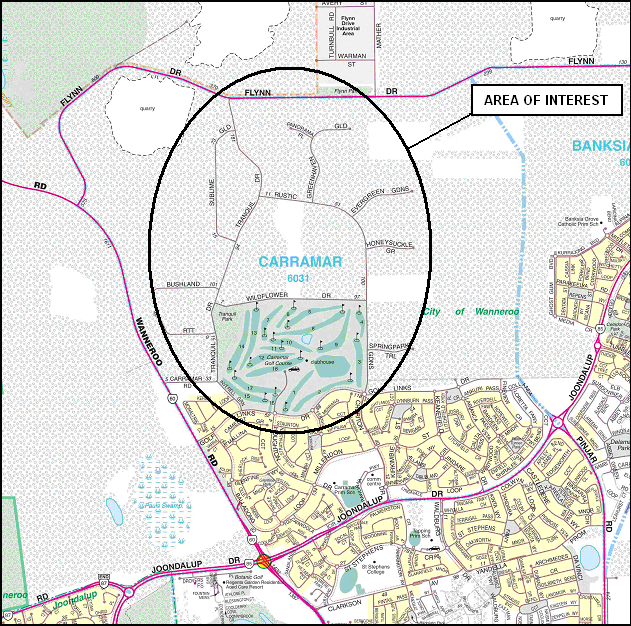
LOCATION
MAP – Carramar Special Rural Precinct
CITY OF WANNEROO Agenda OF Ordinary Council Meeting 05
April, 2011 246
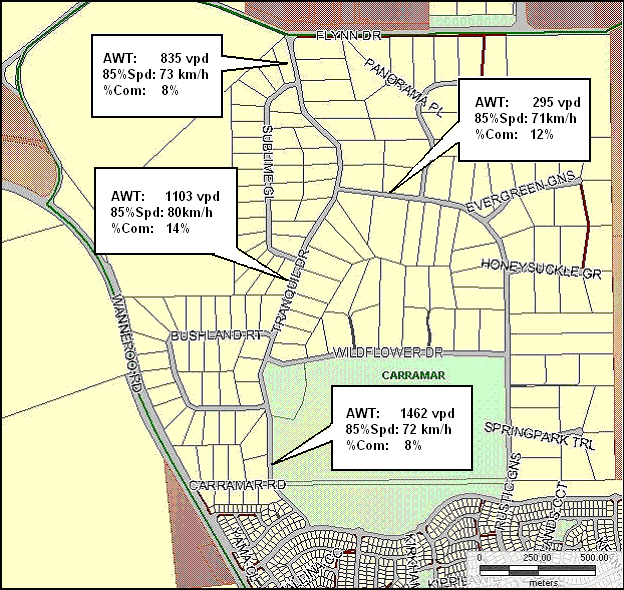
Carramar Special
Rural Precinct - Traffic Data
CITY OF WANNEROO Agenda OF Ordinary Council Meeting 05
April, 2011 247

Carramar Special
Rural Precinct – AM Origin/Destination Traffic Study

Carramar Special
Rural Precinct – PM Origin/Destination Traffic Study
CITY OF WANNEROO Agenda OF Ordinary Council Meeting 05
April, 2011 249
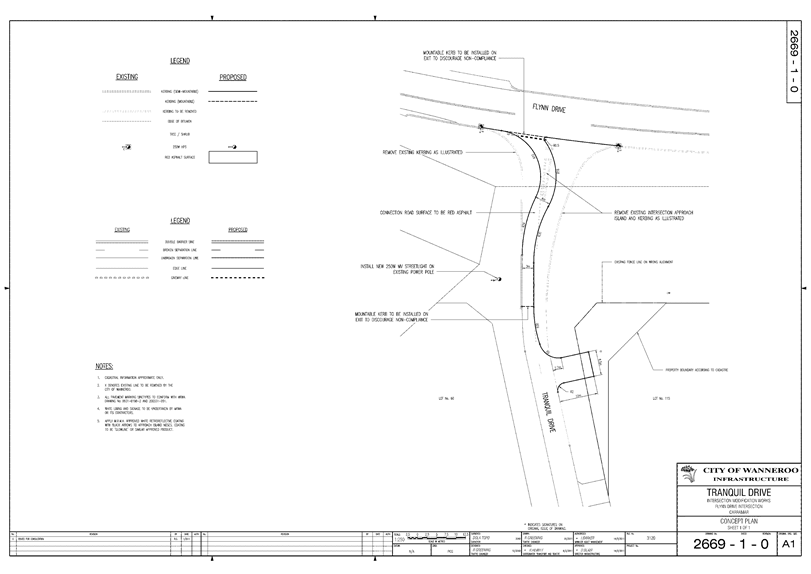
CITY OF WANNEROO Agenda OF Ordinary Council Meeting 05
April, 2011 250
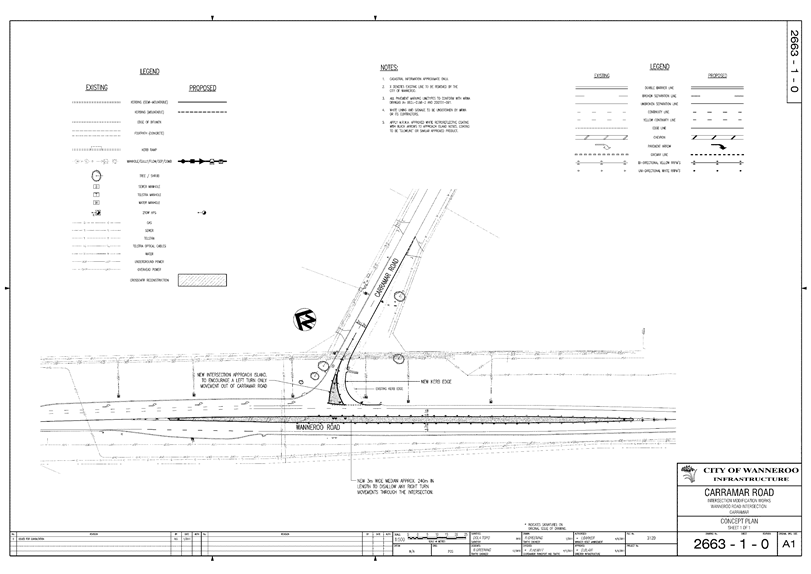
CITY OF WANNEROO Agenda OF Ordinary Council Meeting 05
April, 2011 251
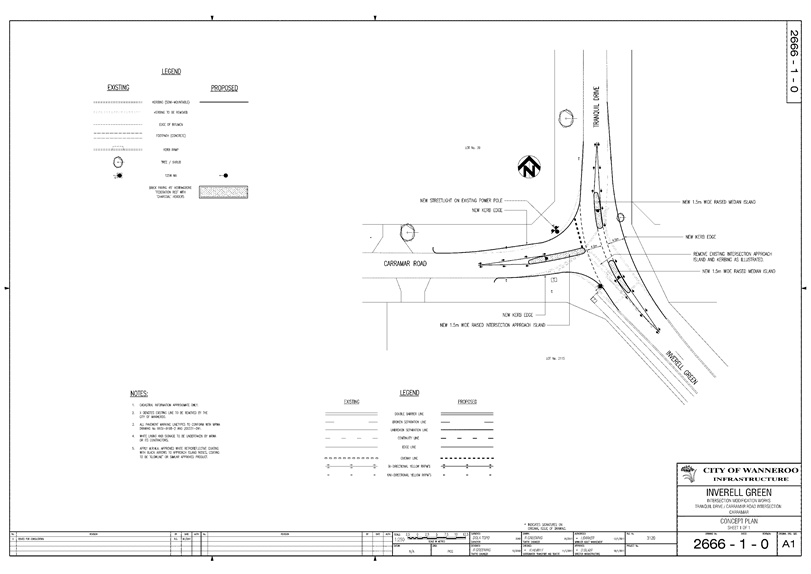
CITY OF WANNEROO Agenda OF Ordinary Council Meeting 05
April, 2011 252

IN07-04/11 Review
of the Use of Rubber Speed Humps
File Ref: 3120
– 11/22305
Responsible
Officer: Director, Infrastructure
Disclosure
of Interest: Nil
Attachments: Nil
Issue
To consider the use of rubber speed humps within the City of
Wanneroo.
Background
When ratepayers report incidents of speeding or
‘hooning’, the majority solution requested is the installation of
speed humps. The City has resisted these requests in the past and sought other
solutions to these driver behaviour issues.
However, in 2008 the State Government initiated the Anti
Hoon Speed Humps Program to trial the use of rubber speed cushions
(RSC’s) as a method of reducing the incidence of antisocial driver
behaviour. Under the program the City has been successful in obtaining
funding for two projects: Burnett Drive, Clarkson and Rosslare Promenade,
Mindarie. In addition the City has funded the installation of the RSC’s
in Alexandria View, Mindarie, which did not qualify for funding under the
scheme.
There is therefore a need for the City to develop a
consistent position on the use of speed humps and other vertical displacement
devices.
Detail
Historically the City of Wanneroo has not promoted the use
of speed humps or vertical displacement devices as remedial traffic treatments
to combat speeding and ‘hooning’. The City’s resistance
to the use of these devices being based on the experience of other local
authorities and known disadvantages, such as:
· Impact on adjacent
residents due to noise as vehicles decelerate/accelerate and trade vehicle
cargoes are displaced.
· Impact on
ambulance passengers.
· Impact on bus
passenger comfort, which reduces the attraction of public transport.
However, speed plateaux and intersection plateaux are now
being more frequently designed into new suburbs to create low speed
‘Liveable Neighbourhoods’ and the City itself has used them on
Ocean Drive, Quinns Rocks, to create a more pedestrian friendly beach precinct.
In addition, it is proposed to provide a speed plateau, incorporating a
pedestrian crossing in Dundebar Road between Rocca Way and Yagan Place.
Additionally, in 2008 the State Government initiated the
Anti Hoon Speed Humps Program to trial the use of RSC’S as a method of
reducing the incidence of antisocial driver behaviour.
Main Roads WA is also trialling the use of RSC’s,
along with variable speed zoning along Fitzgerald Street, North Perth, to
create a 40km/h speed zone on a major bus route and subject to higher traffic
volumes.
Consultation
Nil
Comment
Traditional traffic management treatments as listed below,
were developed as methods of retrofitting existing suburbs to change their
character from one where vehicles dominated, to one more friendly to
pedestrians and cyclists. They reduced vehicle speed and delays by
introducing either horizontal or vertical displacement, or by altering the road
environment:
· Roundabouts
(horizontal displacement)
· Blister
islands (horizontal displacement)
· Chicanes
(horizontal displacement)
· Speed
plateau (vertical displacement)
· Speed
humps (vertical displacement)
· Narrow
lane widths (road environment)
· Entry
Statements (road environment)
· Modified
‘T’ intersections (road environment)
· Partial
and full road closures (road environment)
· Driveway
links (road environment)
The City’s newer suburbs developed under the
‘Liveable Neighbourhoods’ Planning Philosophy are having traffic
management designed into the subdivision through short road lengths and narrow
road widths. In this environment, along with the narrow lot frontages and
frequent crossovers, it is likely that retrofitting of most of the above listed
treatments other than the vertical displacement devices would not be
achievable.
Among the available vertical displacement devices
RSC’s are considered to have the following advantages over traditional
speed humps/plateaux:
· Road
drainage is unaffected, reducing cost.
· Speed
Cushion width can be chosen to reduce impact on emergency vehicles, public
transport and commercial vehicles. Where narrow profile RSC’s are
used, the majority of service vehicles can straddle them with little
impact. However, the need to carefully align the vehicle with each speed
cushion results in a lowering of traffic speeds.
· Portability
allows for temporary installation and relocation.
In a recent review of the RSC’s installed on Burnett
Drive, Clarkson, the following results were achieved:
· The
number of vehicles on Burnett Drive, south of McPherson Avenue, exceeding the
50km/h speed limit reduced from 67.5% to 9.7% and the 85% percentile speed
reduced from 61.2km/h to 47.5km/h.
· Similarly,
for vehicles north of McPherson Avenue, the number of vehicles exceeding the
50km/h speed limit reduced from 62.5% to 3.2% and the 85% percentile speed
reduced from 59.4km/h to 40km/h.
In light of these results, and the growing public acceptance
of the RSC’s as a traffic treatment, Administration considers that the
City can make greater use of them, either in combination with other treatments
or as stand alone devices. However, to reduce the chance of noise
complaints from residents requesting the removal of the RSC’s after
installation they should only be used after community consultation and
agreement from the residents that they will not be removed for a period of
three years.
Statutory
Compliance
Nil
Strategic
Implications
The proposal accords with the following Outcome Objective of
the City’s Strategic Plan 2006 – 2021:
“2 Social
2.4 Improve
community safety”
Policy
Implications
RSC’s will be considered as a valid treatment for
sites qualifying for traffic management under the City’s Traffic Management
Investigation and Implementation Policy.
Financial
Implications
A typical single installation of a RSC in each lane of a
standard residential road costs $6,000, however costs will increase if street
lighting improvements are required to illuminate the cushions.
Voting
Requirements
Simple Majority
Recommendation
That Council:-
1. ENDORSE
the use of rubber speed cushions as an acceptable traffic management
treatment; and
2. NOTE
that rubber speed cushions will be installed in accordance with the guidelines
used by the Anti Hoon Speed Humps Program and at sites which qualify for
traffic management under the City’s Traffic Management Investigation and
Implementation Policy.
Community Development
Capacity Building
CD01-04/11 Reconciliation
Action Plan Working Group: Amendment to Terms of Reference
File Ref: 4094
– 11/22410
Responsible
Officer: Director, Community Development
Disclosure
of Interest: Nil
Attachments: 1
Issue
To consider a change to the Terms of Reference for the
Reconciliation Action Plan (RAP) Working Group.
Background
The Department of Local Government and Regional Development
(DLGRD) and Department for Indigenous Affairs (DIA) have encouraged all local
governments to develop a Reconciliation Action Plan (RAP), which will address
some of the inequities facing Aboriginal and Torres Strait Islander (ATSI)
people. This is in accordance with the Council of Australian Governments (COAG)
“Closing the Gap” focus.
At its meeting of 1 June 2010 (CDO1-06/10), Council endorsed
the development of a Reconciliation Action Plan (RAP) 2010-2012.
At its meeting of 27 July 2010 (CDO1-07/10), Council
endorsed the Terms of Reference for the RAP Working Group, as one of the key
strategies for achieving the RAP.
Detail
It has been proposed that the City of Wanneroo develop a RAP
for the period 2010-2012 through a consultation process that engages the wider
ATSI population in Wanneroo. This is to be achieved through the development of
a RAP Working Group comprising ATSI people, staff and key stakeholders as well
as Elected Members. Once the RAP 2010-2012 is endorsed, it is recommended that
the RAP Working Group continues to annually report on the progress of the Plan,
and build strong community relationships between the City and the ATSI community.
The overarching aim for the City is to keep the RAP goals
for the next two years simple and achievable. The RAP should be a growing and
developing process as the RAP Working Group continuously examines and evaluates
the success of strategies. In this way the next RAP becomes a stronger and more
focussed document with a strong and genuine sense of engagement and ownership
by the ATSI community and the City of Wanneroo.
An oversight in development of the City of Wanneroo adopted
Terms of Reference for the RAP Working Group is the omission of
“Aboriginal and Torres Strait Islander” community in the document,
which currently only refers to “Aboriginal” community.
As part of its charter to encourage the development of RAPs
throughout all spheres of public, commercial and community sectors, it is a
requirement by Reconciliation Australia (RA) that both Aboriginal and Torres
Strait Islanders have opportunities to be involved in the RAP development. Once
the City of Wanneroo’s RAP is developed, RA will scrutinise it for
compliance with its requirements and then endorse it publicly.
Comment
The amended Terms of Reference (Attachment 1)
reflects the replacement of “Aboriginal” community with
“Aboriginal and Torres Strait Islander” community in the document.
Recent changes recommended by EMT in the City’s Terms of Reference for
Committees and Working Groups of Council are also reflected in this document.
In 2010, progress of the City’s RAP Project was
slightly delayed through staff changes, which have now been resolved. A
recent process of informal consultation and networking throughout the community
has indicated the need to conduct a series of locally-based community
gatherings, (possibly known as “Yarning Circles”) which allow
informal listening, talking and questioning as part of a process of encouraging
community leaders to step forward and consider nomination for the RAP Working
Group. These are planned to occur in and around Reconciliation Week which runs
from 30 May – 3 June 2011.
Elected Members have already been appointed to the Working
Group at the July 2010 Council meeting. Staff will also be canvassed for their
interest in the RAP Working Group, whether or not they are of ATSI
descent. RAP Working Group nominations will then go through a process of
endorsement by Council at its June 2011 meeting, with formal announcements of
membership further promoted at a NAIDOC celebration event in Wanneroo in the
period 3 July -10 July 2011.
The RAP Working Group will seek to develop draft short-term
and long-term goals to reflect the Relationships, Respect and Opportunities
pillars of the City’s RAP. It is anticipated that this process may take
some months to develop and refine these goals with a likely delivery date for a
first draft of the RAP towards the end of 2011. Depending on changes required
for final adoption by Council as well as allowing for a period of public
comment, the City’s RAP may be ready for endorsement by Reconciliation
Australia in April 2012.
Strategic
Implications
The proposal accords with the following Outcome Objective of
the City’s Strategic Plan 2006 – 2021:
“2 Social
2.3 Improve
the capacity of local communities to support each other”
“4 Governance
4.2 Improve
community engagement.”
Financial
Implications
Nil
Voting
Requirements
Simple Majority
Recommendation
That Council:-
1. ENDORSES
the amendment to the Terms of Reference for the Reconciliation Action Plan
2010-2012 Working Group through replacement of the term
“Aboriginal” community with “Aboriginal and Torres Strait
Islanders” community; and
2. NOTES
the consultation process proposed to occur around NAIDOC Week in May/June 2011.
CITY OF WANNEROO Agenda
OF Ordinary Council Meeting 05 April, 2011 259

TERMS OF REFERENCE
Reconciliation Action Plan 2010-2012 Working Group
|
Name:
|
Reconciliation Action Plan 2010-2012 Working Group (the
RAP Working Group)
|
|
Role/Purpose:
|
To develop draft goals to reflect
the Relationships, Respect and Opportunities pillars of the City’s
Reconciliation Action Plan (RAP) with the aim of long-term and genuine
engagement with the Aboriginal and Torres Strait Islander community in
Wanneroo.
|
|
Aims & Functions:
|
The Working Group will:
1.1 Recommend
to Council no less than two short term and two long-term goals for each of
the three pillars of the RAP 2010-2012, being Relationships, Respect and
Opportunities.
1.2 Broadly
consult and communicate the views of the wider Aboriginal and Torres Strait
Islander community in Wanneroo on the proposed goals as part of the RAP
consultation and engagement process.
1.3 To the
best of its ability, ensure objectivity and the best interests of the broader
Aboriginal and Torres Strait Islander community in Wanneroo during Working
Group discussions.
1.4 Assist
Council to identify any issues affecting Aboriginal and Torres Strait
Islander community and culture where and when appropriate and the development
of strategies relating to these issues.
|
|
Membership:
|
2.1 The
Working Group shall consist of the following representation:
· Up to two
Elected Members appointed by Council;
· Council Officers
(Coordinator Community Links; Community Development Officer, Aboriginal and
Torres Strait Islander staff persons); plus
· A maximum of ten
representatives, preferably Aboriginal and Torres Strait Islander community
leaders and including, where possible, Aboriginal and Torres Strait Islander
youth.
2.2 Membership
shall be for a period of up to two years terminating on the day of the
Ordinary Council elections, with retiring members eligible to re-apply.
2.3 Members
must comply with the City’s Code of Conduct.
2.4 The
Working Group has authority to second individuals from outside of the Working
Group, on a voluntary basis, for their expert advice.
2.5 Consideration will not be given
to any nomination received from a person who is currently serving as an
elected member of a neighbouring council.
|
|
Operating procedures:
|
3.1 Chairperson:
a) The
members of a Working Group are to elect a Chairperson and Deputy
Chairperson from amongst themselves at the first meeting
of the Group.
b) The
Chairperson will preside at all meetings.
c) In
the absence of the Chairperson, the Deputy Chairperson will assume the chair,
and in their absence, a person is to be elected by the Working Group members
present to assume the Chair.
d) The
Chairperson is responsible for the proper conduct of the Working Group.
3.2 Meetings:
a) The
Working Group shall meet on a regular basis as determined by the nominated
Group members.
b) All
meeting dates are to be provided in Elected Members’ Clipboard and in
the City of Wanneroo diary.
c) A
Notice of Meetings including an agenda will be circulated to the Working
Group members at least 72 hours prior to each meeting where possible.
d) The
Chairperson shall ensure that minutes of all meetings are kept and that
copies are made available to all Working Group members (including deputy delegates)
as soon as is practicable after the meeting. The minutes are to be
available for public inspection.
e) Copies
of all agendas and minutes are to be forwarded electronically through to
Governance for filing in the Elected Members’ Reading Room.
f) All
agenda and minute documentation is to be generated through Council’s
InfoCouncil software reporting system.
g) A
Working Group outcome or recommendation will have effect if it is supported
by general consensus of the meeting, or through a vote made by simple
majority. A simple majority is the agreement of not less
than half of the votes present at the meeting.
h) In
the event that a vote is taken, all endorsed members of the Working Group
will have one vote. The Chairperson will have the casting vote and a
simple majority will prevail.
3.3 Quorum:
A
meeting can be conducted without a quorum if necessary, however, every
endeavour should be made to achieve a quorum or at least to ensure a
reasonable spread of representation, particularly in circumstances where
recommendations will be made for Council’s consideration.
3.4 Administration:
Administration
support for the Working Group will be provided by the City of Wanneroo.
That support person will be Coordinator
Community Links or a designated member of the Community Links Team.
|
|
Delegated Authority:
|
4.1 The
Working Group has no delegated power and has no authority to implement its
recommendations without approval of Council.
4.2 The
Working Group has no delegated authority to commit Council to the expenditure
of monies.
4.3 Matters
requiring Council consideration will be subject to separate specific reports
to Council.
|
Program Services
CD02-04/11 Concept
Plan for the Development of Keith Griffith Park
File Ref: 4454
– 11/28337
Responsible
Officer: Director, Community Development
Disclosure
of Interest: Nil
Attachments: 3
Issue
To consider the proposed concept plan for the development of
Keith Griffith Park, Darch.
Background
Keith Griffith Park is located on 6 Keith Griffith Drive,
Darch and is a 0.44 ha undeveloped area of public open space. There are
currently no existing amenities on site and the park is of a poor standard
overall.
Historically there have been a number of community requests
for the standard of Keith Griffith Park to be upgraded to improve functionality
for local residents. This has generally involved a call for the park to be
irrigated and for installation of passive park amenities. This has resulted in
the Keith Griffith Park upgrade project being included in the City’s
10-year Capital works program for 2010/11.
Detail
The Keith Griffith draft concept plan (Attachment 1)
includes a number of core passive park elements and incorporates nature play
themes in various areas of the park.
The concept plan offers options for the development of the park in a single
stage within the budget currently allocated in the City’s Capital Works
program 2010/11, and includes options for the following amenities:
· Double
swing with toddler seat and child’s strap seat;
· Disc
swing;
· Bench
seats with backs;
· Bench
seat (no back);
· Bench
seat;
· Pedestal
picnic table with bench; and
· Nature
activity spaces.
Consultation
The City’s Community Consultation Review Panel
endorsed a consultation strategy in October 2010 which included:
· Distribution
of the draft concept plan and public comment form to all residents within a 400
metre radius of Keith Griffith Park;
· Displays
at the City of Wanneroo Civic Centre;
· Inclusion
of information and comment opportunity on the City’s website via
‘Your Say’; and
· An
onsite community meeting on Monday 6, December 2010 to give local residents the
opportunity to discuss the concept plan with Administration.
The draft concept plan was released for public comment for a
period of 25 days from Friday 19 November to Friday 17 December 2010 inclusive.
A total of 54 public comment forms were received during this period, with 52
respondents supporting the draft concept plan (96%) and 2 respondents (4%)
opposing the park development in its proposed format.
Of the 96% positive responses, the majority were generally
supportive of the concept plan as presented. Whilst happy with the concept plan
a number of potential amenities requests for the inclusion of soccer goals or a
3 on 3 basketball pad, were suggested.
Four percent of responses received expressed concern over
the lack of a substantial irrigated area within the park and the possibility of
installing park amenities such as a gazebo and BBQ facilities.
Please refer to (Attachment 2) for public comment
responses.
Comment
Some requests have been received for the inclusion of BBQs,
a gazebo, 3 on 3 basket ball pad, soccer and/or rugby goals into the concept
plan. Due to budget constraints only a 3 on 3 basketball pad has been added at
this stage.
In relation to requests to increase the proposed irrigated
area, early investigations concluded that it was not possible to deliver this
request based on the advice from the Department of Water relating to water
restrictions. The City, since the completion of the consultation period,
has learnt from the Department of Water that the Whitfords Sub area has not
reached its abstraction limit.
Administration has applied for both a bore and water
allocation license for Keith Griffith Park. Both submissions have been
successful allowing the City to legally draw water for the irrigation of Keith
Griffith. Attachment 3 also explains the Department of Water ruling that
whilst the Keith Griffith allocation has increased, the City’s allocation
in the Whitfords Sub area has not. The Department of Water encourages water
efficiency by the City where possible.
At the residents request the city has increased the
irrigated area of the Keith Griffith Concept plan. The increase in irrigated
area has been made in keeping in line with the City’s water conservation
principles and the consequences for existing native trees if too much water is
introduced to their root systems.
The development of Keith Griffith Park in accordance with
the proposed Concept Plan will provide valuable amenity for local residents and
ensure a balance between meeting community needs and expectations, and the
City’s responsibility towards the environment. It is therefore
recommended that Council endorse the Keith Griffith Park Concept Plan and
resolve to proceed with detailed design and development works.
Statutory
Compliance
Nil
Strategic
Implications
The proposal accords with the following Outcome Objective of
the City’s Strategic Plan 2006 – 2021:
“1 Environment
1.4 Improve
the quality of the built environment”
“2
Social
2.1 Increase
choice and quality of neighbourhood and lifestyle options.
2.2 Improve
the City’s identity and community well-being through arts, culture, leisure
and recreation.”
Policy
Implications
Nil
Financial
Implications
A total of $170,000 has been allocated for the upgrade of
Keith Griffith Park (project No. PR-4454) for the 2010/11 financial year. A
further 60,000 has been listed for consideration in the 2011/12 financial year
capital works program to include bore and irrigation costs.
Works conducted will be in accordance with the construction
cost estimate, including contingencies and project management charges. To
develop the park based on the Concept Plan sufficient funds for the full scope
of works will be available subject to 2011/12 funding approval.
Voting
Requirements
Simple Majority
Recommendation
That Council:-
1. ENDORSES
the Keith Griffith Park Upgrade Concept plan as presented in Attachment 1; and
2. NOTES
that the estimated costs in 1. above have been listed for consideration in the
City’s 10 Year Works Capital Program.
CITY OF WANNEROO Agenda
OF Ordinary Council Meeting 05 April, 2011 265
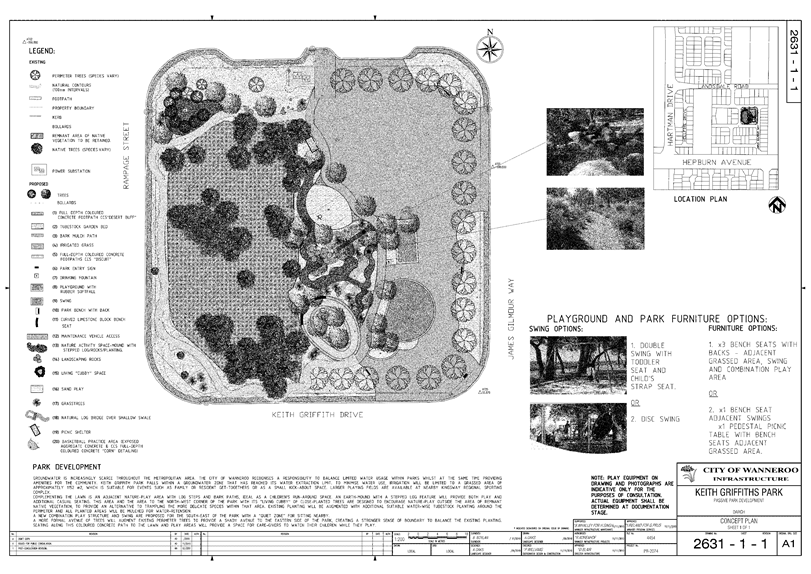
CITY OF WANNEROO Agenda OF Ordinary Council Meeting 05
April, 2011 266
PUBLIC COMMENT RESPONSES
KEITH GRIFFITH
PARK – CONCEPT PLAN
Do you support the
development of Keith Griffith Park, Wanneroo as proposed by the Concept Plan?
Yes 52 (96%)
No 2 (4%)
Total 54
If no, could you please
outline the reason why?
|
Would get more usage if
the park area was half grass and had a more central gazebo-BBQ area. A path
that accounts for wheeled sports
|
|
Would prefer space for
sport and BBQ. Gazebo would also add to the park. No children facility
|
The seating plan for the
upgrade of Keith Griffith Park can be delivered in 4 options they are as
follows:
|
Option 1
|
Option 2
|
|
1x Double Swing with toddler seat and child’s strap seat
3x Bench seats with backs – adjacent grassed area, Swing
and combination play area
|
1x Disc Swing (see concept plan)
1x bench seats adjacent swings
1x pedestal picnic table with bench seats adjacent grassed area
|
|
Option 3
|
Option 4
|
|
1x Double Swing with toddler seat and child’s strap seat
1x bench seats adjacent swings
1x pedestal picnic table with bench seats adjacent grassed area
|
1x Disc Swing (see concept plan)
3x Bench seats with backs – adjacent grassed area, Swing
and combination play area
|
|
Option 1
|
Option 2
|
Option 3
|
No Preference
|
|
42 %
(22 Reponses)
|
12%
(6 Reponses)
|
33%
(17 Responses)
|
13 %
(7 Responses)
|
Which of the suggested 3
options do you think you and your family would most utilise?
|
Option 1 – Swing
for my nieces and nephews
|
|
Option 1- combination
play area creates and promotes motor skill development
|
|
Option 1- as not
really a great place for picnics would prefer to be a play option for
recreation”
|
Are there any further
comments you wish to make in regard to the Keith Griffith Park Concept Plan?
|
“Cleaning up of
the native plantation along rampage st side of the park to minimise children
getting bitten by spiders”
|
|
“I think it will
be great and well used, there are lots of little kids in the area”
|
|
“a large
playground would be beneficial as there are a lot of children in the area and
not many decent playgrounds”
|
|
“plant as many
trees as possible, trees make people happy, Highly appreciate your
development ”
|
|
“no skatepark or
lighting to attract bad elements please”
|
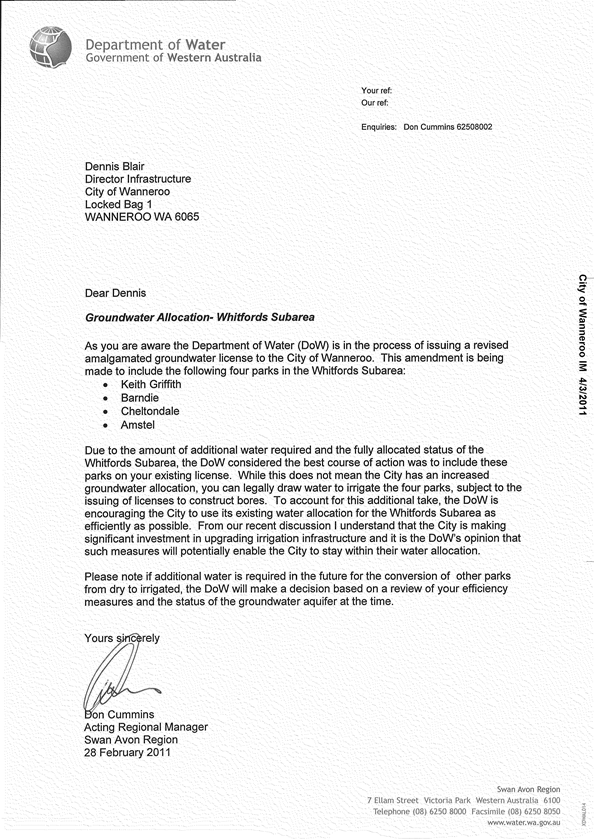
CD03-04/11 Kingsway
Masterplan Review
File Ref: 4172
– 11/27675
Responsible
Officer: Director, Community Development
Disclosure
of Interest: Nil
Attachments: 2
Issue
To consider the Kingsway Regional Sporting Complex
Masterplan Review by Consultant CCS Strategy.
Background
In October 2010, the City of Wanneroo commissioned CCS
Strategic to undertake a review of the Kingsway Redevelopment Masterplan of
2006 and prepare a new Masterplan. This new plan reflects a range of amendments
and adjustments necessary and desirable by both the City of Wanneroo and the
resident clubs and other user groups to continue the redevelopment program.
Detail
Stage 4 of the Masterplan identified in the 2006 review,
involving redevelopment of the facilities primarily used by Olympic Kingsway
Sports Club and Wanneroo Districts Rugby Union Club, was underway at the time
of this review.
The intent of the study was to ensure all areas within the
reserve are included in the review.
The report outlines the principal needs expressed by the
clubs at the broader or generic level which can be summarised as follows:
· As
a priority, ensure the playing surfaces (match and training) are presented and
maintained in the best possible condition. It’s already good but the
standard of presentation needs to be maintained;
· Provide
additional parking facilities throughout the reserve noting the congestion on
Saturday mornings when junior sports - netball, football, soccer and rugby are
all in full flight;
· Name
and clearly label the roadways to allow emergency vehicles (and others) to be
guided through internal roads to clubhouses or playing fields;
· Design
the road layout, road perimeters and vehicle access points to not only
discourage but physically prevent cars getting onto playing surfaces and
causing damage – pine bollards have proven to be ineffective especially
around the rugby fields;
· The
proposed playgrounds – regional installation and satellite sites are
welcomed by both ground users and nearby residents. Interconnecting pathways
and access to toilet facilities need to be considered for use by local
residents’ at times sporting clubs are not present;
· As
demand increases and it becomes more difficult to accommodate all users as they
would like to be accommodated, establish a priority access policy that services
local clubs before more distant clubs and clubs that both train and compete at
the venue in preference to those that train only or play only.
In terms of particular changes to the previous masterplan
the report recommends three major variations:
· The
first is the creation of a multipurpose playing field to the east of Kingsway
Oval and to the north of the baseball facility. This playing field is to
accommodate diamond sports as previously shown and also allow for the
development of a second oval space for use by little athletics (field events)
and football. Whilst the development of this oval space is somewhat predicated
on the potential establishment of a major sport elite training and
administration centre to the south of Kingsway Oval, the level of use of the
existing oval is reaching (or perhaps already at) capacity and additional
accommodation for these activities is the most pressing.
· The
second is the introduction of a bowling facility to sit adjacent to the
Kingsway Sports Club building. Current indications are that a 6 rink synthetic
green can be accommodated in this location without impacting on other ground
users. Subsequent building modifications to embrace this new facility and
service its patrons would follow.
· The
third is a reconfiguration of the British Soccer fields (Wanneroo City Soccer)
to create 3 playing fields running north-south on a newly formed (cut and fill)
upper level including a home ground field closest to the clubhouse. The two
fields running east-west on a lower level at the Bellerive Boulevard end are to
remain with only minor works to remove a slight elevation in the north eastern
corner. Lighting to AS2560 for training purposes is to be provided across the
entire area with the Club provided the opportunity to upgrade lighting on the
main pitch for competition purposes.
Consultation
During late 2010 and early 2011 CCS Strategic held a series
of one-on-one meetings with the existing clubs and proposed users of the
reserve and also conducted an open community workshop with both club
representatives and nearby residents in attendance.
Comment
The literature review and demographic analysis carried out
by CCS Strategic indicated that Kingsway will remain under considerable local
growth pressure for the next decade. In conjunction with its regional role the
precinct will need to accommodate greater local and district level activity as
the suburbs in immediate proximity to Kingsway reach maturity. It is
important that this role is balanced with the growing needs for regional and
district level facilities elsewhere in the City of Wanneroo, including Butler
North, Yanchep and Two Rocks. There will competing demands for the
City’s scarce financial and other resources in order to deliver
facilities and playing fields for a rapidly growing population. The City has
been actively engaging the State government with regard to this matter.
The revised Kingsway Regional Sporting Complex Masterplan
provides the City with a clear direction in which the development of the this
key regional facility will support the sporting and recreational needs for the
resident clubs as well as the casual and passive recreational requirements of
the surrounding residents.
Building condition reports, undertaken by the City to
determine the status of ten separate structures within the Kingsway Regional
Sports Reserve, have identified additional costs associated with both renewal
and upgrade of these buildings. An allocation of $300,000 has been made
in 2011/12 for rehabilitation of clubrooms to tackle the most urgent of these
items. Further allocations will be required in future years to continue
this work on the principle of renew before new.
The imminent Stages 5 (2011/12) & 6 (2012/13) will
remain consistent with the original Masterplan with minor amendments based on
the input and feedback from clubs and residents. In addition to these
works being carried out, within 2011/12 works will also be carried out to
signpost and name the internal roads within the reserve and provide protection
to the Soccer North and Rugby areas to prevent unauthorized vehicular access to
the playing surfaces. Additional patrols of the area and re-keying of gates are
considered important strategies in preventing antisocial behaviour and
vandalism at these locations.
Statutory
Compliance
Nil
Strategic
Implications
The proposal accords with the following Outcome Objective of
the City’s Strategic Plan 2006 – 2021:
“2 Social
2.2 Improve
the City’s identity and community well-being through arts, culture,
leisure and recreation”
Policy
Implications
Nil
Financial
Implications
The consultant has identified the potential financial
implications of this study, which are subject to Council’s budget
deliberations. Many of the items proposed are already included in the
City’s 10 Year Capital Works Program, but there will be additional funds
required – particularly in response to development of an additional
football oval and creation of bowling facilities.
The program of works as described in the Masterplan has been
broken into 6 internal zones and a further zone addressing the overall site and
site perimeter (Zone 1). The cost of development using January 2011 costs is
shown below.
|
Area cost
|
$
|
|
Item 1 - Overall Site and Site Perimeter
|
1,556,100
|
|
Item 2 – Hockey/Cricket Zone
|
770,600
|
|
Item 3 - Netball and Air Training Corp Zone
|
851,163
|
|
Item 4 - Kingsway Sporting Club Zone
|
3,728,222
|
|
Item 5 - Diamond Sports Zone
|
1,521,900
|
|
Item 6 - Wanneroo City Soccer Club Zone
|
2,657,164
|
|
Item 7 - Olympic Kingsway and Rugby Zone
|
2,501,650
|
|
Total all items
|
13,587,799
|
|
Design Contingency - 5%
|
679,390
|
|
Construction Contingency - 10%
|
1,426,719
|
|
Professional Fees/Management Fees - 10%
|
1,569,391
|
|
Total project cost - January 2011
|
17,263,298
|
An implementation strategy has also been developed that has
proposed the works be undertaken over a period of years to 2020 as demand is
confirmed. The cost of implementation has been escalated at the rate of 4% per
annum to produce a cash flow projection of expenditure to be made by the City.
This table does not include costs by others or potential grant income. It shows
the impact of escalation according to the implementation program over the
period to 2019 lifting the total cost from $17,263,298
to $19,683,225.
|
Year
|
Construction cost
|
Total project cost
|
|
2011
|
1,000
|
1,271
|
|
2012
|
2,220,309
|
2,820,902
|
|
2013
|
4,419,737
|
5,615,275
|
|
2014
|
695,841
|
884,066
|
|
2015
|
4,181,806
|
5,558,224
|
|
2016
|
1,737,989
|
2,208,115
|
|
2017
|
777,349
|
987,622
|
|
2018
|
1,043,262
|
1,325,464
|
|
2019
|
222,184
|
282,285
|
|
Total
|
15,299,476
|
19,683,225
|
Within the City’s 10 Year Financial Management Plan
the following resources have been allocated for Kingsway Regional Sporting
Complex and are included within the consultants report.
|
Year
|
Item
|
Budget Allowance
|
|
2011/12
|
Stage 5 – Soccer South
|
3,900,000
|
|
|
Rehabilitation of Clubrooms
|
300,000
|
|
2012/13
|
Baseball Clubrooms Preliminary design
|
75,000
|
|
|
Stage 6 – Baseball Grounds
|
2,700,000
|
|
|
North East Precinct Landscaping
|
100,000
|
|
2013/14
|
Baseball Clubroom Construction
|
750,000
|
|
|
Football Clubrooms Preliminary Design
|
50,000
|
|
2014/15
|
Football Clubrooms Upgrade
|
500,000
|
|
|
|
|
|
|
Total
|
7,625,750
|
The major additional cost to the project is the inclusion of
an additional sporting oval to the east of the current football oval and the
provision of additional changing facilities throughout the reserve to support
the expanding levels of use on the reserve.
The provision of clubroom and changing facilities throughout
the reserve will be subject to grant applications through the Department of
Sport and Recreation’s Community Sports & Recreation Facilities Fund
being successful. Contributions from the resident clubs will be sought as well
in the case of an upgrade to current facilities and possibly their respective
state sporting associations should the facilities be anticipated to support
state level activities.
Voting
Requirements
Simple Majority
Recommendation
That Council: -
1. RECEIVES
the Revised Kingsway Masterplan Report in Attachment 1;
2. NOTES
that the review of the Kingsway Masterplan will require a thorough review of
the commitments in the 10 Year Financial Plan to allow consideration of any
proposed additional works;
3. NOTES
that implementation of works associated with the Masterplan will be subject to
Council’s ongoing budget deliberations; and
4. NOTES
that issues raised within the Masterplan review associated with Stage 5 works,
to commence in 2011, will be taken into consideration during the design and
implementation phases.
CITY OF WANNEROO Agenda
OF Ordinary Council Meeting 05 April, 2011 273
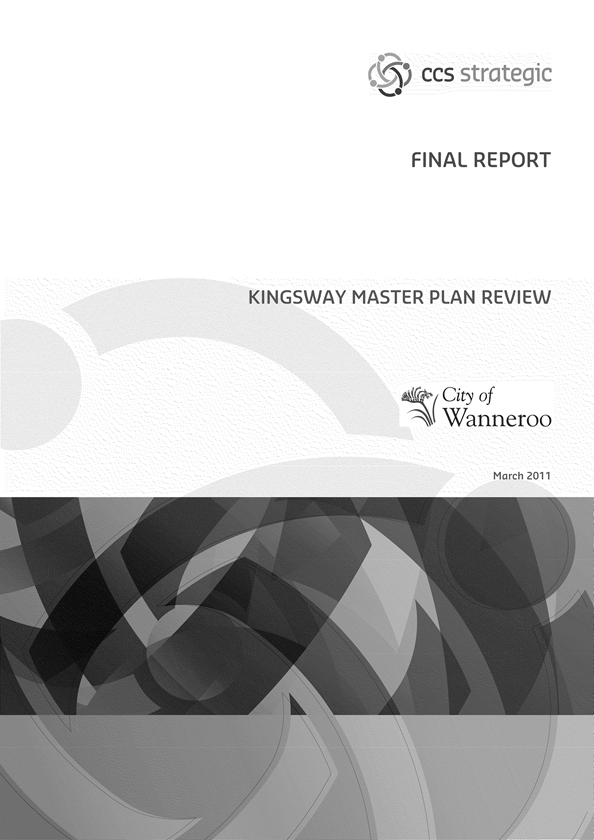
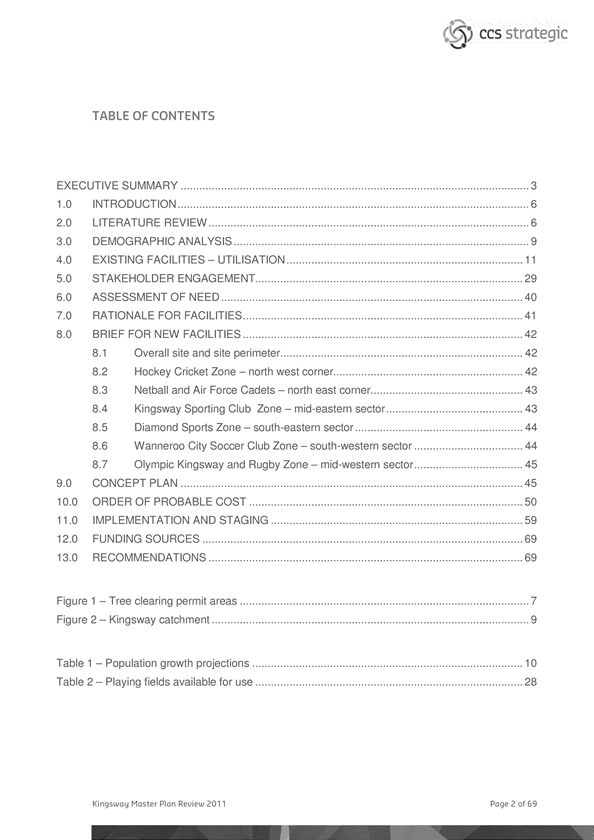
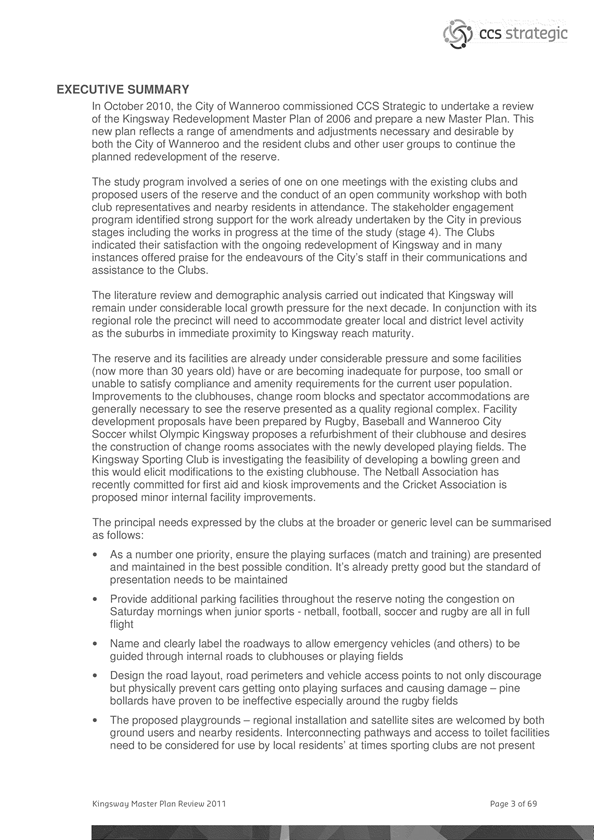
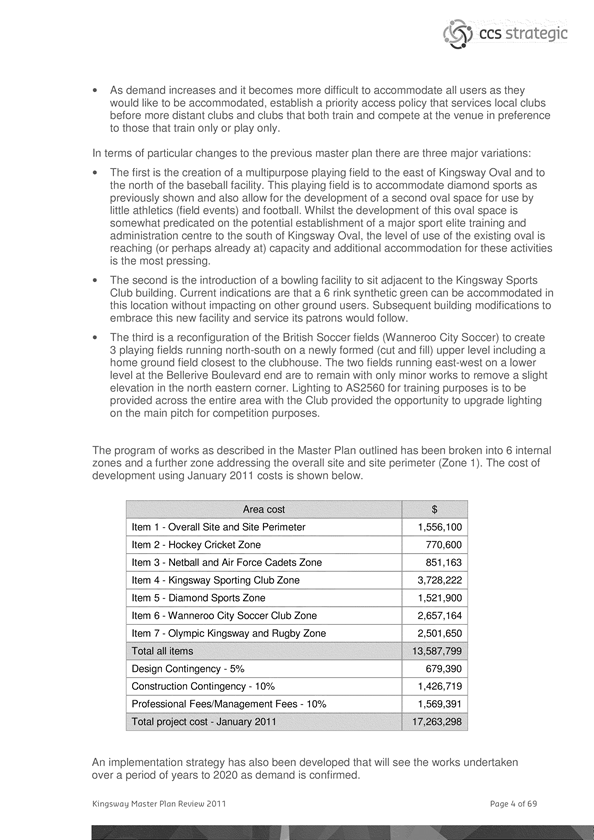
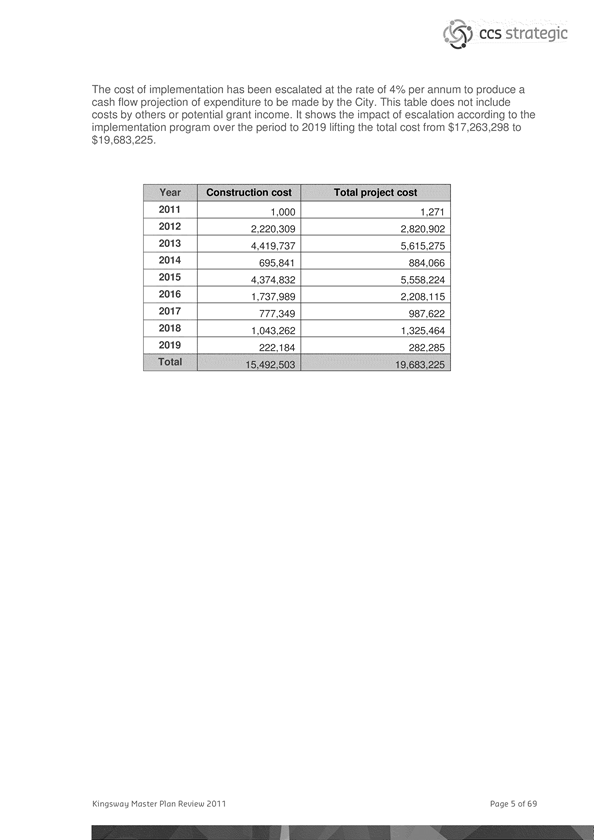



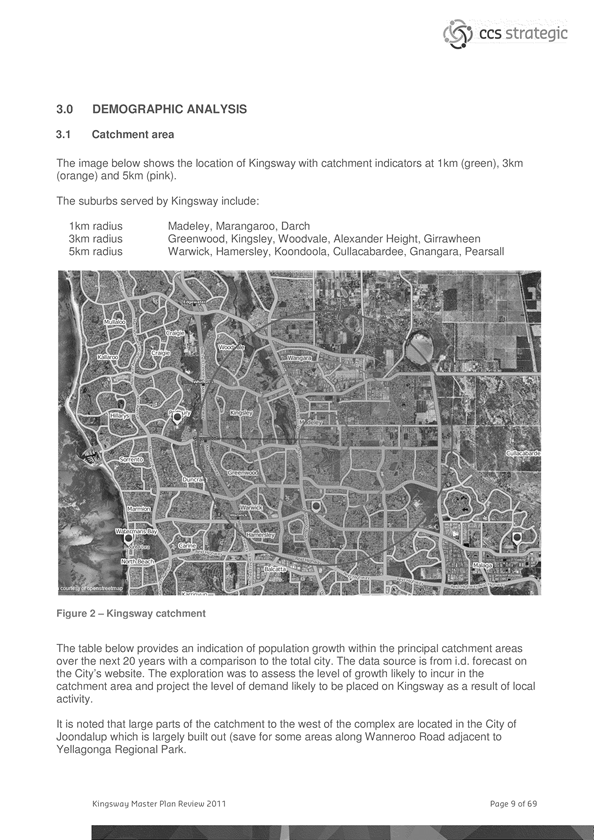

CITY OF WANNEROO Agenda
OF Ordinary Council Meeting 05 April, 2011 283

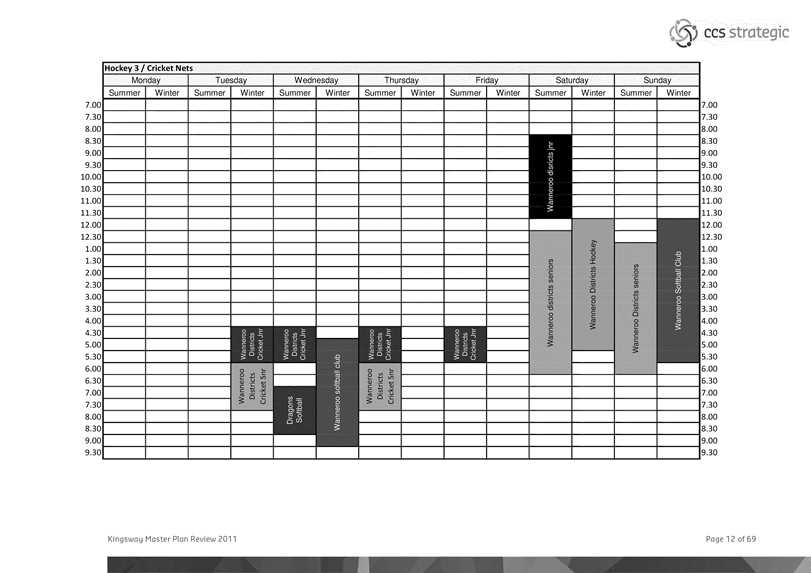
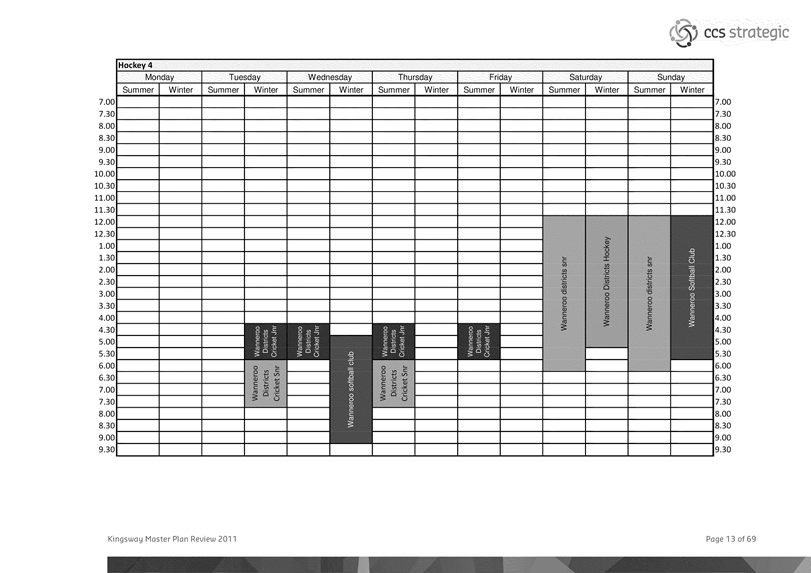
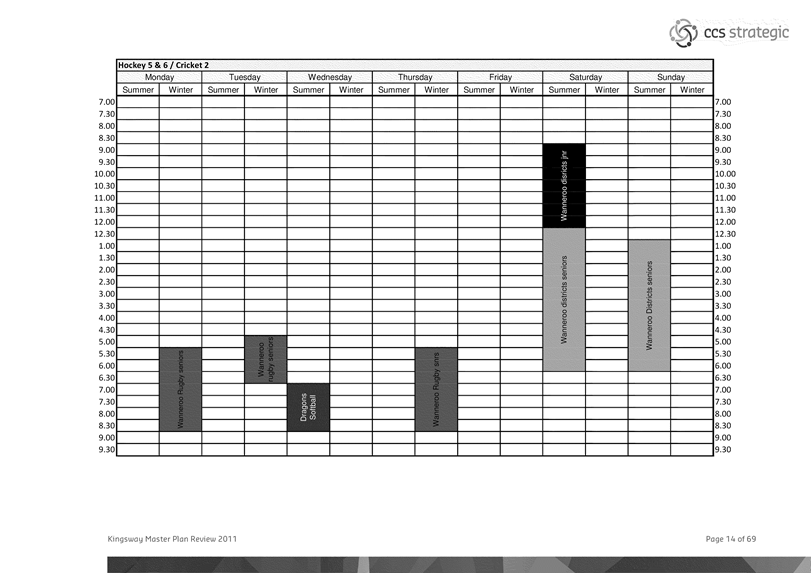

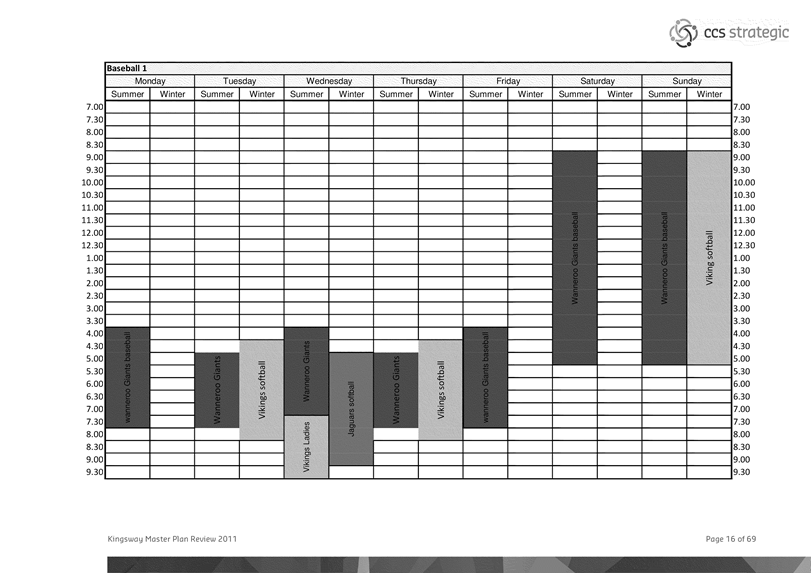
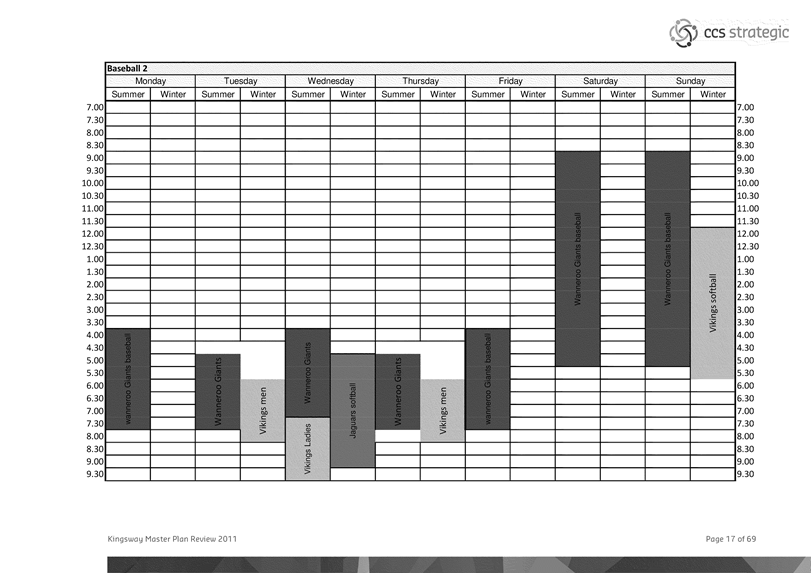
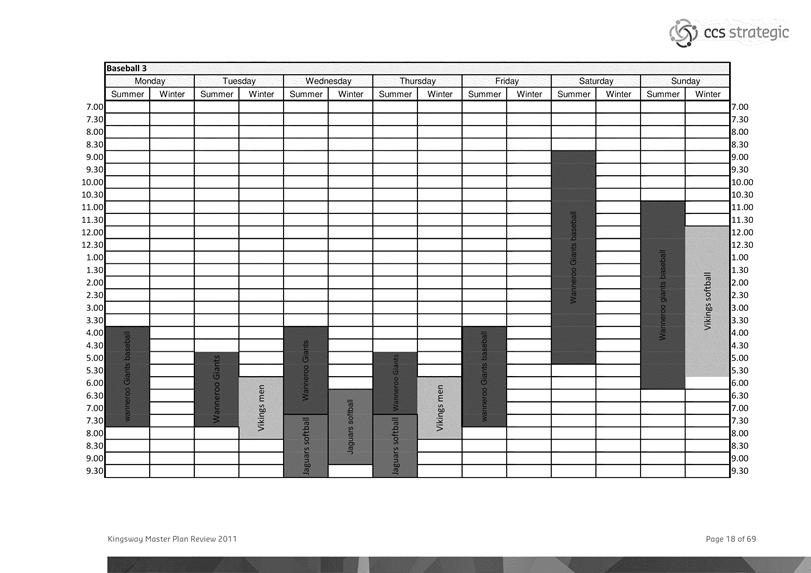

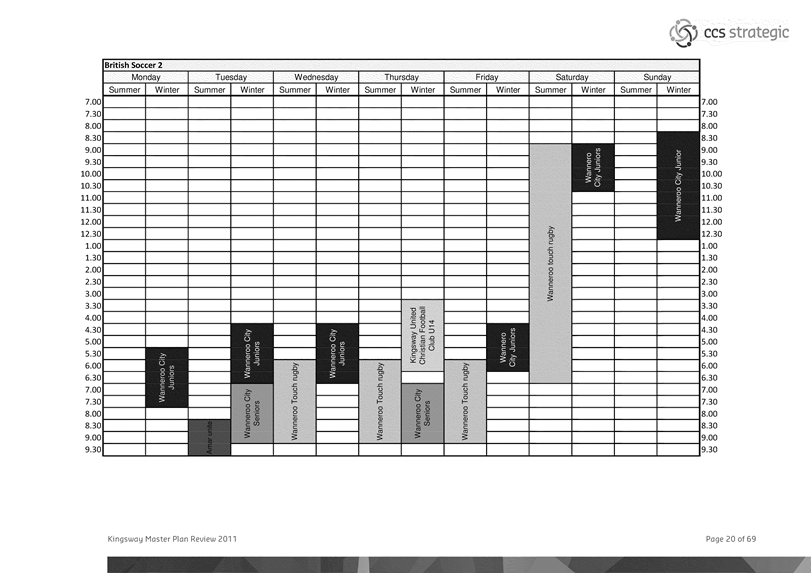
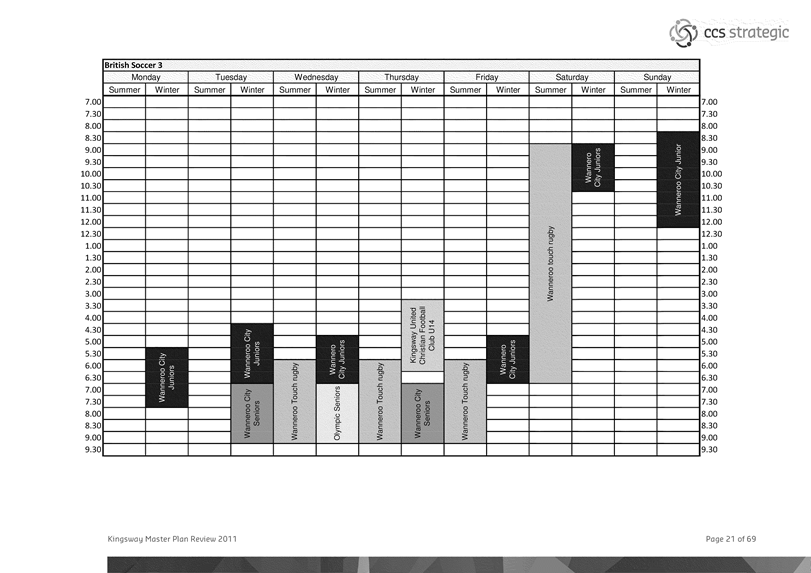
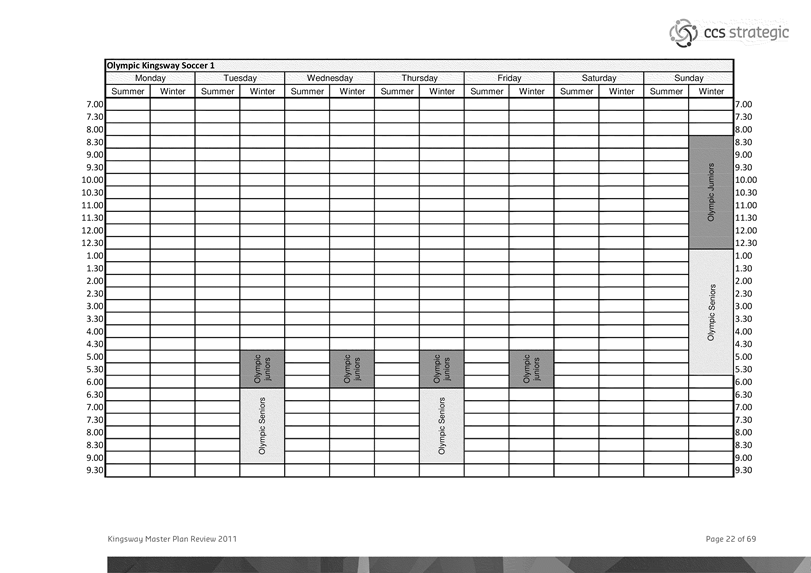

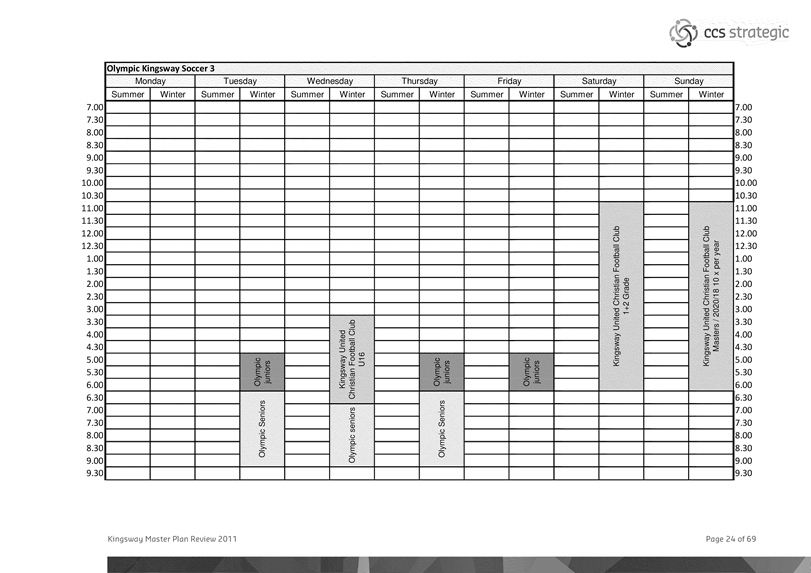

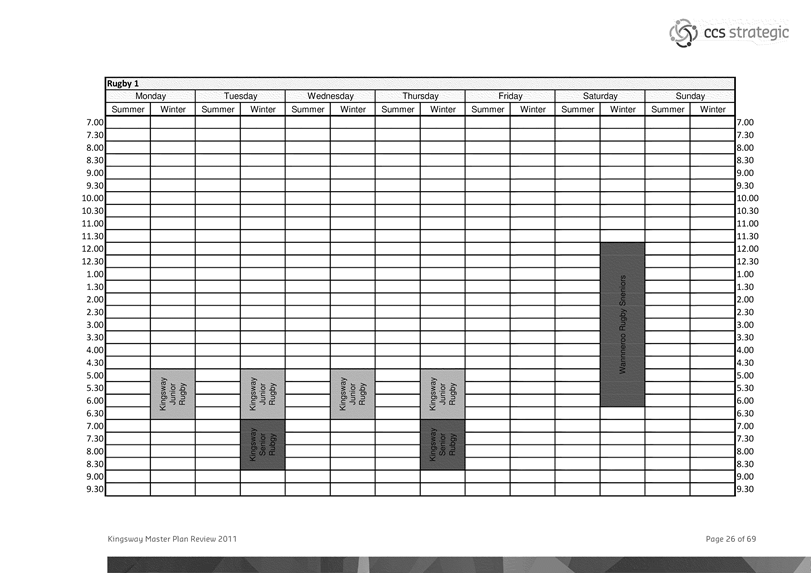
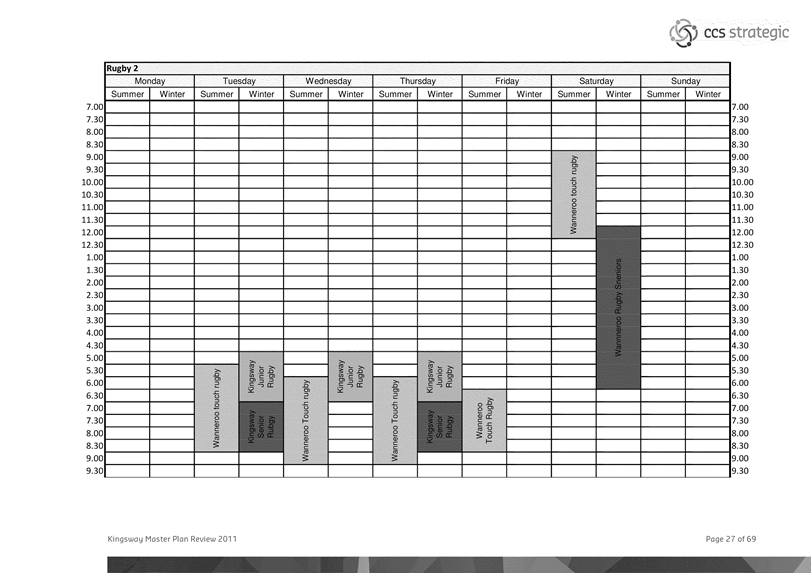
CITY OF WANNEROO Agenda
OF Ordinary Council Meeting 05 April, 2011 300
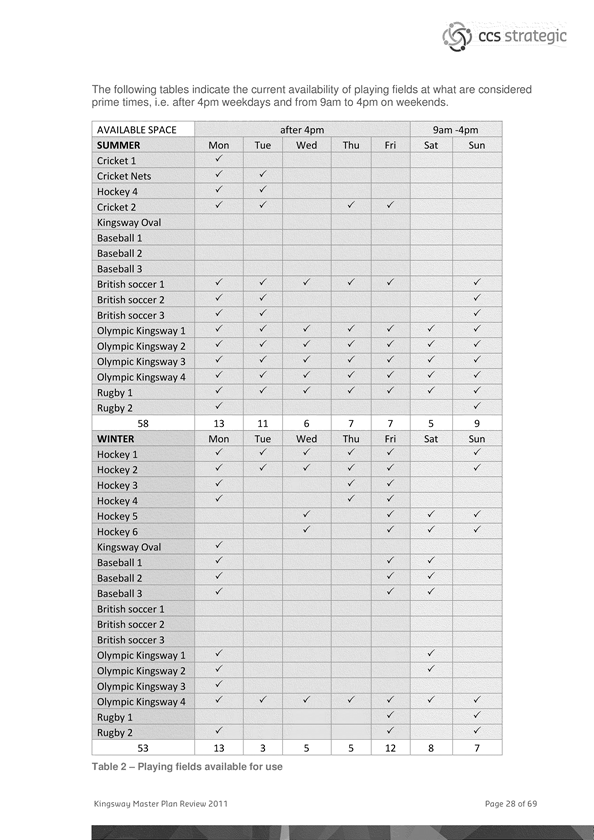
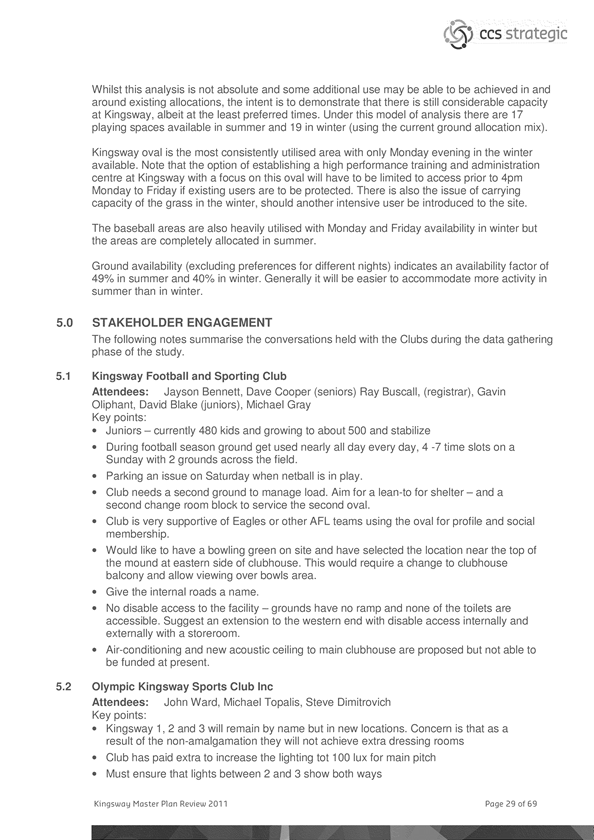

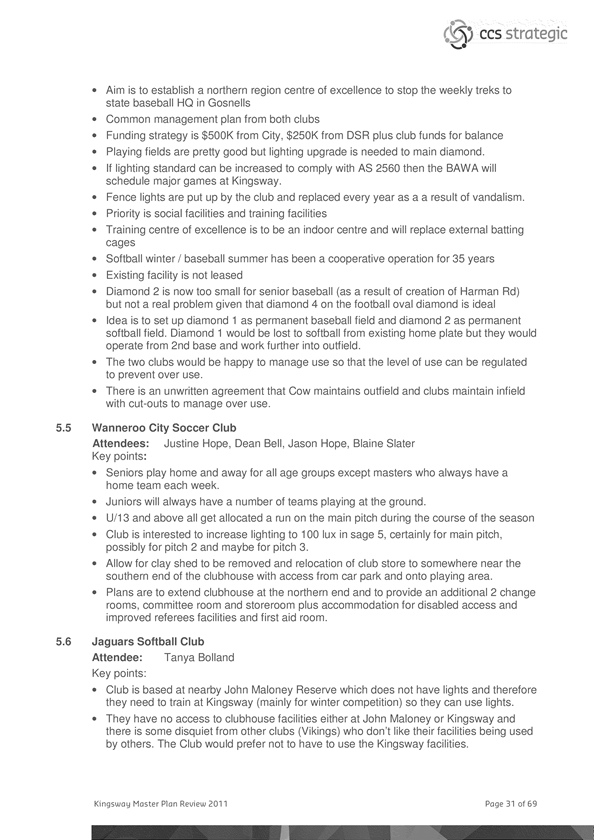
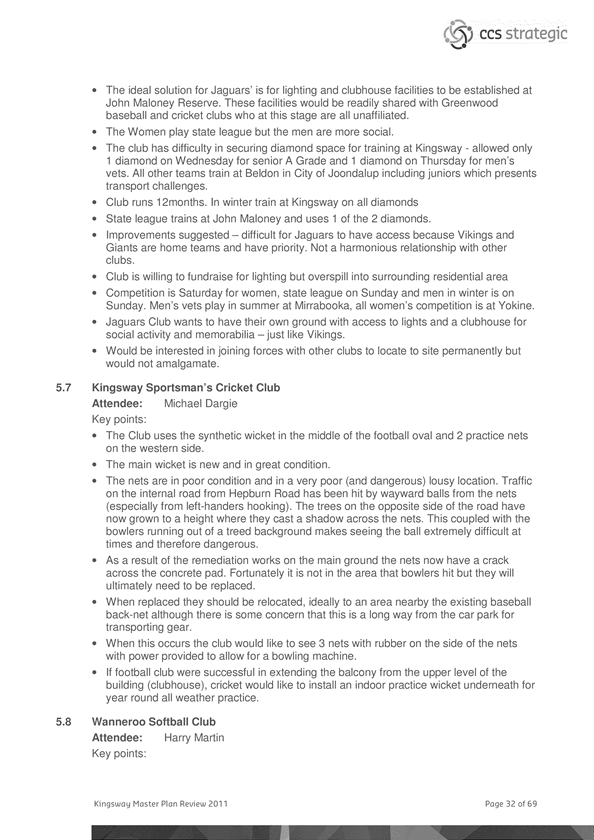

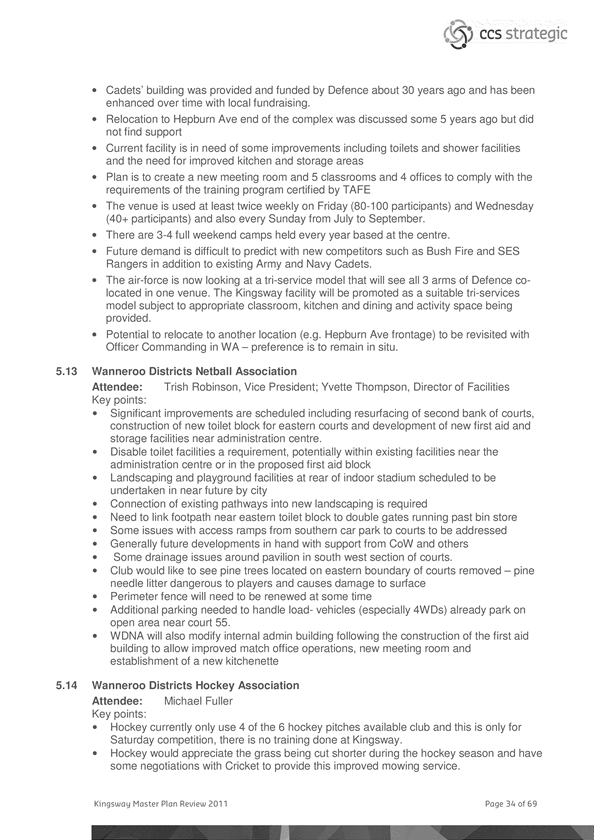
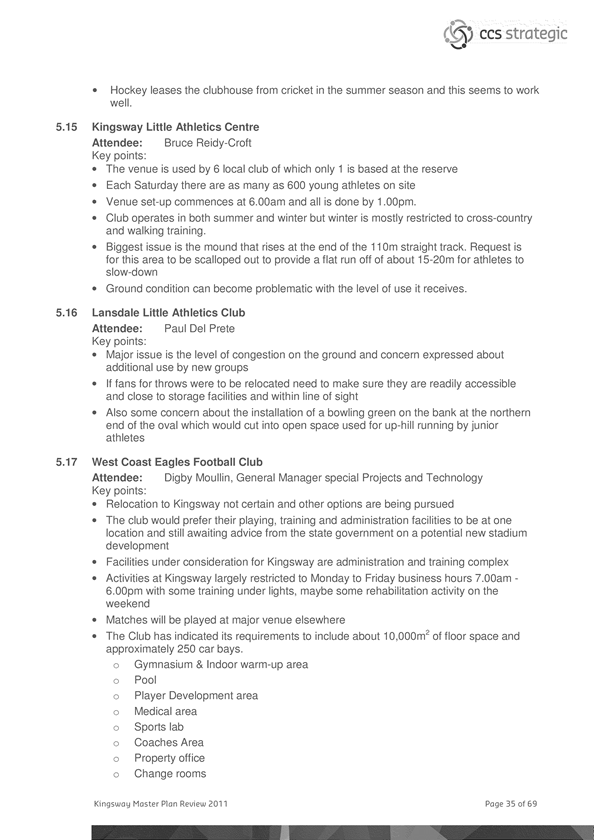
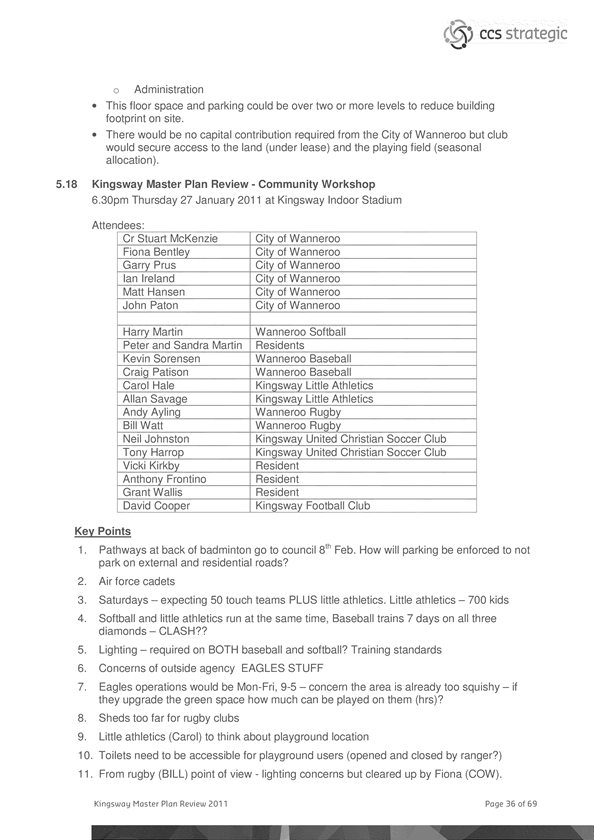
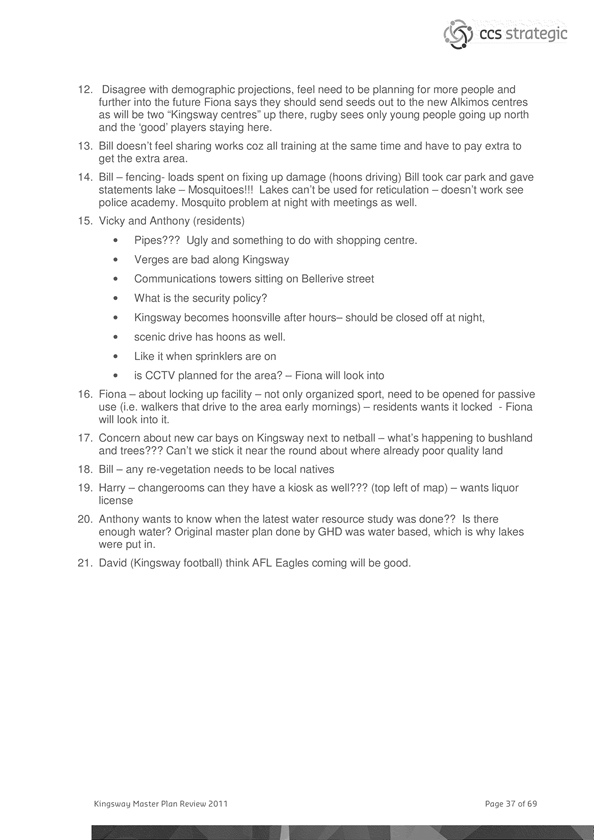
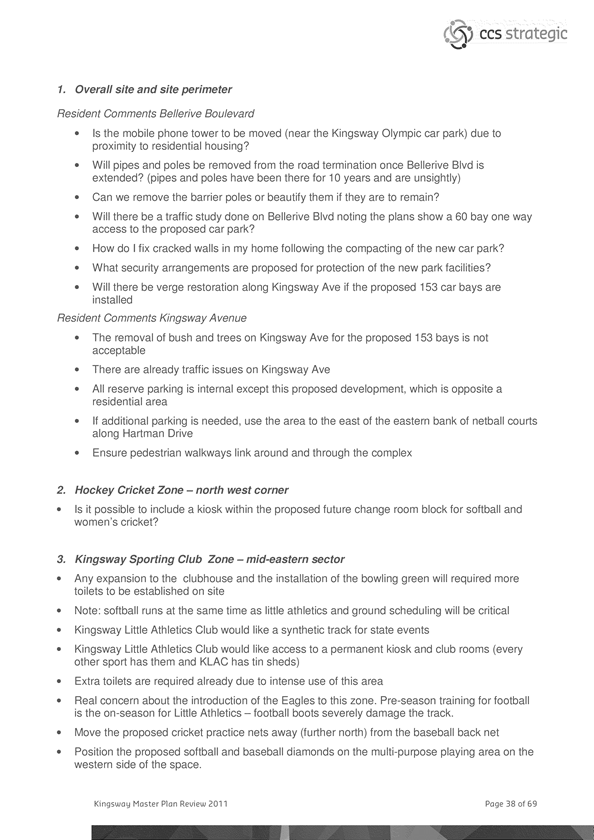
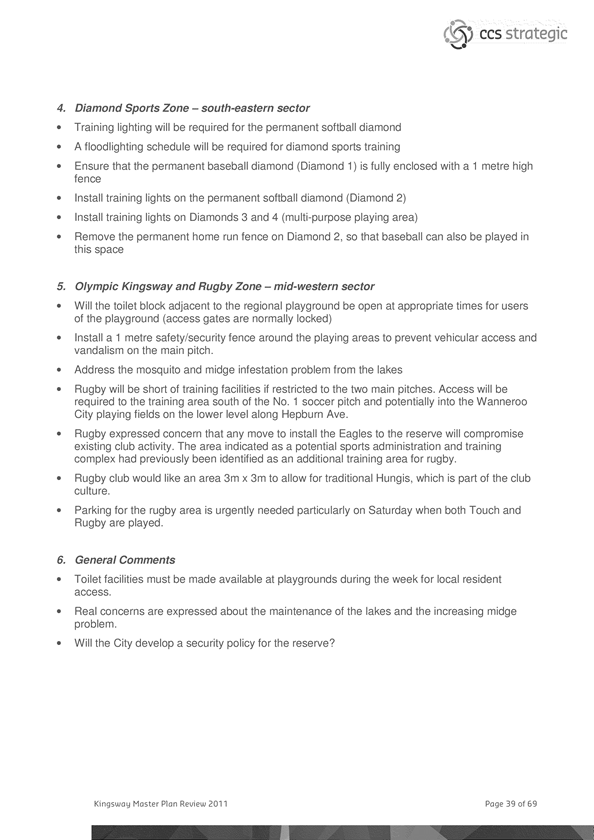

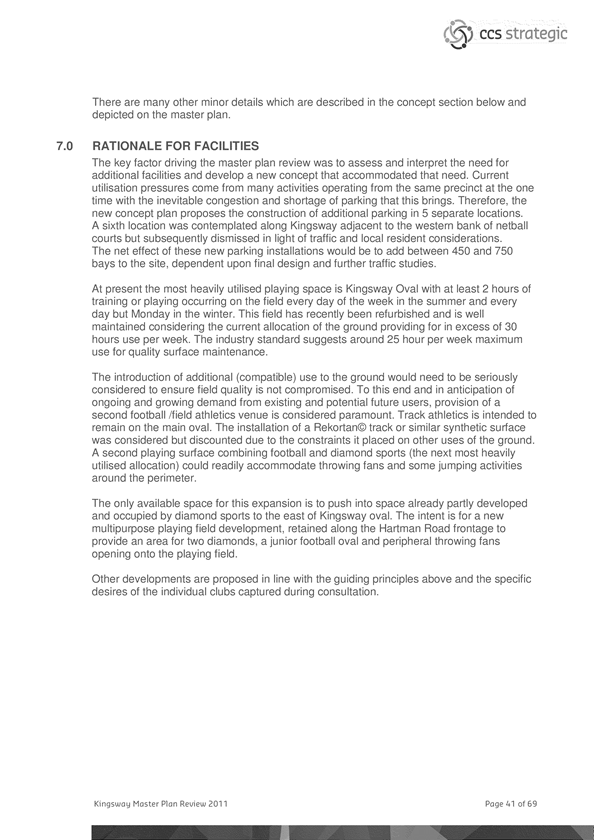
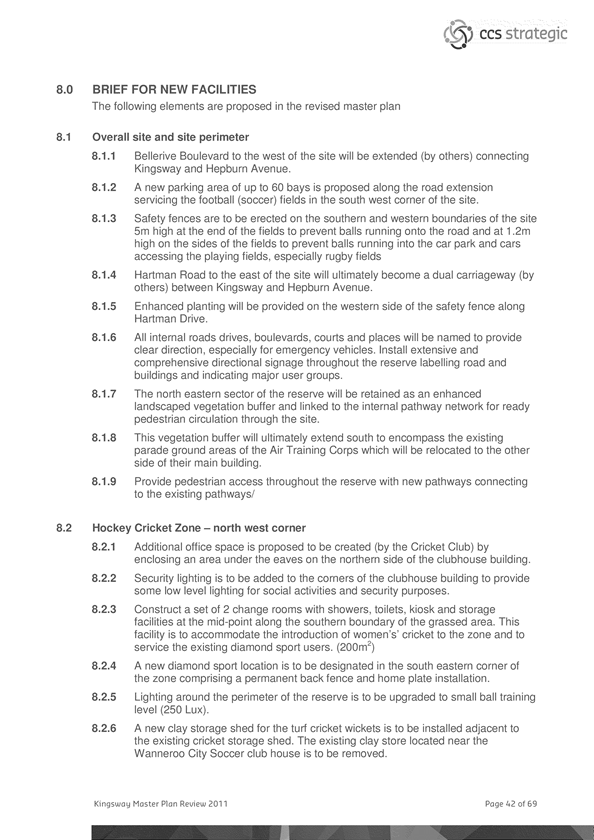
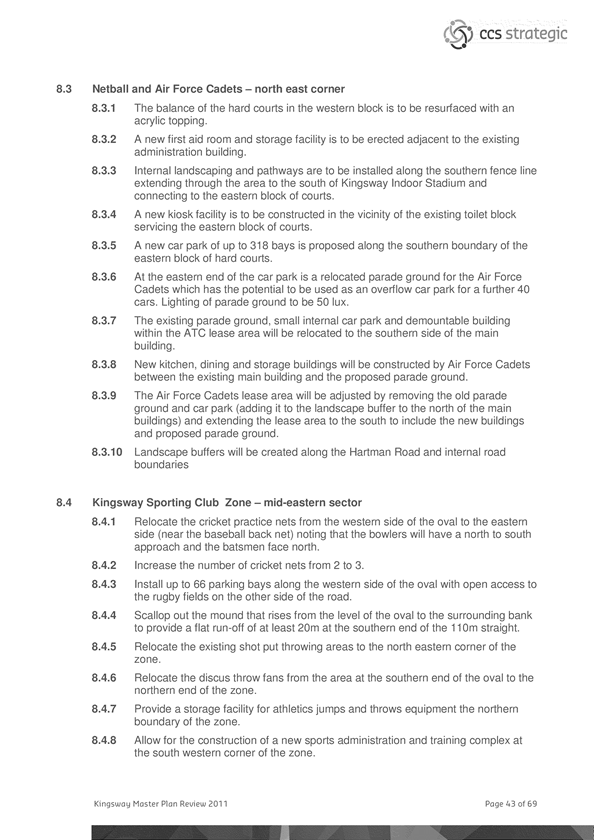
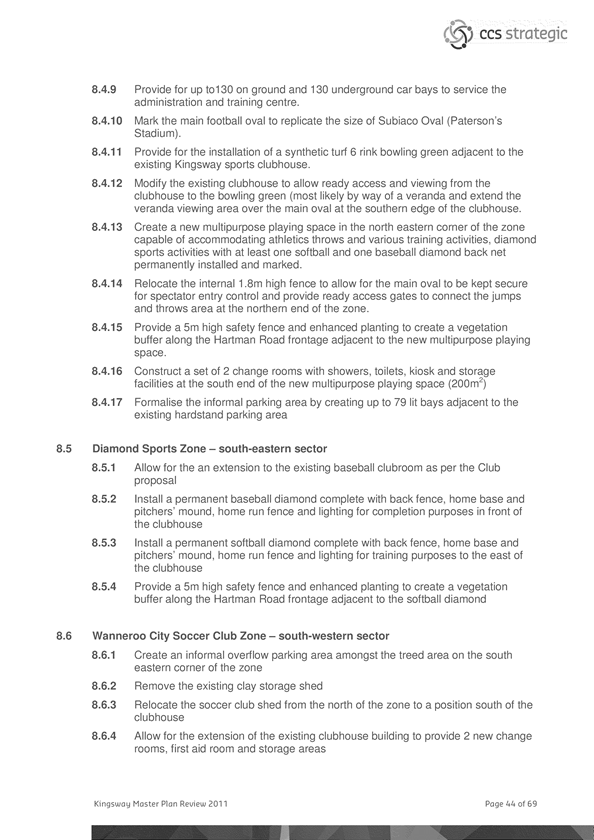
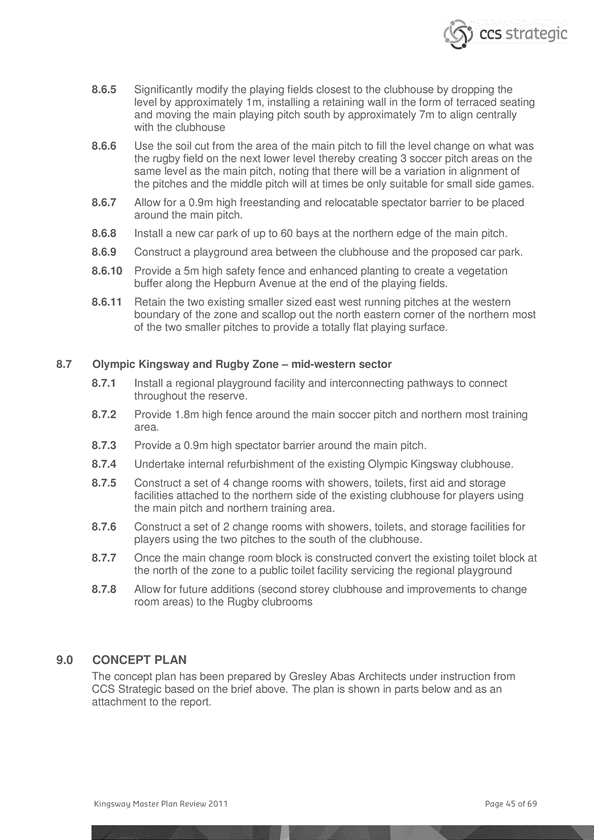
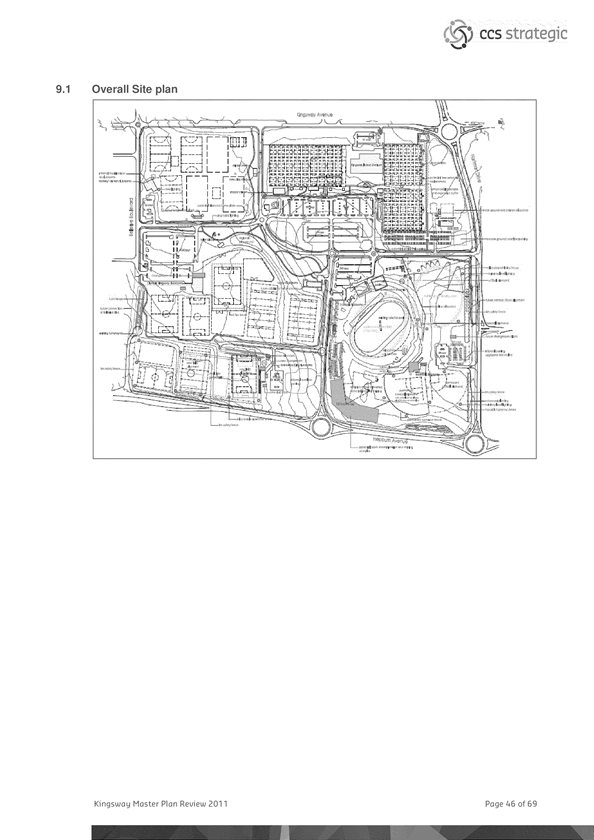
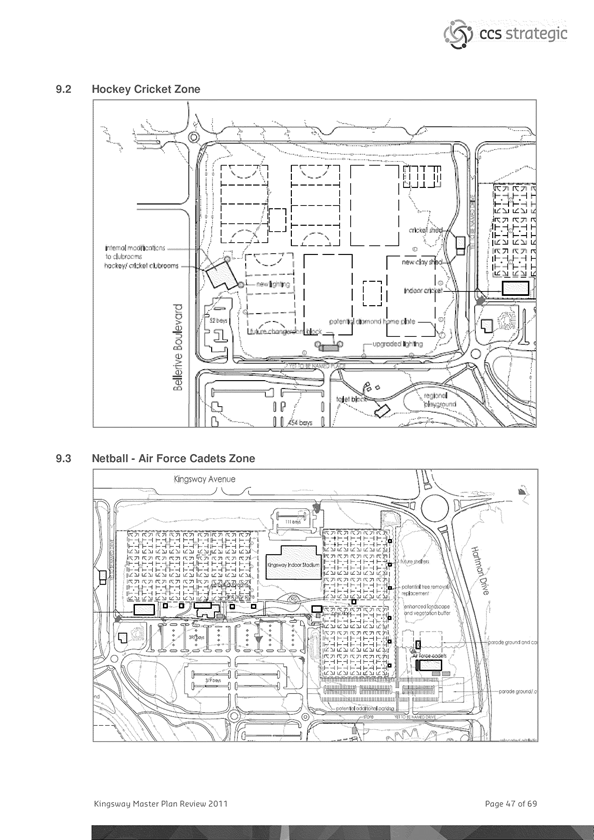
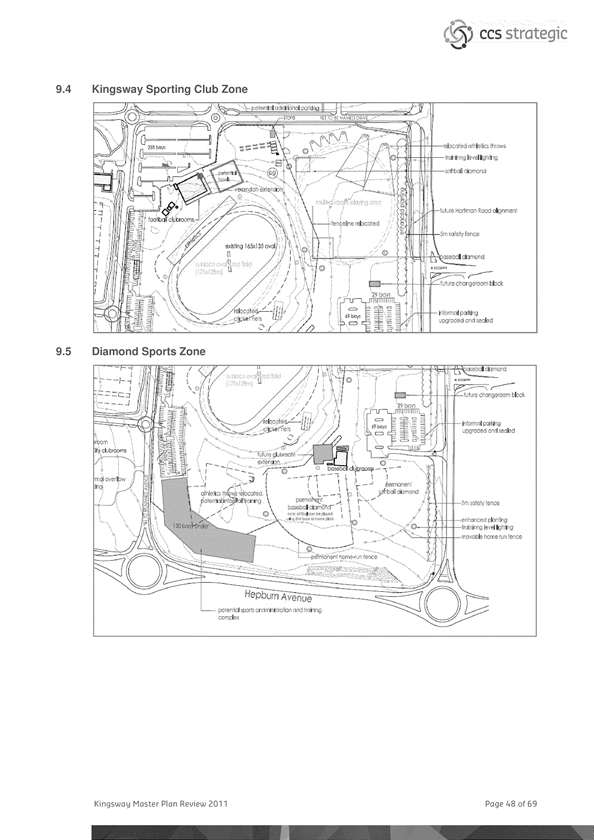
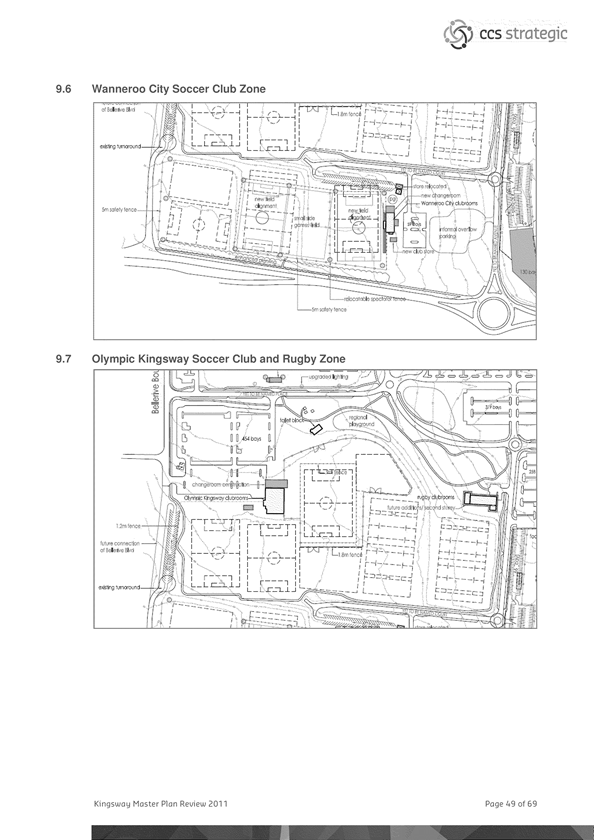

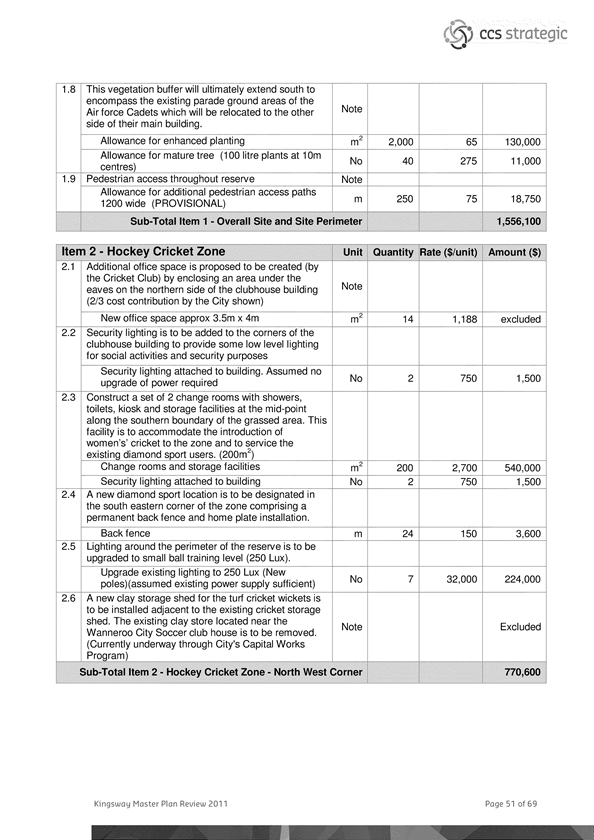


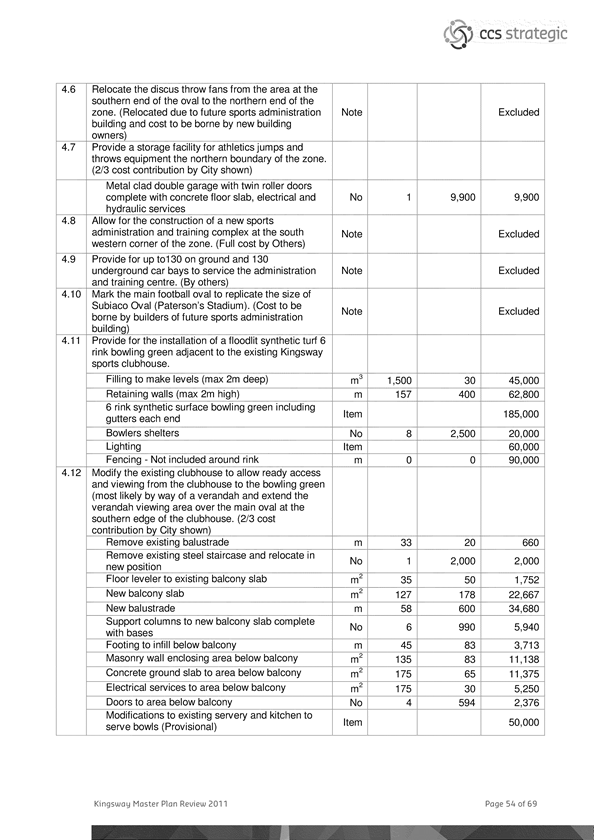
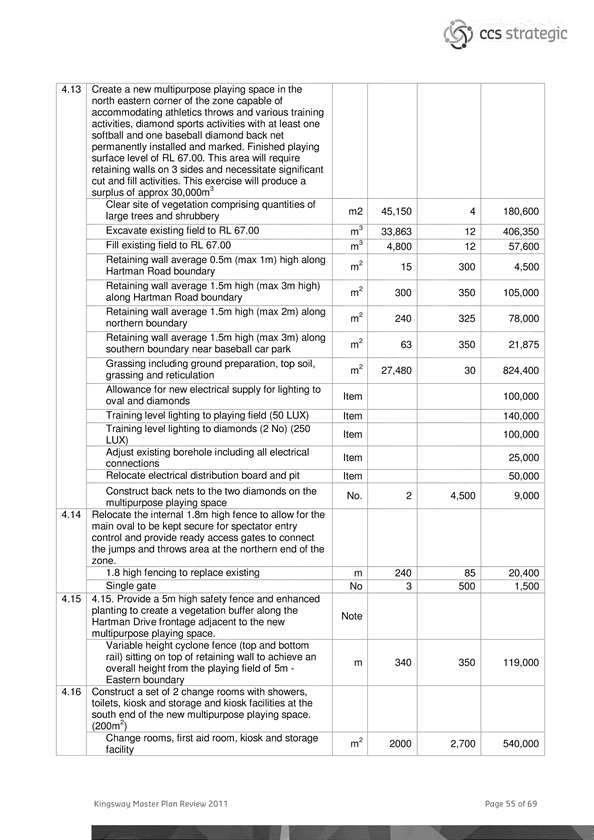
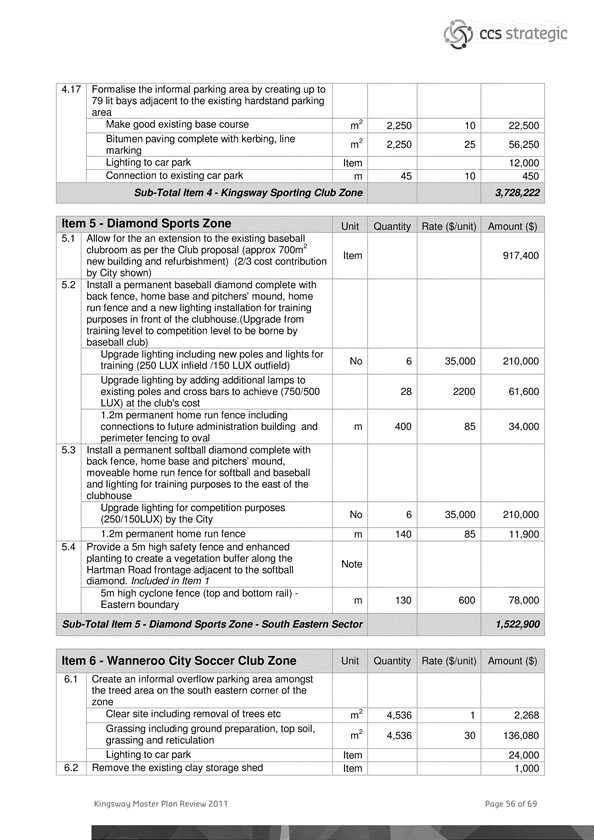
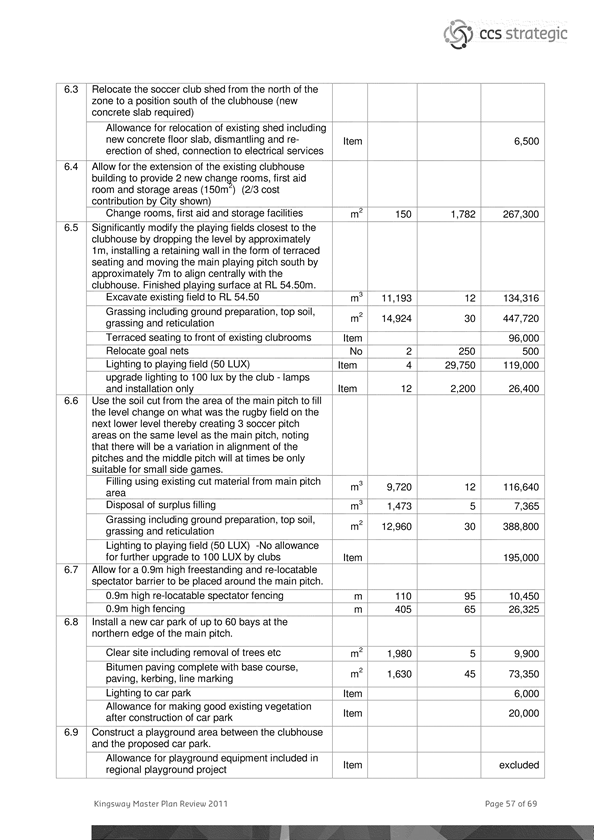
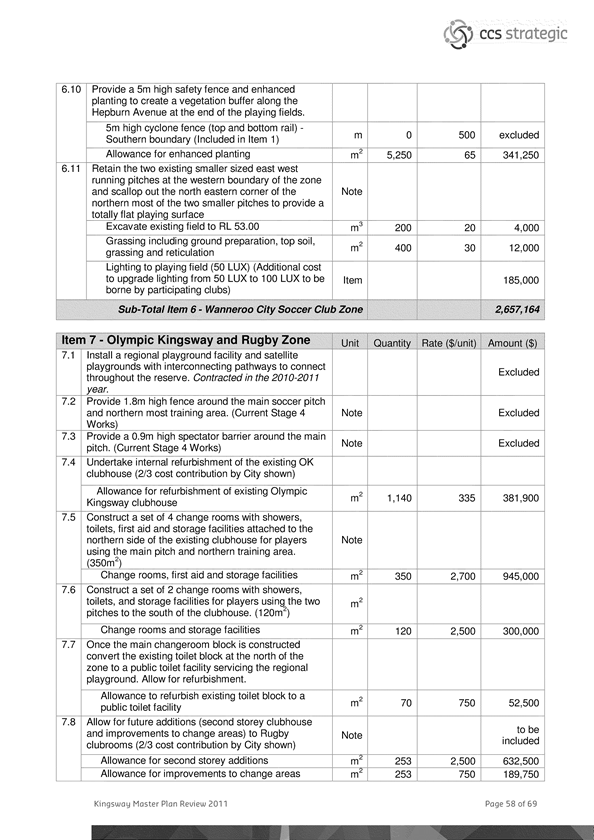
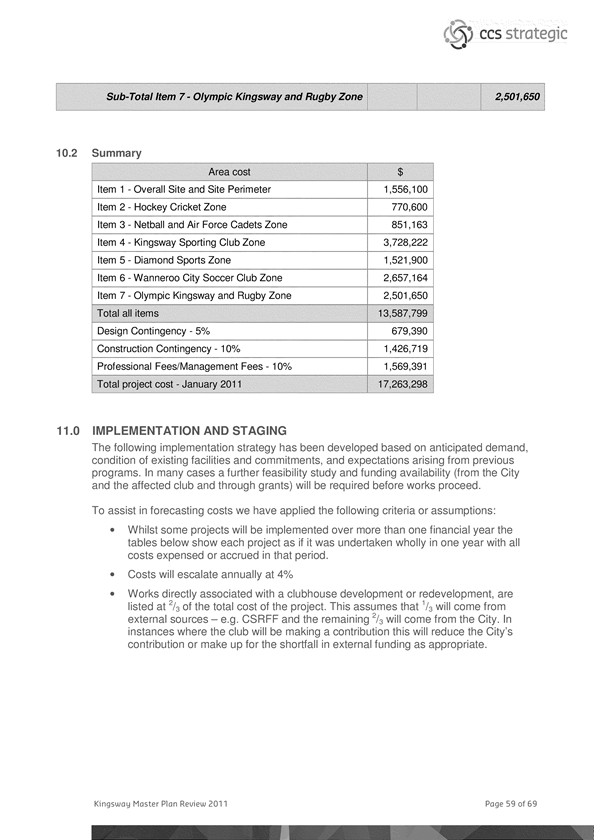
CITY OF WANNEROO Agenda
OF Ordinary Council Meeting 05 April, 2011 332
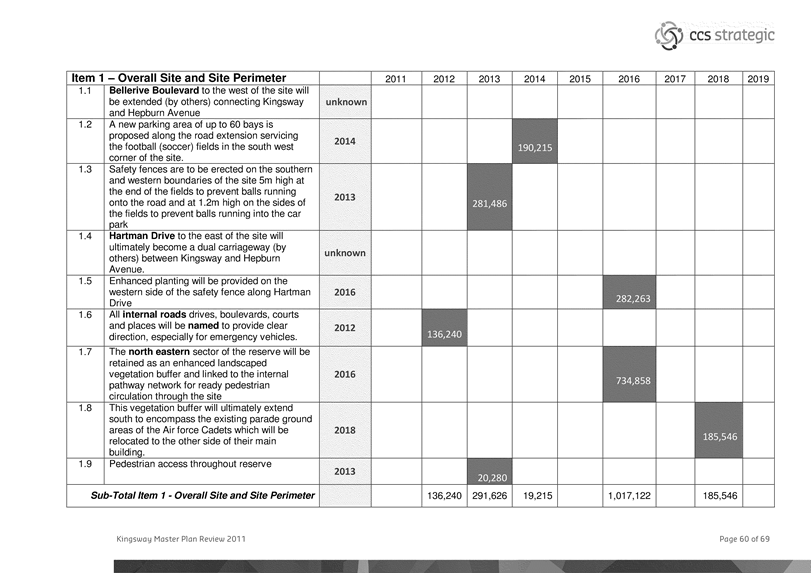
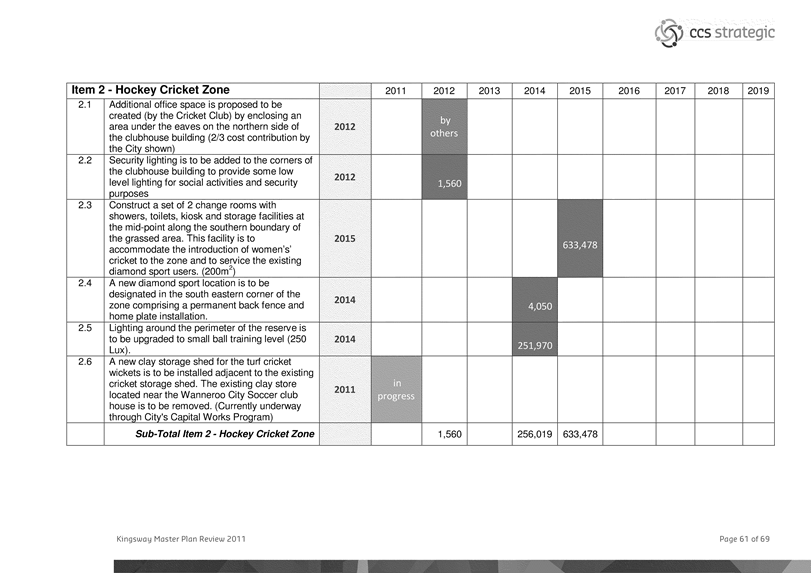

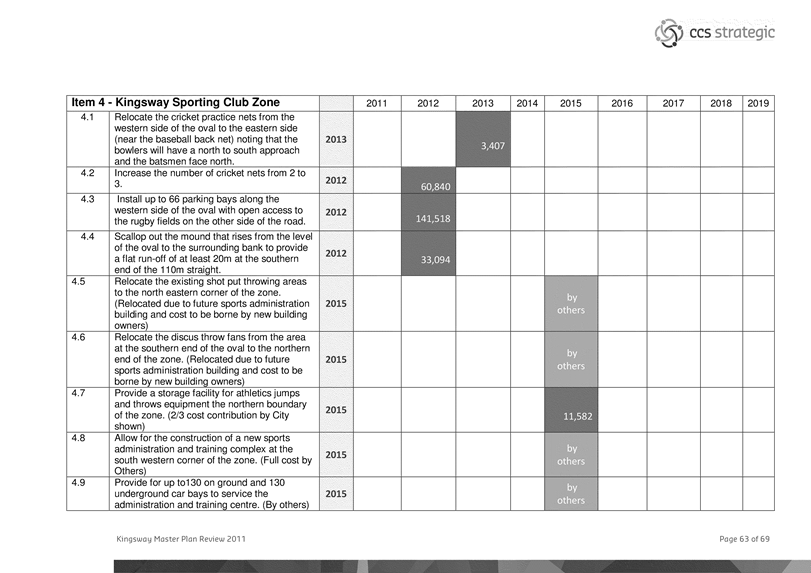

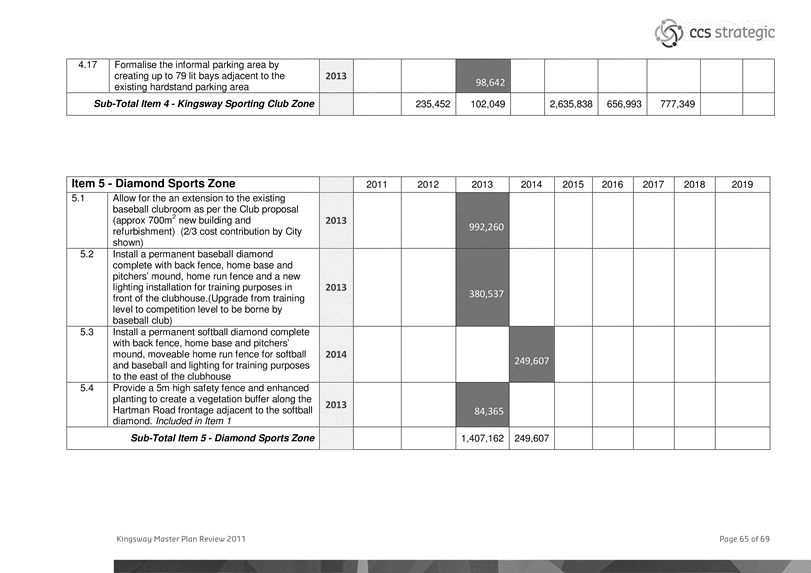
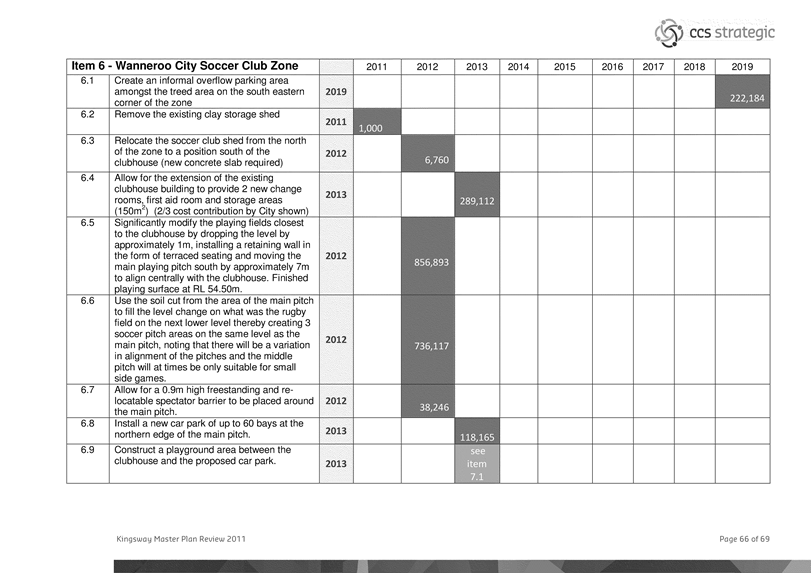
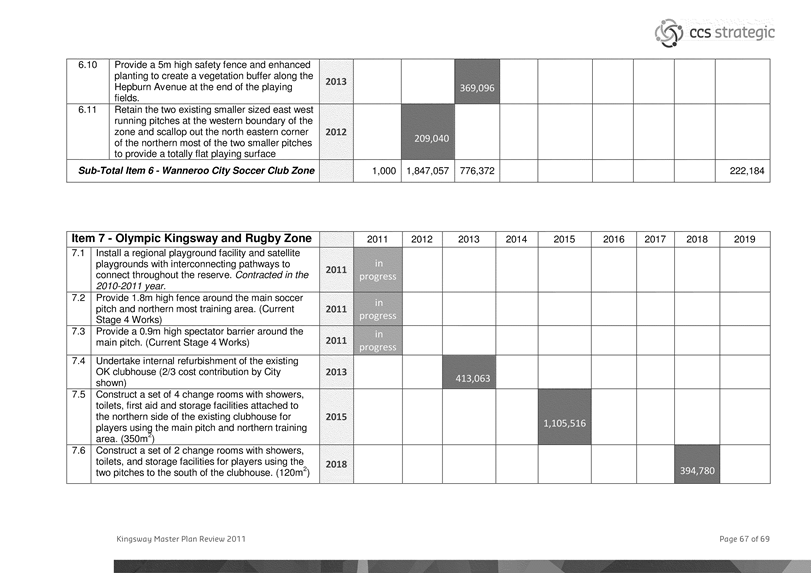
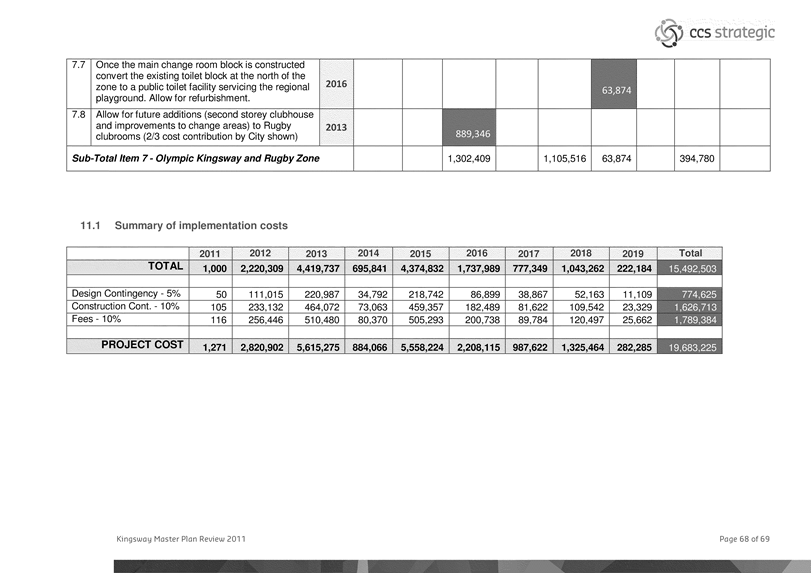
CITY OF WANNEROO Agenda
OF Ordinary Council Meeting 05 April, 2011 341
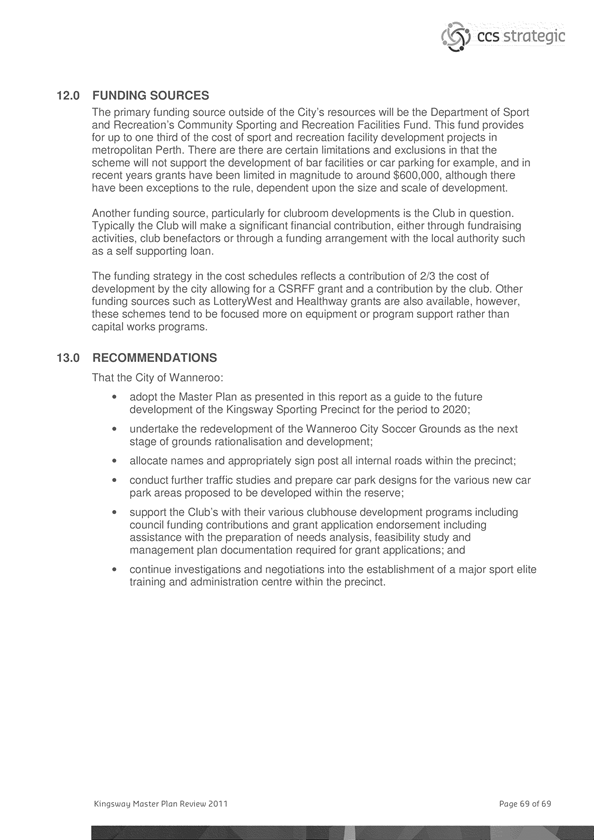
CITY OF WANNEROO Agenda
OF Ordinary Council Meeting 05 April, 2011 342
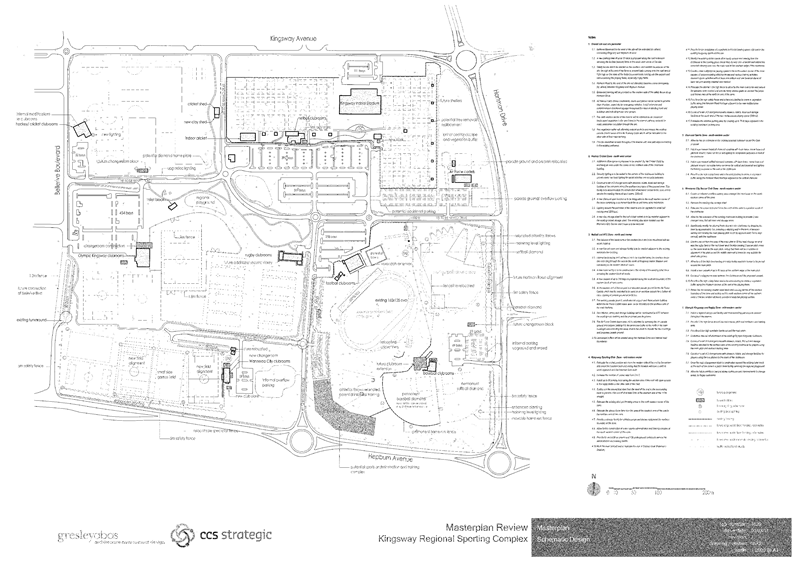
Other Matters
CD04-04/11 Review
of the Community Consultation Policy
File Ref: 2411
– 11/27066
Responsible
Officer: Director, Community Development
Disclosure
of Interest: Nil
Attachments: 1
Issue
To consider a review of the Community Consultation Policy.
Background
At its meeting of 26 April 2006 Council adopted a Community
Consultation Policy to guide the way in which the City interacts with residents
and other stakeholders on a range of issues. The original policy was
developed in line with best practice principles available throughout Australia
at that time.
Detail
The International Association for Public Participation
Australasia (IAP2) publishes a widely used and regarded Public Participation
Spectrum. This Spectrum has been used to review the City’s policy
and very few changes were required. Essentially the following points have
now been amended or clarified.
· Inclusion
of the term engagement in the title and principles.
· Clarification
of roles and titles since the organisational restructure in 2009.
· Additional
definitions to assist interpretation.
· Extending
the previous four stages of consultation to the international standard of five
stages, based on increasing levels of public impact.
The revised draft Community Consultation and Engagement
Policy is included as Attachment 1.
Although the policy as a high-level framework guiding the
City’s intentions requires few modifications, the supporting
documentation/practice notes require significant review and changes. An
internal working group is assessing existing tools and considering the
development of new tools to assist all officers implement the principles of the
policy consistently and effectively. In particular, new technologies are
being investigated to facilitate interaction with stakeholders who do not have access
to traditional consultation methods (poor distribution of local newspapers,
physical handicaps, etc) or who prefer on line communications (typically
younger adults, but increasingly seniors as well).
Consideration is also being given to the preparation of an
annual consultation strategy, for presentation to Council, that identifies key
projects that might be considered by the community for input in a cohesive
manner that avoids duplication of effort and “consultation fatigue”
for respondents. This will be increasingly important as we move towards
the implementation of the State Government’s proposed Integrated Planning
Framework, which will require a community lead process for developing a
Strategic Community Plan.
The IAP2 Public Participation Spectrum is proposed to be
adopted as an attachment to the policy and appears as Attachment A to
this report.
Consultation
Consultation was undertaken with a selection of key City
officers who regularly conduct consultation with the City’s residents and
stakeholders.
Comment
Recent reference to consultation strategies and policy
frameworks in other Local Government authorities across Australia confirms that
the City of Wanneroo policy, with minor modifications, is still
appropriate. The City has extensive experience in the use of traditional
and creative consultation processes that have proven very successful,
including:
· formal
surveys such as the annual customer perception surveys;
· calls
for submissions in response to formal planning matters;
· sausage
sizzles to aid in gathering community input to park designs;
· direct
mail to residents within a suitable catchment;
· public
meetings;
· newspaper/internet
advertising of opportunities to comment;
· community
art projects such as photo journals and primary school projects that informed
the Quinn’s Residential Study;
· Tree
of Hope/Cultural Plan based around City events.
It is clear however that with the decline in readership of
newspapers by young adults and others within our community that new contact
opportunities need to be explored. Adoption of the revised policy will
enable Administration to focus on the development of a new
“toolkit” for officers to use in engaging with the wider community
for a range of issues. New technologies need to be explored to ensure
that we understand the risks and productivity gains to be made from these if
the City chooses to implement them. These might include:
· Facebook
pages – interactive or non-interactive;
· Twitter;
· On
line forums or targeted campaigns;
· Citizen
space – crowd sourcing for policy development.
It is critical that the diversity of the City be considered
in adopting new processes, including those with English as a second language,
physical and mental health issues, cultural differences, etc.
The ability for Council to formally consider an annual
consultation strategy should be trialled and would make a valuable contribution
to the way in which we respond to community needs and concerns.
Statutory
Compliance
This review of a Council Policy is undertaken in compliance
within the requirements of the Local Government Act (WA) 1995.
Strategic
Implications
The proposal accords with the following Outcome Objective of
the City’s Strategic Plan 2006 – 2021:
“4 Governance
4.2 Improve
community engagement”
Policy
Implications
This policy forms part of the City of Wanneroo’s
adopted Council Policy Manual and it is within Council’s capacity to
confirm, modify or rescind Council policies.
Financial
Implications
Revisions to this policy should improve both the efficiency
and effectiveness of the City’s consultation with its community.
Community consultation and engagement activities are funded from the
City’s operating budget as a normal function of delivering programs and
services to the community.
Voting
Requirements
Simple Majority
Recommendation
That Council APPROVES the
revised Community Consultation and Engagement Policy as detailed in Attachment
1, including the International Association for Public Participation Australasia
Public Participation Spectrum.
CITY OF WANNEROO Agenda
OF Ordinary Council Meeting 05 April, 2011 346
Community Consultation and Engagement Policy
Policy
Owner: Community
Development
Contact
Person: Director
Community Development
Date
of Approval: 26
April 2006 (GS07-04/06)
POLICY OBJECTIVE
The purpose of this policy is to provide a series of principles to guide consultation
processes used by the City to encourage and support community involvement in
local government decision-making. All community consultation and engagement is
to be undertaken in accordance with the principles of this Policy.
POLICY STATEMENT
Community consultation and engagement enables the City of
Wanneroo (the City) to involve the community in its decision-making processes.
It provides elected members and Council staff with the
opportunity to:
· listen to the
community;
· consider a range
of options and develop ideas together; and
· build a shared
understanding on an approach.
Consultation ensures that:
· the community is
aware of, and involved in, the development and review of policies, plans and
services;
· the
community’s satisfaction with the City’s policies, plans and
services is considered; and
· council is open
and accountable in its decision making, resource management and expenditure.
Engagement means:
· Longer term
conversations with the community;
· Educating the
community; and
· Providing
opportunities for feedback.
SCOPE
This policy applies to all City staff who deliver services
to the community. The policy provides a framework for how and when the
community needs to be informed/engaged about new or revised service
provision. This might include anything from new play equipment or bus
shelters to market research and public meetings about contentious local issues.
Background
The Community Consultation Policy identifies potential
strategies and timeframes for consultation according to the nature of the topic
being considered. The public participation spectrum that supports the
policy outlines the types of consultation that might be utilised and which of
these are most appropriately implemented given the level of impact either
across the City or more locally.
CONSULTATION WITH STAKEHOLDERS
This policy acknowledges that there are statutory
requirements the City must comply with in consulting with the community about
particular issues. This policy encourages an increase in the level and range of
methods used in community consultation, in addition to the level required by existing
legislative and statutory requirements.
Key Values and Principles
In undertaking any consultation process the City will be
committed to the following principles:
· Encouraging
participation of people who live, work, visit or support the City of Wanneroo;
· Encouraging broad representation from all population groups
within the community to ensure that a diverse range of views are expressed and
considered;
· Minimising
barriers to participation;
· Clearly stating
the purpose and aims of the consultation, and any associated limitations or
constraints;
· Ensuring relevant
information is readily available and that it is accurate, comprehensive and
easy to understand;
· Clearly defining
the consultation period and allowing sufficient time and opportunity for the
community to participate;
· Listening,
responding and providing feedback to participants and the community about how
the information gathered through the consultation process was used to inform
the decision or outcome; and
· Being efficient,
responsible and accountable for each consultation undertaken and the decision
made as a result.
Consultation in Practice
The level of community consultation undertaken relates
directly to the level of community involvement required. This should always be
appropriate to the nature, complexity and impact of the issue, plan or
strategy. Where a decision about a particular issue
can be delayed to allow time for community consultation this should occur, if
it is appropriate.
Any consultation undertaken by the City will be completed before
a decision is made. Consultation, and a commitment to community involvement, is
not effective, or appropriate, when:
· A final decision
has already been made by Council or another agency;
· Council cannot
influence a decision to be made by another agency or party; and
· There is
insufficient time available to consult, due to legislative, resource or legal
constraints.
In these events the City will endeavour to provide
information relating to the reasons why Council could not seek community
consultation on the issue.
In some circumstances, the City will carry out initial
communication and notification procedures for regular services, and may become
aware through responses received that the community or key stakeholders have
strong views concerning the issue. As a result, further consultation processes
may be used to work with the community to resolve the issue(s).
Informing Council
It is important that Council and Elected Members are
made aware of consultation occurring within the City. The following applies to
community consultation:
· Ward councillors
will be invited to attend consultation that impacts on a local community within
their ward and provided with any supporting information prior to invitations
being made to the community;
· Wider/generic
consultation will be identified to Elected Members through Council Forum,
Clipboard and the City’s formal diary prior to any meeting or event.
· Consultation
activities that are considered critical, that is they have a high level of media
interest or potential impact on the City’s operations or finances, will
be considered by Council prior to implementation.
Engagement activities will be facilitated by the delivery of
key messages to the community using approved media – including but not
restricted to newspapers, newsletters and other print materials; the
City’s internet pages, e newsletters and other on-line opportunities;
media releases; events; displays; and educational opportunities in partnership
with other agencies and organisations.
IMPLICATIONS (Financial, Human
Resources)
Each service unit that initiates new or revises existing
services is required to appropriately budget funds and staff resources to
undertake supporting community consultation. Corporate consultation will
be facilitated by the Information and Business Improvement Service Unit.
IMPLEMENTATION
The following roles and responsibilities outline how the
Community Consultation and Engagement Policy should be implemented in a
consistent manner across all aspects of the City’s business. In
particular a consultation proposal form must be completed and supported by the
appropriate director prior to submission to the Community Consultation Review
Panel. Once endorsed, agreed strategies should be implemented promptly and
the results reported to Council, where required.
ROLES and RESPONSIBILITIES
Community Consultation Review Panel
To ensure that each consultation process is appropriate to
the type of decision to be made, and the people that will be affected, a
consultation strategy for each consultation will be developed and presented to
the Community Consultation Review Panel.
The Community Consultation Review Panel will consist of:
· The Chief
Executive Officer, or nominated representative
· The Directors of
each City Directorate, or their nominated representatives
The Community Consultation Review Panel will be responsible
for:
· assessing and
endorsing each proposed community consultation process;
· providing advice
to enhance consultation outcomes if appropriate; and
· reviewing
evaluation reports from previous consultations.
DISPUTE RESOLUTION
All disputes in regard to this policy will be referred to the appropriate
Director in the first instance. In the event that an agreement cannot be
reached, the matter will be submitted to the Chief Executive Officer for a
ruling.
WHO NEEDS TO KNOW about THIS POLICY?
All City of Wanneroo elected members and officers need to be
aware of this policy and able to interpret and implement its requirements.
EVALUATION and Review Provisions
To assist the City in using the most effective ways to
consult the community, this policy provides for the review of consultation
processes utilising a variety of methods including:
· Market research to
identify preferred methods of providing information and receiving feedback from
the community – conducted on a biennial basis;
· Seeking feedback
from participants during and after consultation about the strategies and
processes used; and
· Staff evaluation
of consultation strategies, which is then submitted to the Community
Consultation Review Panel after each consultation is completed.
The Community Consultation Policy will be reviewed every
three (3) years.
DEFINITIONS
|
DEFINITIONS: Any definitions listed in the following table
apply to this document only.
|
|
Community Consultation
|
The term 'community consultation' covers the range
of activities that the City utilises to support the involvement of residents,
businesses, stakeholders and other community members in decision-making
processes.
These processes include the following five levels of
community participation:
· Inform
· Consult
· Involve
· Collaborate
· Empower
|
|
Engagement
|
The term Engagement covers the dissemination of key
messages to the community to facilitate a long term, two way conversation
about the future of the City of Wanneroo. It will also include educational
opportunities and participation in decision-making processes.
|
RELEVANT POLICIES/MANAGEMENT PROCEDURES/DOCUMENTS OR DELEGATIONS
Community Consultation and Engagement
Guidelines and Practice Notes – currently under review.
REFERENCES
Public Participation Spectrum
The Public Participation Spectrum forms an attachment to
this policy. The Spectrum aims to provide staff with a guide as to when, and
how, to consult with the community in different situations.
Attachment A: IAP2
Public Participation Spectrum (© 2004
International Association for Public Participation)
RESPONSIBILITY FOR IMPLEMENTATION
DIRECTOR COMMUNITY DEVELOPMENT
|
Version
|
Next Review
|
Record No:
|
|
|
April 2008
|
501131
|
|
2
|
February 2014
|
10/64025
|
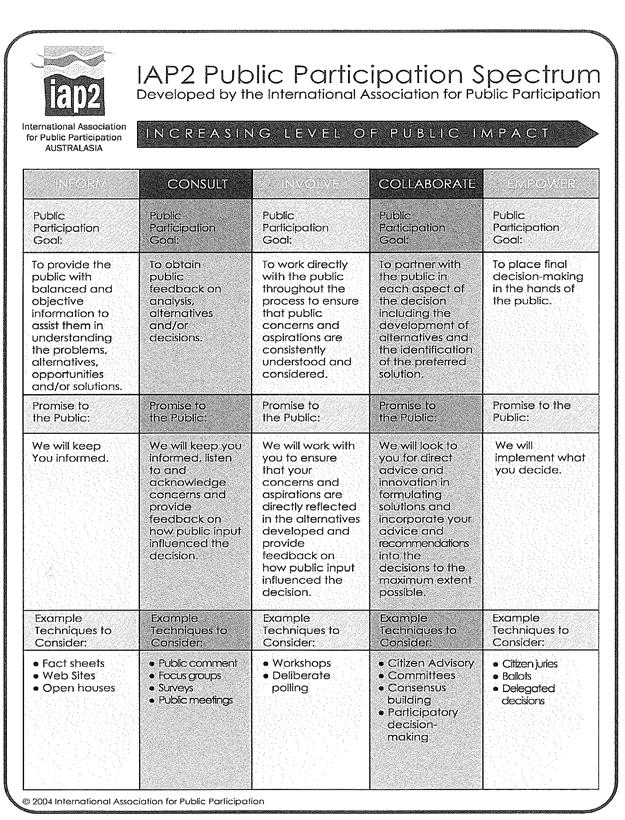

Finance
CS01-04/11 Financial
Activity Statement for the Period Ended 28 February 2011
File Ref: 2408
– 11/27986
Responsible
Officer: Director, Corporate Strategy and Performance
Disclosure
of Interest: Nil
Attachments: 4
Issue
To consider the Financial Activity Statement for the period
ended 28 February.
Background
Regulation 34(1) of the Local Government (Financial
Management) Regulations 1996 requires a local government to prepare each
month a statement of financial activity, presented according to nature and
type, by program, or by business unit. Administration has opted to
present the statement of financial activity by nature and type and in a similar
format to that presented in the 2010/2011 Annual Budget. This format separates
Revenue and Expenses from Other Revenue and Expenses and provides improved
disclosure of City’s underlying Operating Result.
The Financial Activity Statement is in the form of an Income
Statement, which compares year to date actual income and expenses with the year
to date budget, shows variances and the adopted and revised budgets (if
any). It is accompanied by a Balance Sheet together with information
relating to Capital Projects, an Investment Portfolio Summary, Statement of Net
Current Assets and Rate Setting Statement.
In addition to the above, Regulation 34(5) of the Local
Government (Financial Management) Regulations 1996 requires a local
government to adopt a percentage or value, calculated in accordance with
Australian Accounting Standards, to be used in statements of financial activity
for reporting material variances. For the 2010/2011 financial year
Council has adopted 10% for the reporting of variances, which is in line with
previous years.
In accordance with Regulation 33A of the Local Government
(Financial Management) Regulations 1996, a local government is to carry out
a review of its Annual Budget for that year between 1 January and 31 March
in each year. Council is to consider the review submitted to it and is to
determine whether or not to adopt the review, any part of the review or any
recommendations made in the review. Hence, the 2010/11 Mid Year Budget
Review was considered and adopted by Council at its meeting of 8 March 2011,
with financial information subsequently updated and reflected under the Revised
Budget figures.
Detail
The Financial Activity Statement and February year to date
financial performances of the City are detailed in Attachments 1, 2, 3,
and 4.
Consultation
Nil
Comment
The commentaries on variances to budgets in the Financial
Activity Statement for the period ended 28 February 2011 are provided below:
Income Statement (Refer to Attachment 1)
Net Result $
million
Year to Date Actual 47.275
Year to Date Revised Budget 42.221
Year to Date Variance
5.053 (+12%)
Full Year Adopted Budget 33.062
Full Year Revised Budget 54.531
The following information is provided on key aspects of the
year to date financial results:
Revenues $
million
Year to Date Actual 110.648
Year to Date Revised Budget 109.023
Year to Date Variance 1.625
(+1%)
Full Year Adopted Budget 121.694
Full Year Revised Budget 125.176
Interest Earnings
The value recorded from Interest Earnings is dependent on the
level of investment funds available, prevailing interest rates and the ability
to closely monitor and manage. February year to date interest earnings
amounts to $5.511 million recording approximately $0.8 million bi-annual coupon
payments on the City’s Bonds portfolio. A substantial favourable variance
of $0.776 million (+16%) comparing to year-to date budget is reflected.
Reserve Bank of Australia (RBA) meeting March 2011 had decided
to put cash rate on hold at 4.75%. The decision to keep the official cash rate
on hold met the expectation of financial markets, being:
· Inflation
is under control, and
· Flooding
in Queensland and Victoria will have a temporary adverse effect on economic
activity and prices.
It is unlikely the RBA will move interest rates in the
following months as the floods have increased uncertainty and until RBA
receives some post-floods data they will not rush with the decision. RBA
Governor Glenn Stevens’ commentary in relation to the current monetary
policy on 1 March further reinforced that a rate rise is not expected for the
first half of 2011. Whilst internationally, there have been major events of a
political and environmental nature that are having an impact on the wider
economy, at this stage they are seen as temporary influences and not likely to
stall the recovery being experienced across most markets.
The City will continue a “cautiously optimistic”
prudent investment strategy throughout the year and has projected a full year
forecast of $7.102 million, which is $1.720 million (+32%) better than the
adopted budget.
Other Revenue
The Other Revenue category shows a favourable year to date
variance to Budget of $0.339 million (+12%), mainly due to sales of
commodity products at the Wangara Recycling Facility being ahead of budget by
$0.559 million (+24%) however offset by non-receipt of royalty income year to
date budget of $0.200 million.
The value of commodities has risen over the past
six months through the strong Australian dollar and the world market
paying more for products such as newspaper and mixed plastic. With a new
commodity pricing round starting in March 2011, it is anticipated that our
income from sales of commodity products will increase to $3.431 million by
30 June 2011, hence the overall Other Revenue will be better than the
Adopted Budget by $1.035 million (+32%).
The full year budget of $0.300 million for royalty
income is for sale of sand associated with the excavation of the boundary of
the City’s Lot 15 Motivation Drive. It is expected that this income
will be received this financial year.
Expenses $
million
Year to Date Actual
-76.012
Year to Date Revised Budget -81.229
Year to Date Variance
5.217 (+6%)
Full Year Adopted Budget -123.713
Full Year Revised Budget -122.309
Materials and Contracts
Overall, the year to date expenses is below budget by $2.490
million (+10%), which is mainly due to the favourable variances reflected under
Fuel Expenses of $0.159 million, Material Expenses of $0.441 million, Contract
Expenses of $0.936 million and Refuse Removal Expenses of $0.736 million. Of
these accounts, through the Mid Year review, reductions are reflected to end of
year forecasts for Contract Expenses (reduced by $0.239 million) and Materials
Expenses (reduced by $0.065 million).
Utility Charges (electricity, gas, water etc)
Utilities are currently under budget to the value of $0.456
million (+13%), which is primarily due to the timing of the Street Lighting
bills. The outcome of analysis by Units at Mid Year Review presents an overall
minor increase expected by year-end of $0.022 million.
Other Revenue and Expenses $
million
(Excluding Contributions of Physical Assets)
Year to Date Actual 12.640
Year to Date Revised Budget 14.428
Year to Date Variance
-1.788 (-12%)
Full Year Adopted Budget
5.080
Full Year Revised Budget 21.664
Non-Operating Grants, Subsidies and Contributions
It is worth noting that $3.526
million unbudgeted income was received from Newgen Power Neerabup in November
2011. The Newgen payment is an Infrastructure contribution, which will be
restricted and therefore does not represent an improvement to the City’s
Operating position.
To the end of February the City had
received $7.407 million towards Non-Operating Grants, Subsidies and
Contributions, which is predominantly tied to the progress of capital projects
and represents an unfavourable variance of -$1.718 million (-19%) when compared
to year to date Budget. In most cases funds will be received upon
completion or part completion of works, of which the exact timing is not
necessarily known. It should be noted however that where projects are
unable or unlikely to be completed by the current year end, their budgets may
be requested to be carried forward to the following financial year.
Assessments of these cases will be made over the coming months.
Town Planning Schemes (TPS)
TPS Revenue is dependent on Developers and as at 28 February
the amount received by the City equates to $9.076 million, which is +1% above
Budget. This however will not affect operations as funds received in this
category are held separately in restricted reserve accounts for future Scheme
use.
With TPS Expenses, some costs have been recorded year to date,
which are $2.328 million (+38%) below Budget. These expenditures will relate to
specific costs and land purchases within the Scheme location, which can only be
allocated for particular Scheme purposes and where unspent, will be carried
forward to future years.
During the mid year review process, it was noted that work
progress in various scheme location is substantially slower than anticipated
hence Administration has revised down the full year expenses to $9.225 million.
On the revenue stream, $0.226 million unbudgeted contribution
money to Neerabup Structure Plan in relation to Flynn Drive construction was
recorded and contribution for East Wanneroo - Cell 8 is forecast to increase by
$1.802 million. However, the contribution money expected for East Wanneroo-
Cell 1 was reduced to $0.491 million from original budget of $2.285 million as
subdivision activities is deferred to next year.
Profit/ (Loss) on Asset Disposals
The Profit and Loss on Asset
Disposals relates in part to the turnover of plant and fleet items and also
relating to land sales. Plant and fleet activities within this area to
February are steadily progressing, with a significant land sale to Western
Power for the Neerabup Substation expected by March 2011. Approximately
$4.300 million should be received from this sale, which is pending the
finalisation of conditions set by the Western Australia Planning Commission
(WAPC) of specific earthworks and drainage that are currently underway.
Year to date variances to Budget of - $2.971 million (-95%) and +$0.472 million
(+80%) are respectively reflected for Profits and Losses on Asset Disposals.
The recent Mid Year Review has
reduced Profit on Assets Disposals by $2.000 million as Lot 12 Fowley
Loop budgeted sale will not take place this year. However, the sale to Western
Power is still expected to proceed to settlement this financial year.
Loss on Financial Assets Disposals
As recommended by the City’s
financial advisor, Oakvale Capital Limited, the City has sold $10 million
(face value) National Australia Bank (NAB) March 2012 Government Guaranteed
bond. The sale reflected a face value loss of $44,800, however, counting the
coupon interest earned and the potential higher interest to be earned from
reinvesting the bond proceeds to term deposits, the comparable accumulated
return will exceed the proceeds of the bond.
Contributions of Physical Assets $
million
Year to Date Actual
0.000
Year to Date Budget
0.000
Year to Date Variance
0.000 (0%)
Full Year Adopted Budget 30.000
Full Year Revised Budget 30.000
Each year Developers hand over physical assets (such as
parklands) to the City, for its ongoing management and control. These
assets can be of considerable value, however accurate costing are not available
at this early stage of the financial year due to the extensive calculations
required, based on the compilation of substantial information to be provided from
Developers. It should be noted that variations on the amounts of
contributions of physical assets comparing to budget has no direct impact to
the City’s current financial year.
Balance Sheet (Refer to Attachment 2)
Capital Works Program
The current status of the Capital Works Program as of 28
February 2011 is summarised below, by Program Category: -
|
Program
Category
Description
|
Annual
Revised Budget
$ million
|
Year to date
Actual
$ million
|
Commitments
$ million
|
|
Community
|
5.175
|
2.595
|
0.790
|
|
Conservation
|
0.203
|
0.057
|
0.045
|
|
Corporate
|
6.753
|
2.154
|
1.530
|
|
Drainage
|
0.490
|
0.244
|
0.030
|
|
Investment
|
4.666
|
0.510
|
0.017
|
|
Recreation and Sport
|
13.194
|
5.091
|
2.299
|
|
Transport
|
47.024
|
11.567
|
7.636
|
|
Waste Management
|
5.223
|
0.000
|
1.344
|
|
Total
|
82.727
|
22.218
|
13.691
|
The table above notes a total Annual Revised Budget for the
Capital Works Program as $82.727 million. This figure is inclusive of all
adjustments to the Original Adopted Budget as endorsed by Council, of which an
overall reduction of $3.454 million was identified through the recently adopted
Mid Year Budget Review. To further expand on the Capital Works Program
information above, key projects are selected to be reported on, on a regular
basis, which are listed in the table below:
Project
Description
|
Annual Budget
$ million
|
Year to Date
Actual
$ million
|
Commitments $
million
|
Status Comment
|
|
Ocean Reef Road Wangara
|
12.986
|
0.181
|
1.389
|
Stage 2 designs
complete with tender for works to be considered at March meeting.
|
|
Pinjar Road Ashby
|
8.019
|
2.641
|
1.389
|
In progress.
|
|
Flynn Drive Neerabup
|
6.226
|
0.000
|
0.000
|
Council deferred
construction of Flynn Drive at its November 2010 meeting.
|
|
Mirrabooka Avenue
Landsdale
|
4.5000
|
3.265
|
1.343
|
In progress.
|
|
Kingsway Regional
Sporting Complex
|
4.000
|
2.913
|
1.001
|
In progress.
|
|
Neerabup Industrial
Estate
|
3.250
|
0.396
|
0.001
|
Delayed due to
environmental issues, resulting in some works to be carried forward to
2011/2012.
|
|
Hepburn Avenue
Alexander Heights
|
3.500
|
0.909
|
1.722
|
In progress.
|
|
Light Plant Replacement
|
3.167
|
0.674
|
0.803
|
In progress.
|
|
Waste Management Plant
Replacement
|
1.542
|
0.000
|
0.965
|
In progress.
Budget reduced due to unsuccessful Joondalup tender.
|
|
Kingsway Netball
Facilities
|
1.793
|
0.660
|
0.218
|
In progress.
|
|
Joondalup Drive
Pedestrian Improvements Banksia Grove
|
1.728
|
0.741
|
0.918
|
In progress.
|
|
Lenore Road Realignment
Wanneroo
|
1.250
|
0.000
|
0.000
|
To be carried forward
to 2011/2012 due to delay in land availability.
|
|
New Vehicle Purchases
|
0.520
|
0.000
|
0.010
|
In progress.
Budget reduced due to unsuccessful Joondalup tender.
|
|
Wanneroo Showgrounds
Clubrooms
|
1.500
|
1.174
|
0.326
|
In progress.
|
Joondalup Drive
Carramar
|
2.094
|
0.009
|
0.201
|
In progress.
State govt funding brought forward to fast track works.
|
Investment Portfolio Summary (Refer to Attachment
3)
Global output grew strongly in 2010,
notwithstanding the relatively subdued performance of several of the major
economies. The Chinese and Indian economies in particular have recorded very
strong expansions, and price pressures, particularly for food and raw
materials, have picked up. Concerns about sovereign creditworthiness in Europe
have remained prominent and uncertainty from this source seems likely to
persist for some time. Overall, however, the global economy continues to look
strong going into 2011. Commodity prices have remained high and in many
instances have risen further over recent months. Within Australia, the
flooding in Queensland and Victoria is having a temporary adverse effect on
economic activity and prices. Some production of crops and resources has been
lost and some other forms of economic output have also been lower in the
affected areas.
In accordance with a recent review
of the City’s investment strategy, Council endorsed the City to continue
maintaining a “cautiously optimistic” approach to its investments
to ensure full protection of the City’s financial assets. As such, the
City will only invest in government guaranteed products or short to medium term
deposits with major banks during the present economic climate.
As at 28 February 2011, the City holds an investment
portfolio (cash and cash equivalents) of $198,218,264. Interest Earnings were
budgeted at 5% yield. The average yield for the past 12 months for the
City’s portfolio is 5.79% while benchmark return annualized reflects
4.95% (UBS Warburg AUD Bank Bill Index).
Rate Setting Statement (Refer to Attachment 4)
The Rate Setting Statement outlined
in Attachment 4 represents a composite view of the finances of the City,
identifying the movement in the surplus/(deficit), primarily based on the
operations and capital works revenue and expenditure, and resulting rating
income required.
Overall Comment
Council has endorsed the
City’s Mid Year Budget Review in its 8 March 2011 meeting and
accordingly, the resulting Budget amendments required for Operating and Non Operating
as well as Capital Works Program, are now incorporated into the financials,
which are reflected as the “Revised Budget”.
The Operating Result for the City
to February month end presents an overall favourable variance of +25% (+$6.841
million) to year to date budget. Operating income continues to be ahead of year
to date budget by 1% ($1.625 million), with a majority of the variance
resulting from Interest Earnings (+$0.776 million/+16%) and Commodity Sales
from the Wangara Recycling Facility (+$0.559 million/+24%), offset by below
budget Fees and Charges
(-$0.944 million/-6%). Expenditures from operations also present a
favourable variance to year to date budget of +6% (+$5.217 million).
Activities in the capital program are progressing as expected with year to date
expenditures of $22.218 million incurred with an additional $13.691 million
reflected as Commitments.
With the encouraging financial
data presented in the recent Mid Year Budget Review, Administration is
confident of delivering positive results come year end. Particular
attention will be directed to the close monitoring financial data over the
coming months, to ensure end of year results provide the organisation with a
positive platform when moving into the 2011/2012 financial year.
Statutory
Compliance
This monthly financial report complies with Section 6.4
of the Local Government Act 1995 and Regulations 33A and 34 of
the Local Government (Financial Management) Regulations 1996.
Strategic
Implications
The proposal accords with the following Outcome Objective of
the City’s Strategic Plan 2006 – 2021:
“4 Governance
4.6 Provide
and maintain a high standard of governance and accountability”
<Insert futher Strategic Implications if
required…>
Policy
Implications
Nil
Financial
Implications
As outlined above and detailed in Attachments 1, 2, 3 and
4
Voting
Requirements
Simple Majority
Recommendation
That
Council RECEIVES the
Financial Activity Statements and commentaries on variances to Revised Budget
for the period ended 28 February 2011, consisting of:
· Annual
Original and Revised Budgets,
· Revised
Budget figures being inclusive of results of the Mid Year Budget Review
· February
2011 Year to Date Revised Budget,
· February
2011 Year to Date Income and Expenditures,
· February
2011 Year to Date Material Variance Notes, and
· February
2011 Year to Date Net Current Assets;
CITY OF WANNEROO Agenda
OF Ordinary Council Meeting 05 April, 2011 359
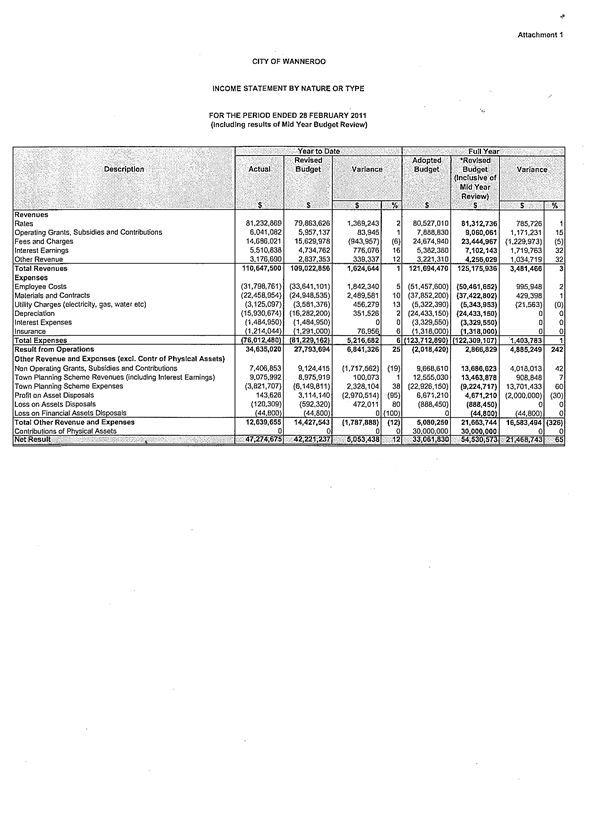
CITY OF WANNEROO Agenda OF Ordinary Council Meeting 05
April, 2011 360
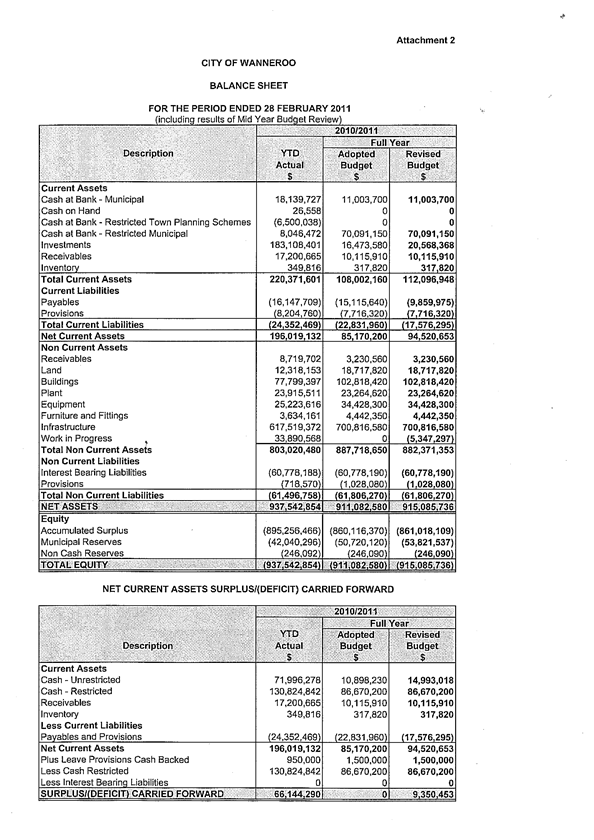
CITY OF WANNEROO Agenda OF Ordinary Council Meeting 05
April, 2011 361
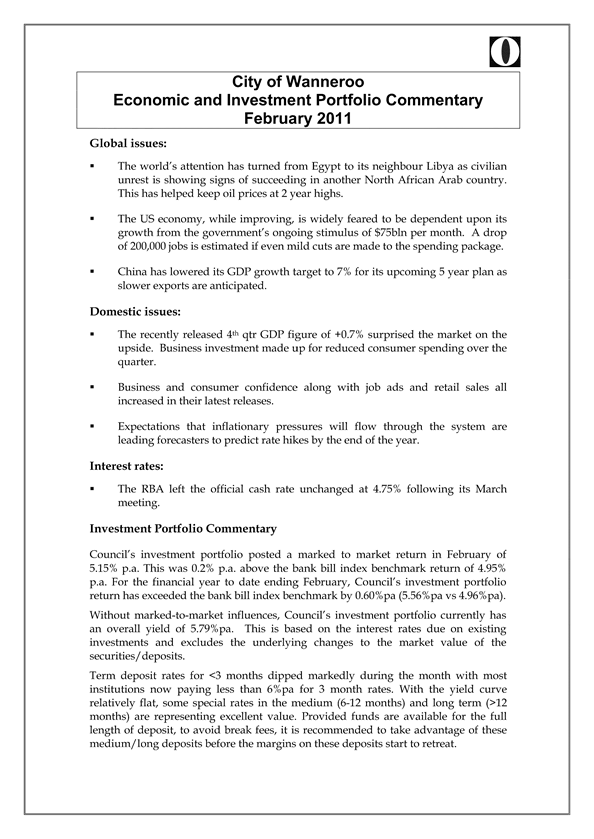

CITY OF WANNEROO Agenda
OF Ordinary Council Meeting 05 April, 2011 363
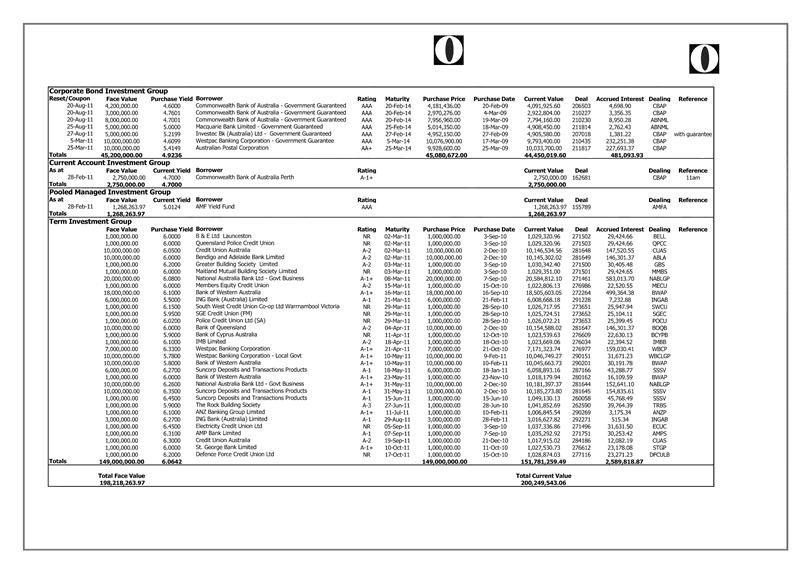
CITY OF WANNEROO Agenda
OF Ordinary Council Meeting 05 April, 2011 364
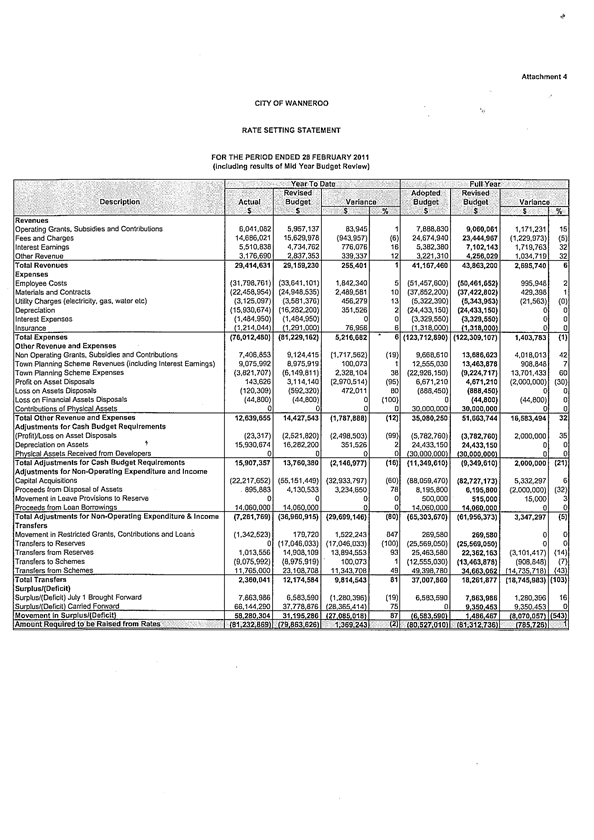
CS02-04/11 Budget
Workshop 1 - Capital Budget 2011/12
File Ref: 4113
– 11/30596
Responsible
Officer: Director, Corporate Strategy and Performance
Disclosure
of Interest: Nil
Attachments: 1
Issue
To consider key issues to guide the development of the
2011/12 Budget.
Background
The 2011/12 Budget is scheduled to be presented for final
adoption at the Special Council meeting on Friday 3 June 2011, however it is
good practice to progressively present a report to Council for consideration of
key strategic elements in the budget development process. The subsequent
guidance provided to Administration will ensure that the budget development
progresses smoothly and in a very transparent manner.
This process commenced with a report dealing with Budget
Principles and Parameters 2011/12 (CS01-03/11) considered by Council on 8 March
2011. As a result, the following resolution was adopted:
“That COUNCIL:
1. REAFFIRMS
its Budget Principles adopted in 2010 to guide the Annual Budget Development
Process for 2011/2012 and review of the 10 Year Strategic Financial Management
Plan 2011/2012 to 2020/2021, being -
a) The
budget shall be prepared consistent with the Best Practice Rating Strategy as
detailed in the PWC report;
b) The
aim is to achieve a ‘balanced’ operating budget (Improved actual
performance will enhance the closing position);
c) Extraordinary
income (such as proceeds from sale of land) shall not be used as a source of
funds in the same financial year as it is proposed to be received. (Funds will
be deposited in a Reserve to be called on in subsequent years);
d) The
budgeted income for Investments shall be based on an average market return as
measured against the UBS Warburg 90 Day Bank Bill Index and/or the Cash Rate
(unless a higher level is certain);
e) The
rate setting strategy for the next ten financial years be based on a rate in
the dollar increase of CPI plus 3-6% as supported by the Price Waterhouse
Coopers report “Western Australian Local Government Association Rate
setting processes, funding amenity and service sustainability of WA outer
metropolitan growth councils”;
f) The
adoption of the ‘expenditure by category’ table to reflect the
Municipal funding capacity;
g) Explore
opportunities to increase the level of commercial return from Facilities
through broadening the range of products and services provided; and
h) In
developing each successive annual budget, opportunities will be explored to
achieve operational efficiencies across the organisation.”
The 2011/12 Budget timetable
includes the following Budget Workshops with Elected Members:
·
Budget Workshop 1 –
Tuesday 22 March 2011
·
Budget Workshop 2 –
Tuesday 12 April 2011
·
Budget Workshop 3 –
Tuesday 17 May 2011
Detail
On Tuesday 22 March 2011, Budget Workshop 1 was held with
Elected Members. Administration provided detailed budget documentation,
which addressed the following areas:
Budget Environment Commentary
This section plotted the progress since 2009, noting the
following:
· In
May 2009 the Reserve Bank of Australia released its Statement of Economic
Policy. The statement outlined the RBA’s analysis of the economy,
progress of the recession and forecasted economic outlook. Generally it
reflected cautious optimism on the progress and impact of the Global Financial
Crisis (GFC) on the Australian economy, but stressed that recovery will be
gradual and could be set back by further stress in the financial markets.
It was within this context that the 2009/10 Budget and 10 Year Financial Plan
was developed, recognising a reduction in activity and flow on impact to the
City’s income generating capacity.
· In
2009/10, the Australian economy proved to be resilient and managed to avoid a
technical recession whilst many other developed countries around the world
suffered significantly. Locally, despite the uncertain economic
environment, the City substantially outperformed its budgeted position,
delivering an improvement in the Operating Result.
· When
developing the budget for 2010/11, the national and global economic environment
was again scrutinised. It was noted that the Governor of the RBA made the following
statement on 2 March 2010 when advising of the Board’s decision to raise
the official cash rate:
“Global financial markets
are functioning much better than they were a year ago and the extraordinary
support from governments and central banks is gradually being wound back.
Credit conditions remain difficult in some major countries as banks continue to
face loan losses associated with the period of economic weakness. Concerns
regarding some sovereigns remain elevated.
In Australia, economic
conditions in 2009 were stronger than expected, after a mild downturn a year
ago. The rate of unemployment appears to have peaked at a much lower level than
earlier expected. Labour market data and a range of business surveys suggest
growth in the economy may have already been at or close to trend for a few
months.
Inflation has, as expected,
declined in underlying terms from its peak in 2008, helped by the fall in
commodity prices at the end of 2008, a noticeable slowing in private-sector
labour costs during 2009, the rise in the exchange rate and the earlier period
of slower growth in demand. CPI inflation has risen somewhat recently as
temporary factors that had been holding it to unusually low rates is now
abating. Inflation is expected to be consistent with the target in 2010.
The Board judges that with
growth likely to be close to trend and inflation close to target over the
coming year, it is appropriate for interest rates to be closer to average.
Today’s decision is a further step in that process.”
·
Whilst there were signs of recovery, both internationally and
nationally, caution was generally being recommended. Despite confidence
returning and a potential recovery, that might have an impact on growth, this
in itself was unlikely to change the underlying performance of the City in the
short term. It was within this context that the 2010/11 Budget was developed
and 10 Year Financial Plan was reviewed and revised. As with the previous year,
it recognised another year of subdued activity and flow through impact to the
City’s income generating capacity.
· On
1 March 2011, RBA’s Board decided to leave the cash rate unchanged at
4.75 per cent. The Governor Glenn Stevens made the following commentary in
relation to the current monetary policy:
“The
global economy is continuing its expansion, led by very strong growth in the
Asian region. Commodity prices have risen further over recent months, pushing
up measures of consumer price inflation in many countries. A number of
countries have been moving to tighten their monetary policy settings. Overall,
though, financial conditions for the global economy remain accommodative.
Australia's
terms of trade are at their highest level since the early 1950s and national
income is growing strongly. Private investment is picking up, mainly in the
resources sector, in response to high levels of commodity prices. In the
household sector thus far, in contrast, there continues to be caution in
spending and borrowing, and a higher rate of saving out of current income. The
effects of the natural disasters over the summer have reduced output, but
production levels should recover over the months ahead, and there will be a
mild boost to demand from the rebuilding efforts as they get under way.
Inflation
is consistent with the medium-term objective of monetary policy, having
declined significantly from its peak in 2008. These moderate outcomes are being
assisted by the high level of the exchange rate, the earlier decline in wages
growth and strong competition in some key markets, which have worked to offset
large rises in utilities prices. Production losses due to weather are
temporarily raising prices for some agricultural produce, but these should fall
back later in the year. Overall, looking through these temporary effects, the
Bank expects that inflation over the year ahead will continue to be consistent
with the 2–3 per cent target.
At
today's meeting, the Board judged that the current mildly restrictive stance of
monetary policy remained appropriate in view of the general macroeconomic outlook.”
· Whilst
internationally, there have been major events of a political and environmental
nature that are having an impact on the wider economy, at this stage they are
seen as a temporary influence and not likely to stall the recovery being
experienced across most markets.
· Locally,
the City has recently finalised the Mid Year Budget Review for 2010/11, which
was adopted at the 8 March 2011 Council meeting (CS02-03/11). In terms of
the City’s normal operations, it is indicatively reflecting a substantial
improvement to the forecast Operating Result. The Capital Works Program
was reduced by $3.453 million, which primarily equates to a reduction in
Reserves drawdown and therefore remains as a funding opportunity for the
revised 10 Year Capital Works Program. Overall, it is anticipated that
based on the improvements forecast, the end of year position will provide for a
stronger Reserve position to be carried forward to 2011/12.
Current Performance – Growth and Statistics
At Wanneroo, the following Growth areas are materially
relevant:
1.
Growth in the overall number of “Created
Lots” which translates to rateable properties. For the first six
months, the City experienced approximately 3% increase in Lots, which equates
to an annualised growth rate of approximately 6% (3200 Lots).
2.
Growth in the number of “Developed Lots”,
that is Lots with a completed dwelling. Recent review reflects a 2.7% increase
over the preceding six months, which equates to an annualised growth of 5.4%
(2900 homes).
3.
Growth in population drives the demand on
infrastructure and services. There is a direct link between Developed Lots and
resident population, therefore it is estimated that the City’s population
will grow by approximately 5.2% during 2010/11. Assuming this growth trend
continues, the City’s population is forecasted to be in the vicinity of
160,000 by June 2011 and 168,000 by June 2012.
The Perth CPI increase to December 2010 was a little below
expectations and has been influenced by a high Australian dollar positively
affecting import prices, which has offset other more staple household expenses.
However, it is anticipated that once the floods have been factored into future
quarters, a return to CPI in the order of 3% is feasible.
|
SUMMARY OF GROWTH
FACTORS
|
|
|
BUDGET
|
CURRENT
|
FORECAST
|
|
Created Lots
|
4%
|
5%
|
5%
|
|
Developed Lots
|
4%
|
5%
|
5%
|
|
Roads
|
5%
|
5%
|
5%
|
|
CPI
|
2.5%
|
2.6%
|
3%
|
The previous Table demonstrates that despite the GFC, there
was still reasonable activity in the land development sector, which has a flow
on impact to the City. Importantly, the growth factors employed in the
2010/11 Budget closely align to the actual performance to date.
Draft 10 Year Capital Works Program (2011/12 –
2020/21)
In June 2010,
Council adopted the 2010/11 Annual Budget, incorporating the 10 Year Capital
Works Program (2010/11 – 2019/20). In preparing for the 2011/12
Budget, it is necessary to review the 10 Year Capital Works Program to verify
priorities, costing, funding opportunities and also to add the new year 10
(2020/21). Accordingly, the Draft 10 Year Capital Works Program 2011/12
– 2020/21 as presented to Budget Workshop 1 provided for a total of $349
million to be expended on projects over the next 10 years, averaging $35
million each year.
In respect to Year 1, being
2011/12, the draft included a total of $35 million, which reflects a reduction
of $10.8 million on what was previously indicated in the adopted 10 Year
Capital Works Program. A list of major amendments to the Program was
provided (see Attachment 1), which identified specific projects
that have been adjusted within the 10 Year Program. Importantly, the
Budget Principle of ‘renew before new’ is reflected in the figures
depicted in the following table and throughout the 10 Year Program:
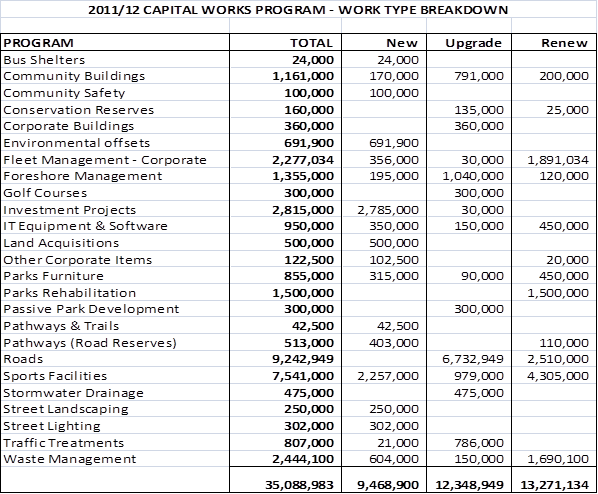
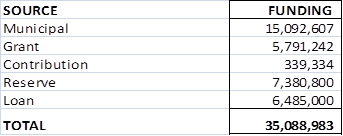
In considering the funding requirements
identified in the Draft 2011/12 Capital Works Program, a number of important
issues were identified:
1. Sufficient
Municipal funding is anticipated to be available, however as noted previously,
adjustments are required to the Expenditure by Category table to increase the
proportion to meet the ‘Upgrade’ component of the works program;
2. In
some instances, where Grant funding is being sourced, Council will need to
define during the budget adoption process as to whether the project will
progress regardless of whether grant funding applications are successful or
not; and
3. Adjustments
have been made to the Loan Funded projects, which will need to be formally
endorsed by Council during the budget adoption.
New Strategic Initiatives
Whilst the 10 Year Financial Plan has a 3% growth factor
built in, that primarily addresses the ‘organic’ growth of the
organisation to match growth-based demand, there are times when Council may
wish to vary its standards or introduce new services. Funding is provided
for this within the Expenditure by Category table. A total of 8
initiatives were presented at Budget Workshop 1, as detailed below:
· Development of
Strategic Community Plan and Corporate Plan
· Additional Focus
on Compliance – Regulatory Services
· Planning
Implementation compliance Officers
· Development of an
Integrated Customer Centre
· Verge Litter and
Verge Illegal Dumping Collection
· Community Safety
Patrol & Ranger Service Model
· Bulk Diesel Fuel
Tanks at Ashby Operations Centre
· Short-Term
Administration Accommodation & Long-Term Administration Accommodation
& Local Government Boundaries
The demand for the Initiatives can be broken down into the
following categories:
· Five initiatives
relate to proposals for Council to consider strategically increasing service
standards, which could be termed discretionary services;
· one being a long
term cost efficiency proposal;
· one being a
strategic initiative supported by proposed changes to Regulations; and
· the final
initiative seeks to inform Council on a strategy to meet the short and long
term workforce requirements of the City.
In these instances, the Expenditure by Category table
provides a funding opportunity through the Operational Growth and Discretionary
categories. The Municipal funding demand arising from the above
initiatives is in the vicinity of $1.7 million, including Capital and Operating
requirements with one project potentially funded from Reserves, which could
reduce the Municipal requirements to $1.3 million if deemed necessary.
The New Initiatives will be
further reviewed at Workshop 3, once the preliminary Operating Budget has been
reviewed at Workshop 2.
Elected Member Requests
A list of projects/works
requested by Elected Members was presented at Budget Workshop 1 with relevant
Administration comments. Further investigation will be undertaken on a
number of items with additional information provided and funding implications
presented at Budget Workshop 3.
Budget Principles
As with the current budget, the
development of the 2011/12 Annual Budget and review of the 10 Year Strategic
Financial Management Plan will be guided by the adopted Budget Principles.
As guided by the Local
Government Act and further supported by the WALGA SSS report and the
Department's Accounting Manual, best practice financial management must aim for
a balanced budget with major annual municipal funding for Capital Works
equating to the annual Depreciation figure (a non cash expenditure item).
Following the above said
compliance requirement, the original strategic principle of "Expenditure
by Category" (Budget Principle (f)) was developed in 2009 based on the
Depreciation budget of $22 million for 2009/10. The City's Depreciation
expenses increase by approximately 10% annually, hence the latest funding model
can be adjusted by +20% projecting the Municipal funding capacity to be in the
vicinity of $26.4 million for 2011/12.
When developing the
“Expenditure by Category” funding model in 2009, the following
circumstances prevailed:
1. The
City had in recent years undertaken substantial new infrastructure projects,
for example: Construct Wanneroo Library and Cultural Centre, Redevelop Wanneroo
Townsite and commencement of the Upgrade Kingsway Regional Sporting Complex.
2. In
accordance with the Council resolution of IN02-03/09 Infrastructure Asset
Management Renewal Gap Analysis, Council endorsed the concept of “Renew
before New” for the development of the draft 10 Year Capital Works
Program providing an annual budget averaged at $6 million for the first 5
years.
3. International
economy was gloomy. The City’s 10 Year Financial Plan projected a
shrinking revenue environment for the first 5 years and Budget parameters were
guided by low CPI (1.5-2.5%), low growth (around 4%) and low interest rate
(2-3%) predictions. Hence it was considered that Operational Growth and
Discretionary (non assets) expenditures would most probably be required to be
funded by Depreciation components instead of additional Operating revenues.
The constraint imposed by the
‘Expenditure by Category’ funding model was particularly relevant
at the time and essential to promote a more financially sustainable position,
particularly to prioritise the funding for the ‘renew before new’
principle and establish a repayment plan for the City’s $60m loan
borrowing.
In incrementing the overall
funding level to reflect the level of depreciation linked to asset growth, there
is merit in reassessing the distribution within the model.
The draft 2011/12 Capital Works Budget has been revised down
to $35.1 million, with a Municipal funding requirement of $15.1 million.
The Municipal funding for Year 1 can be accommodated by the following
adjustment to the Expenditure by Category model.
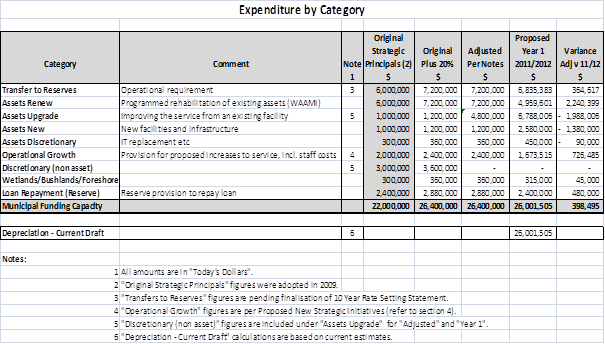
Consultation
The Draft 2011/12 Capital Works Program and related 10 Year
Capital Works Plan was presented at Budget Workshop 1 on Tuesday 22 March 2011.
Comment
The adoption of Budget Principles and application of prudent
budget practices has enabled the City to improve its financial sustainability
even through a period of financial instability.
As an appropriately conservative approach has been taken in
the budget development over recent budgets, the City’s current
performance is reflecting an improvement, essentially due to the better than
anticipated performance of the local economy, impacting positively on income
and significant constraint being exercised by Administration across operational
expenditure areas.
Whilst the full financial position will not ultimately be
known until Budget Workshop 3, Administration is confident that normal
operational growth for 2011/12 can be sustained and that the funding
requirements for the Capital Works Program and New Initiatives is within
expectations and can be achieved consistent with the Budget Principles.
Whilst the budget development process relies on effective
communication throughout the Budget Workshop process, it is recognised that
those forums have limited capacity and therefore periodic review by Council is
prudent to provide formal guidance to Administration and demonstrate open and
transparent governance.
Following each of the Workshops, reports will therefore be
presented to Council for consideration and support for the ongoing budget
development, prior to the Special Council meeting.
Statutory
Compliance
The Budget development process will be undertaken in strict
compliance with the Local Government Act and relevant accounting standards.
Strategic
Implications
The proposal accords with the following Outcome Objective of
the City’s Strategic Plan 2006 – 2021:
“4 Governance
4.4 Maintain
long-term financial stability”.
Policy
Implications
Nil
Financial
Implications
Nil
Voting
Requirements
Simple Majority
Recommendation
That Council:-
1. NOTES
the following in respect to the Draft 10 Year Capital Works Program as
presented at Budget Workshop 1:
a) 2011/12
Capital Budget projects a total expenditure of $35.1 million (subject to
further adjustment) with a Municipal funding requirement of $15.1 million;
b) The
new Strategic Initiatives will now be incorporated into the Draft Operating
Budget and Draft Capital Works Budget for presentation at Budget Workshop 2 and
3; and
c) Items
raised for further review during Budget Workshop 1 will be presented at Budget
Workshop 3.
2. SUPPORTS
amending the Expenditure by Category table to increase the proportion of
funding to the ‘Asset Upgrade’ category by reducing the
‘Discretionary’ category as detailed below:
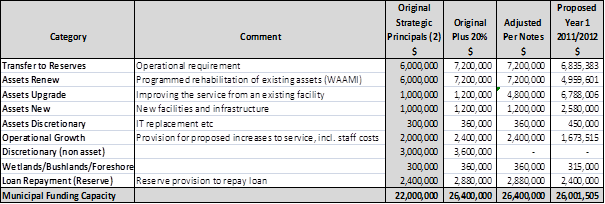
CITY OF WANNEROO Agenda
OF Ordinary Council Meeting 05 April, 2011 374
MAJOR
AMENDMENTS TO 10 YEAR CAPITAL WORKS PROGRAM
(2011/12
to 2020/21)
1. Yanchep Surf Life Saving Club
(PR-1048)
Stage 1
construction with $1.5 million budget is pushed back 1 year from 2011/12.
2. Kingsway Shopfront Library (New)
This proposal is for
STAGED development of a library branch at Kingsway Shopping Centre. The
proposed site is 1000 sqm with the potential for expansion to the second level
of the site. Project tasks include design, construct and fit-out. Proposed
budget is $2 million for year 3 and $2.6 million for year 4, with $2.6 million
loan funding, $1.5 million Grants and $0.5 million from developers subject to
land swap valuations.
3. Girrawheen Library Upgrade (New)
Funds have already been
allowed in year 3 and 4 of the existing 10 Year Capital Works
Program to the amount of $500,000 and $200,000 respectively. Subject to extent
of upgrade works to be undertaken through refurbishment and expansion of site,
this submission budgeted for an additional $500,000 in year 3 of Grants funding
and for year 4 an additional $300,000 in municipal funding with an additional
$500,000 in Grants.
4. Community Safety (New)
· A 10 Year Program with
$50,000 budget each year is proposed for crime prevention through environmental
design projects commencing from 2011/12;
· $50,000 budget for
2011/12 is proposed for provision of lighting in the car park and toilet block
in conjunction with rangers security measures put in place for Ian Robbins
Park; and
· The new initiatives to
improve community safety were previously budgeted for $150,000 each second year
from 2012/13 to 2018/19 inclusive. The program is now expanded to $200,000 each
year for 2012/13, 2014/15, 2016/17, 2018/19 and 2020/21 totalling to $1
million, in every second year.
5.
Carramar Golf Course (PR–1041)
An
amount of $100,000 is recommended to be included in 2011/12 Budget for a
consultancy to investigate modifications to the 10th and 18th
holes of Carramar; subject to a report being presented to Council on the
outcomes estimated costs and funding sources.
6.
Neerabup Industrial Area (PR-1006)
According
to the latest progress of the development of this strategic industrial area, it
is recommended to reduce 2011/12 Budget from $4.4 million to
$2.5 million and provide additional $2 million for Years 2-5. This is a vital
project to service the Northern Corridor and sufficient funds are required to
set aside, to ensure essential Infrastructure and utility services be provided,
as well as engaging various stakeholders. With this project able to be
self funded, previously identified loan funding will be redirected to other
strategic projects.
7. Pinjar Road – Ashby Upgrade
(New)
Staged Construction of first
carriageway between Wanneroo Road and Tapping Street with proposed budget of
$1.2 million funded by Municipal. Completion of project staged over a number of
financial years.
8. Houghton Park – Carramar (New)
Stage 1 construction is brought forward to 2011/12 with stage 2 still in
2013/14. Current budget is $700,000 with $367,000 from Municipal. Application
made for CSRFF Grant of $333,000. Consideration needs to be given if the
project will still proceed in the event of Grant application not being
successful.
9. Plant
& Vehicle Purchases
Various
reductions have been made to projects relating to plant and vehicle purchases,
resulting from a thorough review of needs based on current and forecast service
levels. Being that the funding of these purchases will be from Reserves,
there will be no effect to Municipal Funds. Major reductions are
identified for: Light Vehicle Replacement $1.072 million, Domestic Waste Plant
Replacement $2.541 million, Domestic Waste Vehicle Purchases $0.720 million and
Commercial Waste Plant Replacement $0.359 million.
10. Lenore
Road – Kemp Street to High Street (PR-2097)
The
original budget identified for this project for 2011/2012 ($3.225 million) is
to be pushed back one year to 2012/2013, due to land acquisition issues.
Subsequently, future years’ budgets will also be delayed for this
reason.
Governance and Executive Services
CS03-04/11 Donations
to be Considered by Council - April 2011
File Ref: 3626
– 11/27493
Responsible
Officer: Director, Corporate Strategy and Performance
Disclosure
of Interest: Nil
Attachments: Nil
Issue
To consider requests for sponsorships, donations and waiver
of fees in accordance with the City’s Donations, Sponsorships and Waiver
of Fees and Charges Policy.
Background
The Donations, Sponsorships and
Waiver of Fees and Charges Policy requires applications over $500 from
individuals and organisations to be determined by Council. Consequently a
report is prepared for Council meetings, coinciding with a period where
applications of this nature have been received.
With respect to requests for sponsorships, the City’s
Policy specifies that for National Events the amount provided will be $200.00
per individual, capped at $600.00 per team, and for International Events the
amount provided is $500.00 per individual with no capped amount.
Detail
During this period, the City has received one sponsorship
request, one community donation request and no requests for a waiver of fees and
charges, which are summarised as follows. Copies of the full applications are
available from Governance upon request.
Comment
Council’s attention is drawn to the fact that of the
$95,000 allocated to Sponsorships, Donations and Waiver of Fees and Charges in
the 2010/11 Budget, ($20,000 of which was added at the 8 February 2011 Ordinary
Council Meeting and $15,000 at the 8 March 2011 Ordinary Council Meeting) a
total of $70,708.85 has already been expended, leaving $24,291.15 to cover all
further requests that may be received prior to 30 June 2011.
Sponsorship
Donations
|
Applicant 1 – School Sport WA
|
|
Name of Individual/s
|
Alicia Buchanan, Kimberley Hallett and Zack Gray
|
|
Reside in City of Wanneroo
18years of age or under
|
Yes
Yes
|
|
Event Details
|
National Schools Triathlon Championships, 29 March to
1 April 2011, Redcliffe QLD
|
|
Commitment to providing a written report regarding the
event
|
Yes
|
|
Commitment to acknowledgement of the City of Wanneroo
|
Yes
|
|
Eligibility Level
|
National - $200 per individual, capped at $600 per
team.
|
|
Comments
|
The application is in accordance with Council’s
policy.
|
|
Recommendation
|
APPROVE a request for sponsorship in the sum of
$600.00 to School Sport WA for the participation of Alicia Buchanan,
Kimberley Hallett and Zack Gray in the National Schools Triathlon
Championships to be held from 29 March to 1 April 2011, in Redcliffe QLD
|
Community
Group Donations
|
Applicant 1 – Shuhari Karate
|
|
Request amount
|
$340.00
|
|
Description of request
|
50% Waiver of fees for the hire of the Phil Renkin
Centre for a martial arts demonstration by Kobudo Masters from Okinawa, Japan
from 23-28 February 2011.
|
|
Criteria
|
Evaluation
|
|
Potential for income generation
|
Nil
|
|
Status of applicant organisation
|
Community commercial group
|
|
Exclusivity of the event or project
|
Open to the public
|
Alignment with Council’s existing philosophies,
values and strategic direction
|
Objective 2.2 – Improve the City’s
identity and community well-being through arts, culture, leisure and
recreation.
Objective 3.2 – Support business and
initiatives.
|
|
Alternative funding sources available or accessed by
the organisation
|
Nil
|
|
Contribution to the event or activity made by the
applicant or organisation
|
$341.00
|
|
Previous funding assistance provided to the
organisation by the City
|
Nil
|
|
Commitment to acknowledge the City of Wanneroo
|
Yes
|
|
Comments
|
This group offers karate and kobudo training at
community centres in Yanchep, Butler and Carramar at a third of the price of
commercial clubs. Whilst it is still a commercial enterprise, it does
make this training more affordable for City of Wanneroo residents that may
not otherwise be able to afford to send their children to learn karate.
The visit by Japanese Masters is a unique and free opportunity for residents
that Council may wish to support.
|
|
Recommendation
|
NOT APPROVE a 50% waiver of fees of $340.00 for the
hire of the Phil Renkin Centre for a martial arts demonstration by Kobudo
Masters from Okinawa, Japan from 23-28 February 2011.
|
|
Reason
|
This request does not satisfy the criteria of the policy.
|
Statutory
Compliance
Nil
Strategic
Implications
The proposal accords with the following Outcome Objective of
the City’s Strategic Plan 2006 – 2021:
“2 Social
2.2 Improve
the City’s identity and community well-being through arts, culture,
leisure and recreation”
“3. Economic
3.2
Support business and initiatives.”
Policy
Implications
The City of Wanneroo Donations, Sponsorship and Waiver of
Fees and Charges Policy states that sponsorship applications for attendance at
National Events will be capped at $600.00 per team and Regional or State capped
at $600 per club.
Financial
Implications
|
Budget 2010/2011
|
|
$95 000.00
|
|
Amount expended to date (as at 15 March 2011)
|
|
$70,708.85
|
|
Balance
|
|
$24,291.15
|
|
Total of requests for this round:
Donations (in this report):
Total this Round
|
$600.00
|
$600.00
|
|
CARRY FORWARD
|
|
$23,691.15
|
Voting
Requirements
Simple Majority
Recommendation
That Council:-
1. APPROVE
a request for sponsorship in the sum of $600.00 to School Sport WA for the
participation of Alicia Buchanan, Kimberley Hallett and Zack Gray in the
National Schools Triathlon Championships to be held from 29 March to 1 April
2011, in Redcliffe QLD; and
2. NOT
APPROVE a 50% waiver of fees of $340.00 for the hire of the Phil Renkin Centre
for a martial arts demonstration by Kobudo Masters from Okinawa, Japan from
23-28 February 2011.
CS04-04/11 Review
of Certificate of Recognition - Elected Members Policy
File Ref: 2409
– 11/27801
Responsible
Officer: Director, Corporate Strategy and Performance
Disclosure
of Interest: Nil
Attachments: 1
Issue
To consider amendments to the Certificate of Recognition
– Elected Members Policy.
Background
The
Certificate of Recognition – Elected Members Policy was first adopted by
Council in 2004, and was last reviewed by Council at its meeting on 10 March
2009 (GS02-03/09). The Policy was scheduled for review in January 2011.
Detail
The Certificate of Recognition – Elected Members
Policy has been reviewed, with some minor amendments being identified with
respect to updating of Departmental and Directorate titles. It is also
proposed to amend the policy title to “Recognition – Elected
Members”.
The primary amendment being proposed is the inclusion of a
provision to allow for the invitation of former Elected Members (and their
partners) of the current City of Wanneroo (post-1999) who have served three
consecutive terms of office or 12 consecutive years to the following annual
civic functions:
· Pioneer
function;
· Volunteer
function;
· Australia
Day Citizenship function;
· Freeman
of the City Induction Ceremonies; and
· City
of Wanneroo Art Awards.
Consultation
This matter was discussed at the Council Forum held on 22
February 2011, at which time there was broad support for the ongoing
recognition of the contributions of past Elected Members through invitation to
a range of civic functions.
Comment
Administration has now concluded its review of the Policy
for Council’s consideration. A copy of the Policy showing the
proposed amendments is included as Attachment 1.
Statutory
Compliance
Local Government Act 1995
Part 2 – Constitution of local government
Division 2 – Local governments and councils of local
governments
“2.7 Role
of council
(1) The
council –
(a) governs
the local government’s affairs; and
(b) is
responsible for the performance of the local government’s functions.
(2) Without
limiting subsection (1), the council is to –
(a) oversee
the allocation of the local government’s finances and resources; and
(b) determine
the local government’s policies.”
Strategic
Implications
The proposal accords with the following Outcome Objective of
the City’s Strategic Plan 2006 – 2021:
“4 Governance
4.6 Provide
and maintain a high standard of governance and accountability”
Policy
Implications
This review will result in amendments to the City’s
current Certificate of Recognition – Elected Members Policy.
Financial
Implications
There are no financial implications associated with the
proposed amendments to the Policy, outside of the normal “per head”
costs associated with attendances at all civic functions.
Voting
Requirements
Simple Majority
Recommendation
That Council ADOPT the amended Recognition –
Elected Members Policy as shown in Attachment 1.
CITY OF WANNEROO Agenda
OF Ordinary Council Meeting 05 April, 2011 382
Certificate of Recognition – Elected Members
Policy
Owner: Governance
and Executive Services
Contact
Person: Coordinator
Governance and Executive Services
Date
of Approval: 20
June 2004 (CE01-07/04)
POLICY OBJECTIVE
The purpose of this policy is to specify the circumstances
in which to acknowledge the services of current or retiring elected members so
that they are appropriately recognised for their contributions.
POLICY STATEMENT
In order to enable the City to
appropriately recognise elected members, the following is presented:
Department of Local
Government Certificates of Recognition
· A certificate of recognition will be awarded to a current or former
elected member, on request to the Department of Local Government and
Regional Development, after eight or more years of service and which has
been confirmed by the local government;
· The service need not be continuous and may be with one or more local
governments;
· If an elected member, having been issued with a Certificate, has
further service that qualifies, i.e. a further eight years or more, an
additional Certificate will be issued; and
· Details on a Certificate will include the period served by the
elected member as mayor/president, deputy mayor/ president or councillor.
Requests for
certificates will be made to the Department by the City on behalf of the
elected member. Certificates issued to current elected members who
have served for more than eight years will recognise all their years of service however, once a Certificate has been issued,
another will not be provided for any period less than a further eight years.
It is
therefore suggested that an Eelected
members who has have qualified for a certificate by,
having been serving on council for eight years, but who intends to
continue for another term, will therefore be requested to defer their
application for a certificate until such time as their term is completed or
they retire from council. This will allow the service details to be on
one certificate.
The Department
of Local Government and Regional Development will recognise the number of years served by
issuing certificates that are colour coded, i.e.
White: 8
to 16 years of service
Silver: 17
to 24 years of service
Gold: 25
years or more.
Presentation
of Commemorative Plaques and Gifts
In addition to
the Certificate issued by the Department of Local Government and Regional
Development, the elected member will be presented, on retirement, with:
· With a A plaque of the Council crest and
an engraved plate identifying the name of the elected member and the years of
service to Council;
· A gift to the value of $80 per year for
Councillors and $100 per year for Mayors for each year
of service capped at a maximum of $500;
Presentations
will occur at either one of the following Council functions:
· Prior to a normal, scheduled Council meeting; or
· By the Mayor or his nominee; or
· As approved by the Mayor and Chief Executive Officer.
The retiree is
to have the option of choice.
For the
position of Mayor, in addition to the Department of Local Government and
Regional Development Certificate of Recognition, a suitable gift and
reception will be arranged by the Chief Executive Officer in conjunction with
the Deputy Mayor.
Procedure:
Invitation to Civic Functions Following Retirement from
Council
Invitations will be issued to past elected members (and
their partners) of the current City of Wanneroo (post-1999) who have served
three consecutive terms of office or 12 consecutive years to the following
annual civic functions:
· Pioneer
function;
· Volunteer
function;
· Australia
Day Citizenship function;
· Freeman
of the City induction ceremonies; and
· City
of Wanneroo Art Awards.
SCOPE
This policy applies to retiring and former elected
members of the City of Wanneroo.
BACKGROUND
There is
relatively little recognition and support for people who are prepared to be
members of council and, as a result, make a significant contribution to their
communities.
With this
in mind, in 2004 Tthe
Department of Local Government and Regional Development has therefore
reduced the qualifying period for the receipt of a Certificate of Recognition
to 8 eight years.
CONSULTATION WITH STAKEHOLDERS
Nil
IMPLICATIONS (Financial, Human
Resources)
Nil
IMPLEMENTATION
1. The
City’s Governance team will monitor the terms of service of individual
elected members.
2. A
letter of recognition will be sent by the Chief Executive Officer to the
a qualifying elected member acknowledging their term of service and
clarifying whether the elected member wishes to claim their certificate at this
time or whether they prefer to postpone receipt until retirement. The
letter to detail the Department’s advice regarding postponement until
retirement.
3. A
request will be made to the Department detailing the elected member’s
full name and period of service as mayor/president, deputy
mayor/president or councillor.
4. The
Department will process the application and obtain the Minister’s
signature. The Certificate will be posted back to Council for
presentation to the elected member as described above.
5. The
Chief Executive Officer will arrange the City of Wanneroo Plaque and gift.
6. The
City’s Communications and Events unit will be responsible for issuing
invitations to past elected members and their partners to attend those civic
functions identified by this policy.
ROLES and RESPONSIBILITIES
See Implementation above.
DISPUTE RESOLUTION
N/A
WHO NEEDS TO KNOW about THIS POLICY?
· Elected
Members
· Chief
Executive Officer
· Manager
Governance and Executive Services
· Manager
Communications and Events
· Coordinator
Governance
· Coordinator
Communication and Events
DEFINITIONS
|
DEFINITIONS: There are no definitions for this policy.
|
RELEVANT POLICIES/MANAGEMENT
PROCEDURES/DOCUMENTS OR DELEGATIONS
Nil
REFERENCES
· Policy
- Award of the Title “Honorary Freeman of the City of Wanneroo”
· Policy
- Award of the Title “Wanneroo Pioneer”
· Policy
– Australia Day Award
RESPONSIBILITY FOR IMPLEMENTATION
Manager Governance and Executive
Services
|
Version
|
Next Review
|
Record No:
|
|
March 2011
|
March 2013
|
11/27818
|
|
|
|
|
|
|
|
|
CS05-04/11 Amendment
to Australia Day Award Policy
File Ref: 2409
– 11/27889
Responsible
Officer: Director, Corporate Strategy and Performance
Disclosure
of Interest: Nil
Attachments: 1
Issue
To consider an amendment to the Australia Day Award Policy.
Background
The City’s current Australia Day Award Policy was
adopted by Council in June 2006 and was last reviewed by Council in May 2010
(CS05-05/10).
Detail
The Australia Day Award Policy is proposed to be amended to
include:
1. A
provision that enables an invitation to be extended to the immediate past
recipients of the Australia Day Citizen of the Year Award (and their partner),
the Australia Day Youth Citizen of the Year Award (and their guardian) and the
Australia Day Community Group of the Year (President and partner) to attend the
next Australia Day Awards Ceremony; and
2. A
requirement to publish details of Australia Day Awards recipients in the first
available edition of “What’s Happening” following the awards
ceremony.
Consultation
This matter was discussed at the Council Forum held on 22
February 2011, where Elected Members were advised that a report would be
prepared for Council’s consideration.
Comment
The amended Policy document is included as Attachment 1
for Council’s consideration.
Statutory
Compliance
Local Government Act 1995, Part 2 – Constitution of Local
Government, Division 2 – Local Governments and Councils of Local Governments
“2.7 Role
of council
(1) The
council –
(a) governs
the local government’s affairs; and
(b) is
responsible for the performance of the local government’s functions.
(2) Without
limiting subsection (1), the council is to –
(a) oversee
the allocation of the local government’s finances and resources; and
(b) determine
the local government’s policies.”
Strategic Implications
The proposal accords with the following Outcome Objective of
the City’s Strategic Plan 2006 – 2021:
“4 Governance
4.2 Improve
community engagement”
4.6 Provide
and maintain a high standard of governance and accountability”
Policy
Implications
This report recommends amendments to the City’s
current Australia Day Award Policy.
Financial
Implications
There will be a “per head” cost associated with
the attendance of previous Awardees at Australia Day ceremonies, as is the case
with all civic functions.
There will also be a cost associated with the publication of
details of Awardees in “What’s Happening”.
Voting
Requirements
Simple Majority
Recommendation
That Council ADOPT the amended Australia Day Award
Policy as shown in Attachment 1.
CITY OF WANNEROO Agenda
OF Ordinary Council Meeting 05 April, 2011 388
Australia Day Award Policy
Policy
Owner: Communications
and Events
Contact
Person:: Manager
Communications and Events
Date
of Approval: 5
May 2010 – CS05-05/10
OBJECTIVE
The purpose of this policy is to provide for the recognition of
individuals and organisations who have made significant contributions to the
City of Wanneroo’s community, through annual awards presented on
Australia Day.
STATEMENT
The City of Wanneroo annually recognises
individuals and organisations who have made a significant contribution to the
City of Wanneroo’s community by awarding three categories of awards every
Australia Day. Only one award is presented in each of the following categories:
City of Wanneroo Charles Searson
Australia Day Youth Award
Presented to an individual under 25 years
of age who has made an outstanding contribution to the local community.
City of Wanneroo Australia Day Award
Presented to an individual over 25 years of
age who has made an outstanding contribution to the local community.
City of Wanneroo Australia Day
Community Group or Event Award
Presented to an outstanding local community
group or event.
Details of Australia Day Award
recipients are published in the first available edition of “What’s
Happening” following the Award ceremony.
An invitation to attend the next
Australia Day Award ceremony is extended to the following:
· The recipient (and partner) of the City of Wanneroo Australia Day
Award
· The recipient (and guardian or partner) of the City of Wanneroo
Charles Searson Australia Day Youth Award
· The recipient (President/Chairperson and partner) of the City of
Wanneroo Australia Day Community Group or Event Award
SCOPE
Award recipients must meet the following eligibility
criteria:
· Recipients
must be residents of the City of Wanneroo; or have coordinated a community
event within the City of Wanneroo; or be members of a community group whose
principal activities are conducted within the City of Wanneroo
· Awards
cannot be granted posthumously
· A
person cannot receive the same award twice
· Only
one person (not a couple or group) may be nominated for individual award categories
· Local
Government Councillors, State and Federal politicians are not eligible to
receive an Award
· City
of Wanneroo staff acting in their role or performing duties required by their
employment with the City, are not eligible to receive an Award
BACKGROUND
Awards are presented at the annual ‘Australia Day
Citizenship Ceremony’ held 26 January. Award recipients are presented
with a framed certificate and ‘Australia Day Award Trophy’, and are
requested to participate in post-event publicity and promotion. Copies of
photographs taken as a result of publicity are provided to Award recipients
CONSULTATION WITH STAKEHOLDERS
As part of this policy, the following stakeholders need to
be consulted:
· Schools in the
City of Wanneroo;
· City of Wanneroo
community groups; and
· Media
organisations.
IMPLICATIONS (Financial, Human
Resources)
The financial implications for this policy include printing
of application forms and flyers, trophies, certificates and framing.
These costs are included as part of the Communications and
Events annual budget.
IMPLEMENTATION
Nominations are invited via advertising and promotions
preceding the annual ‘Australia Day Citizenship Ceremony’ held 26
January, but can be made at any time during the year. Anyone in the community
can submit a nomination and these are made in writing using the official
nomination form. Nomination forms can be obtained from the City of
Wanneroo’s website www.wanneroo.wa.gov.au,
Customer Service locations or by contacting Communications and Events.
In addition, students of schools within the City of Wanneroo
who are awarded Student Citizenship Award in the 12 months preceding the
Australia Day Awards, are automatically considered for the City
of Wanneroo Charles Searson Australia Day Youth Award.
Nominations will be advertised from September each calendar
year, with nominations closing 30 November. Judging will occur during December.
The September-November period will allow integration into
existing promotional activities targeted at people/groups active within the
community. These include but are not limited to: October Community Funding
round (nomination forms to be posted with application kits, and promoted at
information sessions); Volunteer Appreciation Functions (nomination forms to be
posted with invitations and promoted at the functions); Youth Services meetings
and activities with schools.
Nominees for the City of Wanneroo Australia Day Awards will
be assessed by a judging panel according to the following criteria:
· Have made a
significant positive contribution to the local community
· Possess leadership
qualities
· Active member of
the local community
· Commitment to
enhancing their local community
The judging panel: Mayor, Director Community Development,
Manager Communications and Events and two community members (expressions of
interest) then decide the winners.
ROLES AND RESPONSIBILITIES
The City’s Communications and Events team is
responsible for implementation of all elements of this policy.
Roles and responsibilities include calling for nominations,
promotion through the media, call for expressions of interest for the members
of the judging panel, compiling nominations, scheduling judging panel meetings,
organising awards and inviting nominees and nominators to the presentation
event.
WHO NEEDS TO KNOW ABOUT THIS POLICY?
· Mayor
· Director Community
Development
· Manager
Communications and Events
· Communications and
Events service unit
· Schools
· Community groups
EVALUATION AND REVIEW PROVISIONS
To measure and evaluate the effectiveness of this policy,
the following key performance indicators will be used:
· Number of
nominations received for each of the three categories.
· Quality of
nominations.
· Media exposures.
DEFINITIONS
There are no definitions for this policy.
REFERENCES
Nil
RESPONSIBILITY FOR IMPLEMENTATION
Manager Communications and
Events
|
Reviewed
|
Next Review
|
Record No
|
|
June
2006
|
|
|
|
May
2010 – CS 05-05/10
|
March
2012
|
888680
TRIM:
10/912
|
|
April
2011 – CS
|
March
2012
|
11/27894
|
CS06-04/11 Overview
of Proposed Structure of Internal Standards Panel
File Ref: 5720
– 11/27803
Responsible
Officer: Director, Corporate Strategy and Performance
Disclosure
of Interest: Nil
Attachments: 1
Issue
To consider, as part of a continuous improvement framework
for the City, and to support the Elected Members Code of Conduct, the
establishment of an Internal Code of Conduct Committee to assess complaints
regarding breaches of the general principles of behaviour of elected members.
Background
At the 29 June 2010 Council Meeting the following motion was
presented:-
“UB02-06/10 Standing
Orders and Code of Conduct
Moved Cr Guise,
Seconded Cr Monks
THAT this Council believes that when matters arise that
are pertinent to our Standing Orders and Code of Conduct, consistent with the
reasons given by Judge Pritchard “that neither the findings nor the
apology should be seen as the preferred method in dealing with differences of
opinion in Council”, Council believes that it is in the best interest of
good governance that in the first instance a reasonable effort is made to deal
with these matters in accordance with the City’s Local Laws as prescribed
in Standing Orders.
Procedural
Motion
Moved
Cr Newton, Seconded Cr Smithson
THAT the motion be deferred,
pending referral to a Council Forum for further discussion.
CARRIED
12/0”
As a result the matter was listed for consideration at the 7
September 2010 Council Forum. The Department of Local Government (the
Department) provided an overview of the opportunity to establish a Internal
Code of Conduct Committee comprising well respected and suitably qualified
members of the Community. It was noted that there was an intent for a
mediation stage within the code of Conduct Regulations, however that has not
been provided within the legislation but the concept is supported. It was
suggested that the proposal be explored more fully with a report being
submitted to Council in due course.
The Chief Executive Officers performance review also tasked
the CEO with the function of developing a governance
framework to deal with behaviours associated with the City’s Code of
Conduct for consideration by Council, as follows:-
1. “NOTES
the strategic tasks identified by the CEO to be assigned as Performance
Criteria for 2010/11:
a) Develop
a governance framework to deal with behaviours associated with the City’s
Code of Conduct for consideration by
Council;……………………..”
Detail
The Local Government (Rules of Conduct) Regulations 2007
(the Rules) currently provides for an independent entity to oversight the
standards of conduct and behaviour of Elected Members. This legislation
establishes a systematic approach and regulatory framework for scrutinising and
dealing with misconduct and enshrines minimum standards to be observed by all
elected members.
Complaints forwarded through to the above Standards Panel
however take some time to assess and resolve and in the interim relationships
between the elected body may be strained and could impact on the ability of the
Council to function effectively.
Consideration could therefore be given to establishing an
independent Internal Code of Conduct Committee where the Elected Member would
have the opportunity to participate in a process for resolution without
following a more lengthy formal approach. The success of this approach however
depends on the willingness of the parties to participate. However this does not
preclude the opportunity for Elected Members to submit complaints through the
Rules of Conduct legislation.
Consultation
Administration has consulted extensively with the Department
of Local Government and has received officers from the Department at Council
Forums to speak on recommendations for processing complaints quickly and
efficiently, the most recent being at the 15 March 2011 Council Forum.
Comment
The Department of Local Government and the City have
invested considerable time in considering a governance framework which would
allow local governments and individual elected members on a voluntary basis to
participate in the local assessment of complaints through the establishment of
a Internal Code of Conduct Committee.
It has been suggested that the Internal Code of Conduct
Committee deal with the following complaints:
·
Complaints about breaches of the general principles to guide
behaviour - Regulation 3(1) of the Rules:-
3(1) General
principles to guide the behaviour of council members include that a person in
his or her capacity as a council member should –
a) act
with reasonable care and diligence; and
b) act
with honesty and integrity; and
c) act
lawfully; and
d) avoid
damage to the reputation of the local government; and
e) be
open and accountable to the public; and
f) base
decisions on relevant and factually correct information; and
g) treat
others with respect and fairness; and
h) not
be impaired by mind affecting substances.
· Breaches in
City of Wanneroo Code of Conduct.
The current legislation provides NO head of power to
support the establishment of an Internal Code of Conduct Committee, or any head
of power that would compel an elected member to participate in such a committee,
even if the Council formally resolved to establish one.
Furthermore in the event that a committee is formed by
Council and the committee makes a finding against an Elected Member, it is
unclear if there is any legal consequence if that elected member does not carry
out the direction of the Internal Code of Conduct Committee.
In considering the above qualification, if there is
endorsement of the framework in principle to introduce a system for local
assessment of complaints, then Administration will, through a series of
workshops involving the Department and Elected Members, develop procedures and
a terms of reference covering the four stages presented at the Forum on 15
March 2011 and included in Attachment 1. Matters for further
development include composition of members of the Code of Conduct Committee,
treatment of reports from the Committee to Council and role of the Department
of Local Government.
Statutory
Compliance
The Internal Code of Conduct Committee would be established
as a formal Committee of Council under Section 5.8 of the Local Government Act
1995 but would not be assigned delegated authority therefore all
recommendations by the committee will need to be approved by Council.
It should be noted however that in regards to matters relating
to conduct of elected members legislation currently exists to deal with these
issues under the Local Government (Rules of Conduct) Regulations 2007 which is
currently subject to review by the Department of Local Government.
Strategic
Implications
The proposal accords with the following Outcome Objective of
the City’s Strategic Plan 2006 – 2021:
“4 Governance
4.6 Provide
and maintain a high standard of governance and accountability”
Policy
Implications
The City’s Code of Conduct for Elected Members may
need to be amended to include the reference to the Internal Standards Panel
rules and procedures.
Financial
Implications
It is envisaged that attendance fees of some form (subject
to the constraints of the Local Government Act 1995) may need to be provided
to meet the cost’s associated with the attendance of independent
specialised members on the Committee.
Voting
Requirements
Absolute Majority
Recommendation
That Council ENDORSE a framework in principal for
the purpose of Administration conducting a series of workshops with Council and
the Department of Local Government to develop procedures and a Terms of
Reference for an Internal Code of Conduct Committee.
CITY OF WANNEROO Agenda
OF Ordinary Council Meeting 05 April, 2011 394
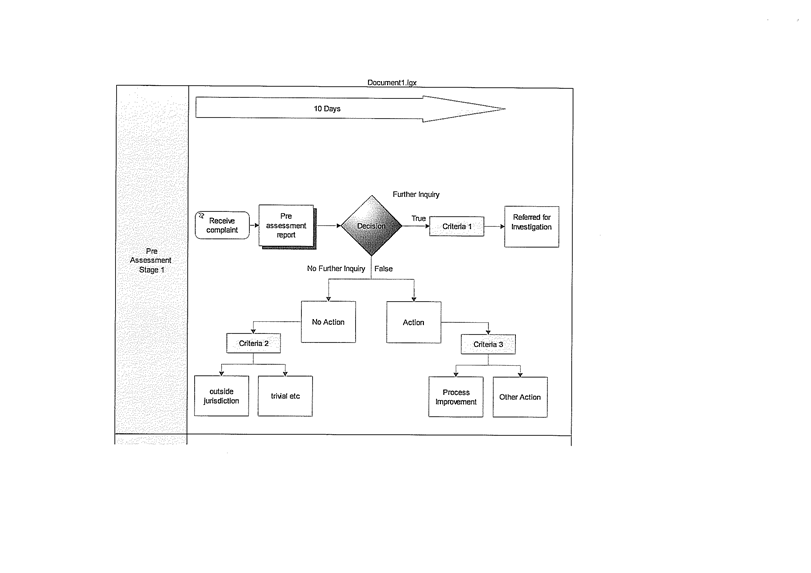
CS07-04/11 Council
Members’ Fees, Allowances, Reimbursements and Benefits Policy Amendment
File Ref: 2409
– 11/28268
Responsible
Officer: Director, Corporate Strategy and Performance
Disclosure
of Interest: Nil
Attachments: 1
Issue
To consider amendments to the Council Members’ Fees,
Allowances, Reimbursements and Benefits Policy.
Background
Clarification has been sought by Elected Members on the
allowances available for Conference, Training and Study and the procedures to
be followed for nominations that fall within the last six months of a Members
term. Minor amendments have also been suggested by Administration to
provide improved clarity in interpreting the Policy.
Detail
The following suggested changes are proposed for Elected
Members consideration.
Section 6. - Professional Conferences
· A carry over value
for the Mayor’s conference expenses has been included under Section 6.3.
· The following
paragraph has been added to the end of the section:-
* Professional Conferences or meetings that either
the Council or the CEO has requested that an elected member attend is not to be
included in the annual maximum cost described in Clause 6.3.
Section 7 - Training and Education
The allowances for members has increased from $2000 to $4000
and the Mayor’s allowance from $4000 to $8000:-
“7.6
A maximum cost of $4,000 per member, and $8,000 for
the Mayor per annum is set for the cost under 7.5 above.”
Deletion of Clause 7.8:-
“7.8 Elected
members will be reimbursed for costs associated with their enrolment in an
educational course of study (in accordance with Clauses 7.5(a) and (b), 7.6 and
7.7), upon representation of appropriate documentation.
Booking Arrangements relative to 6 and 7 above
Paragraph (f) has been amended to clarify the date at which
the nomination for attendance at a training, education or conference event would
take affect:-
“f) Any nomination
for attendance at a training, education or conference event that falls within
the last six months of a Council Members’ term of office will be referred
to Council for approval. To avoid confusion the date for which Clause (f) shall
take effect shall be taken from the date for which the Unit of study commences
or the Conference/ Training Event starts.”
Consultation
Elected Members were presented with details of the proposed
changes at the Council Forum on 15 March 2011.
Statutory
Compliance
The above amendments are compliant with the Local
Government Act 2005 once adopted by the Council.
Strategic
Implications
The proposal accords with the following Outcome Objective of
the City’s Strategic Plan 2006 – 2021:
“4 Governance
4.6 Provide
and maintain a high standard of governance and accountability”
Policy
Implications
The suggested amendments to the policy will provide
clarification to Members regarding their Allowances, Reimbursements and
Benefits.
Financial
Implications
There is an increase in the Elected Members Allowance for
Training and Education which will be accommodated in the 2011/2012 budget.
Voting Requirement
Special Majority
Recommendation
That Council ADOPT the amended Council
Members’ Fees, Allowances, Reimbursements and Benefits Policy as detailed
in Attachment 1.
CITY OF WANNEROO Agenda
OF Ordinary Council Meeting 05 April, 2011 397

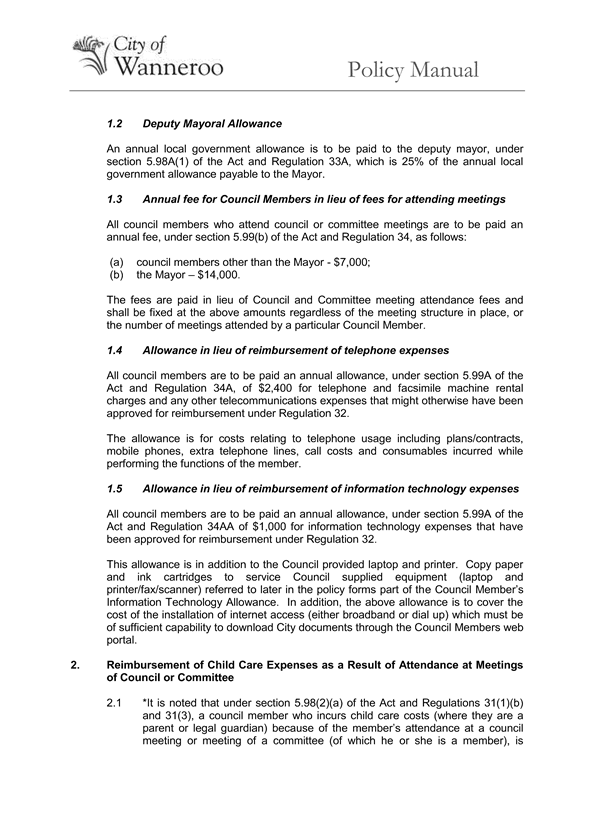
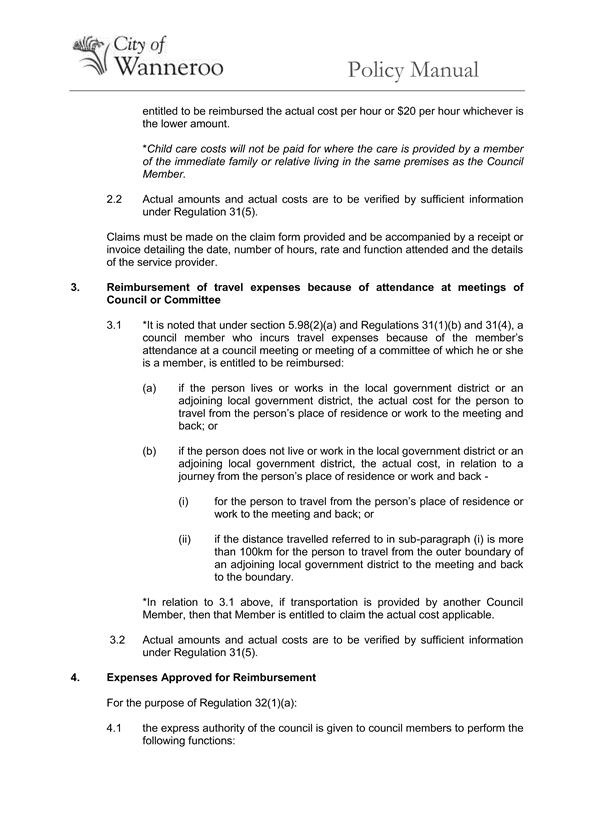
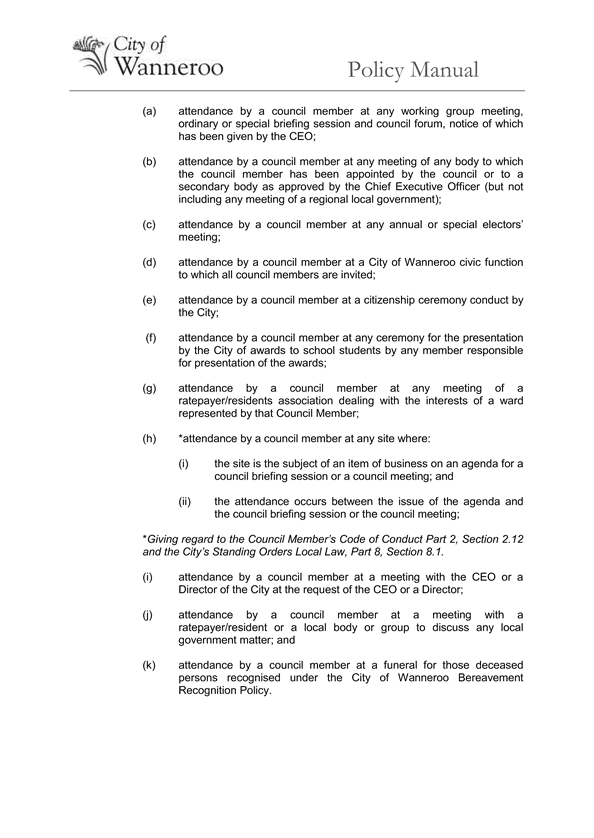
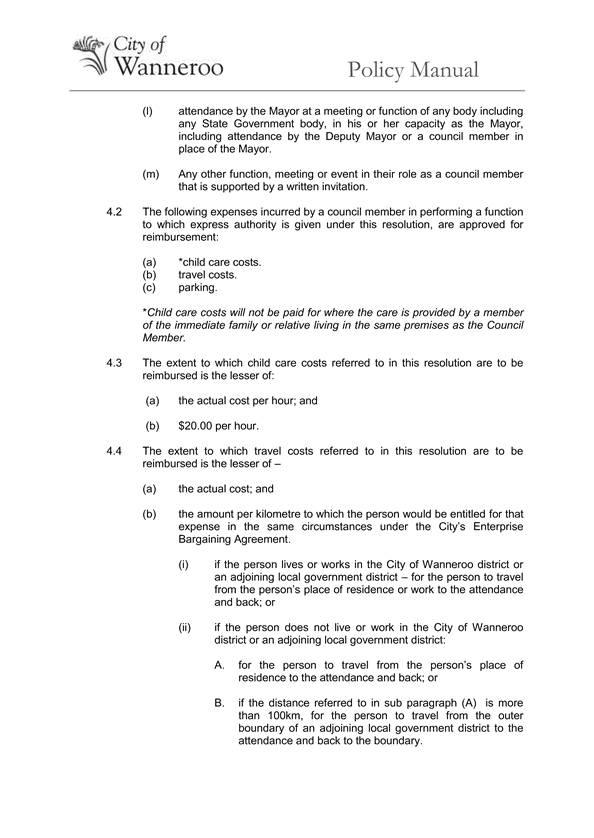
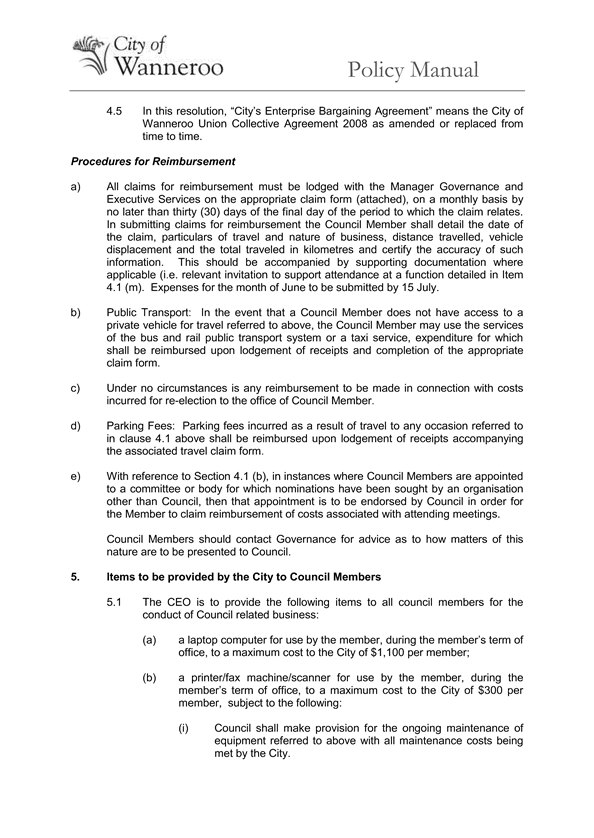

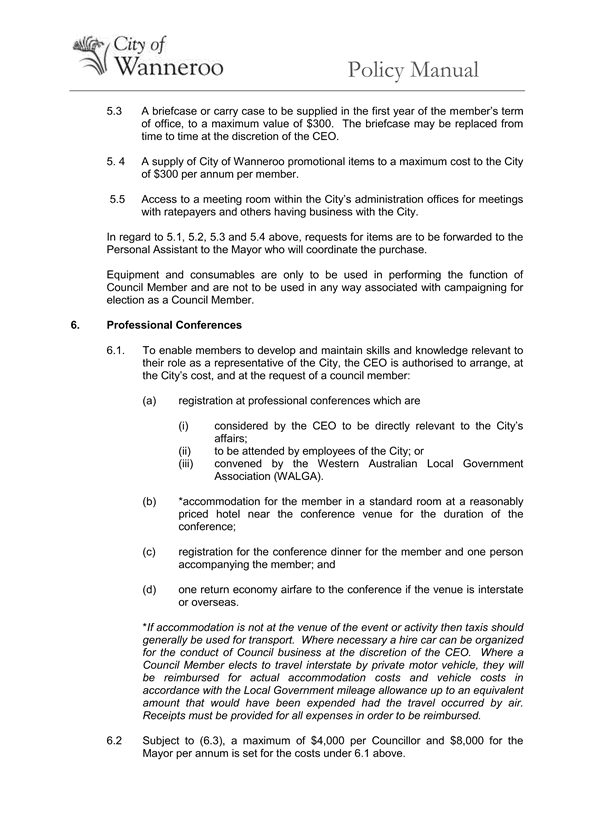



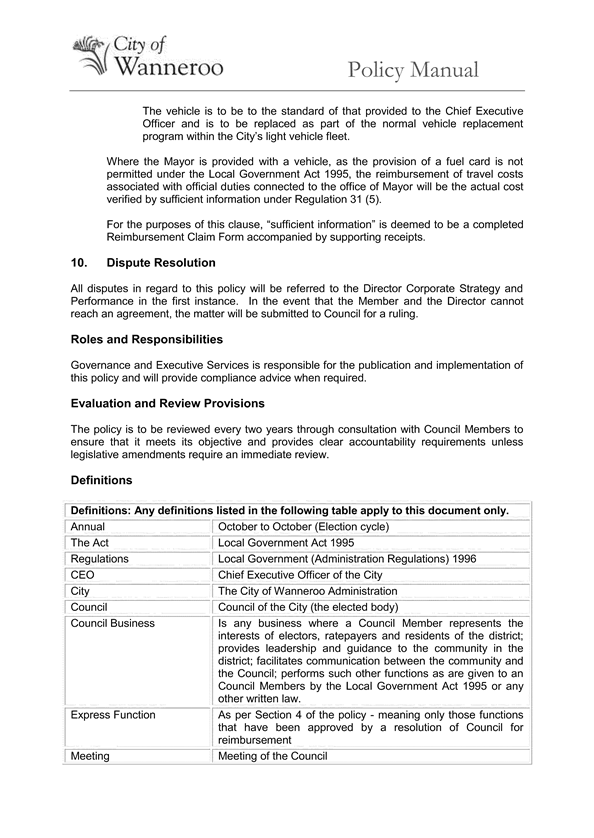
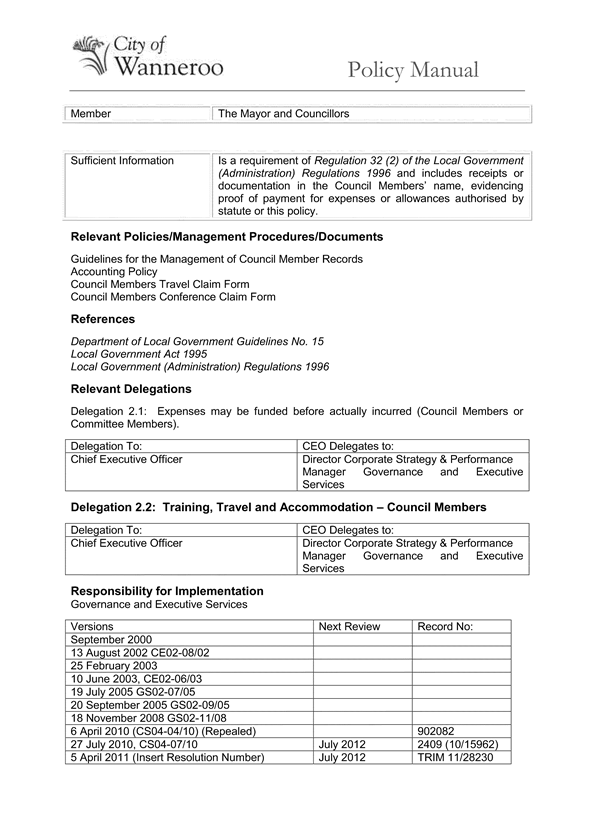
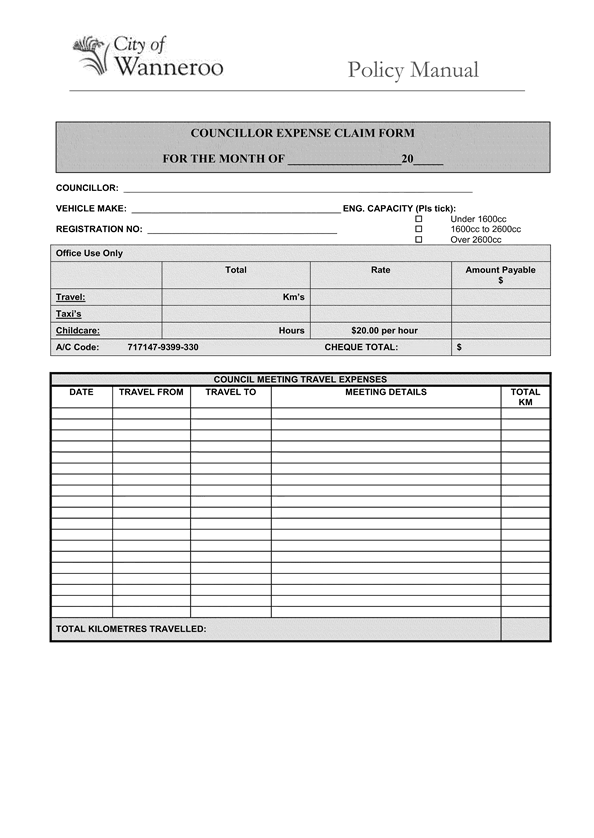
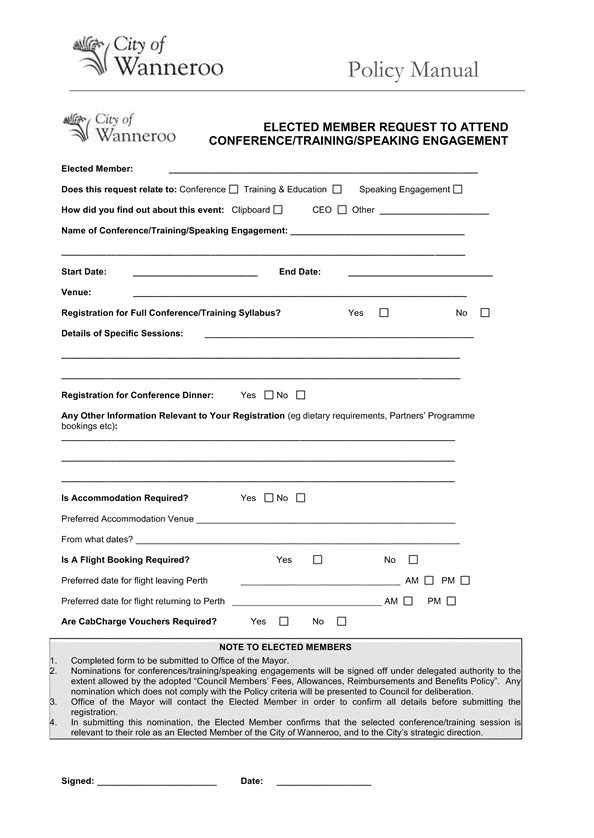
CS08-04/11 Motion
for the 2011 National General Assembly of Local Government
File Ref: 1893
– 11/30876
Responsible
Officer: Director, Corporate Strategy and Performance
Disclosure
of Interest: Nil
Attachments: Nil
Issue
The submission of a Motion to the 2011 National General
Assembly (NGA) of Local Government.
Background
The 2011 National General Assembly of Local Government has
written to all Local Governments within Australia inviting their participation
to submit Motions to be considered at the National Convention Centre in
Canberra between, 19-22 June 2011. The Motions to be submitted must follow the
following principles;
1. Falls
under one of the themes – Partnership, Place, and Position;
2. Be
relevant to the work of Local Government nationally; and
3. Complement
or build on the policy objectives of state and territory associations.
Motions submitted will be reviewed by the National General
Assembly Committee as well as by state and territory Local Government
Associations to determine the eligibility for inclusion in the NGA business
papers. When reviewing Motions, the Committee considers the importance and
relevance of the issue to Local Government. Motions that are agreed to at the
National General Assembly become resolutions. These resolutions are then
considered by the ALGA Board when setting National Local Government Policy and
when the Board is making representations to the Federal Government at
Ministerial Councils, during meetings and in ALGA publications. The ALGA Board
is not bound by any resolutions passed at the NGA.
Detail
Councillor Newton will be attending the National General
Assembly and has prepared the following Motion relating to Aged Care:
That this National General
Assembly calls upon the Australian Government to ensure that the aged care
industry receives a significant injection of funds. The increase in subsidies
for residents in full time care of nursing homes was a mere 1.8% even though
the CPI figure was approximately 2.8%. The combined increase for electricity,
water, sewerage and gas alone was 18.8%.
The Federal Government
consistently quotes funding increases which include the provision of 'new' beds
and licences. The most recent aged care approval round was drastically under
subscribed in Western Australia (WA). To date WA has been undersubscribed by
over 2,400 places. Funding for these places is included in the projected
increases in residential aged care.
The aged care industry’s
major cost is wages, and they were increased by 3-4% which is also well over
the 1.8% subsidy increase. With over 60% of aged care providers already running
in deficit mode this increase in subsidies will only lead to a reduction in
standards and services. Fortunately the single aged pension was increased by
2.2% which was marginally higher than the 1.8% subsidy increase.
If the residential aged care
industry is not adequately funded it will have a major negative impact on our
communities, The Federal Government has acknowledged that we have an aging
population. Local Government administers Home and Community Care Packages that
barely keep up with the growth. The lack of residential care places will
place an enormous strain on family members, carers and ultimately our
hospitals.
In order for this Motion to be progressed it requires the
formal endorsement of the Local Government Council.
Consultation
Nil
Comment
The Motion is consistent with the principles outlined by the
National General Assembly Committee and is relevant to the work of Local
Government nationally.
Statutory
Compliance
Nil
Strategic
Implications
The proposal accords with the following Outcome Objective of
the City’s Strategic Plan 2006 – 2021:
“2 Social
2.1 Increase
choice and quality of neighbourhood and lifestyle options”
Policy
Implications
Nil
Financial
Implications
Nil
Voting
Requirements
Simple Majority
Recommendation
The Council endorses the Notice of Motion to be
submitted to the National General Assembly of Local Government requesting that
the Australian Government ensures that the Aged Care Industry receives a
significant annual injection of funds.
Chief Executive Office
Office of the CEO Reports
CE01-04/11 Delegation
of Authority for Appointment of Acting Chief Executive Officer
File Ref: 2883
– 11/23754
Responsible
Officer: Chief Executive Officer
Disclosure
of Interest: Nil
Attachments: Nil
Issue
To consider granting delegated authority to the Chief
Executive Officer to appoint an Acting Chief Executive Officer for periods not
exceeding 35 days.
Background
At the present time, all proposed appointments to the
position of Acting Chief Executive Officer of the City of Wanneroo must be
presented to Council for ratification prior to the appointment taking
effect. However, Section 5.42 of the Local Government Act 1995 allows
Council to delegate to the Chief Executive Officer any of its powers other than
those specifically set out in Section 5.43.
Detail
From time to time, the Chief Executive Officer is required
to be absent from the City. During his absence, those actions that the
CEO is empowered to undertake and which are necessary to the functioning of the
City of Wanneroo cannot be fulfilled unless an Acting Chief Executive Officer
has been appointed.
At the present time, any proposal to appoint an Acting Chief
Executive Officer must be presented to Council for approval prior to the
appointment taking effect. This system does not present any issue
provided that the absence of the Chief Executive Officer is planned and can be
submitted to Council beforehand. However, should the appointment of an
Acting Chief Executive Officer be required at short notice (ie due to the Chief
Executive Officer’s absence because of illness, accident or other
unforeseen circumstances), then it would be necessary to hold a Special Meeting
of Council to address the situation.
It is suggested that, in the interests of good governance
and to cover emergency situations, the Chief Executive Officer be granted
delegated authority to make this type of appointment in accordance with the
following conditions:
1. The
position of Acting Chief Executive Officer can only be conferred on an employee
of the City of Wanneroo who currently holds the position of Director and is
designated as a “Senior Employee” in accordance with Section 5.37
of the Local Government Act 1995;
2. Delegated
authority is only granted for appointments to the position of Acting Chief
Executive Officer covering a period of 35 days or less. In instances
where an appointment is required for a period exceeding 35 days, then that
proposed appointment must be presented to Council for determination prior to
the appointment taking effect; and
3. The
Chief Executive Officer must advise Elected Members, on a quarterly basis, of
any appointments made to the position of Acting Chief Executive Officer under
delegated authority for the ensuing three month period. In instances
where it is necessary for an appointment to be made at short notice, then Elected
Members are to be advised of that appointment as soon as possible.
Consultation
Nil
Comment
It is recognised that the current situation, where Council
must approve the appointment of an Acting Chief Executive Officer prior to that
appointment taking effect, can present problems in instances where the Chief
Executive Officer is required to be absent at short notice, or indeed with no
prior warning. Under these circumstances, it would not be possible to
obtain Council’s approval prior to an Acting Chief Executive Officer
being required and therefore the day-to-day running of the City would be
significantly impaired.
Statutory
Compliance
Local Government Act 1995
Part 5 – Administration
Division 4 – Local government employees
“5.42 Delegation
of some powers and duties to CEO
(1) A
local government may delegate* to the CEO the exercise of any of its powers or
the discharge of any of its duties under -
(a) This
Act other than those referred to in section 5.43; or
(b) The
Planning and Development Act 2005 section 214(2), (3) or (5).
*Absolute Majority”
“5.43 Limits
on delegations to CEO
A local government cannot
delegate to a CEO any of the following powers or duties –
(a) Any
power or duty that requires a decision of an absolute majority or a 75% majority
of the local government;
(b) Accepting
a tender which exceeds an amount determined by the local government for the
purpose of this paragraph;
(c) Appointing
an auditor;
(d) Acquiring
or disposing of any property valued at an amount exceeding an amount determined
by the local government for the purpose of this paragraph;
(e) Any
of the local government’s powers under section 5.98, 5.98A, 5.99, 5.99A
or 5.100;
(f) Borrowing
money on behalf of the local government;
(g) Hearing
or determining an objection of a kind referred to in section 9.5;
(h) Any
power or duty that requires the approval of the Minister or the Governor; or
(i) Such
other powers or duties as may be prescribed.”
Strategic
Implications
The proposal accords with the following Outcome Objective of
the City’s Strategic Plan 2006 – 2021:
“4 Governance
4.6 Provide
and maintain a high standard of governance and accountability”
Policy
Implications
Nil
Financial
Implications
Directors are paid a higher duty allowance for any time
spent in the position of Acting Chief Executive Officer.
Voting
Requirements
Absolute Majority
Recommendation
That Council DELEGATES to the Chief Executive Officer, BY
ABSOLUTE MAJORITY, the power to make appointments to the position of Acting
Chief Executive Officer in accordance with the following:
1. The
position of Acting Chief Executive Officer can only be conferred on an employee
of the City of Wanneroo who currently holds the position of Director and is
designated as a “Senior Employee” in accordance with Section 5.37
of the Local Government Act 1995;
2. Delegated
authority is only granted for appointments to the position of Acting Chief
Executive Officer covering a period of 35 days or less. In instances
where an appointment is required for a period exceeding 35 days, then that
proposed appointment must be presented to Council for determination prior to
the appointment taking effect; and
3. The
Chief Executive Officer must advise Elected Members, on a quarterly basis, of
any appointments made to the position of Acting Chief Executive Officer under
delegated authority for the ensuing three month period. In instances
where it is necessary for an appointment to be made at short notice, then
Elected Members are to be advised of that appointment as soon as possible.
CE02-04/11 Donation
Requests Considered Under Delegated Authority of the Chief Executive Officer
File Ref: 3626
– 11/27456
Responsible
Officer: Chief Executive Officer
Disclosure
of Interest: Nil
Attachments: Nil
Issue
To note applications for sponsorships, donations and waivers
of fees and charges considered and determined by the Chief Executive Officer
from 31 January 2011 to
24 February 2011 in accordance with the provisions of the Donations,
Sponsorships and Waiver of Fees and Charges Policy.
Background
The Donations, Sponsorships and Waiver of Fees and Charges
Policy delegates the consideration of requests for sponsorships, donations and
waivers of fees and charges under a specified value to the Chief Executive
Officer.
Detail
During the period, the City received the following requests:
1. 0
requests for sponsorship; and
2. 2
requests for donations and waivers of fees.
Comment
In accordance with the provisions and criteria nominated in
the Donations, Sponsorships and Waiver of Fees and Charges Policy,
determinations were made as listed in the recommendation to this report.
Applications and assessments of each request against the
policy are available from Governance upon request. Among other criteria,
sponsorship is given to individuals who reside within the City of Wanneroo, are
18 years of age or under and have not already received sponsorship in the same
financial year.
Donations are given to groups who are located or have
primary business in the City of Wanneroo and 75% or more of their membership
resides within the City of Wanneroo.
Statutory
Compliance
Nil
Strategic
Implications
The proposal accords with the following Outcome Objective of
the City’s Strategic Plan 2006 – 2021:
“2 Social
2.2 Improve
the City’s identity and community well-being through arts, culture,
leisure and recreation”
Policy
Implications
This report aligns with the provisions and delegations of
the Donations, Sponsorship and Waiver of Fees and Charges Policy.
Financial
Implications
Approval of these requests has resulted in expenditure under
Delegated Authority in the Award Governance Donations Account (717633-1207-316)
of $482.50.
Voting
Requirements
Simple Majority
Recommendation
That Council NOTES the delegated determination of
requests received by the City from 31 January to 24 February 2011 for
donations, sponsorships and waiver of fees and charges (total of $482.50),
which are as follows:-
Community Group Donation & Waiver of Fees Requests
|
No.
|
Organisation
|
Amount
|
Recommendation
|
Reason
|
|
1.
|
Small Business Centre
North West Metro
|
$82.50
|
APPROVE a 50% waiver of
fees of $82.50 for the hire of the Banksia Room to run a Biz Links Workshop
from 6-8pm on 23 March 2011.
|
The request satisfies
the criteria of the policy.
|
|
2.
|
NAIDOC School
Initiatives
|
$400.00
|
APPROVE a donation of
$400.00 towards the design, printing and distribution to schools of entry
forms for NAIDOC week competition,
3-10 July 2011.
|
The request satisfies
the criteria of the policy.
|
|
|
|
|
|
|
|
TOTAL
|
$482.50
|
|
CE03-04/11 Strategic
Internal Audit Plan 2011/12 to 2013/14
File Ref: 4900
– 11/27378
Responsible
Officer: Chief Executive Officer
Disclosure
of Interest: Nil
Attachments: 1
Issue
To consider the Audit Committee’s recommendation to
adopt the 2011/12 to 2012/14 Strategic Internal Audit Plan.
Internal Audit is an important component of the City’s
Risk Management Strategy. It provides both an independent review of the
City’s Internal Controls and gives some assurance to the Administration
and Council on the efficiency and veracity of the policy and procedures of the
City. The City’s current Strategic Audit Plan expires on 30 September
2011. A new plan has been proposed by the City’s contracted Internal
Auditors, 2020 Global.
Background
The current three year Audit Plan expires in September 2011.
The current Internal Auditors have prepared a risk based plan covering the next
three years (Attachment 1 refers). It is intended that the proposed plan
be further refined following a series of Risk Identification meetings to be
held with the City’s Coordinators, Managers and Directors. The identified
risks will be scored according to likelihood and impact and will form the basis
of the City’s Risk Register.
Detail
The Internal Auditors are proposing some twenty six (26)
audits over the three year period and a further 100 audit hours per annum for
ad hoc transactional audits. The audits cover a good spread of the City’s
activities and directorates. The City had previously intended to recruit an
In-house Internal Auditor, however, an attempted recruitment proved fruitless
and so it will be necessary to invite tenders from suitably qualified external
firms. Including attendance at meetings and housekeeping, the proposal would
cost approximately $100,000 per annum. The adopted 2009/10 Budget provided for
$120,000 for an outsourced Internal Audit. This was revised down in 2010/11 to
$46,000 to account for the planned recruitment of an internal resource. The
mid-year 2010/11 review has now amended the total for external fees to $70,000
in recognition that 2020 Global will undertake audits to the date of contract
expiry at which point a new contract will be entered into based on the
Strategic Internal Plan.
Consultation
Widespread consultation will take place with all the
City’s Directorates and Business
Units in identifying and assessing Risk.
Comment
The 2011/12 to 2013/14 Strategic Internal Audit Plan was
submitted to the Audit Committee meeting of 15 March 2011 (Item 4.4 refers) for
its agreement and recommendation for adoption by Council.
Statutory
Compliance
Nil
Strategic
Implications
The proposal accords with the following Outcome Objective of
the City’s Strategic Plan 2006 – 2021:
“4 Governance
4.6 Provide
and maintain a high standard of governance and accountability”
<Insert futher Strategic Implications if
required…>
Policy
Implications
Nil
Financial
Implications
The costs of an (Internal) Internal Auditor vs. an External
Auditor would both equate to approximately $100,000 per annum. This amount will
be allowed for in the Budget and 10 Year Forecast respectively.
Voting
Requirements
Simple/Special/Absolute Majority
Recommendation
That Council ADOPTS the
Strategic Internal Audit Plan 2011/12 to 2013/14 with the proviso that it may
be amended following Risk Management Workshops.
CITY OF WANNEROO Agenda
OF Ordinary Council Meeting 05 April, 2011 421
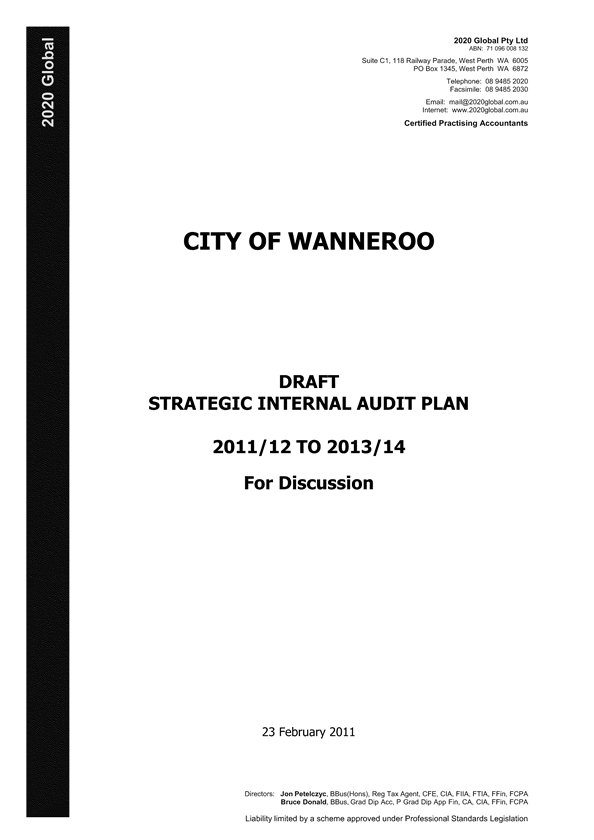
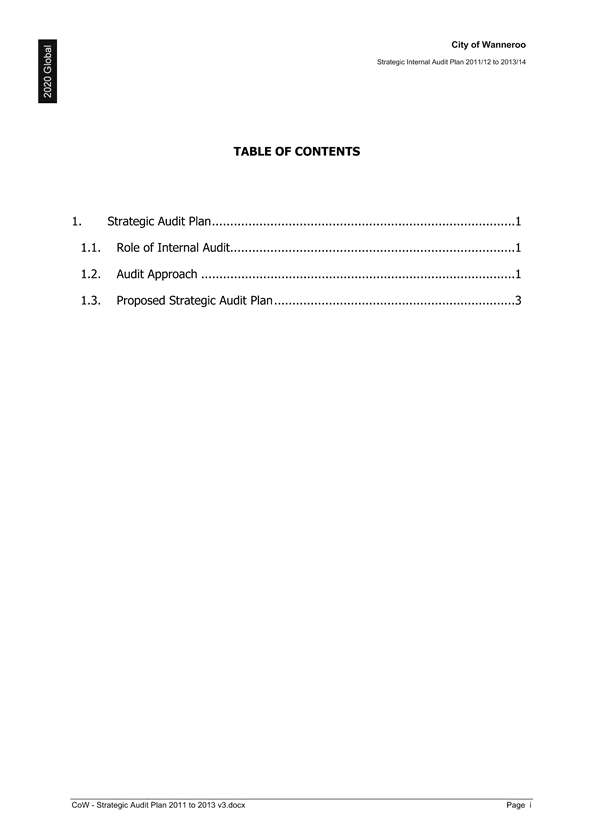
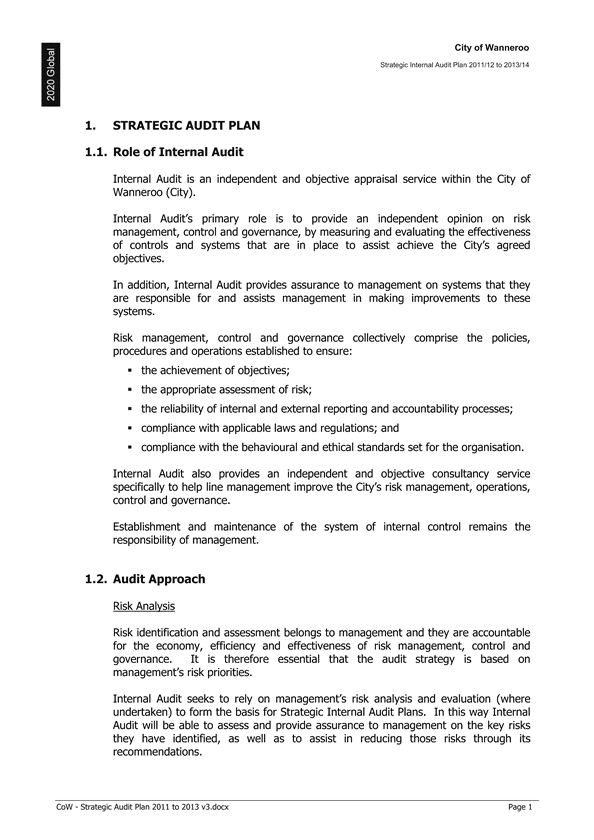
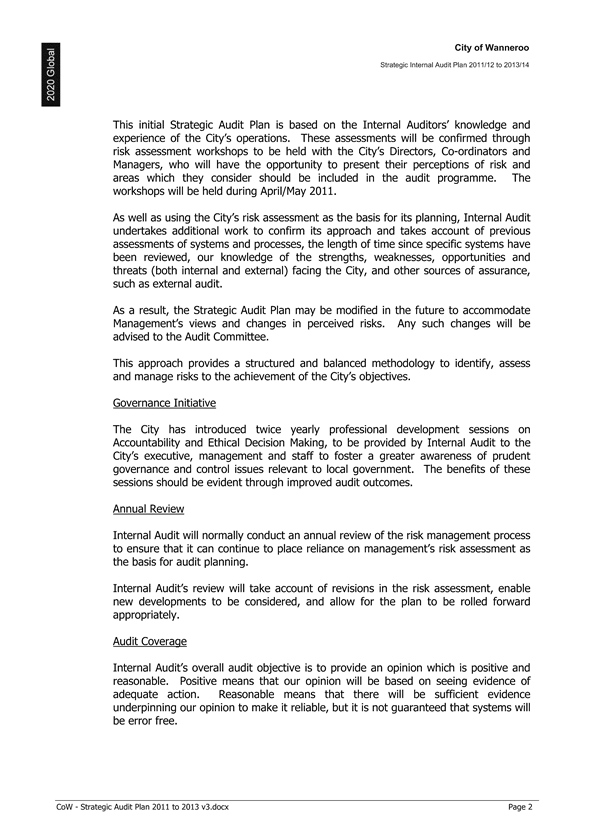
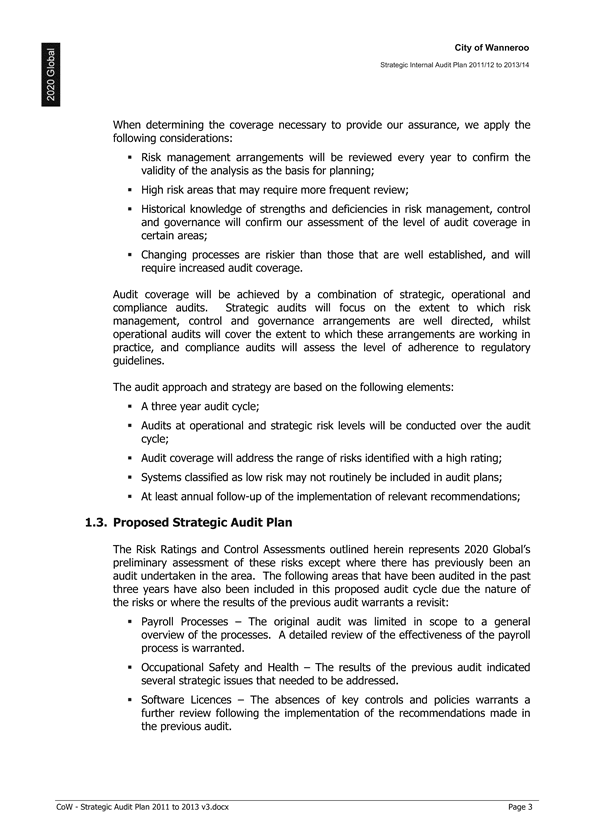
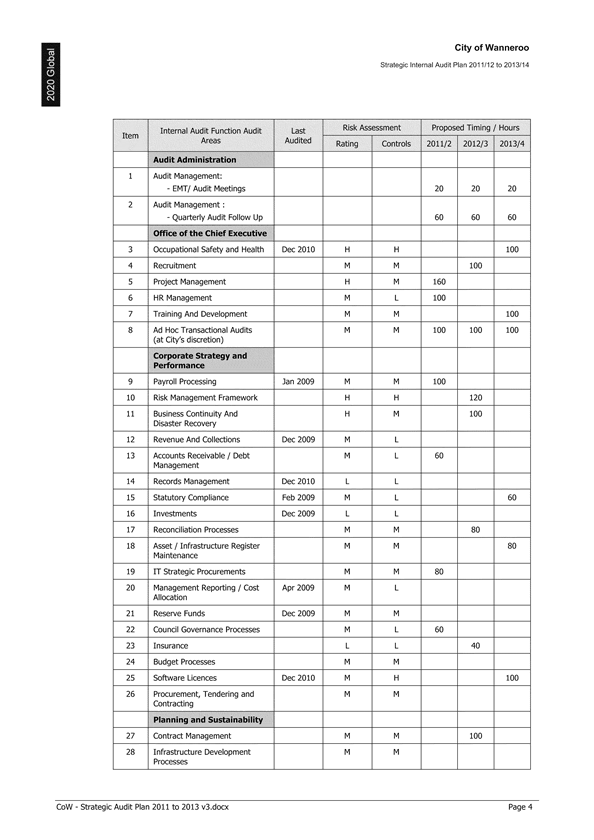

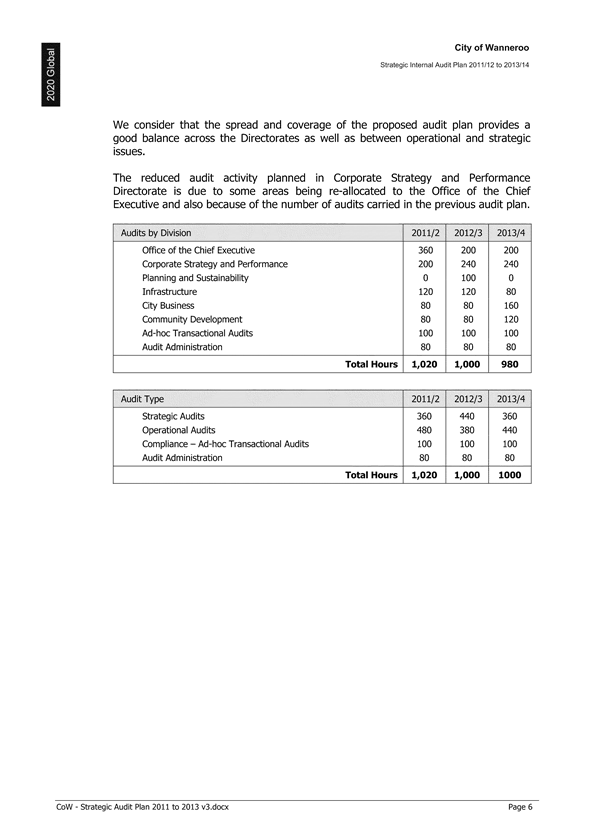
Item 9 Motions
on Notice
MN01-04/11 Cr
Grierson - Request for Citizenship Ceremonies
File Ref: 2815
– 11/30706
Responsible
Officer: Director, Community Development
Disclosure
of Interest: Nil
Attachments: Nil
Issue
To consider changing the City of Wanneroo regular
citizenship ceremonies to Monday evenings.
Background
The City of Wanneroo has for several years conducted its
citizenship ceremonies on a Tuesday night to facilitate the presence of as many
councillors as possible. This program has worked very successfully and
has been supported by both State and Federal members of parliament (MPs) who
attend from time to time. In 2011 the City of Wanneroo was advised that
there had been a change to State parliamentary sitting days, which now include
Tuesdays, which will prevent State MPs from attending citizenship ceremonies.
Detail
This Motion on Notice seeks to have the regular program of
citizenship ceremonies moved from Tuesday evenings to Monday evenings to enable
both State and Federal MPs the opportunity to be present at City of Wanneroo
citizenship ceremonies and at times address the new Australian citizens.
Consultation
The Mayor has previously circulated a request to all elected
members seeking their advice on this matter.
Comment
As a Local Government authority we should be working with
our State Government counterparts regardless of which party is the
government. As a councillor I have always tried to work in with my parliamentary
representatives from both parties, as I believe that I am here to represent the
residents and never ask how they vote.
I feel that we should have parliamentary representatives at
a citizenship ceremony as the people who are becoming Australians have a right
to also have these state members of parliament present.
I am aware that the cost of the citizenship is borne by the
Local Government authority, but there are times when we need the help of either
our State or Federal politicians and therefore we should be understanding
instead of acting like spoilt children, saying we are paying for the ceremony,
therefore you cannot come.
Statutory
Compliance
Nil
Strategic
Implications
The proposal accords with the following Outcome Objective of
the City’s Strategic Plan 2006 – 2021:
“2 Social
2.3 Improve
the capacity of local communities to support each other”
Policy
Implications
The Australian Citizenship Ceremonies Code states that
“it provides guidance for organisations conducting citizenship ceremonies…sets
out legal and other requirements for conducting citizenship ceremonies as well
as the roles and responsibilities of those conducting ceremonies”.
It goes on to say “in order to maximise the likelihood of acceptance of
official invitations from elected representatives of government, citizenship
ceremonies should not be scheduled on federal or state parliamentary sitting
days”. However, it should be noted that this is not a legal requirement,
but only a guide.
Financial
Implications
The City has budgeted for the provision of Citizenship
Ceremonies for 2011 without any financial contribution from either state or
federal government. There would be no further financial or budget
implications if the City changes its citizenship ceremony days and dates.
Voting
Requirements
Simple Majority
Recommendation
That Council RECOMMENDS that Administration CHANGES the
City of Wanneroo regular citizenship ceremonies to Monday evenings from
Tuesdays.
Conducting citizenship ceremonies on a Tuesday evening has
increased the convenience for and attendance by elected members at regular
citizenship ceremonies. There is no problem however for Administration in
changing the day for these regular ceremonies.
Invitations for the April citizenship ceremony have already
been issued and would inconvenience all participants to change that date.
The Wanneroo Civic Choir; Lake Joondalup Lifestyle Village
Choir, Harbour Side Harmony Choir and Peter Moyes School Band and Choir have
also been committed to a Tuesday evening schedule to the end of the year and
cannot be guaranteed to be available Monday evenings.
Item 10 Urgent Business
Item
11 Confidential
CR01-04/11 Reconsideration
of the draft East Wanneroo Cell 9 - East Landsdale Local Structure Plan No. 57
- Lot 165 (474) Kingsway, Landsdale
File Ref: 5642
– 11/24497
Responsible
Officer: Director, Planning and Sustainability
This report is to be dealt
with in confidential session, under the terms of the Local Government Act 1995
Section 5.23(2), as follows:
(d) legal
advice obtained, or which may be obtained, by the local government and which
relates to a matter to be discussed at the meeting.
CR02-04/11 Purchase
Road Reserve Land from Lot 13 (287L) Gnangara Road, Wangara
File Ref: 5642
– 11/26405
Responsible
Officer: Director, Planning and Sustainability
This report is to be dealt
with in confidential session, under the terms of the Local Government Act 1995
Section 5.23(2), as follows:
(e)(iii) a matter that if disclosed,
would reveal information about the business, professional, commercial or
financial affairs of a person, where the information is held by, or is about, a
person other than the local government.
CR03-04/11 Acquisition
of Land - Portions of Lot 105 (500) and Lot 21 (450) Flynn Drive Neerabup
File Ref: SD142579
– 11/25796
Responsible
Officer: Director, Corporate Strategy and Performance
This report is to be dealt
with in confidential session, under the terms of the Local Government Act 1995
Section 5.23(2), as follows:
(e)(iii) a matter that if disclosed,
would reveal information about the business, professional, commercial or
financial affairs of a person, where the information is held by, or is about, a
person other than the local government
.
Item 12 Date of Next Meeting
The next Ordinary Council Meeting has been scheduled for
7.00pm on Tuesday, 3 May 2011, to be held at Civic Centre, , Dundebar Road,
Wanneroo.
Item 13 Closure
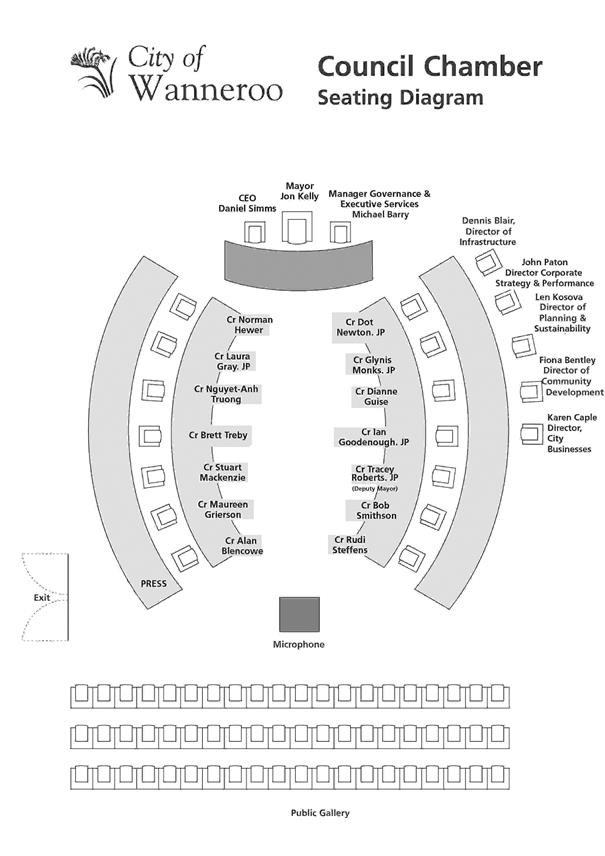
Estimated savings
are where savings can be assumed but not clearly identified or quantified, for
example savings in maintenance through extended product life.




















































































































































































































